FlexPod Datacenter with VMware 6.5 Update1 and Cisco ACI 3.1
Available Languages
FlexPod Datacenter with VMware 6.5 Update1 and Cisco ACI 3.1
Deployment Guide for FlexPod Datacenter with VMware 6.5 Update1, Cisco ACI 3.1, and NetApp AFF A-Series
Last Updated: April 2, 2018

About the Cisco Validated Design Program
The Cisco Validated Design (CVD) program consists of systems and solutions designed, tested, and documented to facilitate faster, more reliable, and more predictable customer deployments. For more information, visit:
http://www.cisco.com/go/designzone.
ALL DESIGNS, SPECIFICATIONS, STATEMENTS, INFORMATION, AND RECOMMENDATIONS (COLLECTIVELY, "DESIGNS") IN THIS MANUAL ARE PRESENTED "AS IS," WITH ALL FAULTS. CISCO AND ITS SUPPLIERS DISCLAIM ALL WARRANTIES, INCLUDING, WITHOUT LIMITATION, THE WARRANTY OF MERCHANTABILITY, FITNESS FOR A PARTICULAR PURPOSE AND NONINFRINGEMENT OR ARISING FROM A COURSE OF DEALING, USAGE, OR TRADE PRACTICE. IN NO EVENT SHALL CISCO OR ITS SUPPLIERS BE LIABLE FOR ANY INDIRECT, SPECIAL, CONSEQUENTIAL, OR INCIDENTAL DAMAGES, INCLUDING, WITHOUT LIMITATION, LOST PROFITS OR LOSS OR DAMAGE TO DATA ARISING OUT OF THE USE OR INABILITY TO USE THE DESIGNS, EVEN IF CISCO OR ITS SUPPLIERS HAVE BEEN ADVISED OF THE POSSIBILITY OF SUCH DAMAGES.
THE DESIGNS ARE SUBJECT TO CHANGE WITHOUT NOTICE. USERS ARE SOLELY RESPONSIBLE FOR THEIR APPLICATION OF THE DESIGNS. THE DESIGNS DO NOT CONSTITUTE THE TECHNICAL OR OTHER PROFESSIONAL ADVICE OF CISCO, ITS SUPPLIERS OR PARTNERS. USERS SHOULD CONSULT THEIR OWN TECHNICAL ADVISORS BEFORE IMPLEMENTING THE DESIGNS. RESULTS MAY VARY DEPENDING ON FACTORS NOT TESTED BY CISCO.
CCDE, CCENT, Cisco Eos, Cisco Lumin, Cisco Nexus, Cisco StadiumVision, Cisco TelePresence, Cisco WebEx, the Cisco logo, DCE, and Welcome to the Human Network are trademarks; Changing the Way We Work, Live, Play, and Learn and Cisco Store are service marks; and Access Registrar, Aironet, AsyncOS, Bringing the Meeting To You, Catalyst, CCDA, CCDP, CCIE, CCIP, CCNA, CCNP, CCSP, CCVP, Cisco, the Cisco Certified Internetwork Expert logo, Cisco IOS, Cisco Press, Cisco Systems, Cisco Systems Capital, the Cisco Systems logo, Cisco Unified Computing System (Cisco UCS), Cisco UCS B-Series Blade Servers, Cisco UCS C-Series Rack Servers, Cisco UCS S-Series Storage Servers, Cisco UCS Manager, Cisco UCS Management Software, Cisco Unified Fabric, Cisco Application Centric Infrastructure, Cisco Nexus 9000 Series, Cisco Nexus 7000 Series. Cisco Prime Data Center Network Manager, Cisco NX-OS Software, Cisco MDS Series, Cisco Unity, Collaboration Without Limitation, EtherFast, EtherSwitch, Event Center, Fast Step, Follow Me Browsing, FormShare, GigaDrive, HomeLink, Internet Quotient, IOS, iPhone, iQuick Study, LightStream, Linksys, MediaTone, MeetingPlace, MeetingPlace Chime Sound, MGX, Networkers, Networking Academy, Network Registrar, PCNow, PIX, PowerPanels, ProConnect, ScriptShare, SenderBase, SMARTnet, Spectrum Expert, StackWise, The Fastest Way to Increase Your Internet Quotient, TransPath, WebEx, and the WebEx logo are registered trademarks of Cisco Systems, Inc. and/or its affiliates in the United States and certain other countries.
All other trademarks mentioned in this document or website are the property of their respective owners. The use of the word partner does not imply a partnership relationship between Cisco and any other company. (0809R)
© 2018 Cisco Systems, Inc. All rights reserved.
Table of Contents
Deployment Hardware and Software
Infrastructure Servers Prerequisites
Cisco Application Policy Infrastructure Controller (APIC) Verification
Initial ACI Fabric Setup Verification
Setting Up Out-of-Band Management IP Addresses for New Leaf Switches
Verifying Time Zone and NTP Server
Verifying BGP Route Reflectors
Verifying Fabric Wide Enforce Subnet Check for IP & MAC Learning
Verifying CoS Preservation Setting
Create LLDP Interface Policies
Create BPDU Filter/Guard Policies
Create Virtual Port Channels (vPCs)
VPC – UCS Fabric Interconnects
Configuring Common Tenant for In-Band Management Access
Create Security Filters in Tenant Common
Create Application Profile for IB-Management Access
Create Application Profile for Host Connectivity
NetApp All Flash FAS A300 Controllers
Complete Configuration Worksheet
Set Onboard Unified Target Adapter 2 Port Personality
Set Auto-Revert on Cluster Management
Set Up Management Broadcast Domain
Set Up Service Processor Network Interface
Disable Flow Control on 10GbE and 40GbE Ports
Disable Unused FCoE Capability on CNA Ports
Configure Network Time Protocol
Configure Simple Network Management Protocol
Enable Cisco Discovery Protocol and Link Layer Discovery Protocol
Create Jumbo Frame MTU Broadcast Domains in ONTAP
Create Storage Virtual Machine
Enable VMware vStorage for NFS in ONTAP
Create Load-Sharing Mirrors of SVM Root Volume
Create Block Protocol Service(s)
Add Rules to Default Export Policy to Allow ESXi Host Access
Add Infrastructure SVM Administrator
Upgrade Cisco UCS Manager Software to Version 3.2(3a)
Add Block of IP Addresses for KVM Access
Edit Policy to Automatically Discover Server Ports
Verify Server and Enable Uplink Ports
Acknowledge Cisco UCS Chassis and FEX
Re-Acknowledge Any Inaccessible Cisco UCS C-Series Servers
Create Uplink Port Channels to Cisco Nexus 9332 Switches
Create an Organization for this FlexPod
Create an IQN Pool for iSCSI Boot
Create iSCSI Boot IP Address Pools
Modify Default Host Firmware Package
Set Jumbo Frames in Cisco UCS Fabric
Create Local Disk Configuration Policy (Optional)
Create Server Pool Qualification Policy (Optional)
Create High Traffic VMware Adapter Policy
Update the Default Maintenance Policy
Create LAN Connectivity Policy for iSCSI Boot
Create iSCSI Boot Service Profile Template
Storage Configuration – SAN Boot
NetApp ONTAP Boot Storage Setup
VMware vSphere 6.5 Update 1 Setup
Download Cisco Custom Image for ESXi 6.5 Update 1
Log in to Cisco UCS 6300 Fabric Interconnect
Set Up VMware ESXi Installation
Set Up Management Networking for ESXi Hosts
Log in to VMware ESXi Hosts by Using VMware Host Client
Set Up VMkernel Ports and Virtual Switch
Install VMware ESXi Patches and Drivers
Building the VMware vCenter Server Appliance
Setting Up VMware vCenter Server
ESXi Dump Collector setup for iSCSI-Booted Hosts
Add APIC-Integrated vSphere Distributed Switch (vDS)
Create Virtual Machine Manager (VMM) Domain in APIC
Add Management ESXi Hosts to APIC-Integrated vDS
Cisco ACI vCenter Plug-in Installation
Cisco UCS Manager Plug-in for VMware vSphere Web Client
Cisco UCS Manager Plug-in Installation
Using the Cisco UCS vCenter Plugin
Build a Windows Server 2016 Virtual Machine for Cloning
Build Windows Active Directory Servers for ACI Fabric Core Services
Add Supernet Routes to Core-Services Devices
Adding the Supernet Route in a Windows VM
Adding the Supernet Route in the vCenter Server Appliance
Adding the Supernet Route in VMware ESXi
NetApp FlexPod Management Tools Setup
NetApp Virtual Storage Console 7.1 Deployment Procedure
Virtual Storage Console 7.1 Pre-installation Considerations
Install Virtual Storage Console Appliance 7.1
Add the Supernet Route to the VSC Appliance and Secure the Appliance
Install NetApp NFS VAAI Plug-in
Discover and Add Storage Resources
Optimal Storage Settings for ESXi Hosts
Virtual Storage Console 7.1 Provisioning Datastores
Configuring the Nexus 7000s for ACI Connectivity (Sample)
Configuring ACI Shared Layer 3 Out
Lab Validation Tenant Configuration
Deploy ACI Application (FPV-App-A) Tenant
Create Tenant Broadcast Domains in ONTAP
Create Storage Virtual Machine
Create Load-Sharing Mirrors of SVM Root Volume
Create Block Protocol Service(s)
Add Quality of Service (QoS) Policy to Monitor Application Workload
Configure Cisco UCS for the Tenant
Add New Tenant-Specific Server Pool
Create Tenant Service Profile Template
Create New Service Profiles for Tenant Servers
Configure Storage SAN Boot for the Tenant
ESXi Boot LUN in FPV-Foundation-SVM Tenant Hosts
Clustered Data ONTAP iSCSI Boot Storage Setup
Install and Configure VMware ESXi on Tenant Hosts
Build a Second Tenant (Optional)
Deploy L4-L7 VLAN Stitching in Sample Tenants
Provide Management connectivity to Cisco ASAv
Deploy Inside and Outside EPGs in Tenant common
Create Tenant Firewall Outside Bridge Domain and Subnet
Set Onboard Unified Target Adapter 2 Port Personality
Add FCP Storage Protocol to Infrastructure SVM
Create FCP Storage Protocol in Infrastructure SVM
Configure FC Unified Ports (UP) on Cisco UCS Fabric Interconnects
Place Cisco UCS Fabric Interconnects in Fiber Channel Switching Mode
Assign VSANs to FC Storage Ports
Create a WWNN Pool for FC Boot
Create SAN Connectivity Policy
Create LAN Connectivity Policy for FC Boot
Create Service Profile Template
Add More Servers to FlexPod Unit
Adding Direct Connected Tenant FC Storage
Create Storage Connection Policies
Map Storage Connection Policies vHBA Initiator Groups in SAN Connectivity Policy
Appendix – Sample Cisco ASAv Configuration
Cisco Validated Designs include systems and solutions that are designed, tested, and documented to facilitate and improve customer deployments. These designs incorporate a wide range of technologies and products into a portfolio of solutions that have been developed to address the business needs of customers. Cisco and NetApp have partnered to deliver FlexPod, which serves as the foundation for a variety of workloads and enables efficient architectural designs that are based on customer requirements. A FlexPod solution is a validated approach for deploying Cisco and NetApp technologies as a shared cloud infrastructure.
This document describes the Cisco and NetApp® FlexPod Datacenter with Cisco UCS Manager unified software release 3.2, Cisco Application Centric Infrastructure (ACI) 3.1(1i), NetApp ONTAP 9.3, and VMware vSphere 6.5 Update 1. Cisco UCS Manager (UCSM) 3.2 provides consolidated support for all the current Cisco UCS Fabric Interconnect models (6200, 6300, 6324 (Cisco UCS Mini)), 2200/2300 series IOM, Cisco UCS B-Series, and Cisco UCS C-Series, including Cisco UCS B200M5 servers. FlexPod Datacenter with Cisco UCS unified software release 3.2, and VMware vSphere 6.5 Update 1 is a predesigned, best-practice data center architecture built on Cisco Unified Computing System (UCS), Cisco Nexus® 9000 family of switches, Cisco Application Policy Infrastructure Controller (APIC), and NetApp All Flash FAS (AFF).
This document primarily focuses on deploying VMware vSphere 6.5 Update 1 on FlexPod Datacenter using iSCSI and NFS storage protocols. The Appendix section covers the delta changes on the configuration steps using the Fiber Channel (FC) storage protocol for the same deployment model.
![]() FC storage traffic does not flow through the ACI Fabric and is not covered by the ACI policy model.
FC storage traffic does not flow through the ACI Fabric and is not covered by the ACI policy model.
Introduction
The current industry trend in data center design is towards shared infrastructures. By using virtualization along with pre-validated IT platforms, enterprise customers have embarked on the journey to the cloud by moving away from application silos and toward shared infrastructure that can be quickly deployed, thereby increasing agility and reducing costs. Cisco and NetApp have partnered to deliver FlexPod, which uses best of breed storage, server and network components to serve as the foundation for a variety of workloads, enabling efficient architectural designs that can be quickly and confidently deployed.
Audience
The audience for this document includes, but is not limited to, sales engineers, field consultants, professional services, IT managers, partner engineers, and customers who want to take advantage of an infrastructure built to deliver IT efficiency and enable IT innovation.
Purpose of this Document
This document provides a step-by-step configuration and implementation guidelines for the FlexPod Datacenter with Cisco UCS Fabric Interconnects, NetApp AFF, and Cisco ACI solution. This document primarily focuses on deploying VMware vSphere 6.5 Update 1 on FlexPod Datacenter using iSCSI and NFS storage protocols. The Appendix section covers the delta changes on the configuration steps using FC storage protocol for the same deployment model.
What’s New?
The following design elements distinguish this version of FlexPod from previous FlexPod models:
· Support for the Cisco UCS 3.2 unified software release, Cisco UCS B200-M5 servers, Cisco UCS B200-M4 servers, and Cisco UCS C220-M4 servers
· Support for Cisco ACI version 3.1(1i)
· Support for the latest release of NetApp ONTAP® 9.3
· NFS, iSCSI, and FC storage design
· Validation of VMware vSphere 6.5 Update 1
Architecture
FlexPod architecture is highly modular, or pod-like. Although each customer's FlexPod unit might vary in its exact configuration, after a FlexPod unit is built, it can easily be scaled as requirements and demands change. This includes both scaling up (adding additional resources within a FlexPod unit) and scaling out (adding additional FlexPod units). Specifically, FlexPod is a defined set of hardware and software that serves as an integrated foundation for all virtualization solutions. FlexPod validated with VMware vSphere 6.5 Update 1 includes NetApp All Flash FAS storage, Cisco ACI® networking, Cisco Unified Computing System (Cisco UCS®), VMware vCenter and VMware ESXi in a single package. The design is flexible enough that the networking, computing, and storage can fit in a single data center rack or be deployed according to a customer's data center design. Port density enables the networking components to accommodate multiple configurations of this kind.
The reference architectures detailed in this document highlight the resiliency, cost benefit, and ease of deployment across multiple storage protocols. A storage system capable of serving multiple protocols across a single interface allows for customer choice and investment protection because it truly is a wire-once architecture.
Figure 1 shows the VMware vSphere built on FlexPod components and its physical cabling with the Cisco UCS 6332-16UP Fabric Interconnects. The Nexus 9336PQ switches shown serve as spine switches in the Cisco ACI Fabric Spine-Leaf Architecture, while the Nexus 9332PQ switches serve as 40GE leaf switches. The Nexus 93180LC-EX 40GE leaf switch is also supported but was not validated. The Cisco APICs shown attach to the ACI Fabric with 10GE connections. This attachment can be accomplished with either other leaf switches in the fabric with 10 GE ports, such as the Nexus 93180YC-EX. The APIC cannot be directly attached to the Nexus 9332s. The APICs could be directly attached to Nexus 93180LC-EX switches with either 10GE breakout cables or QSFP to SFP+ Adapters (QSAs). This design has end-to-end 40 Gb Ethernet connections from Cisco UCS Blades or Cisco UCS C-Series rackmount servers, to a pair of Cisco UCS Fabric Interconnects, to Cisco Nexus 9000 switches, and through to NetApp AFF A300. These 40 GE paths carry NFS, iSCSI, and Virtual Machine (VM) traffic that has Cisco ACI policy applied. This infrastructure option can be expanded by connecting 16G FC or 10G FCoE links between the Cisco UCS Fabric Interconnects and the NetApp AFF A300 as shown below, or introducing a pair of Cisco MDS switches between the Cisco UCS Fabric Interconnects and the NetApp AFF A300 to provide FC block-level shared storage access. Note that FC/FCoE storage access does not have ACI policy applied. The FC configuration shown below is covered in the appendix of this document, but the FCoE and MDS options are also supported. The reference architecture reinforces the "wire-once" strategy, because the additional storage can be introduced into the existing architecture without a need for re-cabling from the hosts to the Cisco UCS Fabric Interconnects.
Physical Topology
Figure 1 FlexPod with Cisco UCS 6332-16UP Fabric Interconnects
The reference 40Gb based hardware configuration includes:
· Three Cisco APICs
· Two Cisco Nexus 9336PQ fixed spine switches
· Two Cisco Nexus 9332PQ leaf switches
· Two Cisco UCS 6332-16UP fabric interconnects
· One chassis of Cisco UCS blade servers (Cisco UCS B200M4 and M5)
· Two Cisco UCS C220M4 rack servers
· One NetApp AFF A300 (HA pair) running ONTAP with disk shelves and solid state drives (SSD)
![]() A 10GE-based design with Cisco UCS 6200 Fabric Interconnects is also supported, but not covered in this deployment Guide. All systems and fabric links feature redundancy and provide end-to-end high availability. For server virtualization, this deployment includes VMware vSphere 6.5 Update 1. Although this is the base design, each of the components can be scaled flexibly to support specific business requirements. For example, more (or different) blades and chassis could be deployed to increase compute capacity, additional disk shelves could be deployed to improve I/O capacity and throughput, or special hardware or software features could be added to introduce new features.
A 10GE-based design with Cisco UCS 6200 Fabric Interconnects is also supported, but not covered in this deployment Guide. All systems and fabric links feature redundancy and provide end-to-end high availability. For server virtualization, this deployment includes VMware vSphere 6.5 Update 1. Although this is the base design, each of the components can be scaled flexibly to support specific business requirements. For example, more (or different) blades and chassis could be deployed to increase compute capacity, additional disk shelves could be deployed to improve I/O capacity and throughput, or special hardware or software features could be added to introduce new features.
Software Revisions
Table 1 lists the software revisions for this solution.
| Layer | Device | Image | Comments |
| Compute | · Cisco UCS Fabric Interconnects 6200 and 6300 Series. · Cisco UCS B-200 M5, B-200 M4, UCS C-220 M4 | · 3.2(3a) * (Infrastructure & Server Bundle) | Initial Validation on 3.2(2d) Includes the Cisco UCS-IOM 2304 Cisco UCS Manager, Cisco UCS VIC 1340 and Cisco UCS VIC 1385 |
| Network | Cisco APIC | 3.1(1i) |
|
|
| Cisco Nexus 9000 ACI | n9000-13.1(1i) |
|
| Storage | NetApp AFF A300 | ONTAP 9.3 |
|
| Software | Cisco UCS Manager | 3.2(3a) * | Initial Validation on 3.2(2d) |
| VMware vSphere | 6.5 Update 1 * | VMware vSphere Patches ESXi650-201803401-BG and ESXi650-201803402-BG applied after initial validation VMware vCenter upgraded to 6.5U1g after initial validation | |
| Cisco VIC nenic Driver | 1.0.13.0 |
| |
| Cisco VIC fnic Driver | 1.6.0.36 |
|
· Cisco UCS Manager 3.2(3a)
· VMware vCenter 6.5U1g
· ESXi 6.5U1 Cisco Custom ISO with patches ESXi650-201803401-BG and ESXi650-201803402-BG applied
Configuration Guidelines
This document provides details on configuring a fully redundant, highly available reference model for a FlexPod unit with NetApp ONTAP storage. Therefore, reference is made to the component being configured with each step, as either 01 or 02 or A and B. In this CVD we have used node01 and node02 to identify the two NetApp storage controllers provisioned in this deployment model. Similarly, Cisco Nexus A and Cisco Nexus B refer to the pair of Cisco Nexus switches configured. Likewise the Cisco UCS Fabric Interconnects are also configured in the same way. Additionally, this document details the steps for provisioning multiple Cisco UCS hosts with -01, -02 for the hostnames to represent infrastructure hosts deployed to each of the fabric interconnects in this document. Finally, to indicate that you should include information pertinent to your environment in a given step, <text> appears as part of the command structure. See the following example for the network port vlan create command:
Usage:
network port vlan create ?
[-node] <nodename> Node
{ [-vlan-name] {<netport>|<ifgrp>} VLAN Name
| -port {<netport>|<ifgrp>} Associated Network Port
[-vlan-id] <integer> } Network Switch VLAN Identifier
Example:
network port vlan -node <node01> -vlan-name i0a-<vlan id>
This document is intended to enable you to fully configure the customer environment. In this process, various steps require you to insert customer-specific naming conventions, IP addresses, and VLAN schemes, as well as to record appropriate MAC addresses. Table 3 lists the virtual machines (VMs) necessary for deployment as outlined in this guide. Table 2 describes the VLANs necessary for deployment as outlined in this guide. In this table VS indicates dynamically assigned VLANs from the APIC-Controlled Microsoft Virtual Switch.
| VLAN Name | VLAN Purpose | ID Used in Validating This Document |
| Out-of-Band-Mgmt | VLAN for out-of-band management interfaces | 3911 |
| IB-MGMT | VLAN for in-band management interfaces | 118/219/318/419/VS |
| Native-VLAN | VLAN to which untagged frames are assigned | 2 |
| Foundation-NFS-VLAN | VLAN for NFS traffic | 3050/3150 |
| vMotion-VLAN | VLAN designated for the movement of VMs from one physical host to another. | 3000 |
| Foundation-iSCSI-A | VLAN for iSCSI Boot on Fabric A | 3010/3110 |
| Foundation-iSCSI-B | VLAN for iSCSI Boot on Fabric B | 3020/3120 |
Table 3 lists the VMs necessary for deployment as outlined in this document.
| Virtual Machine Description | Host Name |
| Active Directory (AD) | ACI-FP-AD1, ACI-FP-AD2 |
| VMware vCenter | fpv-vc |
| NetApp Virtual Storage Console (VSC) | fpv-vsc |
Physical Infrastructure
FlexPod Cabling
The information in this section is provided as a reference for cabling the physical equipment in a FlexPod environment. To simplify cabling requirements, the diagrams include both local and remote device and port locations.
The tables in this section contain details for the prescribed and supported configuration of the NetApp AFF A300 running NetApp ONTAP® 9.3.
![]() For any modifications of this prescribed architecture, consult the NetApp Interoperability Matrix Tool (IMT) and Cisco FlexPod documents on cisco.com. Please log in to access these documents. Use cisco.com log in credentials to access FlexPod documents and NetApp support account to access the NetApp tool..
For any modifications of this prescribed architecture, consult the NetApp Interoperability Matrix Tool (IMT) and Cisco FlexPod documents on cisco.com. Please log in to access these documents. Use cisco.com log in credentials to access FlexPod documents and NetApp support account to access the NetApp tool..
This document assumes that out-of-band management ports are plugged into an existing management infrastructure at the deployment site. These interfaces will be used in various configuration steps. Make sure to use the cabling directions in this section as a guide.
The NetApp storage controller and disk shelves should be connected according to best practices for the specific storage controller and disk shelves. For disk shelf cabling, refer to the Universal SAS and ACP Cabling Guide: https://library.netapp.com/ecm/ecm_get_file/ECMM1280392.
Figure 2 details the cable connections used in the validation lab for the 40Gb end-to-end with additional 16 Gb Fibre Channel topology based on the Cisco UCS 6332-16UP Fabric Interconnect. Four 16Gb links connect directly to the NetApp AFF controllers from the Cisco UCS Fabric Interconnects. An additional 1Gb management connection is required for an out-of-band network switch apart from the FlexPod infrastructure. Cisco UCS fabric interconnects and Cisco Nexus switches are connected to the out-of-band network switch, and each NetApp AFF controller has two connections to the out-of-band network switch.
Figure 2 FlexPod Cabling with Cisco UCS 6332-16UP Fabric Interconnect
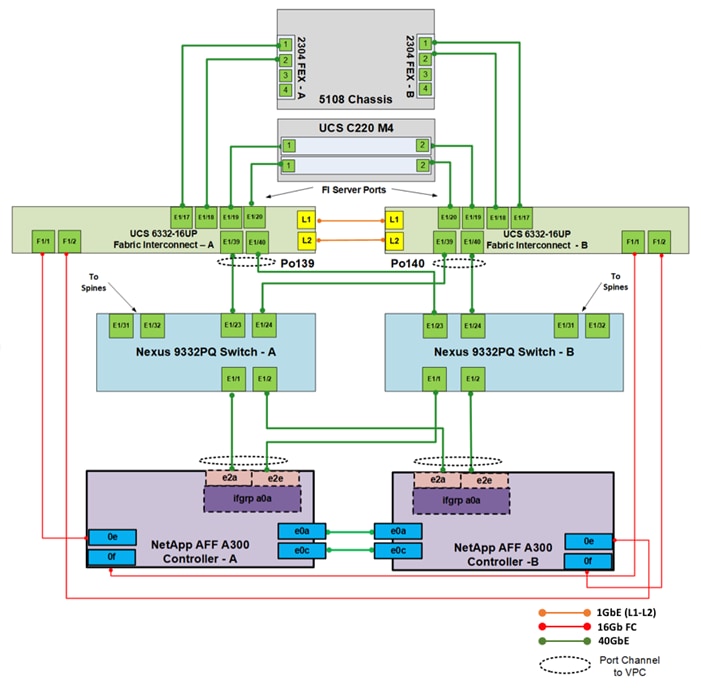
Active Directory DC/DNS
Production environments at most customers’ locations might have an active directory and DNS infrastructure configured. In this document we have assumed an existing AD domain controller and an AD integrated DNS server role running on the same server, which is available in our lab environment. We will configure two additional AD/DNS servers connected to the Core Services End Point Group (EPG) in the ACI Fabric. These AD/DNS servers will be configured as additional Domain Controllers in the same domain as the prerequisite AD/DNS server.
This section provides a detailed procedure for configuring the Cisco ACI fabric for use in a FlexPod environment and is written where the FlexPod components are added to an existing Cisco ACI fabric in several new ACI tenants. Required fabric setup is verified, but previous configuration of the ACI fabric is assumed.
![]() Follow these steps precisely because failure to do so could result in an improper configuration.
Follow these steps precisely because failure to do so could result in an improper configuration.
Physical Connectivity
Follow the physical connectivity guidelines for FlexPod as covered in section FlexPod Cabling.
In ACI, both spine and leaf switches are configured using APIC, individual configuration of the switches is not required. Cisco APIC discovers the ACI infrastructure switches using LLDP and acts as the central control and management point for the entire configuration.
Cisco Application Policy Infrastructure Controller (APIC) Verification
This sub-section verifies the setup of the Cisco APIC. Cisco recommends a cluster of at least 3 APICs controlling an ACI Fabric.
1. Log into the APIC GUI using a web browser, by browsing to the out of band IP address configured for APIC. Login with the admin user id and password.
![]() In this validation, Google Chrome was used as the web browser. It might take a few minutes before APIC GUI is available after the initial setup.
In this validation, Google Chrome was used as the web browser. It might take a few minutes before APIC GUI is available after the initial setup.
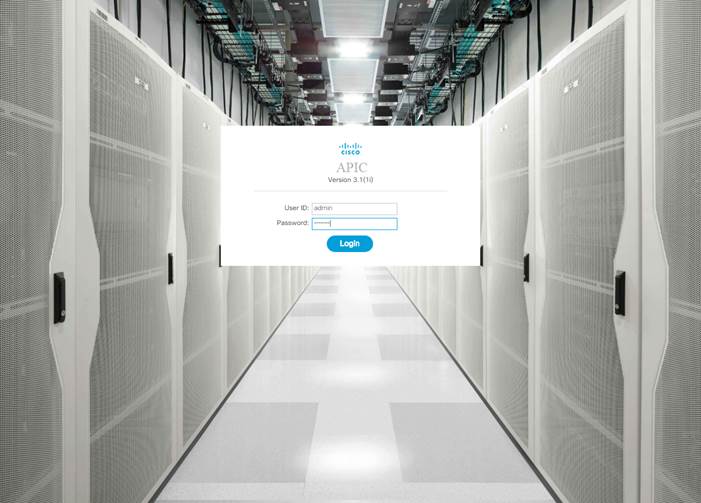
2. Take the appropriate action to close any warning or information screens.
3. At the top in the APIC home page, select the System tab followed by Controllers.
4. On the left, select the Controllers folder. Verify that at least 3 APICs are available and have redundant connections to the fabric.
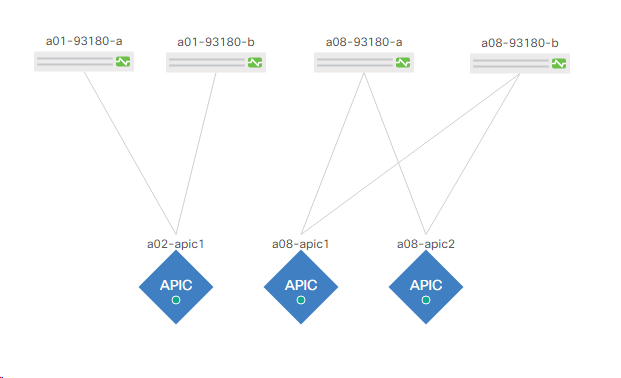
Cisco ACI Fabric Discovery
This section details the steps for adding the two Nexus 9332PQ leaf switches to the Fabric. This procedure is assuming that a FlexPod with dedicated leaves is being added to the fabric. If the two Nexus 9332s have already been added to the fabric, continue on to the next section. These switches are automatically discovered in the ACI Fabric and are manually assigned node IDs. To add Nexus 9332PQ leaf switches to the Fabric, complete the following steps:
1. At the top in the APIC home page, select the Fabric tab and make sure Inventory under Fabric is selected.
2. In the left pane, select and expand Fabric Membership.
3. The two 9332 Leaf Switches will be listed on the Fabric Membership page with Node ID 0 as shown:
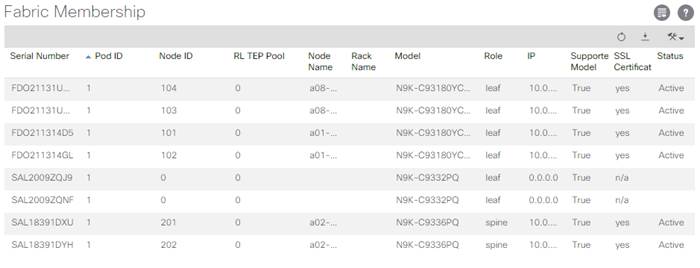
4. Connect to the two Nexus 9332 leaf switches using serial consoles and login in as admin with no password (press enter). Use show inventory to get the leaf’s serial number.

5. Match the serial numbers from the leaf listing to determine the A and B switches under Fabric Membership.
6. In the APIC GUI, under Fabric Membership, double-click the A leaf in the list. Enter a Node ID and a Node Name for the Leaf switch and click Update.
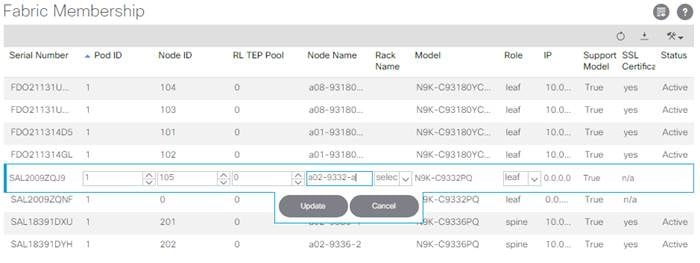
7. Repeat step 6 for the B leaf in the list.
8. Click Topology in the left pane. The discovered ACI Fabric topology will appear. It may take a few minutes for the Nexus 9332 Leaf switches to appear and you will need to click the refresh button for the complete topology to appear. You may also need to move the switches around to get the arrangement that you desire.
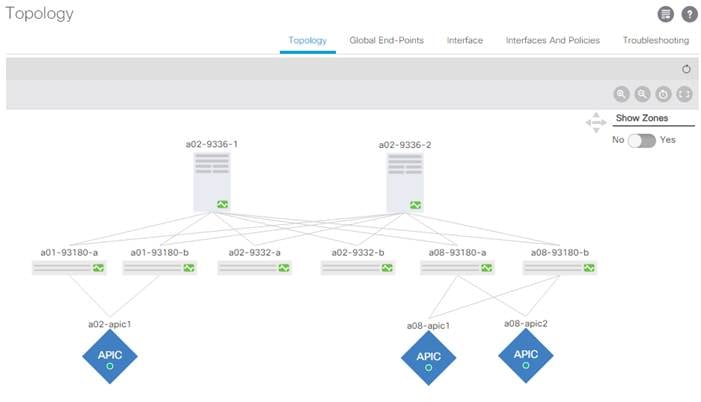
Initial ACI Fabric Setup Verification
This section details the steps for the initial setup of the Cisco ACI Fabric, where the software release is validated, out of band management IPs are assigned to the new leaves, NTP setup is verified, and the fabric BGP route reflectors are verified.
Software Upgrade
To upgrade the software, complete the following steps:
1. In the APIC GUI, at the top select Admin > Firmware.
2. This document was validated with ACI software release 3.1(1i). Select Fabric Node Firmware in the left pane under Firmware Management. All switches should show the same firmware release and the release version should be at minimum n9000-13.1(1i). The switch software version should also correlate with the APIC version.
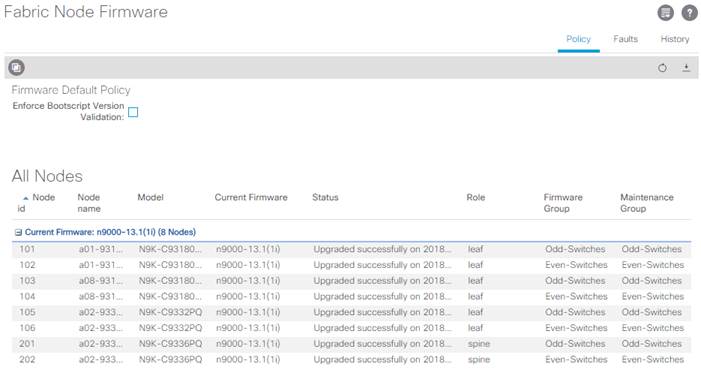
3. Click Admin > Firmware > Controller Firmware. If all APICs are not at the same release at a minimum of 3.1(1i), follow the Cisco APIC Management, Installation, Upgrade, and Downgrade Guide to upgrade both the APICs and switches if the APICs are not at a minimum release of 3.1(1i) and the switches are not at n9000-13.1(1i).
Setting Up Out-of-Band Management IP Addresses for New Leaf Switches
To set up out-of-band management IP addresses, complete the following steps:
1. To add out-of-band management interfaces for all the switches in the ACI Fabric, select Tenants > mgmt.
2. Expand Tenant mgmt on the left. Right-click Node Management Addresses and select Create Static Node Management Addresses.
3. Enter the node number range for the new leaf switches (105-106 in this example).
4. Select the checkbox for Out-of-Band Addresses.
5. Select default for Out-of-Band Management EPG.
6. Considering that the IPs will be applied in a consecutive range of two IPs, enter a starting IP address and netmask in the Out-Of-Band IPV4 Address field.
7. Enter the out of band management gateway address in the Gateway field.
8. Click SUBMIT, then click YES.
9. On the left, expand Node Management Addresses and select Static Node Management Addresses. Verify the mapping of IPs to switching nodes.
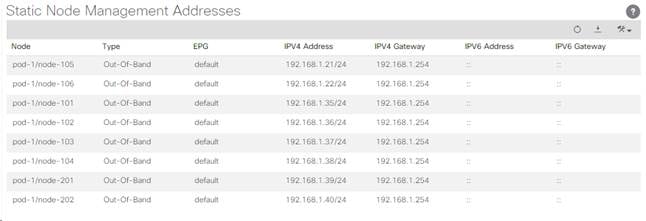
10. Direct out-of-band access to the switches is now available using SSH.
Verifying Time Zone and NTP Server
This procedure will allow customers to verify setup of an NTP server for synchronizing the fabric time. To verify the time zone and NTP server set up, complete the following steps:
1. To verify NTP setup in the fabric, select and expand Fabric > Fabric Policies > Pod Policies > Policies > Date and Time.
2. Select default. In the Datetime Format - default pane, verify the correct Time Zone is selected and that Offset State is enabled. Adjust as necessary and click Submit and Submit Changes.
3. On the left, select Policy default. Verify that at least one NTP Server is listed.
4. If desired, select enabled for Server State to enable the ACI fabric switches as NTP servers. Click Submit.
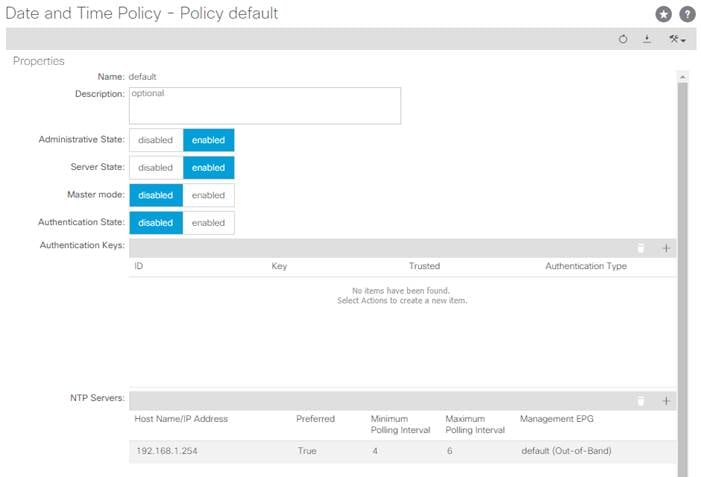
5. If necessary, on the right use the + sign to add NTP servers accessible on the out of band management subnet. Enter an IP address accessible on the out of band management subnet and select the default (Out-of-Band) Management EPG. Click Submit to add the NTP server. Repeat this process to add all NTP servers.
Verifying Domain Name Servers
To verify optional DNS in the ACI fabric, complete the following steps:
1. Select and expand Fabric > Fabric Policies > Global Policies > DNS Profiles > default.
2. Verify the DNS Providers and DNS Domains.
3. If necessary, in the Management EPG drop-down, select the default (Out-of-Band) Management EPG. Use the + signs to the right of DNS Providers and DNS Domains to add DNS servers and the DNS domain name. Note that the DNS servers should be reachable from the out of band management subnet. Click SUBMIT to complete the DNS configuration.
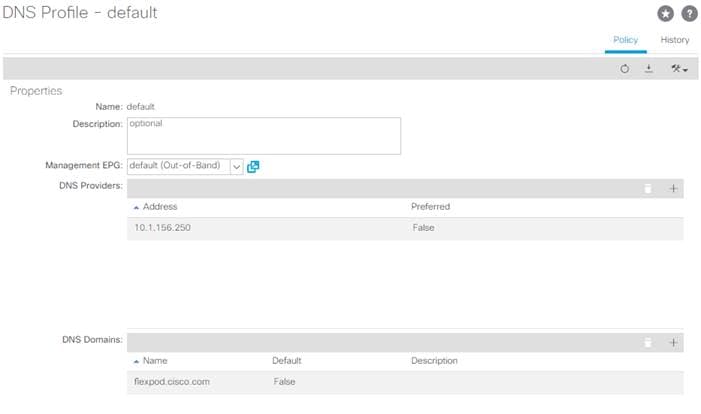
Verifying BGP Route Reflectors
In this ACI deployment, both the spine switches should be set up as BGP route-reflectors to distribute the leaf routes throughout the fabric. To verify the BGP Route Reflector, complete the following steps:
1. Select and expand System > System Settings > BGP Route Reflector.
2. Verify that a unique Autonomous System Number has been selected for this ACI fabric. If necessary, use the + sign on the right to add the two spines to the list of Route Reflector Nodes. Click SUBMIT to complete configuring the BGP Route Reflector.
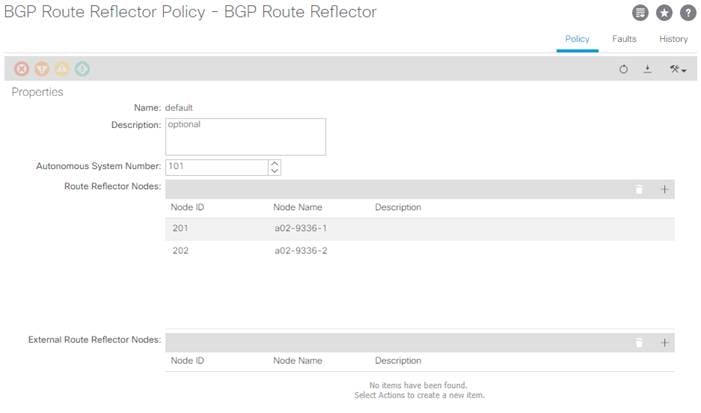
3. To verify the BGP Route Reflector has been enabled, select and expand Fabric > Fabric Policies > Pod Policies > Policy Groups. Under Policy Groups make sure a policy group has been created and select it. The BGP Route Reflector Policy field should show “default.”
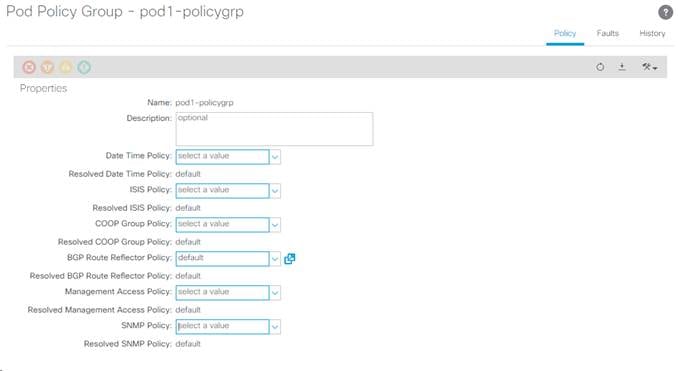
4. If a Policy Group has not been created, on the left, right-click Policy Groups under Pod Policies and select Create Pod Policy Group. In the Create Pod Policy Group window, name the Policy Group pod1-policygrp. Select the default BGP Route Reflector Policy. Click SUBMIT to complete creating the Policy Group.
5. On the left expand Profiles under Pod Policies and select Pod Profile default > default.
6. Verify that the pod1-policygrp or the Fabric Policy Group identified above is selected. If the Fabric Policy Group is not selected, view the drop-down list to select it and click Submit.

Verifying Fabric Wide Enforce Subnet Check for IP & MAC Learning
In this ACI deployment, Enforce Subnet Check for IP & MAC Learning should be enabled. To verify this setting, complete the following steps:
1. Select and expand System > System Settings > Fabric Wide Setting.
2. Ensure that Enforce Subnet Check is selected. If Enforce Subnet Check is not selected, select it and click Submit.

Verifying CoS Preservation Setting
In this FlexPod with ACI deployment, CoS Preservation should be turned off, complete the following steps to verify this setting:
1. Select and expand Fabric > Access Policies > Global Policies > QOS Class.
2. Ensure that Preserve QOS is not selected.

![]() In some shared deployments where other solutions in addition to FlexPod are being used, it may be necessary to enable this setting. The reason it is disabled in FlexPod is that NetApp AFF/FAS storage controllers inject CoS 4 on all tagged VLAN interfaces. Since FlexPod normally treats all UCS traffic as Best Effort (CoS 0), this setting is preferred. If it is desired to use other QoS classes than Best Effort in the UCS, then Preserve QOS should be enabled to preserve CoS marking on traffic going between the fabric interconnects. Note that the CoS 4 setting from the NetApp Storage Controllers will also be preserved and that should be considered when planning the QoS setup.
In some shared deployments where other solutions in addition to FlexPod are being used, it may be necessary to enable this setting. The reason it is disabled in FlexPod is that NetApp AFF/FAS storage controllers inject CoS 4 on all tagged VLAN interfaces. Since FlexPod normally treats all UCS traffic as Best Effort (CoS 0), this setting is preferred. If it is desired to use other QoS classes than Best Effort in the UCS, then Preserve QOS should be enabled to preserve CoS marking on traffic going between the fabric interconnects. Note that the CoS 4 setting from the NetApp Storage Controllers will also be preserved and that should be considered when planning the QoS setup.
Fabric Access Policy Setup
This section details the steps to create various access policies creating parameters for CDP, LLDP, LACP, etc. These policies are used during vPC and VM domain creation. In an existing fabric, these policies may already exist. The existing policies can be used if configured the same way as listed. To define fabric access policies, complete the following steps:
1. Log into the APIC AGUI.
2. In the APIC UI, select and expand Fabric > Access Policies > Interface Policies > Policies.
Create Link Level Policies
This procedure will create link level policies for setting up the 1Gbps, 10Gbps, and 40Gbps link speeds. To create the link level policies, complete the following steps:
1. In the left pane, right-click Link Level and select Create Link Level Policy.
2. Name the policy as 1Gbps-Auto and select the 1Gbps Speed.
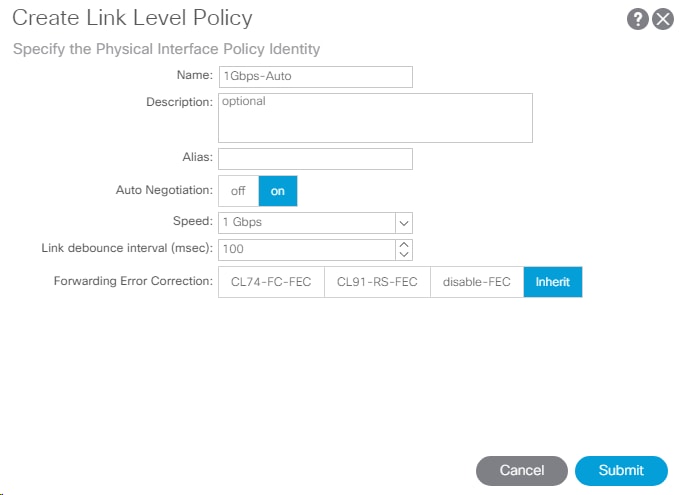
3. Click Submit to complete creating the policy.
4. In the left pane, right-click Link Level and select Create Link Level Policy.
5. Name the policy 10Gbps-Auto and select the 10Gbps Speed.
6. Click Submit to complete creating the policy.
7. In the left pane, right-click Link Level and select Create Link Level Policy.
8. Name the policy 40Gbps-Auto and select the 40Gbps Speed.
9. Click Submit to complete creating the policy.
Create CDP Policy
This procedure creates policies to enable or disable CDP on a link. To create a CDP policy, complete the following steps:
1. In the left pane, right-click CDP interface and select Create CDP Interface Policy.
2. Name the policy as CDP-Enabled and enable the Admin State.
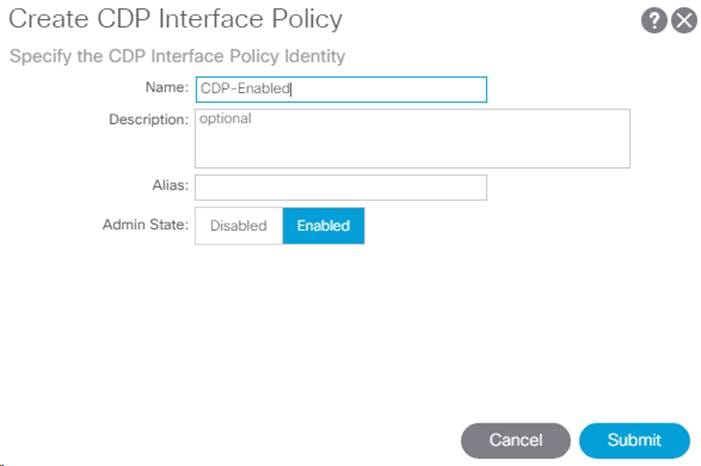
3. Click Submit to complete creating the policy.
4. In the left pane, right-click the CDP Interface and select Create CDP Interface Policy.
5. Name the policy CDP-Disabled and disable the Admin State.
6. Click Submit to complete creating the policy.
Create LLDP Interface Policies
This procedure will create policies to enable or disable LLDP on a link. To create an LLDP Interface policy, complete the following steps:
1. In the left pane, right-click LLDP lnterface and select Create LLDP Interface Policy.
2. Name the policy as LLDP-Enabled and enable both Transmit State and Receive State.
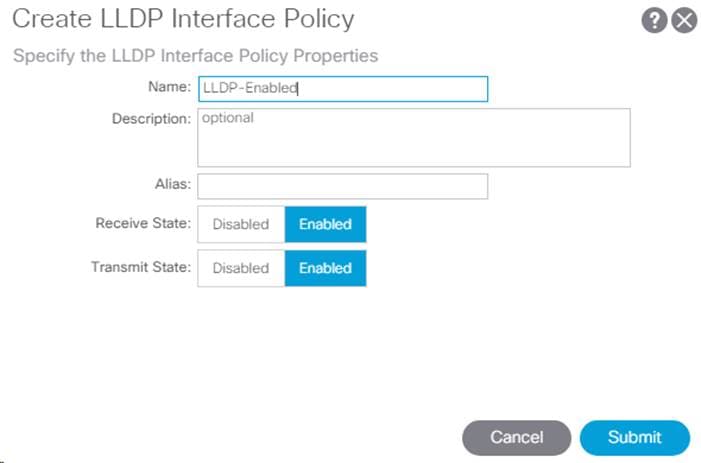
3. Click Submit to complete creating the policy.
4. In the left, right-click the LLDP lnterface and select Create LLDP Interface Policy.
5. Name the policy as LLDP-Disabled and disable both the Transmit State and Receive State.
6. Click Submit to complete creating the policy.
Create Port Channel Policy
This procedure will create policies to set LACP active mode configuration and the MAC-Pinning mode configuration. To create the Port Channel policy, complete the following steps:
1. In the left pane, right-click Port Channel and select Create Port Channel Policy.
2. Name the policy as LACP-Active and select LACP Active for the Mode. Do not change any of the other values.
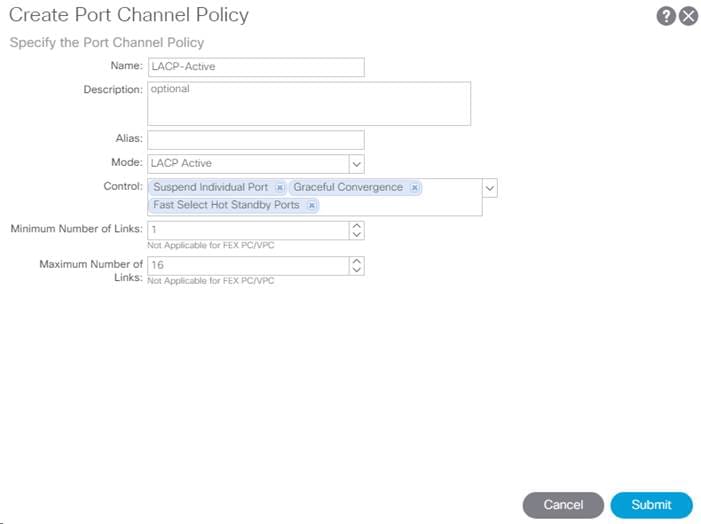
3. Click Submit to complete creating the policy.
4. In the left pane, right-click Port Channel and select Create Port Channel Policy.
5. Name the policy as MAC-Pinning and select MAC Pinning-Physical-NIC-load for the Mode. Do not change any of the other values.
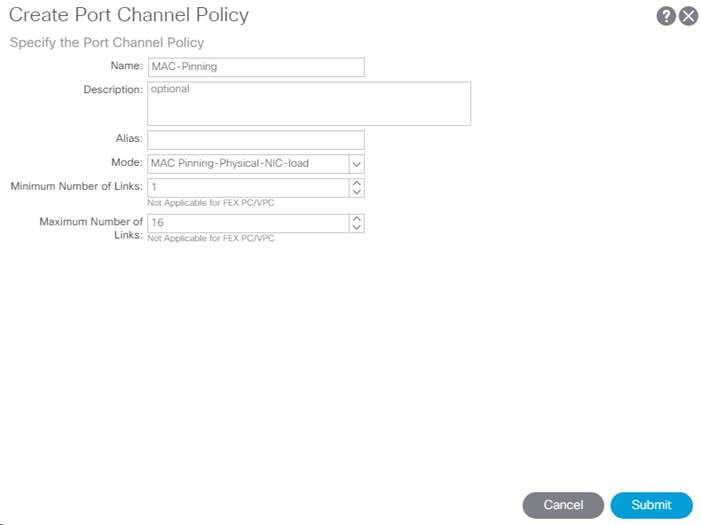
6. Click Submit to complete creating the policy.
7. In the left pane, right-click Port Channel and select Create Port Channel Policy.
Create BPDU Filter/Guard Policies
This procedure will create policies to enable or disable BPDU filter and guard. To create a BPDU filter/Guard policy, complete the following steps:
1. In the left pane, right-click Spanning Tree Interface and select Create Spanning Tree Interface Policy.
2. Name the policy as BPDU-FG-Enabled and select both the BPDU filter and BPDU Guard Interface Controls.
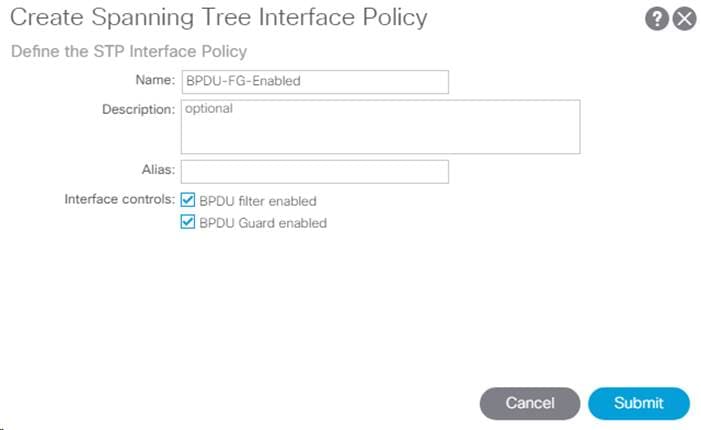
3. Click Submit to complete creating the policy.
4. In the left pane, right-click Spanning Tree Interface and select Create Spanning Tree Interface Policy.
5. Name the policy as BPDU-FG-Disabled and make sure both the BPDU filter and BPDU Guard Interface Controls are cleared.
6. Click Submit to complete creating the policy.
Create VLAN Scope Policy
To create policies to enable port local scope for all the VLANs, complete the following steps:
1. In the left pane, right-click the L2 Interface and select Create L2 Interface Policy.
2. Name the policy as VLAN-Scope-Port-Local and make sure Port Local scope is selected for VLAN Scope. Do not change any of the other values.
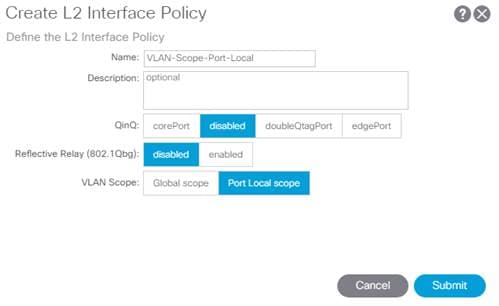
3. Click Submit to complete creating the policy.
4. Repeat above steps to create a VLAN-Scope-Global Policy and make sure Global scope is selected for VLAN Scope. Do not change any of the other values. See below.
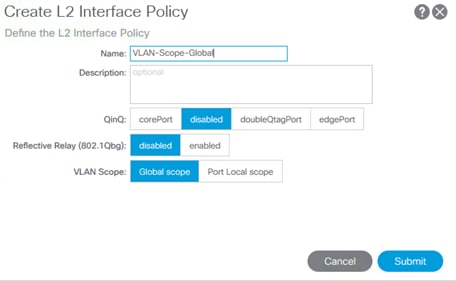
Create Firewall Policy
To create policies to disable a firewall, complete the following steps:
1. In the left pane, right-click Firewall and select Create Firewall Policy.
2. Name the policy Firewall-Disabled and select Disabled for Mode. Do not change any of the other values.
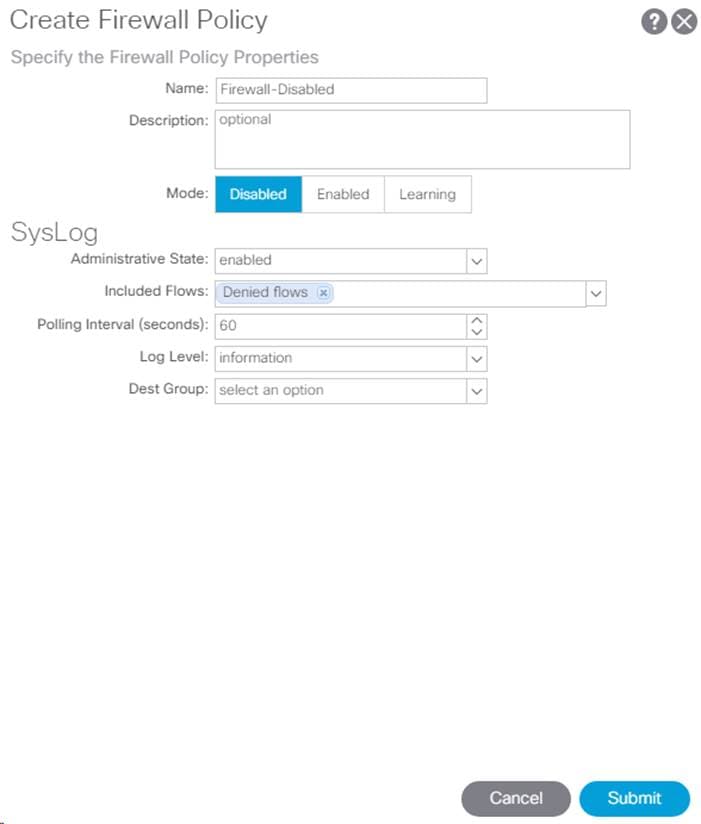
3. Click Submit to complete creating the policy.
Create Virtual Port Channels (vPCs)
This section details the steps to setup vPCs for connectivity to the In-Band Management Network, Cisco UCS, and NetApp Storage.
VPC - Management Switch
To setup a vPC for connectivity to the existing In-Band Management Network, complete the following steps:
![]() This deployment guide covers the configuration for a single, pre-existing Cisco Nexus management switch. You can adjust the management configuration depending on your connectivity setup. The In-Band Management Network provides connectivity of Management Virtual Machines and Hosts in the ACI fabric to existing services on the In-Band Management network outside of the ACI fabric. Layer 3 connectivity outside of the ACI Fabric is assumed between the In-Band and Out-of-Band Management networks. This setup creates management networks that are physically isolated from tenant networks. In this validation, a 10GE vPC from two 10GE capable leaf switches in the fabric is connected to a port-channel on a Nexus 5K switch outside the fabric. Note that this vPC is not created on the Nexus 9332 leaves, but on other existing leaves that have 10GE ports.
This deployment guide covers the configuration for a single, pre-existing Cisco Nexus management switch. You can adjust the management configuration depending on your connectivity setup. The In-Band Management Network provides connectivity of Management Virtual Machines and Hosts in the ACI fabric to existing services on the In-Band Management network outside of the ACI fabric. Layer 3 connectivity outside of the ACI Fabric is assumed between the In-Band and Out-of-Band Management networks. This setup creates management networks that are physically isolated from tenant networks. In this validation, a 10GE vPC from two 10GE capable leaf switches in the fabric is connected to a port-channel on a Nexus 5K switch outside the fabric. Note that this vPC is not created on the Nexus 9332 leaves, but on other existing leaves that have 10GE ports.

Table 4 VLAN for Incoming IB-MGMT
| Name | VLAN |
| IB-MGMT | <118> |
1. In the APIC GUI, at the top select Fabric > Access Policies > Quick Start.
2. In the right pane select Configure an interface, PC and VPC.
3. In the configuration window, configure a VPC domain between the 10GE capable leaf switches by clicking “+” under VPC Switch Pairs. If a VPC Domain already exists between the two switches being used for this vPC, skip to step 7.

4. Enter a VPC Domain ID (1 in this example).
5. From the drop-down list, select Switch A and Switch B IDs to select the two leaf switches.

6. Click SAVE.
7. If a profile for the two leaf switches being used does not already exist under Configured Switch Interfaces, click the “+” under Configured Switch Interfaces. If the profile does exist, select it and proceed to step 10.

8. From the Switches drop-down list on the right, select both the leaf switches being used for this vPC.
9. Leave the system generated Switch Profile Name in place.
10. Click the big green “+” on the right to configure switch interfaces.
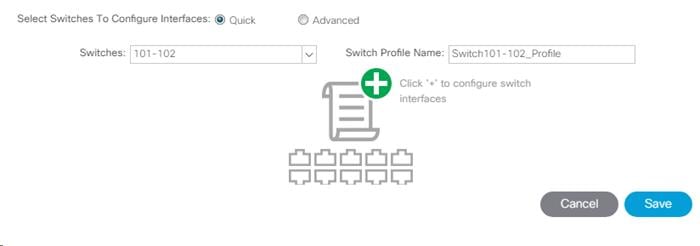
11. Configure various fields as shown in the figure below. In this screen shot, port 1/21 on both leaf switches is connected to a Nexus switch using 10Gbps links.
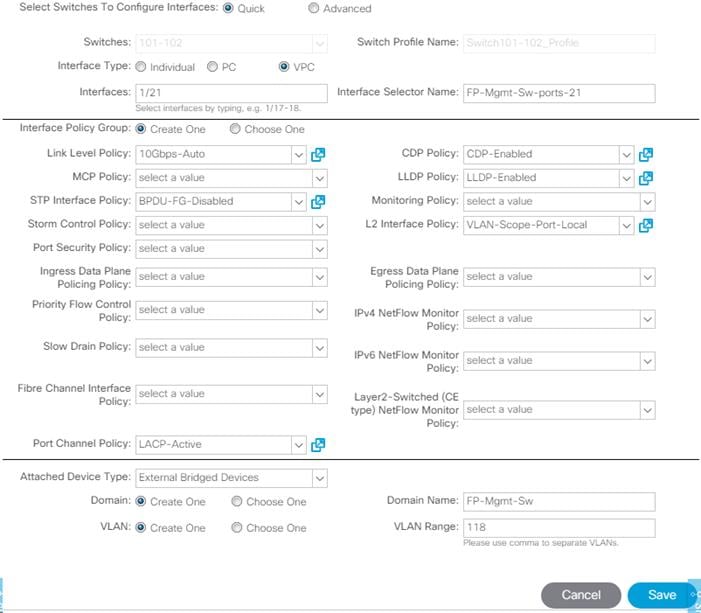
12. Click Save.
13. Click Save again to finish the configuring switch interfaces.
14. Click Submit.
![]() To validate the configuration, log into the Nexus switch and verify the port-channel is up (show port-channel summary).
To validate the configuration, log into the Nexus switch and verify the port-channel is up (show port-channel summary).
VPC – UCS Fabric Interconnects
Complete the following steps to setup vPCs for connectivity to the UCS Fabric Interconnects.
Figure 3 VLANs Configured for Cisco UCS

Table 5 VLANs for Cisco UCS Hosts
| Name | VLAN |
| Native | <2> |
| Core-Services | <318> |
| AV-IB-Mgmt | <419> |
| AV-vMotion | <3000> |
| AV-Infra-NFS | <3150> |
| AV-Infra-iSCSI-A | <3110> |
| AV-Infra-iSCSI-B | <3120> |
1. In the APIC GUI, select Fabric > Access Policies > Quick Start.
2. In the right pane, select Configure and interface, PC and VPC.
3. In the configuration window, configure a VPC domain between the 9332 leaf switches by clicking “+” under VPC Switch Pairs.

4. Enter a VPC Domain ID (10 in this example).
5. From the drop-down list, select 9332 Switch A and 9332 Switch B IDs to select the two leaf switches.

6. Click Save.
7. Click the “+” under Configured Switch Interfaces.
8. Select the two Nexus 9332 switches under the Switches drop-down list.
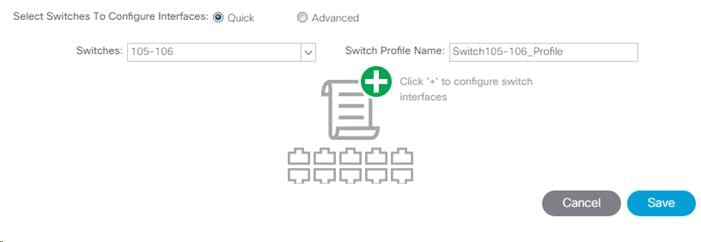
9. Click ![]() to add switch interfaces.
to add switch interfaces.
10. Configure various fields as shown in the figure below. In this screenshot, port 1/23 on both leaf switches is connected to UCS Fabric Interconnect A using 40Gbps links.
![]() It is not recommended to use ports 1/25 and 1/26 for port-channels on a Nexus 9332PQ.
It is not recommended to use ports 1/25 and 1/26 for port-channels on a Nexus 9332PQ.
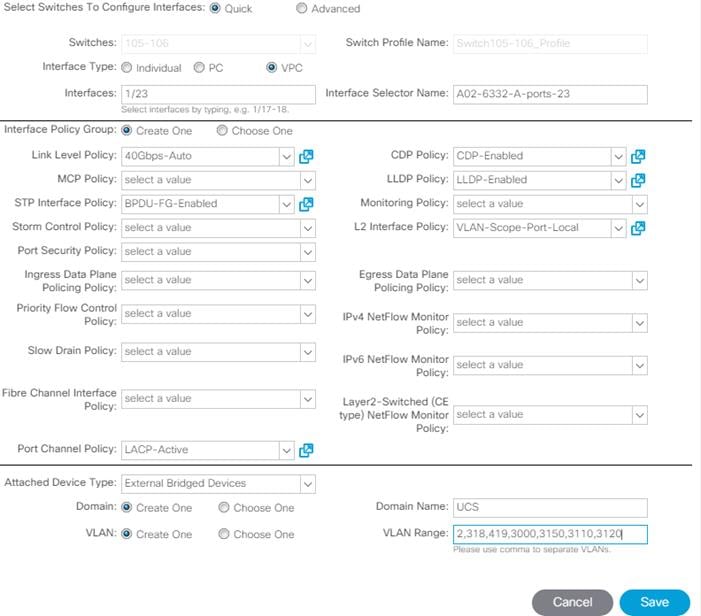
11. Click Save.
12. Click Save again to finish the configuring switch interfaces.
13. Click Submit.
14. From the right pane, select Configure and interface, PC and VPC.
15. Select the switches configured in the last step under Configured Switch Interfaces.
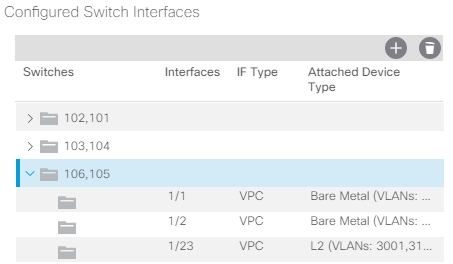
16. Click ![]() on the right to add switch interfaces.
on the right to add switch interfaces.
17. Configure various fields as shown in the screenshot. In this screenshot, port 1/24 on both leaf switches is connected to UCS Fabric Interconnect B using 40Gbps links. Instead of creating a new domain, the External Bridged Device created in the last step (UCS) is attached to the FI-B as shown below.
![]() It is not recommended to use ports 1/25 and 1/26 for port-channels on a Nexus 9332PQ.
It is not recommended to use ports 1/25 and 1/26 for port-channels on a Nexus 9332PQ.
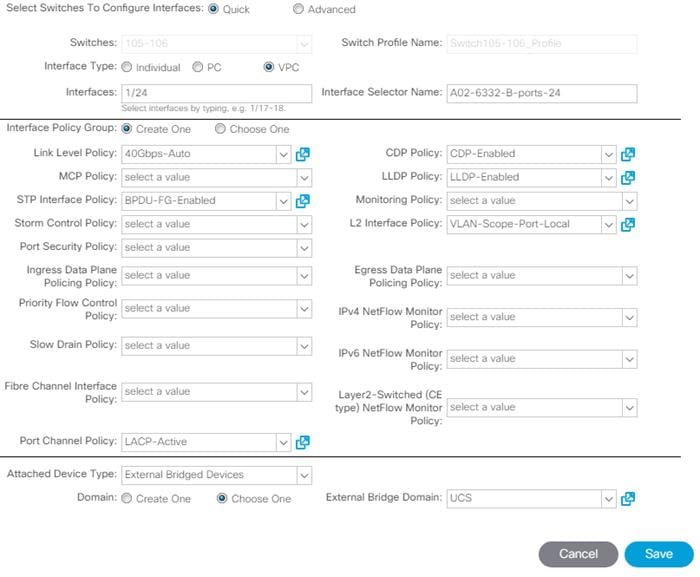
18. Click Save.
19. Click Save again to finish the configuring switch interfaces.
20. Click Submit.
21. Optional: Repeat this procedure to configure any additional UCS domains. For a uniform configuration, the External Bridge Domain (UCS) will be utilized for all the Fabric Interconnects.
VPC – NetApp AFF Cluster
Complete the following steps to setup vPCs for connectivity to the NetApp AFF storage controllers. The VLANs configured for NetApp are shown in Table 6.

| VLAN | |
| SVM-MGMT | <219> |
| NFS | <3050> |
| iSCSI-A | <3010> |
| iSCSI-B | <3020> |
1. In the APIC GUI, select Fabric > Access Policies > Quick Start.
2. In the right pane, select Configure and interface, PC and VPC.
3. Select the paired Nexus 9332 switches configured in the last step under Configured Switch Interfaces.
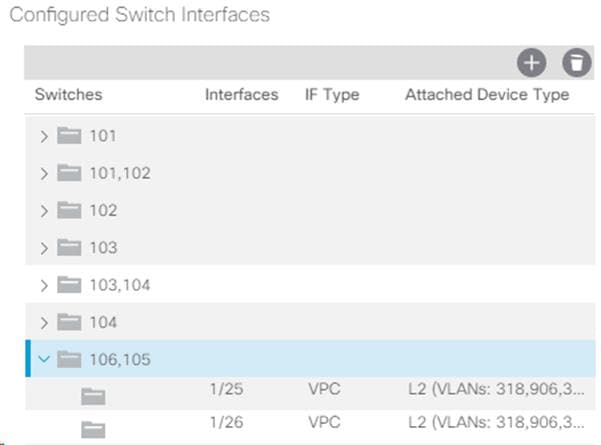
4. Click ![]() on the right to add switch interfaces.
on the right to add switch interfaces.
5. Configure various fields as shown in the screenshot below. In this screen shot, port 1/1 on both leaf switches is connected to Storage Controller 1 using 40Gbps links.
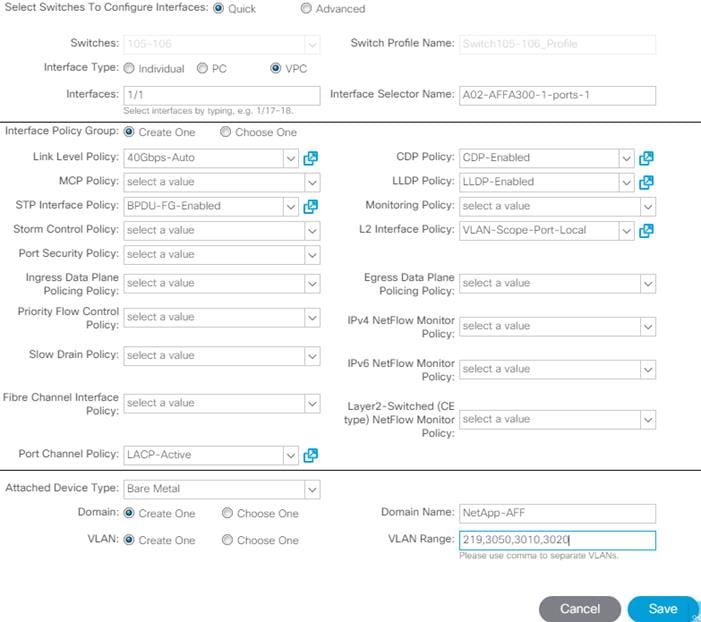
6. Click Save.
7. Click Save again to finish the configuring switch interfaces.
8. Click Submit.
9. From the right pane, select Configure and interface, PC and VPC.
10. Select the paired Nexus 9332 switches configured in the last step under Configured Switch Interfaces.
11. Click ![]() to add switch interfaces.
to add switch interfaces.
12. Configure various fields as shown in the screenshot below. In this screenshot, port 1/2 on both leaf switches is connected to Storage Controller 2 using 40Gbps links. Instead of creating a new domain, the Bare Metal Device created in the previous step (NetApp-AFF) is attached to the storage controller 2 as shown below.
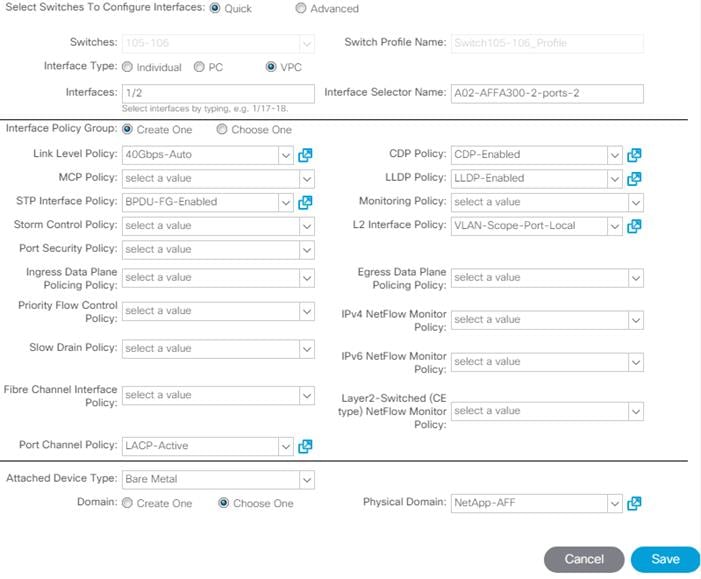
13. Click Save.
14. Click Save again to finish the configuring switch interfaces.
15. Click Submit.
16. Optional: Repeat this procedure to configure any additional NetApp AFF storage controllers. For a uniform configuration, the Bare Metal Domain (NetApp-AFF) will be utilized for all the Storage Controllers.
Configuring Common Tenant for In-Band Management Access
This section details the steps to setup in-band management access in the Tenant common. This design will allow all the other tenant EPGs to access the common management segment for Core Services VMs such as AD/DNS.
1. In the APIC GUI, select Tenants > common.
2. In the left pane, expand Tenant common and Networking.
Create VRFs
To create VRFs, complete the following steps:
1. Right-click VRFs and select Create VRF.
2. Enter vrf-FP-Common-IB-MGMT as the name of the VRF.
3. Uncheck Create A Bridge Domain.
4. Click Finish.
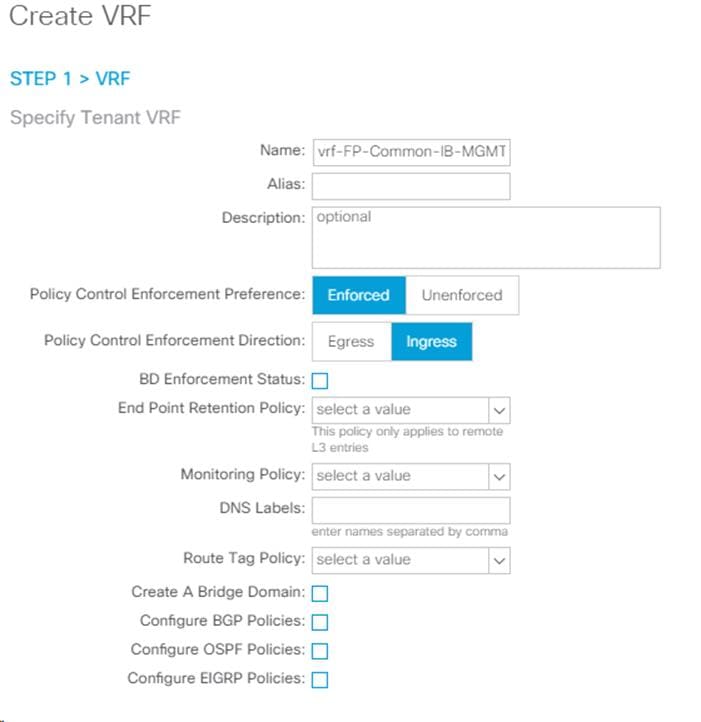
Create Bridge Domain
To create the incoming IB-MGMT Bridge domain for Core-Services, complete the following steps:
1. In the APIC GUI, select Tenants > common.
2. In the left pane, expand Tenant common and Networking.
3. Right-click Bridge Domains and select Create Bridge Domain.
4. Name the Bridge Domain as BD-FP-common-Core-Services.
5. Select vrf-FP-Common-IB-MGMT from the VRF drop-down list.
6. Select Custom under Forwarding and enable the flooding as shown in the screenshot below.
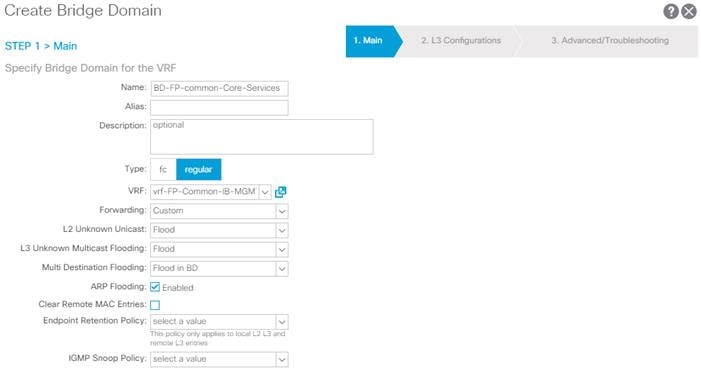
7. Click Next.
8. Under L3 Configurations, make sure Limit IP Learning to Subnet is selected and select EP Move Detection Mode – GARP based detection. Select Next.
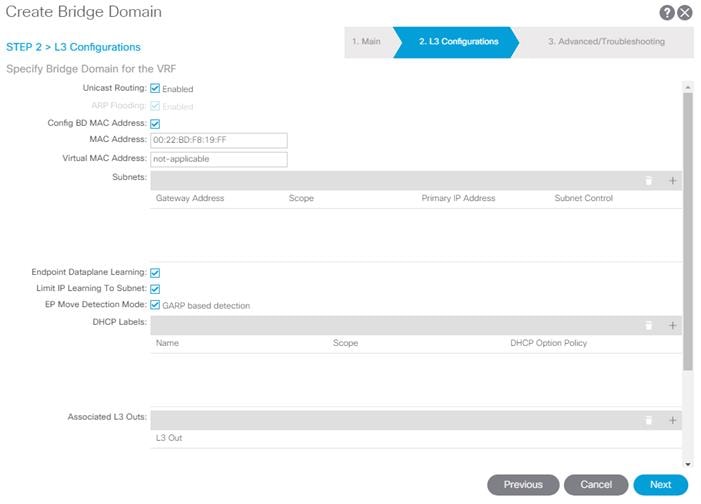
9. No changes are needed Advanced/Troubleshooting. Click FINISH.
Create Application Profile
To create an Application profile, complete the following steps:
1. In the APIC GUI, select Tenants > common.
2. In the left pane, expand Tenant common and Application Profiles.
3. Right-click the Application Profiles and select Create Application Profiles.
4. Enter Core-Services as the name of the application profile.
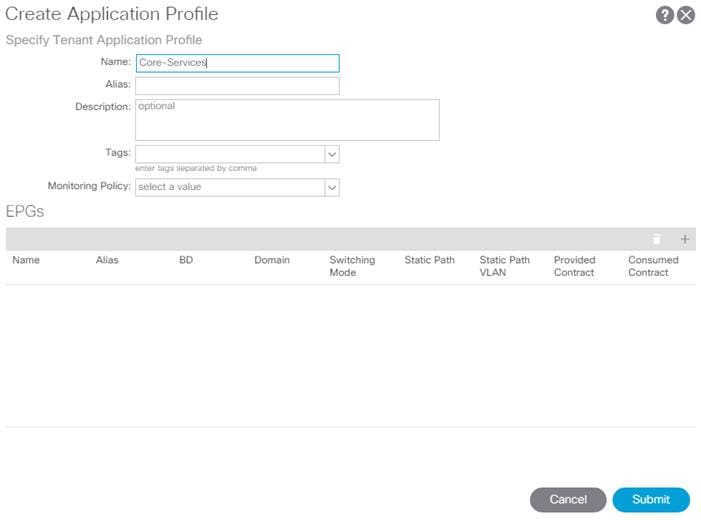
5. Click Submit.
Create EPG
To create the Core-Services EPG, complete the following steps:
1. Expand the Core-Services Application Profile and right-click Application EPGs.
2. Select Create Application EPG.
3. Enter Core-Services as the name of the EPG.
4. Select BD-FP-common-Core-Services from the drop-down list for Bridge Domain.
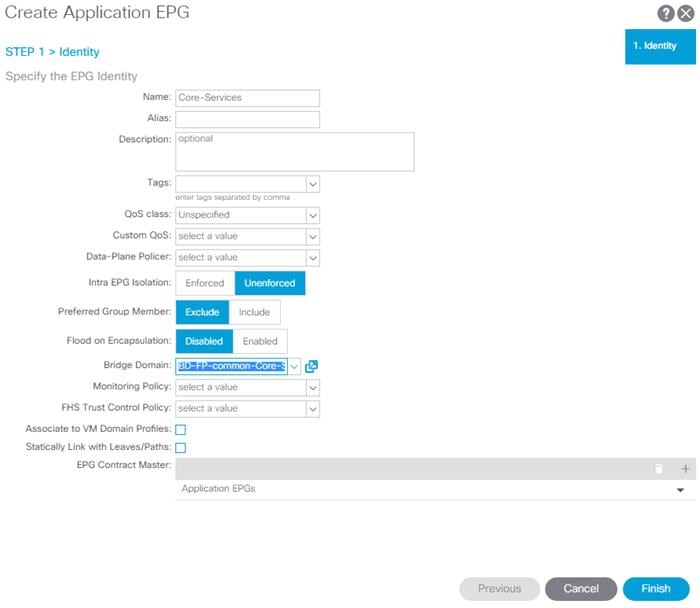
5. Click Finish.
Set Domains for the EPG
To set Domains, complete the following steps:
1. Expand the newly create EPG and click Domains.
2. Right-click Domains and select Add L2 External Domain Association.
3. Select the FP-Mgmt-Sw as the L2 External Domain Profile.
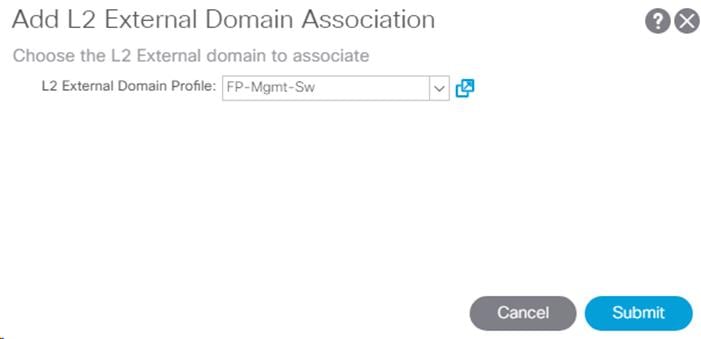
4. Click Submit.
5. Right-click Domains and select Add L2 External Domain Association.
6. Select the UCS as the L2 External Domain Profile.
7. Click Submit.
Set Static Ports for the EPG
To set Static Ports, complete the following steps:
1. In the left pane, right-click Static Ports.
2. Select Deploy Static EPG on PC, VPC, or Interface.
3. In the next screen, for the Path Type, select Virtual Port Channel and from the Path drop-down list, select the VPC for FP-Mgmt-Sw configured earlier.
4. Enter the external IB-MGMT VLAN under Port Encap.
5. Change Deployment Immediacy to Immediate.
6. Set the Mode to Trunk.
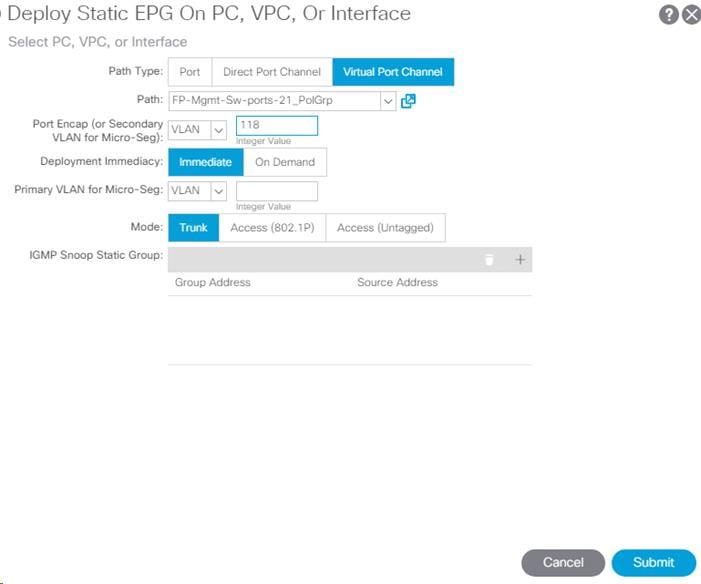
7. Click Submit.
8. In the left pane, right-click Static Ports.
9. Select Deploy Static EPG on PC, VPC, or Interface.
10. In the next screen, for the Path Type, select Virtual Port Channel and from the Path drop-down list, select the VPC for UCS Fabric Interconnect A configured earlier.
11. Enter the UCS Core-Services VLAN under Port Encap.
![]() This VLAN should be a different VLAN than the one entered above for the Management Switch.
This VLAN should be a different VLAN than the one entered above for the Management Switch.
12. Change Deployment Immediacy to Immediate.
13. Set the Mode to Trunk.
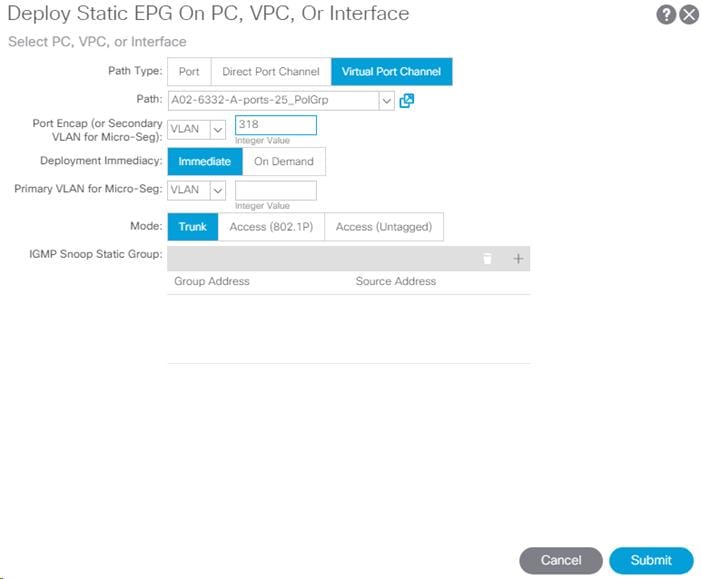
14. Click Submit.
15. In the left pane, right-click Static Ports.
16. Select Deploy Static EPG on PC, VPC, or Interface.
17. In the next screen, for the Path Type, select Virtual Port Channel and from the Path drop-down list, select the VPC for UCS Fabric Interconnect B configured earlier.
18. Enter the UCS Core-Services VLAN under Port Encap.
![]() This VLAN should be a different VLAN than the one entered above for the Management Switch.
This VLAN should be a different VLAN than the one entered above for the Management Switch.
19. Change Deployment Immediacy to Immediate.
20. Set the Mode to Trunk.
21. Click Submit.
Create EPG Subnet
A subnet gateway for this Core Services EPG provides Layer 3 connectivity to Tenant subnets. To create a EPG Subnet, complete the following steps:
1. In the left pane, right-click Subnets and select Create EPG Subnet.
2. In CIDR notation, enter an IP address and subnet mask to serve as the gateway within the ACI fabric for routing between the Core Services subnet and Tenant subnets. This IP should be different than the IB-MGMT subnet gateway. In this lab validation, 10.1.118.1/24 is the IB-MGMT subnet gateway and is configured externally to the ACI fabric. 10.1.118.254/24 will be used for the EPG subnet gateway. Set the Scope of the subnet to Shared between VRFs.
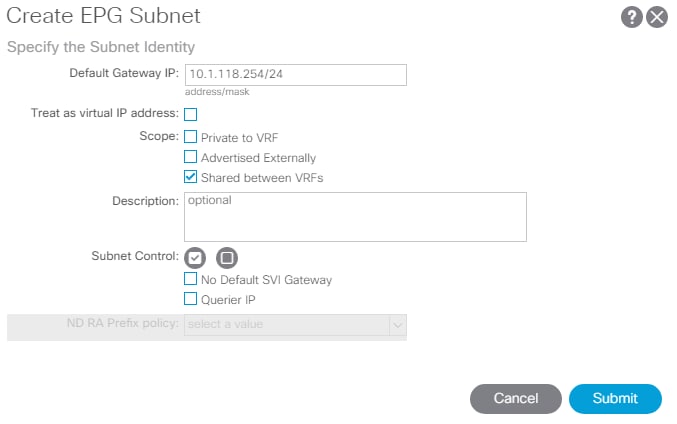
3. Click Submit to create the Subnet.
Create Provided Contract
To create Provided Contract, complete the following steps:
1. In the left pane, right-click Contracts and select Add Provided Contract.
2. In the Add Provided Contract window, select Create Contract from the drop-down list.
3. Name the Contract FP-Allow-Common-Core-Services.
4. Set the scope to Global.
5. Click + to add a Subject to the Contract.
![]() The following steps create a contract to allow all the traffic between various tenants and the common management segment. You are encouraged to limit the traffic by setting restrictive filters.
The following steps create a contract to allow all the traffic between various tenants and the common management segment. You are encouraged to limit the traffic by setting restrictive filters.
6. Name the subject Allow-All-Traffic.
7. Click + under Filter Chain to add a Filter.
8. From the drop-down Name list, select common/default.
9. In the Create Contract Subject window, click Update to add the Filter Chain to the Contract Subject.
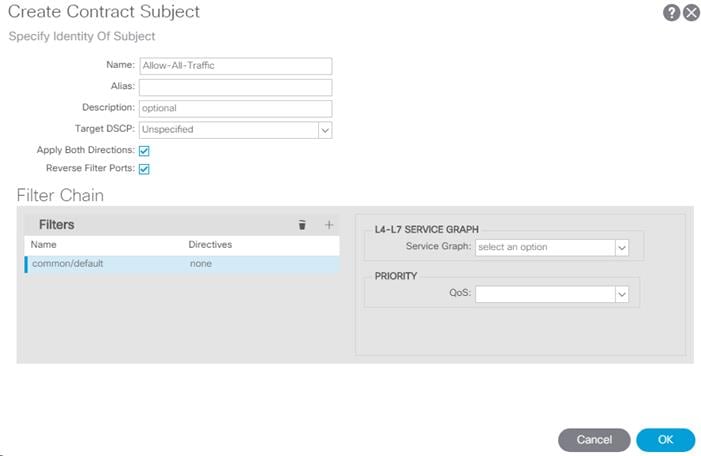
10. Click OK to add the Contract Subject.
![]() The Contract Subject Filter Chain can be modified later.
The Contract Subject Filter Chain can be modified later.
11. Click Submit to finish creating the Contract.
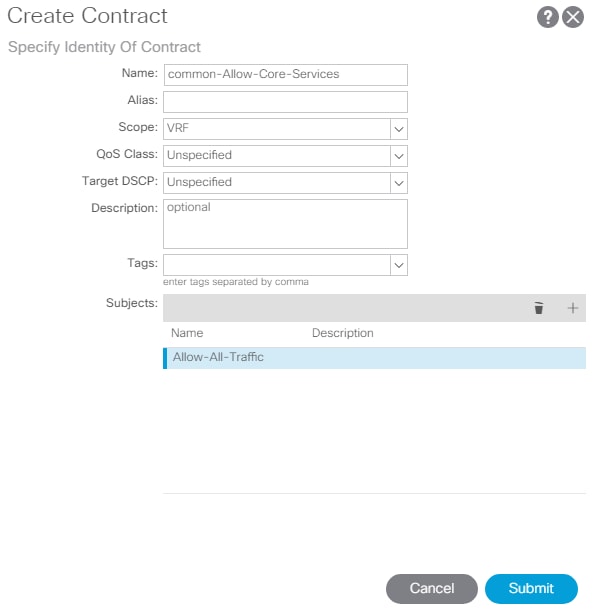
12. Click Submit to finish adding a Provided Contract.
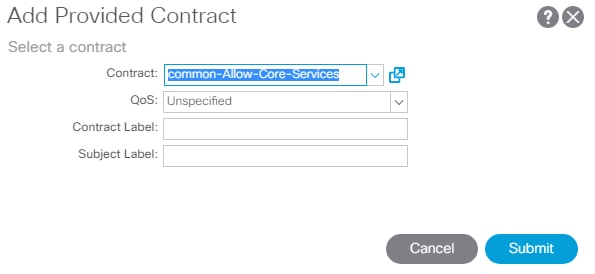
Create Security Filters in Tenant Common
To create Security Filters for NFSv3 with NetApp Storage and for iSCSI, complete the following steps. This section can also be used to set up other filters necessary to your environment.
1. In the APIC GUI, at the top select Tenants > common.
2. On the left, expand Tenant common, Contracts, and Filters.
3. Right-click Filters and select Create Filter.
4. Name the filter Allow-All.
5. Click the + sign to add an Entry to the Filter.
6. Name the Entry Allow-All and select EtherType IP.
7. Leave the IP Protocol set at Unspecified.
8. Click UPDATE to add the Entry.
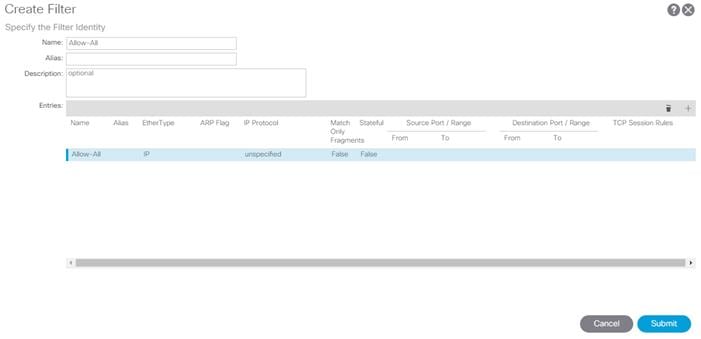
9. Click SUBMIT to complete adding the Filter.
10. Right-click Filters and select Create Filter.
11. Name the filter NTAP-NVS-v3.
12. Click the + sign to add an Entry to the Filter.
13. Name the Entry tcp-111 and select EtherType IP.
14. Select the tcp IP Protocol and enter 111 for From and To under the Destination Port / Range by backspacing over Unspecified and entering the number.
15. Click UPDATE to add the Entry.
16. Click the + sign to add another Entry to the Filter.
17. Name the Entry tcp-635 and select EtherType IP.
18. Select the tcp IP Protocol and enter 635 for From and To under the Destination Port / Range by backspacing over Unspecified and entering the number.
19. Click UPDATE to add the Entry.
20. Click the + sign to add another Entry to the Filter.
21. Name the Entry tcp-2049 and select EtherType IP.
22. Select the tcp IP Protocol and enter 2049 for From and To under the Destination Port / Range by backspacing over Unspecified and entering the number.
23. Click UPDATE to add the Entry.
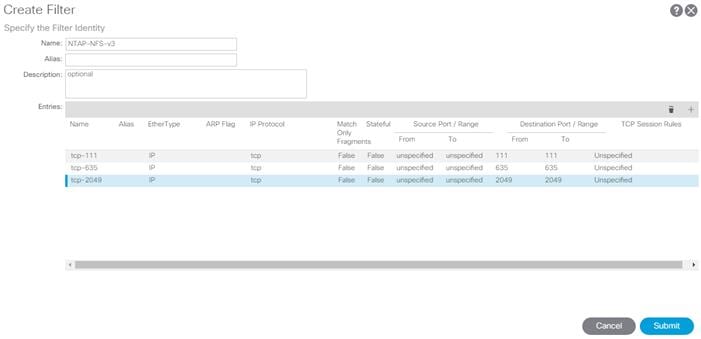
24. Click SUBMIT to complete adding the Filter.
25. Right-click Filters and select Create Filter.
26. Name the filter iSCSI.
27. Click the + sign to add an Entry to the Filter.
28. Name the Entry iSCSI and select EtherType IP.
29. Select the TCP IP Protocol and enter 3260 for From and To under the Destination Port / Range by backspacing over Unspecified and entering the number.
30. Click UPDATE to add the Entry.
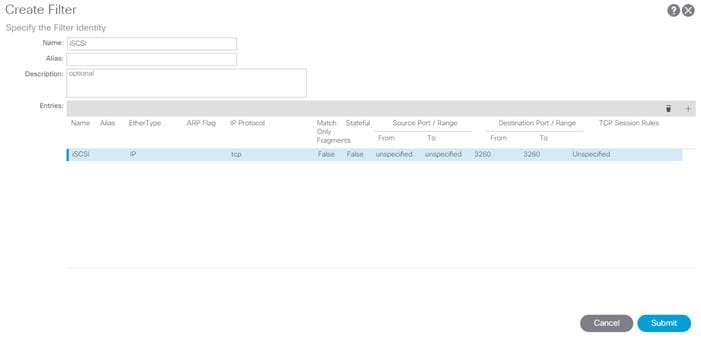
31. Click SUBMIT to complete adding the Filter.
![]() By adding these Filters to Tenant common, they can be used from within any Tenant in the ACI Fabric.
By adding these Filters to Tenant common, they can be used from within any Tenant in the ACI Fabric.
Deploy FPV-Foundation Tenant
This section details the steps for creating the FPV-Foundation Tenant in the ACI Fabric. This tenant will host infrastructure connectivity for the compute (VMware ESXi on UCS nodes) and the storage environments. To deploy the FPV-Foundation Tenant, complete the following steps:
1. In the APIC GUI, select Tenants > Add Tenant.
2. Name the Tenant FPV-Foundation.
3. For the VRF Name, enter FPV-Foundation. Keep the check box “Take me to this tenant when I click finish” checked.
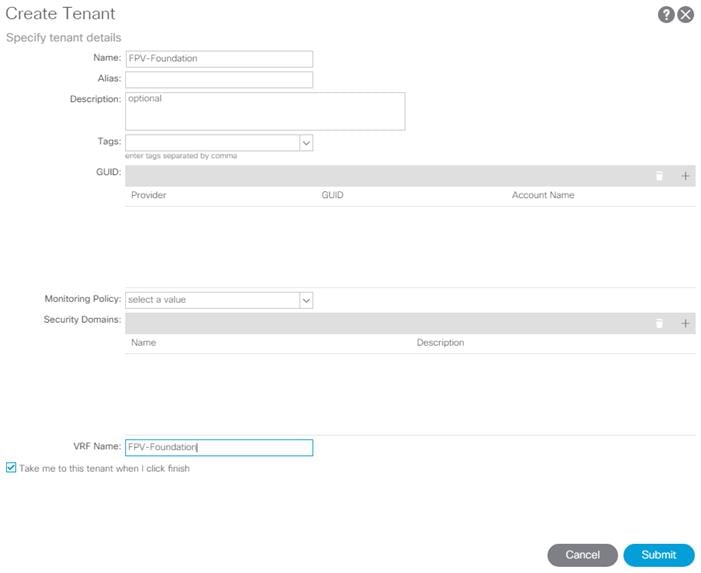
4. Click Submit to finish creating the Tenant.
Create Bridge Domain
To create a Bridge Domain, complete the following steps:
1. In the left pane, expand Tenant FPV-Foundation and Networking.
2. Right-click Bridge Domains and select Create Bridge Domain.
3. Name the Bridge Domain BD-FPV-Foundation-Internal.
4. Select FPV-Foundation from the VRF drop-down list.
5. Select Custom under Forwarding and enable flooding.
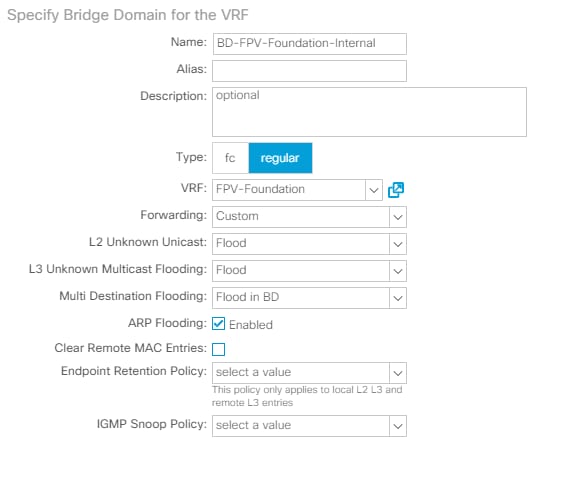
6. Click Next.
7. Under L3 Configurations, make sure Limit IP Learning to Subnet is selected and select EP Move Detection Mode – GARP based detection. Select Next.
8. No changes are needed for Advanced/Troubleshooting. Click Finish to finish creating the Bridge Domain.
Create Application Profile for IB-Management Access
To create an application profile for IB-Management Access, complete the following steps:
1. In the left pane, expand tenant FPV-Foundation, right-click Application Profiles and select Create Application Profile.
2. Name the Application Profile IB-MGMT and click Submit to complete adding the Application Profile.
Create EPG for IB-MGMT Access
This EPG will be used for VMware ESXi hosts and management virtual machines that are in the IB-MGMT subnet, but that do not provide ACI fabric Core Services. For example, AD server VMs could be placed in the Core Services EPG defined earlier to provide DNS services to tenants in the Fabric. Monitoring VMs can be placed in the IB-MGMT EPG and they will have access to the Core Services VMs, but will not be reachable from Tenant VMs.
To create the EPG for IB-MGMT access, complete the following steps:
1. In the left pane, expand the Application Profiles and right-click the IB-MGMT Application Profile and select Create Application EPG.
2. Name the EPG IB-MGMT.
3. From the Bridge Domain drop-down list, select Bridge Domain BD-FP-common-Core-Services from Tenant common.
![]() Placing this EPG in the BD-FP-common-Core-Services Bridge Domain enables L2 connectivity between hosts and VMs placed in this EPG and hosts and VMs placed in the Core-Services EPG in Tenant common, including the Core-Services default gateway that is mapped into the Core-Services EPG as an External Bridged Device.
Placing this EPG in the BD-FP-common-Core-Services Bridge Domain enables L2 connectivity between hosts and VMs placed in this EPG and hosts and VMs placed in the Core-Services EPG in Tenant common, including the Core-Services default gateway that is mapped into the Core-Services EPG as an External Bridged Device.

4. Click Finish to complete creating the EPG.
5. In the left menu, expand the newly created EPG, right-click Domains and select Add L2 External Domain Association.
6. Select the UCS L2 External Domain Profile and click Submit.
7. In the left menu, right-click Static Ports and select Deploy Static EPG on PC, VPC, or Interface.
8. Select the Virtual Port Channel Path Type, then for Path select the vPC for the first UCS Fabric Interconnect.
9. For Port Encap leave VLAN selected and fill in the UCS IB-MGMT VLAN ID <419>.
10. Set the Deployment Immediacy to Immediate and click Submit.
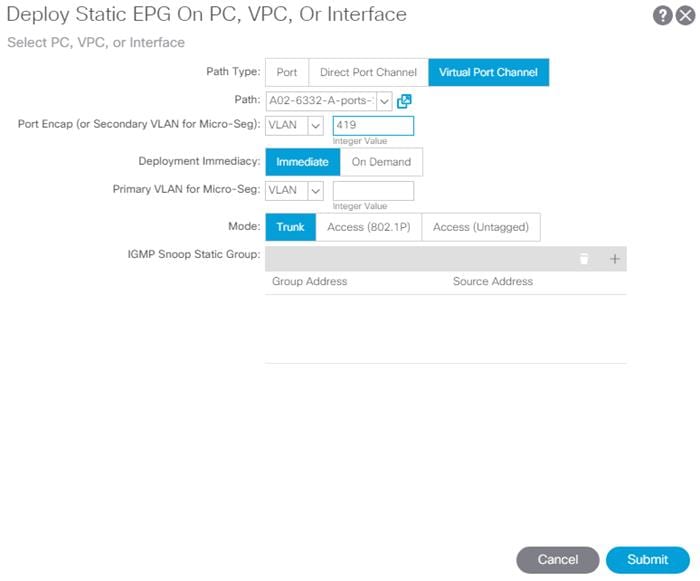
11. Repeat steps 7-10 to add the Static Port mapping for the second UCS Fabric Interconnect.
12. In the left menu, right-click Contracts and select Add Consumed Contract.
13. From the drop-down list for the Contract, select common-Allow-Core-Services from Tenant common.
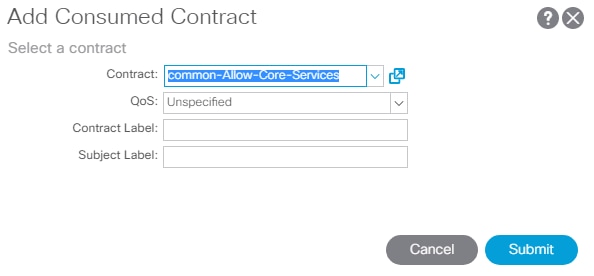
14. Click Submit.
![]() This EPG will be utilized to provide ESXi hosts as well as the VMs that do not provide Core Services access to the existing in-band management network.
This EPG will be utilized to provide ESXi hosts as well as the VMs that do not provide Core Services access to the existing in-band management network.
Create EPG for Infrastructure SVM-MGMT Access
This EPG will be used for VMs placed in the Core-Services EPG to reach the NetApp Infrastructure (FPV-Foundation-SVM) SVM management interface. This EPG will be placed in a different Bridge Domain than BD-FP-common-Core-Services so that multiple SVM management interfaces (with the same MAC address) can exist on the same storage controller. L3 will be used by the SVM-MGMT interface to communicate with the Core-Services VMs.
To create the EPG for SVM-MGMT access, complete the following steps:
1. In the left pane, expand the Application Profiles and right-click the IB-MGMT Application Profile and select Create Application EPG.
2. Name the EPG SVM-MGMT.
3. From the Bridge Domain drop-down list, select Bridge Domain BD-FPV-Foundation-Internal from Tenant FPV-Foundation.
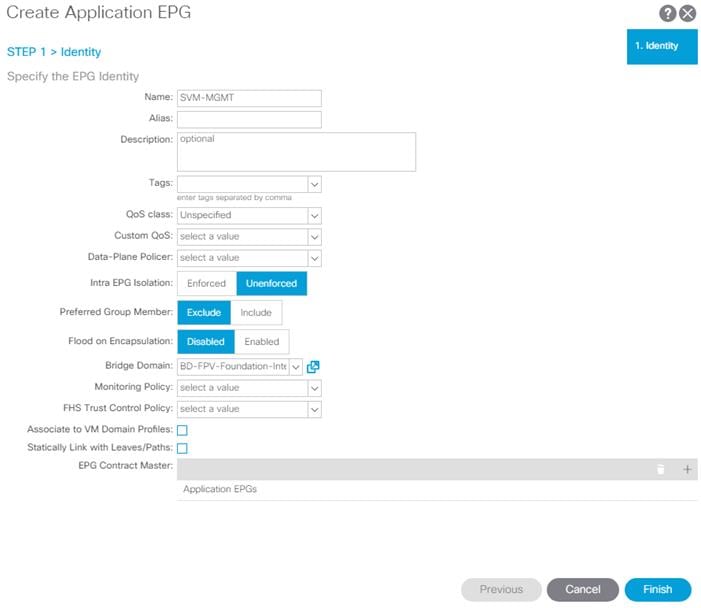
4. Click Finish to complete creating the EPG.
5. In the left menu, expand the newly created EPG, right-click Domains and select Add Physical Domain Association.
6. Select the NetApp-AFF Physical Domain Profile and click Submit.
7. In the left menu, right-click Static Ports and select Deploy Static EPG on PC, VPC, or Interface.
8. Select the Virtual Port Channel Path Type, then for Path select the vPC for the first NetApp AFF storage controller.
9. For Port Encap leave VLAN selected and fill in the storage SVM-MGMT VLAN ID <219>.
10. Set the Deployment Immediacy to Immediate and click Submit.
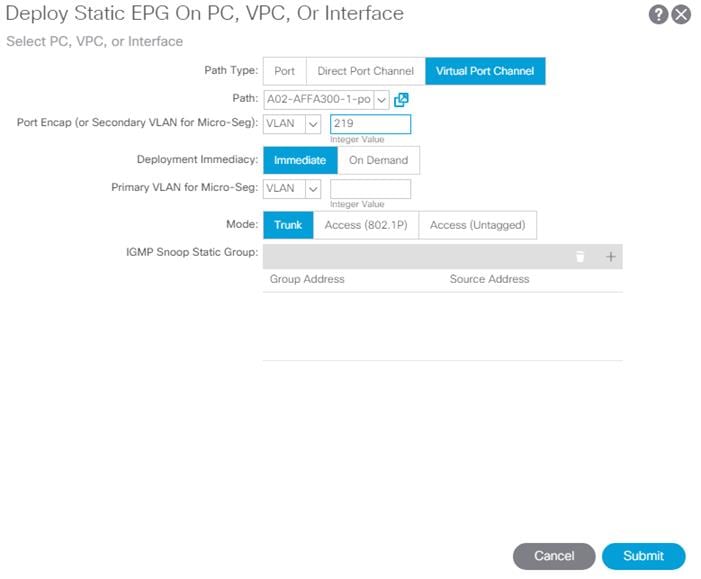
11. Repeat steps 7-10 to add the Static Port mapping for the second NetApp AFF storage controller.
12. In the left menu, right-click Subnets and select Create EPG Subnet.
13. Enter the Infrastructure SVM Management subnet gateway address and netmask <172.16.254.6/29> in the Default Gateway IP field.
14. Select only Shared between VRFs for the Scope and click Submit to add the subnet gateway.
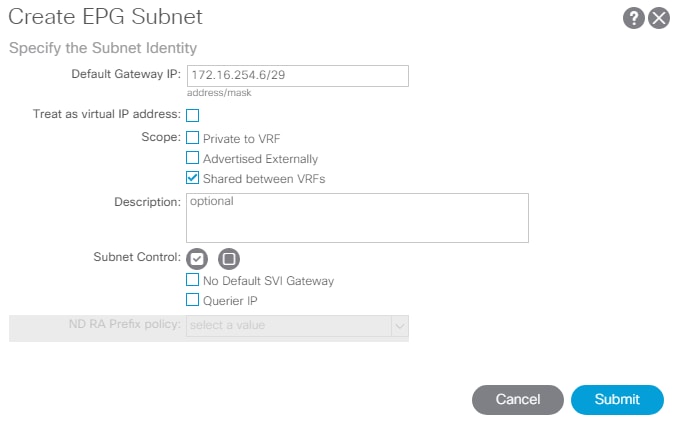
15. In the left menu, right-click Contracts and select Add Consumed Contract.
16. From the drop-down list for the Contract, select common-Allow-Core-Services from Tenant common.

17. Click Submit.
Create Application Profile for Host Connectivity
To create an application profile for host connectivity, complete the following steps:
1. In the left pane, under the Tenant FP-Foundation, right-click Application Profiles and select Create Application Profile.
2. Name the Profile Host-Conn and click Submit to complete adding the Application Profile.
The following EPGs and the corresponding mappings will be created under this application profile.
![]() Refer to Table 7 for the information required during the following configuration. Items marked by { } will need to be updated according to Table 7. Note that since all storage interfaces on a single Interface Group on a NetApp AFFA300 share the same MAC address, that different bridge domains must be used for each storage EPG.
Refer to Table 7 for the information required during the following configuration. Items marked by { } will need to be updated according to Table 7. Note that since all storage interfaces on a single Interface Group on a NetApp AFFA300 share the same MAC address, that different bridge domains must be used for each storage EPG.
Table 7 EPGs and mappings for AP-Host-Connectivity
| EPG Name | Bridge Domain | Domain | Static Port – Compute | Static Port - Storage |
| vMotion | BD-FPV-Foundation-Internal | L2 External: UCS | VPC for all UCS FIs VLAN 3000 | N/A |
| iSCSI-A | BD-FPV-Foundation-iSCSI-A | L2 External: UCS Physical: NetApp-AFF | VPC for all UCS FIs VLAN 3110 | VPC for all NetApp AFFs |
| iSCSI-B | BD-FPV-Foundation-iSCSI-B | L2 External: UCS Physical: NetApp-AFF | VPC for all UCS FIs VLAN 3120 | VPC for all NetApp AFFs |
| NFS | BD-FPV-Foundation-NFS | L2 External: UCS Physical: NetApp-AFF | VPC for all UCS FIs VLAN 3150 | VPC for all NetApp AFFs |
Create Bridge Domains and EPGs
To create bridge domains and EPGs, complete the following steps:
1. For each row in the table above, if the Bridge Domain does not already exist, in the left pane, under Tenant FPV-Foundation, expand Networking > Bridge Domains.
2. Right-click Bridge Domains and select Create Bridge Domain.
3. Name the Bridge Domain {BD-FPV-Foundation-iSCSI-A}.
4. Select the FPV-Foundation VRF.
5. Select Custom for Forwarding and setup forwarding as shown in the screenshot.
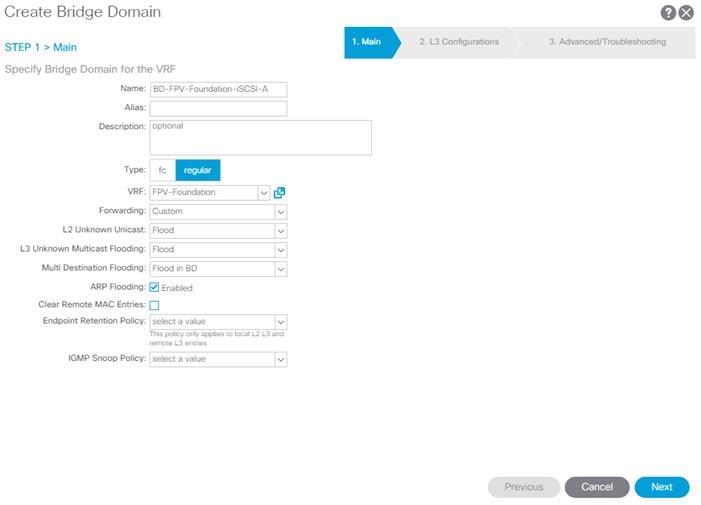
6. Click Next.
7. Under L3 Configurations, make sure Limit IP Learning to Subnet is selected and select EP Move Detection Mode – GARP based detection. Select Next.
8. No changes are needed for Advanced/Troubleshooting. Click Finish to finish creating the Bridge Domain.
9. In the left pane, expand Application Profiles > Host-Conn. Right-click Application EPGs and select Create Application EPG.
10. Name the EPG {vMotion}.
11. From the Bridge Domain drop-down list, select the Bridge Domain from the table.
12. Click Finish to complete creating the EPG.
13. In the left pane, expand the Application EPGs and EPG {vMotion}.
14. Right-click Domains and select Add L2 External Domain Association.
15. From the drop-down list, select the previously defined {UCS} L2 External Domain Profile.
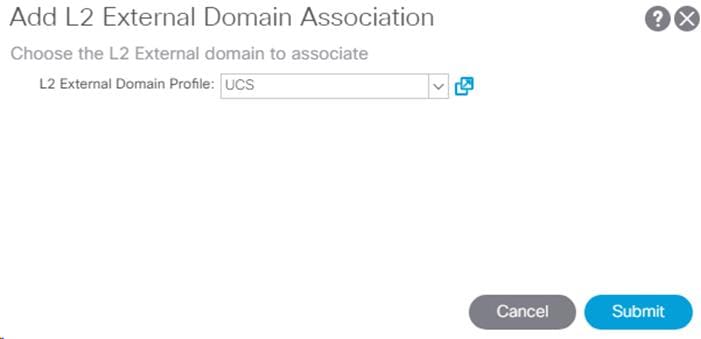
16. Click Submit to complete the L2 External Domain Association.
17. Repeat the Domain Association steps (6-9) to add appropriate EPG specific domains from Table 7.
18. Right-click Static Ports and select Deploy EPG on PC, VPC, or Interface.
19. In the Deploy Static EPG on PC, VPC, Or Interface Window, select the Virtual Port Channel Path Type.
20. From the drop-down list, select the appropriate VPCs.
21. Enter VLAN from Table 3. {3000} for Port Encap.
22. Select Immediate for Deployment Immediacy and for Mode select Trunk.
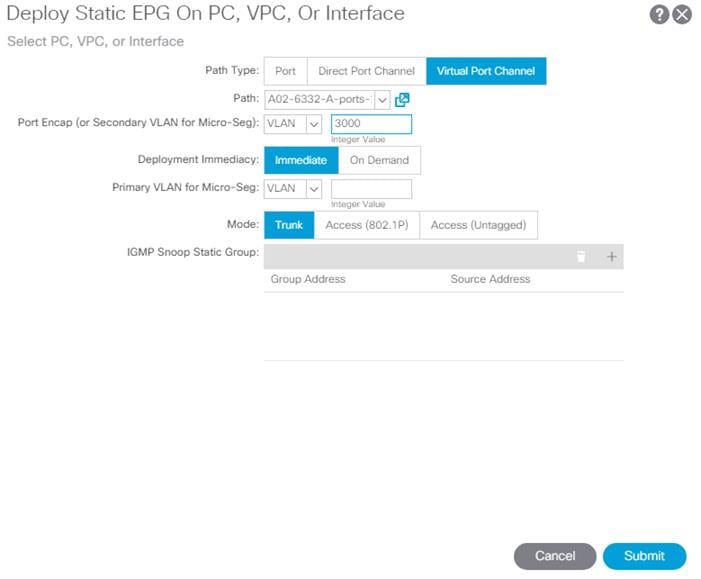
23. Click Submit to complete adding the Static Path Mapping.
24. Repeat the above steps to add all the Static Path Mappings for the EPG listed in Table 6.

25. Optionally, add subnets for each EPG created, providing a default gateway that can be pinged for troubleshooting purposes.
![]() Note that any of the storage EPGs could have been broken up into two EPGs (EPG-VMK and EPG-LIF) connected by contract. In that case, the two EPGs would need to be placed in the same Bridge Domain and one EPG would “provide” a contract (optionally filtered) and the other EPG would “consume” this contract. The two EPGs would then use L2 connectivity and it is not recommended to use subnets in this case.
Note that any of the storage EPGs could have been broken up into two EPGs (EPG-VMK and EPG-LIF) connected by contract. In that case, the two EPGs would need to be placed in the same Bridge Domain and one EPG would “provide” a contract (optionally filtered) and the other EPG would “consume” this contract. The two EPGs would then use L2 connectivity and it is not recommended to use subnets in this case.
![]() Pursuant to best practices, NetApp recommends the following command on the LOADER prompt of the NetApp controllers to assist with LUN stability during copy operations. To access the LOADER prompt, connect to the controller via serial console port or Service Processor connection and press Ctrl-C to halt the boot process when prompted.
Pursuant to best practices, NetApp recommends the following command on the LOADER prompt of the NetApp controllers to assist with LUN stability during copy operations. To access the LOADER prompt, connect to the controller via serial console port or Service Processor connection and press Ctrl-C to halt the boot process when prompted.
setenv bootarg.tmgr.disable_pit_hp 1
For more information about the workaround, see: http://nt-ap.com/2w6myr4 (requires Support login).
For more information about Windows Offloaded Data Transfers see: https://technet.microsoft.com/en-us/library/hh831628(v=ws.11).aspx.
NetApp All Flash FAS A300 Controllers
NetApp Hardware Universe
The NetApp Hardware Universe (HWU) application provides supported hardware and software components for any specific ONTAP version. It provides configuration information for all the NetApp storage appliances currently supported by ONTAP software. It also provides a table of component compatibilities. Confirm that the hardware and software components that you would like to use are supported with the version of ONTAP that you plan to install by using the HWU application (requires a software subscription) at the NetApp Support site.
To access the HWU application to view the System Configuration guides, complete the following steps:
1. Click the Controllers tab to view the compatibility between different version of the ONTAP software and the NetApp storage appliances with your desired specifications.
2. To compare components by storage appliance, click Compare Storage Systems.
Controllers
Follow the physical installation procedures for the controllers found in the AFF A300 Series product documentation at the NetApp Support site.
Disk Shelves
NetApp storage systems support a wide variety of disk shelves and disk drives. The complete list of disk shelves that are supported by the AFF A300 is available at the NetApp Support site.
For SAS disk shelves with NetApp storage controllers, refer to the SAS Disk Shelves Universal SAS and ACP Cabling Guide for proper cabling guidelines.
NetApp ONTAP 9.3
Complete Configuration Worksheet
Before running the setup script, complete the cluster setup worksheet from the ONTAP 9 Software Setup Guide. You must have access to the NetApp Support site to open the cluster setup worksheet.
Configure ONTAP Nodes
Before running the setup script, review the configuration worksheets in the ONTAP 9 Software Setup Guide to learn about configuring ONTAP. Table 8 lists the information needed to configure two ONTAP nodes. Customize the cluster detail values with the information applicable to your deployment.
Table 8 ONTAP Software Installation Prerequisites
| Cluster Detail | Cluster Detail Value |
| Cluster node 01 IP address | <node01-mgmt-ip> |
| Cluster node 01 netmask | <node01-mgmt-mask> |
| Cluster node 01 gateway | <node01-mgmt-gateway> |
| Cluster node 02 IP address | <node02-mgmt-ip> |
| Cluster node 02 netmask | <node02-mgmt-mask> |
| Cluster node 02 gateway | <node02-mgmt-gateway> |
| Data ONTAP 9.3 URL | <url-boot-software> |
Configure Node 01
To configure node 01, complete the following steps:
1. Connect to the storage system console port. You should see a Loader-A prompt. However, if the storage system is in a reboot loop, press Ctrl-C to exit the autoboot loop when the following message displays:
Starting AUTOBOOT press Ctrl-C to abort…
2. Allow the system to boot up.
autoboot
3. Press Ctrl-C when prompted.
![]() If ONTAP 9.3 is not the version of software being booted, continue with the following steps to install new software. If ONTAP 9.3 is the version being booted, select option 8 and y to reboot the node, then continue with step 14.
If ONTAP 9.3 is not the version of software being booted, continue with the following steps to install new software. If ONTAP 9.3 is the version being booted, select option 8 and y to reboot the node, then continue with step 14.
4. To install new software, select option 7.
5. Enter y to perform an upgrade.
6. Select e0M for the network port you want to use for the download.
7. Enter y to reboot now.
8. Enter the IP address, netmask, and default gateway for e0M.
<node01-mgmt-ip> <node01-mgmt-mask> <node01-mgmt-gateway>
9. Enter the URL where the software can be found.
![]() This web server must be reachable.
This web server must be reachable.
<url-boot-software>
10. Press Enter for the user name, indicating no user name.
11. Enter y to set the newly installed software as the default to be used for subsequent reboots.
12. Enter y to reboot the node.
![]() When installing new software, the system might perform firmware upgrades to the BIOS and adapter cards, causing reboots and possible stops at the Loader-A prompt. If these actions occur, the system might deviate from this procedure.
When installing new software, the system might perform firmware upgrades to the BIOS and adapter cards, causing reboots and possible stops at the Loader-A prompt. If these actions occur, the system might deviate from this procedure.
13. Press Ctrl-C when the following message displays:
Press Ctrl-C for Boot Menu
14. Select option 4 for Clean Configuration and Initialize All Disks.
15. Enter y to zero disks, reset config, and install a new file system.
16. Enter y to erase all the data on the disks.
![]() The initialization and creation of the root aggregate can take 90 minutes or more to complete, depending on the number and type of disks attached. When initialization is complete, the storage system reboots. Note that SSDs take considerably less time to initialize. You can continue with node 02 configuration while the disks for node 01 are zeroing.
The initialization and creation of the root aggregate can take 90 minutes or more to complete, depending on the number and type of disks attached. When initialization is complete, the storage system reboots. Note that SSDs take considerably less time to initialize. You can continue with node 02 configuration while the disks for node 01 are zeroing.
Configure Node 02
To configure node 02, complete the following steps:
1. Connect to the storage system console port. You should see a Loader-A prompt. However, if the storage system is in a reboot loop, press Ctrl-C to exit the autoboot loop when the following message displays:
Starting AUTOBOOT press Ctrl-C to abort…
2. Allow the system to boot up.
autoboot
3. Press Ctrl-C when prompted.
![]() If ONTAP 9.3 is not the version of software being booted, continue with the following steps to install new software. If ONTAP 9.3 is the version being booted, select option 8 and y to reboot the node. Then continue with step 14.
If ONTAP 9.3 is not the version of software being booted, continue with the following steps to install new software. If ONTAP 9.3 is the version being booted, select option 8 and y to reboot the node. Then continue with step 14.
4. To install new software, select option 7.
5. Enter y to perform an upgrade.
6. Select e0M for the network port you want to use for the download.
7. Enter y to reboot now.
8. Enter the IP address, netmask, and default gateway for e0M.
<node02-mgmt-ip> <node02-mgmt-mask> <node02-mgmt-gateway>
9. Enter the URL where the software can be found.
![]() This web server must be reachable.
This web server must be reachable.
<url-boot-software>
10. Press Enter for the user name, indicating no user name.
11. Enter y to set the newly installed software as the default to be used for subsequent reboots.
12. Enter y to reboot the node.
![]() When installing new software, the system might perform firmware upgrades to the BIOS and adapter cards, causing reboots and possible stops at the Loader-A prompt. If these actions occur, the system might deviate from this procedure.
When installing new software, the system might perform firmware upgrades to the BIOS and adapter cards, causing reboots and possible stops at the Loader-A prompt. If these actions occur, the system might deviate from this procedure.
13. Press Ctrl-C when you see this message:
Press Ctrl-C for Boot Menu
14. Select option 4 for Clean Configuration and Initialize All Disks.
15. Enter y to zero disks, reset config, and install a new file system.
16. Enter y to erase all the data on the disks.
![]() The initialization and creation of the root aggregate can take 90 minutes or more to complete, depending on the number and type of disks attached. When initialization is complete, the storage system reboots. Note that SSDs take considerably less time to initialize. You can continue with node 02 configuration while the disks for node 01 are zeroing.
The initialization and creation of the root aggregate can take 90 minutes or more to complete, depending on the number and type of disks attached. When initialization is complete, the storage system reboots. Note that SSDs take considerably less time to initialize. You can continue with node 02 configuration while the disks for node 01 are zeroing.
Set Up Node
To set up a node, complete the following steps:
1. From a console port program attached to the storage controller A (node 01) console port, run the node setup script. This script appears when ONTAP 9.3 boots on the node for the first time.
2. Follow the prompts to set up node 01:
Welcome to the cluster setup wizard.
You can enter the following commands at any time:
"help" or "?" - if you want to have a question clarified,
"back" - if you want to change previously answered questions, and
"exit" or "quit" - if you want to quit the setup wizard.
Any changes you made before quitting will be saved.
You can return to cluster setup at any time by typing “cluster setup”.
To accept a default or omit a question, do not enter a value.
This system will send event messages and weekly reports to NetApp Technical Support.
To disable this feature, enter "autosupport modify -support disable" within 24 hours.
Enabling AutoSupport can significantly speed problem determination and resolution should a problem occur on your system.
For further information on AutoSupport, see:
http://support.netapp.com/autosupport/
Type yes to confirm and continue {yes}: yes
Enter the node management interface port [e0M]: Enter
Enter the node management interface IP address: <node01-mgmt-ip>
Enter the node management interface netmask: <node01-mgmt-mask>
Enter the node management interface default gateway: <node01-mgmt-gateway>
A node management interface on port e0M with IP address <node01-mgmt-ip> has been created
Use your web browser to complete cluster setup by accesing https://<node01-mgmt-ip>
Otherwise press Enter to complete cluster setup using the command line interface:
3. To complete the cluster setup, open a web browser and navigate to https://<node01-mgmt-ip>.
Table 9 Cluster Create in ONTAP Prerequisites
| Cluster Detail | Cluster Detail Value |
| Cluster name | <clustername> |
| Cluster management IP address | <clustermgmt-ip> |
| Cluster management netmask | <clustermgmt-mask> |
| Cluster management gateway | <clustermgmt-gateway> |
| Cluster node 01 IP address | <node01-mgmt-ip> |
| Cluster node 01 netmask | <node01-mgmt-mask> |
| Cluster node 01 gateway | <node01-mgmt-gateway> |
| Cluster node 02 IP address | <node02-mgmt-ip> |
| Cluster node 02 netmask | <node02-mgmt-mask> |
| Cluster node 02 gateway | <node02-mgmt-gateway> |
| Node 01 service processor IP address | <node01-SP-ip> |
| Node 02 service processor IP address | <node02-SP-ip> |
| DNS domain name | <dns-domain-name> |
| DNS server IP address | <dns-ip> |
| NTP server IP address | <ntp-ip> |
![]() Cluster setup can also be performed with the command line interface. This document describes the cluster setup using the NetApp System Manager guided setup.
Cluster setup can also be performed with the command line interface. This document describes the cluster setup using the NetApp System Manager guided setup.
4. Click Guided Setup on the Welcome screen.
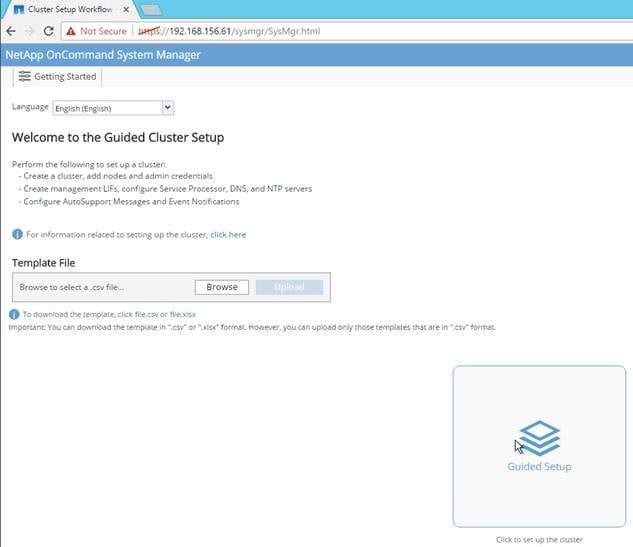
5. In the Cluster screen, complete the following steps:
a. Enter the cluster and node names.
b. Select the cluster configuration.
c. Enter and confirm the password.
d. Enter the cluster base and feature licenses.
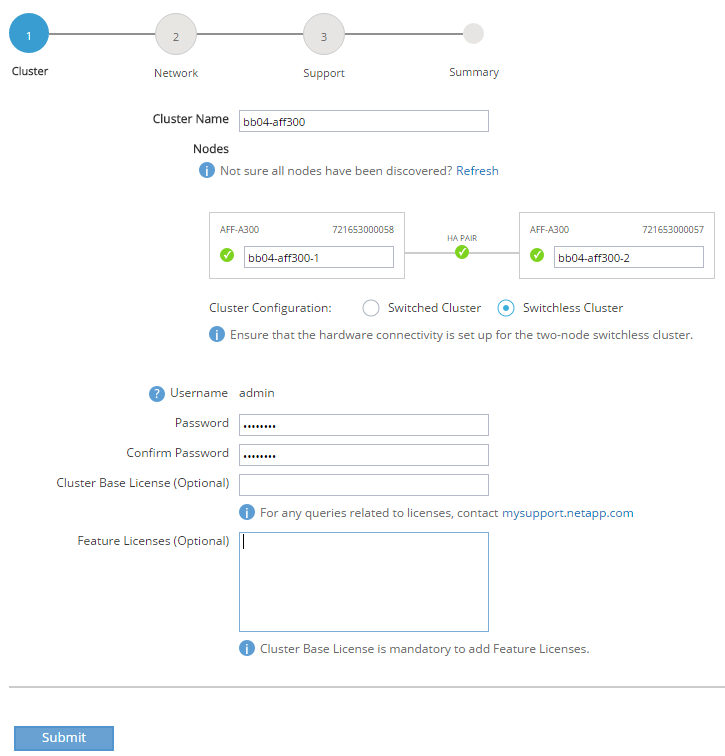
![]() The nodes are discovered automatically, if they are not discovered, click the Refresh link. By default, the cluster interfaces are created on all new storage controllers shipped from the factory. If all the nodes are not discovered, then configure the cluster using the command line. Cluster license and feature licenses can also be installed after completing the cluster creation.
The nodes are discovered automatically, if they are not discovered, click the Refresh link. By default, the cluster interfaces are created on all new storage controllers shipped from the factory. If all the nodes are not discovered, then configure the cluster using the command line. Cluster license and feature licenses can also be installed after completing the cluster creation.
6. Click Submit.
7. On the network page, complete the following sections:
a. Cluster Management
- Enter the IP address, netmask, gateway and port details.
b. Node Management
- Enter the node management IP addresses and port details for all the nodes.
c. Service Processor Management
- Enter the IP addresses for all the nodes.
d. DNS Details
- Enter the DNS domain names and server address.
e. NTP Details
- Enter the primary and alternate NTP server.
8. Click Submit.
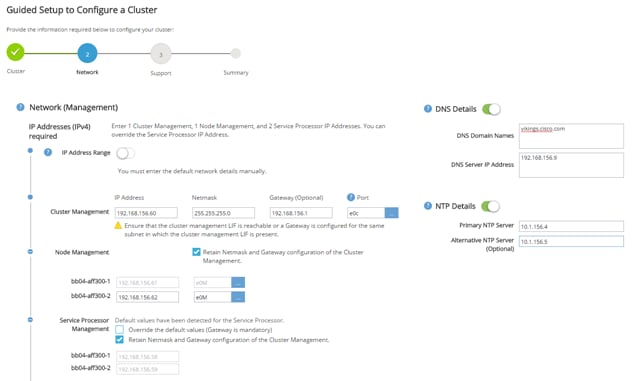
9. On the Support page, configure the AutoSupport and Event Notifications sections.
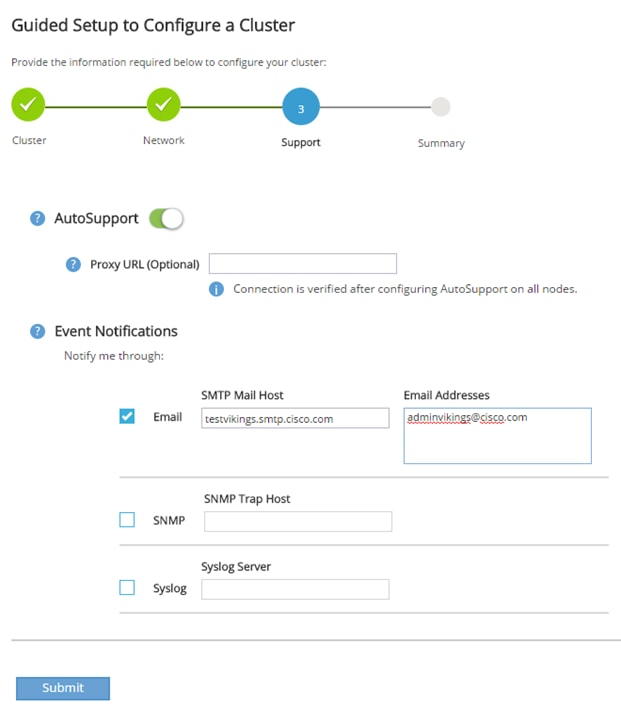
10. Click Submit.
11. On the Summary page, review the configuration details.
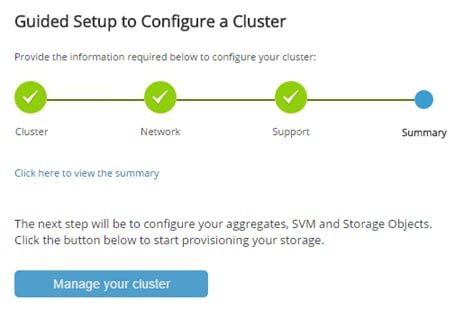
![]() The node management interface can be on the same subnet as the cluster management interface, or it can be on a different subnet. In this document, assume that it is on the same subnet.
The node management interface can be on the same subnet as the cluster management interface, or it can be on a different subnet. In this document, assume that it is on the same subnet.
Login to the Cluster
To log in to the cluster, complete the following steps:
1. Open an SSH connection to either the cluster IP or host name.
2. Log in to the admin user with the password you provided earlier.
Zero All Spare Disks
To zero all spare disks in the cluster, run the following command:
disk zerospares.
![]() Advanced Data Partitioning creates a root partition and two data partitions on each SSD drive in an All Flash FAS configuration. Disk autoassign should have assigned one data partition to each node in an HA pair.
Advanced Data Partitioning creates a root partition and two data partitions on each SSD drive in an All Flash FAS configuration. Disk autoassign should have assigned one data partition to each node in an HA pair.
![]() If a different disk assignment is required, disk autoassignment must be disabled on both nodes in the HA pair by running the disk option modify command. Spare partitions can then be moved from one node to another by running the disk removeowner and disk assign commands.
If a different disk assignment is required, disk autoassignment must be disabled on both nodes in the HA pair by running the disk option modify command. Spare partitions can then be moved from one node to another by running the disk removeowner and disk assign commands.
Set Onboard Unified Target Adapter 2 Port Personality
To set the personality of the onboard unified target adapter 2 (UTA2), complete the following steps:
1. Verify the Current Mode and Current Type properties of the ports by running the ucadmin show command:
ucadmin show
Current Current Pending Pending Admin
Node Adapter Mode Type Mode Type Status
------------ ------- ------- --------- ------- --------- -----------
<st-node01>
0e fc target - - online
<st-node01>
0f fc target - - online
<st-node01>
0g cna target - - online
<st-node01>
0h cna target - - online
<st-node02>
0e fc target - - online
<st-node02>
0f fc target - - online
<st-node02>
0g cna target - - online
<st-node02>
0h cna target - - online
8 entries were displayed.
2. Verify that the Current Mode and Current Type properties for all ports are set properly. Set the ports used for FC connectivity to mode fc. The port type for all protocols should be set to target. Change the port personality by running the following command:
ucadmin modify -node <home-node-of-the-port> -adapter <port-name> -mode fc -type target.
![]() The ports must be offline to run this command. To take an adapter offline, run the fcp adapter modify –node <home-node-of-the-port> -adapter <port-name> -state down command. Ports must be converted in pairs (for example, 0e and 0f).
The ports must be offline to run this command. To take an adapter offline, run the fcp adapter modify –node <home-node-of-the-port> -adapter <port-name> -state down command. Ports must be converted in pairs (for example, 0e and 0f).
![]() After conversion, a reboot is required. After reboot, bring the ports online by running fcp adapter modify -node <home-node-of-the-port> -adapter <port-name> -state up.
After conversion, a reboot is required. After reboot, bring the ports online by running fcp adapter modify -node <home-node-of-the-port> -adapter <port-name> -state up.
Set Auto-Revert on Cluster Management
To set the auto-revert parameter on the cluster management interface, run the following command:
![]() A storage virtual machine (SVM) is referred to as a Vserver (or vserver) in the GUI and CLI.
A storage virtual machine (SVM) is referred to as a Vserver (or vserver) in the GUI and CLI.
Run the following command:
network interface modify –vserver <clustername> -lif cluster_mgmt –auto-revert true
Set Up Management Broadcast Domain
By default, all network ports are included in the default broadcast domain. Network ports used for data services (for example, e2a, and e2e) should be removed from the default broadcast domain, leaving just the management network ports (e0c and e0M). To perform this task, run the following commands:
broadcast-domain remove-ports -broadcast-domain Default -ports <st-node01>:e2a,<st-node01>:e2e,<st-node02>:e2a,<st-node01>:e2e
broadcast-domain show
Set Up Service Processor Network Interface
To assign a static IPv4 address to the service processor on each node, run the following commands:
system service-processor network modify –node <st-node01> -address-family IPv4 –enable true –dhcp none –ip-address <node01-sp-ip> -netmask <node01-sp-mask> -gateway <node01-sp-gateway>
system service-processor network modify –node <st-node02> -address-family IPv4 –enable true –dhcp none –ip-address <node02-sp-ip> -netmask <node02-sp-mask> -gateway <node02-sp-gateway>
![]() The service processor IP addresses should be in the same subnet as the node management IP addresses.
The service processor IP addresses should be in the same subnet as the node management IP addresses.
Create Aggregates
An aggregate containing the root volume is created during the ONTAP setup process. To create additional aggregates, determine the aggregate name, the node on which to create it, and the number of disks it should contain.
To create new aggregates, run the following commands:
aggr create -aggregate aggr1_node01 -node <st-node01> -diskcount <num-disks>
aggr create -aggregate aggr1_node02 -node <st-node02> -diskcount <num-disks>
![]() You should have the minimum number of hot spare disks for hot spare disk partitions recommended for your aggregate. For all-flash aggregates, you should have a minimum of one hot spare disk or disk partition. For non-flash homogenous aggregates, you should have a minimum of two hot spare disks or disk partitions.
You should have the minimum number of hot spare disks for hot spare disk partitions recommended for your aggregate. For all-flash aggregates, you should have a minimum of one hot spare disk or disk partition. For non-flash homogenous aggregates, you should have a minimum of two hot spare disks or disk partitions.
![]() For Flash Pool aggregates, you should have a minimum of two hot spare disks or disk partitions for each disk type. Start with five disks initially; you can add disks to an aggregate when additional storage is required. In an AFF configuration with a small number of SSDs, you might want to create an aggregate with all but one remaining disk (spare) assigned to the controller.
For Flash Pool aggregates, you should have a minimum of two hot spare disks or disk partitions for each disk type. Start with five disks initially; you can add disks to an aggregate when additional storage is required. In an AFF configuration with a small number of SSDs, you might want to create an aggregate with all but one remaining disk (spare) assigned to the controller.
![]() The aggregate cannot be created until disk zeroing completes. Run the aggr show command to display aggregate creation status. Do not proceed until both aggr1_node1 and aggr1_node2 are online.
The aggregate cannot be created until disk zeroing completes. Run the aggr show command to display aggregate creation status. Do not proceed until both aggr1_node1 and aggr1_node2 are online.
(Optional) Rename the root aggregate on node 01 to match the naming convention for this aggregate on node 02. The aggregate is automatically renamed if system-guided setup is used.
aggr show
aggr rename –aggregate aggr0 –newname <node01-rootaggrname>
Verify Storage Failover
To confirm that storage failover is enabled, run the following commands for a failover pair:
1. Verify the status of the storage failover.
storage failover show
![]() Both <st-node01> and <st-node02> must be able to perform a takeover. Continue with step 3 if the nodes can perform a takeover.
Both <st-node01> and <st-node02> must be able to perform a takeover. Continue with step 3 if the nodes can perform a takeover.
2. Enable failover on one of the two nodes.
storage failover modify -node <st-node01> -enabled true
![]() Enabling failover on one node enables it for both nodes.
Enabling failover on one node enables it for both nodes.
3. Verify the HA status for a two-node cluster.
![]() This step is not applicable for clusters with more than two nodes.
This step is not applicable for clusters with more than two nodes.
cluster ha show
4. Continue with step 5 if high availability is configured.
![]() Only enable HA mode for two-node clusters. Do not run this command for clusters with more than two nodes because it causes problems with failover.
Only enable HA mode for two-node clusters. Do not run this command for clusters with more than two nodes because it causes problems with failover.
cluster ha modify -configured true
Do you want to continue? {y|n}: y
5. Verify that hardware assist is correctly configured and, if needed, modify the partner IP address.
storage failover hwassist show
storage failover modify –hwassist-partner-ip <node02-mgmt-ip> -node <st-node01>
storage failover modify –hwassist-partner-ip <node01-mgmt-ip> -node <st-node02>
Disable Flow Control on 10GbE and 40GbE Ports
NetApp recommends disabling flow control on all the 10GbE, 40GbE, and UTA2 ports that are connected to external devices. To disable flow control, complete the following steps:
1. Run the following commands to configure node 01:
network port modify -node <st-node01> -port e0c,e0d,e2a,e2e -flowcontrol-admin none
Warning: Changing the network port settings will cause a several second interruption in carrier.
Do you want to continue? {y|n}: y
2. Run the following commands to configure node 02:
network port modify -node <st-node02> -port e0c,e0d,e2a,e2e -flowcontrol-admin none
Warning: Changing the network port settings will cause a several second interruption in carrier.
Do you want to continue? {y|n}: y
network port show –fields flowcontrol-admin
Disable Unused FCoE Capability on CNA Ports
If the UTA2 port is set to CNA mode and is only expected to handle Ethernet data traffic (for example CIFS), then the unused FCoE capability of the port should be disabled by setting the corresponding FCP adapter to state down with the fcp adapter modify command. Here are some examples:
fcp adapter modify -node <st-node01> -adapter 0g –status-admin down
fcp adapter modify -node <st-node01> -adapter 0h –status-admin down
fcp adapter modify -node <st-node02> -adapter 0g –status-admin down
fcp adapter modify -node <st-node02> -adapter 0h –status-admin down
fcp adapter show –fields status-admin
Configure Network Time Protocol
If NTP was not configured during guided setup, it can be configured via the CLI as follows:
1. Set the time zone for the cluster.
timezone <timezone>
![]() For example, in the eastern United States, the time zone is America/New_York.
For example, in the eastern United States, the time zone is America/New_York.
2. Set the date for the cluster.
date <ccyymmddhhmm.ss>
![]() The format for the date is <[Century][Year][Month][Day][Hour][Minute].[Second]> (for example, 201703231549.30).
The format for the date is <[Century][Year][Month][Day][Hour][Minute].[Second]> (for example, 201703231549.30).
3. Configure the Network Time Protocol (NTP) servers for the cluster.
cluster time-service ntp server create -server <switch-a-ntp-ip>
cluster time-service ntp server create -server <switch-b-ntp-ip>
Configure Simple Network Management Protocol
To configure the Simple Network Management Protocol (SNMP), complete the following steps:
1. Configure basic SNMP information, such as the location and contact. When polled, this information is visible as the sysLocation and sysContact variables in SNMP.
system snmp contact <snmp-contact>
system snmp location “<snmp-location>”
system snmp init 1
options snmp.enable on
2. Configure SNMP traps to send to remote hosts, such as a DFM server or another fault management system.
system snmp traphost add <oncommand-um-server-fqdn>
Configure SNMPv1 Access
To configure SNMPv1 access, set the shared, secret plain-text password (called a community).
system snmp community add ro <snmp-community>
Configure AutoSupport
NetApp AutoSupport® sends support summary information to NetApp through HTTPS. To configure AutoSupport, run the following command:
system node autosupport modify -node * -state enable –mail-hosts <mailhost> -transport https -support enable -noteto <storage-admin-email>
Enable Cisco Discovery Protocol and Link Layer Discovery Protocol
To enable the Cisco Discovery Protocol (CDP) on the NetApp storage controllers, run the following command:
node run -node * options cdpd.enable on
To enable the Link Layer Discovery Protocol (LLDP) on the NetApp storage controllers, run the following command:
node run -node * options lldp.enable on
![]() To be effective, CDP and LLDP must also be enabled on directly connected networking equipment such as switches and routers.
To be effective, CDP and LLDP must also be enabled on directly connected networking equipment such as switches and routers.
Create Jumbo Frame MTU Broadcast Domains in ONTAP
To create a data broadcast domain with an MTU of 9000 for NFS on ONTAP, run the following command:
broadcast-domain create -broadcast-domain Infra_NFS -mtu 9000
If using iSCSI, create two iSCSI broadcast domains with an MTU of 9000, with the following command:
broadcast-domain create -broadcast-domain Infra_iSCSI-A -mtu 9000
broadcast-domain create -broadcast-domain Infra_iSCSI-B -mtu 9000
Create Interface Groups
To create LACP interface groups for the 10GbE data interfaces, run the following commands:
ifgrp create -node <st-node01> -ifgrp a0a -distr-func port -mode multimode_lacp
ifgrp add-port -node <st-node01> -ifgrp a0a -port e2a
ifgrp add-port -node <st-node01> -ifgrp a0a -port e2e
ifgrp create -node <st-node02> -ifgrp a0a -distr-func port -mode multimode_lacp
ifgrp add-port -node <st-node02> -ifgrp a0a -port e2a
ifgrp add-port -node <st-node02> -ifgrp a0a -port e2e
ifgrp show
Create VLANs
To create NFS VLAN, create NFS VLAN ports and add them to the NFS broadcast domain:
network port modify –node <st-node01> -port a0a –mtu 9000
network port modify –node <st-node02> -port a0a –mtu 9000
network port vlan create –node <st-node01> -vlan-name a0a-<infra-nfs-vlan-id>
network port vlan create –node <st-node02> -vlan-name a0a-<infra-nfs-vlan-id>
broadcast-domain add-ports -broadcast-domain Infra_NFS -ports <st-node01>:a0a-<infra-nfs-vlan-id>,<st-node02>:a0a-<infra-nfs-vlan-id>
If using iSCSI, create two iSCSI VLANs and add them to the corresponding broadcast domains:
network port vlan create –node <st-node01> -vlan-name a0a-<Infra_iSCSI-A-VLAN>
network port vlan create –node <st-node02> -vlan-name a0a-<Infra_iSCSI-A-VLAN>
broadcast-domain add-ports -broadcast-domain iSCSI-A -ports <st-node01>:a0a-<Infra_iSCSI-A-VLAN>,<st-node02>:a0a-<Infra_iSCSI-A-VLAN>
network port vlan create –node <st-node01> -vlan-name a0a-<Infra_iSCSI-B-VLAN>
network port vlan create –node <st-node02> -vlan-name a0a-<Infra_iSCSI-B-VLAN>
broadcast-domain add-ports -broadcast-domain iSCSI-B -ports <st-node01>:a0a-<Infra_iSCSI-B-VLAN>,<st-node02>:a0a-<Infra_iSCSI-B-VLAN>
Create Storage Virtual Machine
To create an infrastructure SVM, complete the following steps:
1. Run the vserver create command.
vserver create –vserver Infra-SVM –rootvolume rootvol –aggregate aggr1_node01 –rootvolume-security-style unix
2. Remove the unused data protocols (CIFS and NDMP) from the SVM.
vserver remove-protocols -vserver Infra-SVM -protocols cifs,ndmp
3. Add the two data aggregates to the Infra-SVM aggregate list.
Create the NFS Service
You can enable and configure NFS servers on storage virtual machines (SVMs) with NetApp FlexVol® volumes to let NFS clients access files on your cluster. To do so, complete the following step:
Create the NFS service.
nfs create -vserver Infra-SVM -udp disabled
Enable VMware vStorage for NFS in ONTAP
To enable VMware vStorage for NFS in NetApp ONTAP, run the following command:
vserver nfs modify -vserver Infra-SVM -vstorage enabled
Create Load-Sharing Mirrors of SVM Root Volume
To create a load-sharing mirror of an SVM root volume, complete the following steps:
1. Create a volume to be the load-sharing mirror of the infrastructure SVM root volume on each node.
volume create –vserver Infra-SVM –volume rootvol_m01 –aggregate aggr1_node01 –size 1GB –type DP
volume create –vserver Infra-SVM –volume rootvol_m02 –aggregate aggr1_node02 –size 1GB –type DP
2. Create a job schedule to update the root volume mirror relationships every 15 minutes.
job schedule interval create -name 15min -minutes 15
3. Create the mirroring relationships.
snapmirror create –source-path Infra-SVM:rootvol –destination-path Infra-SVM:rootvol_m01 –type LS -schedule 15min
snapmirror create –source-path Infra-SVM:rootvol –destination-path Infra-SVM:rootvol_m02 –type LS -schedule 15min
4. Initialize the mirroring relationship.
snapmirror initialize-ls-set –source-path Infra-SVM:rootvol
snapmirror show
Create Block Protocol Service(s)
If the deployment is using FCP, create the FCP service on each SVM using the following command. This command also starts the FCP service and sets the worldwide name (WWN) for the SVM.
fcp create -vserver Infra-SVM
fcp show
If the deployment is using iSCSI, create the iSCSI service on each SVM using the following command. This command also starts the iSCSI service and sets the IQN for the SVM.
iscsi create -vserver Infra-SVM
iscsi show
![]() The licenses for FCP and iSCSI must be installed before the services can be started. If the license(s) weren’t installed during cluster setup, install them before this step.
The licenses for FCP and iSCSI must be installed before the services can be started. If the license(s) weren’t installed during cluster setup, install them before this step.
Configure HTTPS Access
To configure secure access to the storage controller, complete the following steps:
1. Increase the privilege level to access the certificate commands.
set -privilege diag
Do you want to continue? {y|n}: y
2. Generally, a self-signed certificate is already in place. Verify the certificate and obtain parameters (for example, <serial-number>) by running the following command:
security certificate show
3. For each SVM shown, the certificate common name should match the DNS FQDN of the SVM. Delete the two default certificates and replace them with either self-signed certificates or certificates from a certificate authority (CA). To delete the default certificates, run the following commands:
security certificate delete -vserver Infra-SVM -common-name Infra-SVM -ca Infra-SVM -type server -serial <serial-number>
![]() Deleting expired certificates before creating new certificates is a best practice. Run the security certificate delete command to delete the expired certificates. In the previous command, use TAB completion to select and delete each default certificate.
Deleting expired certificates before creating new certificates is a best practice. Run the security certificate delete command to delete the expired certificates. In the previous command, use TAB completion to select and delete each default certificate.
4. To generate and install self-signed certificates, run the following commands as one-time commands. Generate a server certificate for the Infra-MS-SVM and the cluster SVM. Use TAB completion to aid in the completion of these commands:
security certificate create -common-name <cert-common-name> -type server -size 2048 -country <cert-country> -state <cert-state> -locality <cert-locality> -organization <cert-org> -unit <cert-unit> -email-addr <cert-email> -expire-days <cert-days> -protocol SSL -hash-function SHA256 -vserver Infra-SVM
5. To obtain the values for the parameters required in step 5 (<cert-ca> and <cert-serial>), run the security certificate show command.
6. Enable each certificate that was just created by using the –server-enabled true and –client-enabled false parameters. Use TAB completion to aid in the completion of these commands:
security ssl modify -vserver <clustername> -server-enabled true -client-enabled false -ca <cert-ca> -serial <cert-serial> -common-name <cert-common-name>
7. Disable HTTP cluster management access:
system services firewall policy delete -policy mgmt -service http –vserver <clustername>
![]() It is normal for some of these commands to return an error message stating that the entry does not exist.
It is normal for some of these commands to return an error message stating that the entry does not exist.
8. Change back to the normal admin privilege level and set up the system to allow SVM logs to be available by web:
set –privilege admin
vserver services web modify –name spi|ontapi|compat –vserver * -enabled true
Add Rules to Default Export Policy to Allow ESXi Host Access
To allow the ESXI hosts access to the NFS volumes, add rules to the default export policy by running the following command:
vserver export-policy rule create -vserver Infra-SVM -policyname default -ruleindex 1 -protocol nfs -clientmatch <<var_esxi_host1_nfs_ip>> -rorule sys -rwrule sys -superuser sys -allow-suid false
volume modify -vserver Infra-SVM -volume rootvol -policy default
Create NetApp FlexVol Volumes
volume create -vserver Infra-SVM -volume infra_datastore_1 -aggregate aggr1_node02 -size 500GB -state online -policy default -junction-path /infra_datastore_1 -space-guarantee none -percent-snapshot-space 0
volume create -vserver Infra-SVM -volume infra_swap -aggregate aggr1_node01 -size 100GB -state online -policy default -junction-path /infra_swap -space-guarantee none -percent-snapshot-space 0 -snapshot-policy none
volume create -vserver Infra-SVM -volume esxi_boot -aggregate aggr1_node01 -size 100GB -state online -policy default -space-guarantee none -percent-snapshot-space 0
snapmirror update-ls-set -source-path Infra-SVM:rootvol
Create ESXi Host Boot LUNs
To create ESXi host boot LUNs, run the following commands:
lun create -vserver Infra-SVM -volume esxi_boot -lun fpv-esxi-01 -size 15GB -ostype vmware -space-reserve disabled
lun create -vserver Infra-SVM -volume esxi_boot -lun fpv-esxi-02 -size 15GB -ostype vmware -space-reserve disabled
Create SAN LIFs
If using FCP, run the following commands to create four FC LIFs (two on each node):
network interface create -vserver Infra-SVM -lif fcp_lif01a -role data -data-protocol fcp -home-node <st-node01> -home-port 0e –status-admin up
network interface create -vserver Infra-SVM -lif fcp_lif01b -role data -data-protocol fcp -home-node <st-node01> -home-port 0f –status-admin up
network interface create -vserver Infra-SVM -lif fcp_lif02a -role data -data-protocol fcp -home-node <st-node02> -home-port 0e –status-admin up
network interface create -vserver Infra-SVM -lif fcp_lif02b -role data -data-protocol fcp -home-node <st-node02> -home-port 0f –status-admin up
If using iSCSI, run the following commands to create four iSCSI LIFs (two on each node):
network interface create -vserver Infra-SVM -lif iscsi_lif01a -role data -data-protocol iscsi -home-node <st-node01> -home-port a0a-<Infra_iSCSI-A-VLAN> –address <iscsi_lif01a_ip> -netmask <iscsi_lif01a_mask> –status-admin up
network interface create -vserver Infra-SVM -lif iscsi_lif01b -role data -data-protocol iscsi -home-node <st-node01> -home-port a0a-<Infra_iSCSI-B-VLAN> –address <iscsi_lif01b_ip> -netmask <iscsi_lif01b_mask> –status-admin up
network interface create -vserver Infra-SVM -lif iscsi_lif02a -role data -data-protocol iscsi -home-node <st-node02> -home-port a0a-<Infra_iSCSI-A-VLAN> –address <iscsi_lif02a_ip> -netmask <iscsi_lif02a_mask> –status-admin up
network interface create -vserver Infra-SVM -lif iscsi_lif02b -role data -data-protocol iscsi -home-node <st-node02> -home-port a0a-<InfraiSCSI-B-VLAN> –address <iscsi_lif02b_ip> -netmask <iscsi_lif02b_mask> –status-admin up
Create NFS LIFs
To create NFS LIFs, run the following commands:
network interface create -vserver Infra-SVM -lif nfs_lif01 -role data -data-protocol nfs -home-node <st-node01> -home-port a0a-<infra-nfs-vlan-id> –address <node01-nfs_lif01-ip> -netmask <node01-nfs_lif01-mask> -status-admin up –failover-policy broadcast-domain-wide –firewall-policy data –auto-revert true
network interface create -vserver Infra-SVM -lif nfs_lif02 -role data -data-protocol nfs -home-node <st-node02> -home-port a0a-<infra-nfs-vlan-id> –address <node02-nfs_lif02-ip> -netmask <node02-nfs_lif02-mask> -status-admin up –failover-policy broadcast-domain-wide –firewall-policy data –auto-revert true
network interface show
Add Infrastructure SVM Administrator
To add an infrastructure SVM administrator and an SVM administration LIF in the out-of-band management network, complete the following steps:
1. Create a network interface.
network interface create –vserver Infra-SVM –lif svm-mgmt –role data –data-protocol none –home-node <st-node02> -home-port e0c –address <svm-mgmt-ip> -netmask <svm-mgmt-mask> -status-admin up –failover-policy broadcast-domain-wide –firewall-policy mgmt –auto-revert true
![]() The SVM management IP in this step should be in the same subnet as the storage cluster management IP.
The SVM management IP in this step should be in the same subnet as the storage cluster management IP.
2. Create a default route to allow the SVM management interface to reach the outside world.
network route create –vserver Infra-SVM -destination 0.0.0.0/0 –gateway <svm-mgmt-gateway>
network route show
3. Set a password for the SVM vsadmin user and unlock the user.
security login password –username vsadmin –vserver Infra-SVM
Enter a new password: <password>
Enter it again: <password>
security login unlock –username vsadmin –vserver Infra-SVM
![]() A cluster serves data through at least one and possibly several SVMs. We have just described the creation of a single SVM. If you would like to configure your environment with multiple SVMs, this is a good time to create them.
A cluster serves data through at least one and possibly several SVMs. We have just described the creation of a single SVM. If you would like to configure your environment with multiple SVMs, this is a good time to create them.
Cisco UCS Base Configuration
This FlexPod deployment describes the configuration steps for the Cisco UCS 6332-16UP Fabric Interconnects (FI) in a design that will support iSCSI boot to the NetApp AFF through the Cisco ACI Fabric. An alternative Fibre Channel (FC) boot delta configuration is detailed in Appendix - FC Solution. If FC boot is desired, execute the following procedure not executing iSCSI-related steps and then execute the procedure in the appendix.
Table 1 Lab Validation Infrastructure (FPV-Foundation) Tenant Configuration
| EPG | Storage VLAN | UCS VLAN | External VLAN | Subnet / Gateway | Bridge Domain |
| IB-MGMT | N/A | 419/DVS | N/A | 10.1.118.1/24 | BD-FP-common-Core-Services |
| Core-Services | N/A | 318/DVS | 118 | 10.1.118.1/254 10.1.118.254/24 | BD-FP-common-Core-Services |
| SVM-MGMT | 219 | N/A | N/A | 172.16.254.6/29 | BD-FPV-Foundation-Internal |
| iSCSI-A | 3010 | 3110 | N/A | 192.168.10.0/24 – L2 | BD- FPV-Foundation-iSCSI-A |
| iSCSI-B | 3020 | 3120 | N/A | 192.168.20.0/24 – L2 | BD- FPV-Foundation-iSCSI-B |
| NFS | 3050 | 3150 | N/A | 192.168.50.0/24 – L2 | BD- FPV-Foundation-NFS |
| vMotion | N/A | 3000/DVS | N/A | 192.168.100.0/24 – L2 | BD-Internal |
| Native | N/A | 2 | N/A | N/A | N/A |
| VMware vDS Pool | N/A | 1100-1199 | N/A | Varies | Varies |
| ACI System VLAN for AVE | N/A | 4093 | N/A | Varies | Varies |
Perform Initial Setup
This section provides detailed steps to configure the Cisco Unified Computing System (Cisco UCS) for use in a FlexPod environment. The steps are necessary to provision the Cisco UCS B-Series and C-Series servers and should be followed precisely to avoid improper configuration.
Cisco UCS Fabric Interconnect A
To configure the Cisco UCS for use in a FlexPod environment, complete the following steps:
1. Connect to the console port on the first Cisco UCS fabric interconnect.
Enter the configuration method: gui
Physical switch Mgmt0 IP address: <ucsa-mgmt-ip>
Physical switch Mgmt0 IPv4 netmask: <ucsa-mgmt-mask>
IPv4 address of the default gateway: <ucsa-mgmt-gateway>
2. Using a supported web browser, connect to http://<ucsa-mgmt-ip>, accept the security prompts, and click the ‘Express Setup’ link.
3. Select Initial Setup and click Submit.
4. Select Enable clustering, Fabric A, and IPv4.
5. Fill in the Virtual IP Address with the UCS cluster IP.
6. Completely fill in the System setup section. For system name, use the overall UCS system name. For the Mgmt IP Address, use <ucsa-mgmt-ip>.
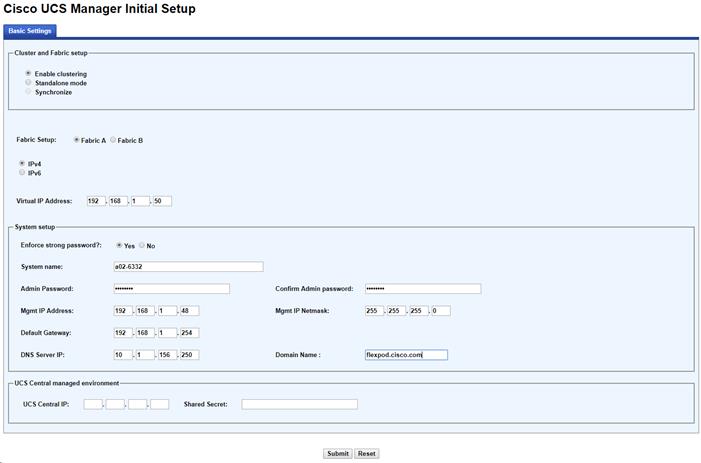
7. Click Submit.
Cisco UCS Fabric Interconnect B
To configure the Cisco UCS for use in a FlexPod environment, complete the following steps:
1. Connect to the console port on the second Cisco UCS fabric interconnect.
Enter the configuration method: gui
Physical switch Mgmt0 IP address: <ucsb-mgmt-ip>
Physical switch Mgmt0 IPv4 netmask: <ucsb-mgmt-mask>
IPv4 address of the default gateway: <ucsb-mgmt-gateway>
2. Using a supported web browser, connect to http://<ucsb-mgmt-ip>, accept the security prompts, and click the ‘Express Setup’ link.
3. Under System setup, enter the Admin Password entered above and click Submit.
4. Enter <ucsb-mgmt-ip> for the Mgmt IP Address and click Submit.
Cisco UCS Setup
Log in to Cisco UCS Manager
To log in to the Cisco Unified Computing System (UCS) environment, complete the following steps:
1. Open a web browser and navigate to the Cisco UCS fabric interconnect cluster address.
![]() You may need to wait at least 5 minutes after configuring the second fabric interconnect for Cisco UCS Manager to come up.
You may need to wait at least 5 minutes after configuring the second fabric interconnect for Cisco UCS Manager to come up.
2. Click the Launch UCS Manager link under HTML to launch Cisco UCS Manager.
3. If prompted to accept security certificates, accept as necessary.
4. When prompted, enter admin as the user name and enter the administrative password.
5. Click Login to log in to Cisco UCS Manager.
Upgrade Cisco UCS Manager Software to Version 3.2(3a)
This document assumes the use of Cisco UCS 3.2(3a) release. The testing for this CVD was initially completed using Cisco UCS 3.2(2d), prior to the release of UCS 3.2(3a). However, when Spectre and Meltdown patches were released in Cisco UCS 3.2(3a), the testbed was upgraded and a limited set of tests were run to ensure consistency with previous validation. To upgrade the Cisco UCS Manager software and the Cisco UCS Fabric Interconnect software to version 3.2(3a), refer to Cisco UCS Manager Install and Upgrade Guides.
Anonymous Reporting
To create anonymous reporting, complete the following step:
1. In the Anonymous Reporting window, select whether to send anonymous data to Cisco for improving future products. If you select Yes, enter the IP address of your SMTP Server. Click OK.
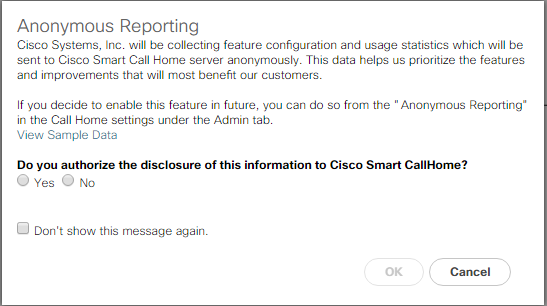
Configure Cisco UCS Call Home
It is highly recommended by Cisco to configure Call Home in Cisco UCS Manager. Configuring Call Home will accelerate resolution of support cases. To configure Call Home, complete the following steps:
1. In Cisco UCS Manager, click the Admin icon on the left.
2. Select All > Communication Management > Call Home.
3. Change the State to On.
4. Fill in all the fields according to your Management preferences and click Save Changes and OK to complete configuring Call Home.
Add Block of IP Addresses for KVM Access
To create a block of IP addresses for in band server Keyboard, Video, Mouse (KVM) access in the Cisco UCS environment, complete the following steps:
1. In Cisco UCS Manager, click the LAN icon on the left.
2. Expand Pools > root > IP Pools.
3. Right-click IP Pool ext-mgmt and select Create Block of IPv4 Addresses.
4. Enter the starting IP address of the block, number of IP addresses required, and the subnet mask and gateway information.
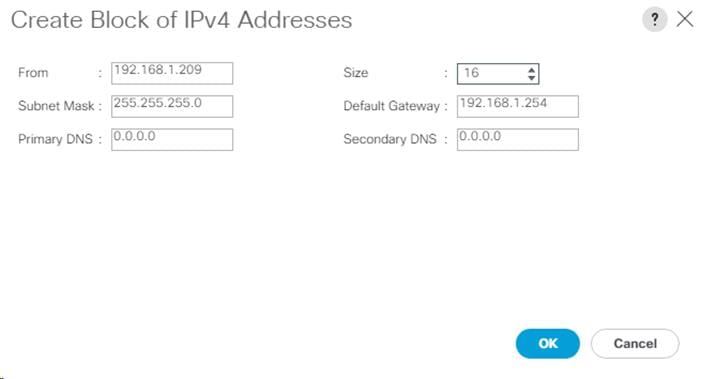
5. Click OK to create the block.
6. Click OK in the confirmation message.
Synchronize Cisco UCS to NTP
To synchronize the Cisco UCS environment to the NTP servers in the Nexus switches, complete the following steps:
1. In Cisco UCS Manager, click the Admin icon on the left.
2. Expand All > Time Zone Management.
3. Select Timezone.
4. In the Properties pane, select the appropriate time zone in the Timezone menu.
5. Click Save Changes, and then click OK.
6. Click Add NTP Server.
7. Enter <leaf-a-mgmt-ip> and click OK. Click OK on the confirmation.
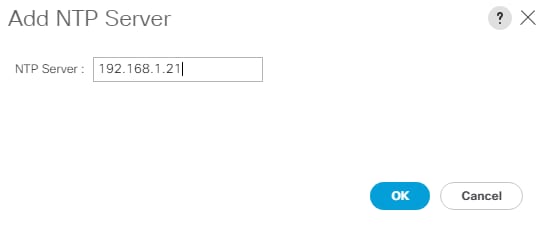
8. Add <leaf-b-mgmt-ip> for the second NTP server.
Edit Policy to Automatically Discover Server Ports
If the UCS Port Auto-Discovery Policy is enabled, server ports will be discovered automatically. To enable the Port Auto-Discovery Policy, complete the following steps:
1. In Cisco UCS Manager, click the Equipment icon on the left and select Equipment in the second list.
2. In the right pane, click the Policies tab.
3. Under Policies, select the Port Auto-Discovery Policy tab.
4. Under Properties, set Auto Configure Server Port to Enabled.

5. Click Save Changes.
6. Click OK.
Edit Chassis Discovery Policy
Setting the discovery policy simplifies the addition of Cisco UCS B-Series chassis and of additional fabric extenders for further Cisco UCS C-Series connectivity. To modify the chassis discovery policy, complete the following steps:
1. In Cisco UCS Manager, click the Equipment icon on the left and select Equipment in the second list.
2. In the right pane, click the Policies tab.
3. Under Global Policies, set the Chassis/FEX Discovery Policy to match the minimum number of uplink ports that are cabled between the chassis or fabric extenders (FEXes) and the fabric interconnects.
4. Set the Link Grouping Preference to Port Channel. If Backplane Speed Preference appears, leave it set at 40G. For Backplane Speed Preference, select 40G if you have servers with VIC1340s and Port Expander cards. Otherwise, select 4x10G.

5. Click Save Changes.
6. Click OK.
Verify Server and Enable Uplink Ports
To enable server and uplink ports, complete the following steps:
1. In Cisco UCS Manager, click the Equipment icon on the left.
2. Expand Equipment > Fabric Interconnects > Fabric Interconnect A (primary) > Fixed Module.
3. Expand and select Ethernet Ports.
4. On the right, verify that the ports that are connected to the chassis, Cisco FEX, and direct connect UCS C-Series servers are configured as Server ports. If any Server ports are not configured correctly, right-click them, and select “Configure as Server Port.” Click Yes to confirm server ports and click OK.
![]() In lab testing, for C220M4 servers with VIC 1385 PCIE cards, it has been necessary at times to manually configure Server ports.
In lab testing, for C220M4 servers with VIC 1385 PCIE cards, it has been necessary at times to manually configure Server ports.
5. Verify that the ports connected to the chassis, C-series servers and Cisco FEX are now configured as server ports.
6. Select the ports that are connected to the Cisco Nexus 9332 switches, right-click them, and select Configure as Uplink Port.
![]() The last 6 ports (ALE) of the Cisco UCS 6332 and UCS 6332-16UP FIs require the use of active (optical) or AOC cables when connected to a Nexus 9332. It may also be necessary to remove and reinsert these cables on the switch end to get them to come up the first time.
The last 6 ports (ALE) of the Cisco UCS 6332 and UCS 6332-16UP FIs require the use of active (optical) or AOC cables when connected to a Nexus 9332. It may also be necessary to remove and reinsert these cables on the switch end to get them to come up the first time.
7. Click Yes to confirm uplink ports and click OK.
8. Select Equipment > Fabric Interconnects > Fabric Interconnect B (subordinate) > Fixed Module.
9. Expand and select Ethernet Ports.
10. On the right, verify that the ports that are connected to the chassis, Cisco FEX, and direct connect UCS C-Series servers are configured as Server ports. If any Server ports are not configured correctly, right-click them, and select “Configure as Server Port.” Click Yes to confirm server ports and click OK.
![]() In lab testing, for Cisco C220 M4 servers with VIC 1385 PCIE cards, it has been necessary at times to manually configure Server ports.
In lab testing, for Cisco C220 M4 servers with VIC 1385 PCIE cards, it has been necessary at times to manually configure Server ports.
11. Verify that the ports connected to the chassis, Cisco UCS C-series servers and Cisco FEX are now configured as server ports.
12. Select the ports that are connected to the Cisco Nexus 9332 switches, right-click them, and select Configure as Uplink Port.
![]() The last 6 ports (ALE) of the Cisco UCS 6332 and Cisco UCS 6332-16UP FIs require the use of active (optical) or AOC cables when connected to a Nexus 9332. It may also be necessary to remove and reinsert these cables on the switch end to get them to come up the first time.
The last 6 ports (ALE) of the Cisco UCS 6332 and Cisco UCS 6332-16UP FIs require the use of active (optical) or AOC cables when connected to a Nexus 9332. It may also be necessary to remove and reinsert these cables on the switch end to get them to come up the first time.
13. Click Yes to confirm the uplink ports and click OK.
Acknowledge Cisco UCS Chassis and FEX
To acknowledge all Cisco UCS chassis and any external 2232 FEX modules, complete the following steps:
1. In Cisco UCS Manager, click the Equipment icon on the left.
2. Expand Chassis and select each chassis that is listed.
3. Right-click each chassis and select Acknowledge Chassis.

4. Click Yes and then click OK to complete acknowledging the chassis.
5. If Nexus FEX are part of the configuration, expand Rack Mounts and FEX.
6. Right-click each FEX that is listed and select Acknowledge FEX.
7. Click Yes and then click OK to complete acknowledging the FEX.
Re-Acknowledge Any Inaccessible Cisco UCS C-Series Servers
If any Cisco UCS C-Series servers show an Inaccessible Status, complete the following steps:
1. In Cisco UCS Manager, click the Equipment icon on the left.
2. Under Equipment > Rack Mounts, expand Servers.
3. If any of the servers have a status of Inaccessible, right-click the server and select Server Maintenance. Select Re-Acknowledge and click OK. Click Yes and OK. The server should then be Discovered properly.
Create Uplink Port Channels to Cisco Nexus 9332 Switches
To configure the necessary port channels out of the Cisco UCS environment, complete the following steps:
1. In Cisco UCS Manager, click the LAN icon on the left.
![]() In this procedure, two port channels are created: one from fabric A to both Cisco Nexus 9332 switches and one from fabric B to both Cisco Nexus 9332 switches.
In this procedure, two port channels are created: one from fabric A to both Cisco Nexus 9332 switches and one from fabric B to both Cisco Nexus 9332 switches.
2. Under LAN > LAN Cloud, expand the Fabric A tree.
3. Right-click Port Channels.
4. Select Create Port Channel.
5. Enter 139 as the unique ID of the port channel.
6. Enter Po139-ACI as the name of the port channel.
7. Click Next.
8. Select the ports connected to the Nexus switches to be added to the port channel:
a. Click >> to add the ports to the port channel.
b. Click Finish to create the port channel.
c. Click OK.
9. Expand Port Channels and select Port-Channel 139. Since the vPC has already been configured in the ACI fabric, this port channel should come up. Note that it may take a few minutes for the port channel to come up.
10. In the navigation pane, under LAN > LAN Cloud, expand the fabric B tree.
11. Right-click Port Channels.
12. Select Create Port Channel.
13. Enter 140 as the unique ID of the port channel.
14. Enter Po140-ACI as the name of the port channel.
15. Click Next.
16. Select the ports connected to the Nexus switches to be added to the port channel:
a. Click >> to add the ports to the port channel.
b. Click Finish to create the port channel.
c. Click OK.
17. Expand Port Channels and select Port-Channel 140. Since the vPC has already been configured in the ACI fabric, this port channel should come up. Note that it may take a few minutes for the port channel to come up.
Create an Organization for this FlexPod
To create a UCS Organization to contain unique parameters for this particular FlexPod, complete the following steps on Cisco UCS Manager.
1. Select the Servers icon on the left.
2. Under Servers > Service-Profiles > root, right-click Sub-Organizations and select Create Organization.
3. Name the Organization FPV-FlexPod, enter an optional Description, and click OK.
4. Click OK for the confirmation.
Create an IQN Pool for iSCSI Boot
To configure the necessary IQN pool for the Cisco UCS environment, complete the following steps on Cisco UCS Manager.
1. Select the SAN icon on the left.
2. Select Pools > root.
3. Right-click IQN Pools under the root organization.
4. Select Create IQN Suffix Pool to create the IQN pool.
5. Enter IQN-Pool for the name of the IQN pool.
6. Optional: Enter a description for the IQN pool.
7. Enter iqn.2010-11.com.flexpod for the Prefix.
8. Select Sequential for Assignment Order.
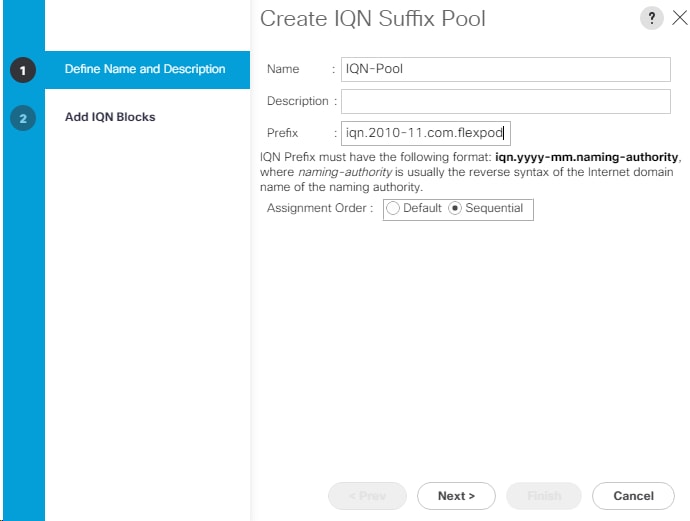
9. Click Next.
10. Click Add.
11. Enter a name to identify the individual UCS host for the Suffix.
12. Enter 1 for the From field.
13. Specify a size of the IQN block sufficient to support the available server resources.
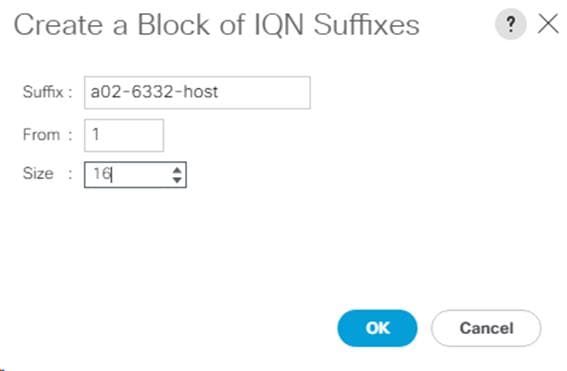
14. Click OK.
15. Click Finish and OK to complete creating the IQN pool.
Create iSCSI Boot IP Address Pools
To configure the necessary iSCSI IP Address pools for the Cisco UCS environment, complete the following steps:
1. In Cisco UCS Manager, click the LAN icon on the left.
2. Select and expand Pools > root > Sub-Organizations > FPV-FlexPod.
3. In this procedure, two IP pools are created, one for each switching fabric.
4. Right-click IP Pools under the FPV-FlexPod organization.
5. Select Create IP Pool to create the IP pool.
6. Enter iSCSI-IP-Pool-A as the name of the first IP pool.
7. Optional: Enter a description for the IP pool.
8. Select Sequential for Assignment Order.
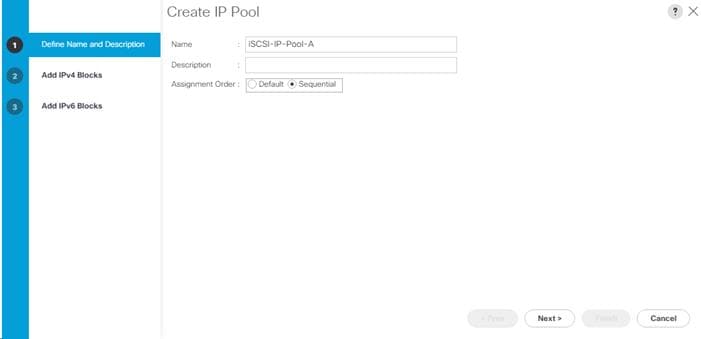
9. Click Next.
10. Click Add to add a Block of IPs to the pool.
11. Specify a starting IP address and subnet mask in the subnet <192.168.10.0/24> for iSCSI boot on Fabric A. It is not necessary to specify the Default Gateway or DNS server addresses.
12. Specify a size for the IP pool that is sufficient to support the available blade or server resources.
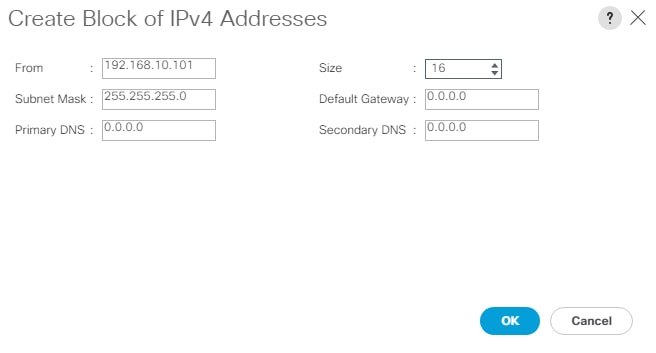
13. Click OK.
14. Click Next.
15. Click Finish.
16. In the confirmation message, click OK.
17. Right-click IP Pools under the FPV-FlexPod organization.
18. Select Create IP Pool to create the IP pool.
19. Enter iSCSI-IP-Pool-B as the name of the second IP pool.
20. Optional: Enter a description for the IP pool.
21. Select Sequential for Assignment Order
22. Click Next.
23. Click Add to add a Block of IPs to the pool.
24. Specify a starting IP address and subnet mask in the subnet <192.168.20.0/24> for iSCSI boot on Fabric B. It is not necessary to specify the Default Gateway or DNS server addresses.
25. Specify a size for the IP pool that is sufficient to support the available blade or server resources.
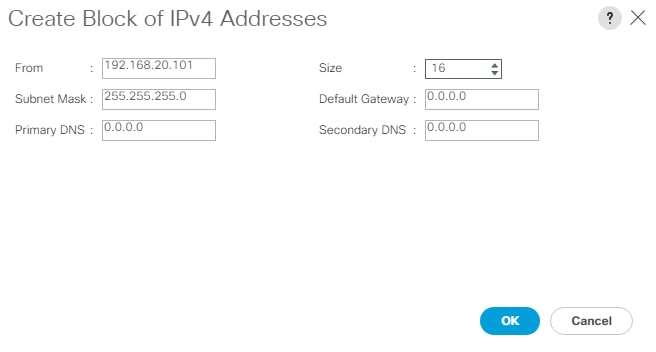
26. Click OK.
27. Click Next.
28. Click Finish.
29. In the confirmation message, click OK.
Create MAC Address Pools
To configure the necessary MAC address pools for the Cisco UCS environment, complete the following steps:
1. In Cisco UCS Manager, click the LAN icon on the left.
2. Select Pools > root.
![]() In this procedure, two MAC address pools are created, one for each switching fabric.
In this procedure, two MAC address pools are created, one for each switching fabric.
3. Right-click MAC Pools under the root organization.
4. Select Create MAC Pool to create the MAC address pool.
5. Enter MAC-Pool-A as the name of the MAC pool.
6. Optional: Enter a description for the MAC pool.
7. Select Sequential as the option for Assignment Order.
8. Click Next.
9. Click Add.
10. Specify a starting MAC address.
![]() For the FlexPod solution, the recommendation is to place 0A in the next-to-last octet of the starting MAC address to identify all of the MAC addresses as fabric A addresses. In our example, we have also embedded the cabinet number (A2) information giving us 00:25:B5:A2:0A:00 as our first MAC address.
For the FlexPod solution, the recommendation is to place 0A in the next-to-last octet of the starting MAC address to identify all of the MAC addresses as fabric A addresses. In our example, we have also embedded the cabinet number (A2) information giving us 00:25:B5:A2:0A:00 as our first MAC address.
11. Specify a size for the MAC address pool that is sufficient to support the available blade or server resources assuming that multiple vNICs can be configured on each server.
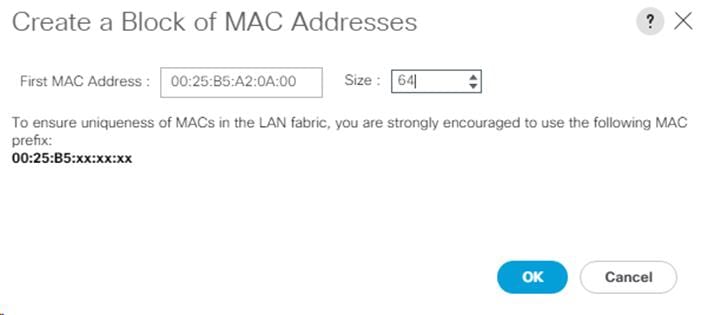
12. Click OK.
13. Click Finish.
14. In the confirmation message, click OK.
15. Right-click MAC Pools under the root organization.
16. Select Create MAC Pool to create the MAC address pool.
17. Enter MAC-Pool-B as the name of the MAC pool.
18. Optional: Enter a description for the MAC pool.
19. Select Sequential as the option for Assignment Order.
20. Click Next.
21. Click Add.
22. Specify a starting MAC address.
![]() For the FlexPod solution, the recommendation is to place 0A in the next-to-last octet of the starting MAC address to identify all of the MAC addresses as fabric A addresses. In our example, we have also embedded the cabinet number (A2) information giving us 00:25:B5:A2:0A:00 as our first MAC address.
For the FlexPod solution, the recommendation is to place 0A in the next-to-last octet of the starting MAC address to identify all of the MAC addresses as fabric A addresses. In our example, we have also embedded the cabinet number (A2) information giving us 00:25:B5:A2:0A:00 as our first MAC address.
23. Specify a size for the MAC address pool that is sufficient to support the available blade or server resources.
24. Click OK.
25. Click Finish.
26. In the confirmation message, click OK.
Create UUID Suffix Pool
To configure the necessary universally unique identifier (UUID) suffix pool for the Cisco UCS environment, complete the following steps:
1. In Cisco UCS Manager, click the Servers icon on the left.
2. Select Pools > root.
3. Right-click UUID Suffix Pools.
4. Select Create UUID Suffix Pool.
5. Enter UUID-Pool as the name of the UUID suffix pool.
6. Optional: Enter a description for the UUID suffix pool.
7. Keep the prefix at the derived option.
8. Select Sequential for the Assignment Order.
9. Click Next.
10. Click Add to add a block of UUIDs.
11. Keep the From field at the default setting. Optionally, specify identifiers such as UCS location.
12. Specify a size for the UUID block that is sufficient to support the available blade or server resources.
13. Click OK.
14. Click Finish.
15. Click OK.
Create Server Pool
To configure the necessary server pool for the VMware management environment, complete the following steps:
![]() Consider creating unique server pools to achieve the granularity that is required in your environment.
Consider creating unique server pools to achieve the granularity that is required in your environment.
1. In Cisco UCS Manager, click the Servers icon on the left.
2. Expand Pools > root > Sub-Organizations > FPV-FlexPod.
3. Right-click Server Pools under the FPV-FlexPod Organization.
4. Select Create Server Pool.
5. Enter FPV-MGMT-Pool as the name of the server pool.
6. Optional: Enter a description for the server pool.
7. Click Next.
8. Select two (or more) servers to be used for the VMware management cluster and click >> to add them to the FPV-MGMT-Pool server pool.
9. Click Finish.
10. Click OK.
Create VLANs
To configure the necessary virtual local area networks (VLANs) for the Cisco UCS environment, complete the following steps:
1. In Cisco UCS Manager, click the LAN icon on the left.
![]() In this procedure, eight unique and 100 sequential VLANs are created. See Table 2.
In this procedure, eight unique and 100 sequential VLANs are created. See Table 2.
![]() Note that the ACI System VLAN is being added here for the set of Cisco VIC vNICs that will be used for the APIC-Integrated Virtual Switch. Although this VLAN is not necessary for the VMware vDS, it is being put in for future usage with the Cisco ACI Virtual Edge (AVE) virtual switch.
Note that the ACI System VLAN is being added here for the set of Cisco VIC vNICs that will be used for the APIC-Integrated Virtual Switch. Although this VLAN is not necessary for the VMware vDS, it is being put in for future usage with the Cisco ACI Virtual Edge (AVE) virtual switch.
2. Select LAN > LAN Cloud.
3. Right-click VLANs.
4. Select Create VLANs.
5. Enter Native-VLAN as the name of the VLAN to be used as the native VLAN.
6. Keep the Common/Global option selected for the scope of the VLAN.
7. Enter the native VLAN ID <2>.
8. Keep the Sharing Type as None.
9. Click OK and then click OK again.
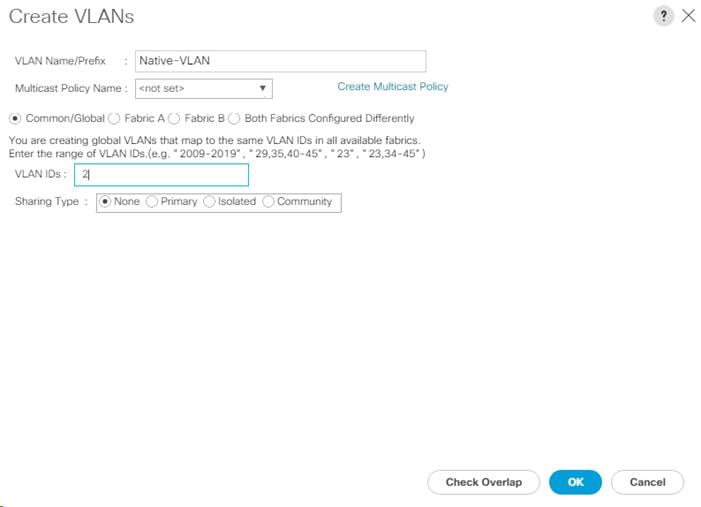
10. Expand the list of VLANs in the navigation pane, right-click the newly created Native-VLAN and select Set as Native VLAN.
11. Click Yes and then click OK.
12. Right-click VLANs.
13. Select Create VLANs
14. Enter FP-Core-Services as the name of the VLAN to be used for management traffic.
15. Keep the Common/Global option selected for the scope of the VLAN.
16. Enter the UCS Core-Services VLAN ID <318>.
17. Keep the Sharing Type as None.
18. Click OK, and then click OK again.
19. Right-click VLANs.
20. Select Create VLANs.
21. Enter FPV-IB-MGMT as the name of the VLAN to be used for management traffic.
22. Keep the Common/Global option selected for the scope of the VLAN.
23. Enter the UCS In-Band management VLAN ID <419>.
24. Keep the Sharing Type as None.
25. Click OK, and then click OK again.
26. Right-click VLANs.
27. Select Create VLANs.
28. Enter FPV-Foundation-NFS as the name of the VLAN to be used for infrastructure NFS.
29. Keep the Common/Global option selected for the scope of the VLAN.
30. Enter the UCS Infrastructure NFS VLAN ID <3150>.
31. Keep the Sharing Type as None.
32. Click OK, and then click OK again.
33. Right-click VLANs.
34. Select Create VLANs.
35. Enter FPV-Foundation-iSCSI-A as the name of the VLAN to be used for UCS Fabric A iSCSI boot.
36. Keep the Common/Global option selected for the scope of the VLAN.
37. Enter the UCS Fabric A iSCSI boot VLAN ID <3110>.
38. Keep the Sharing Type as None.
39. Click OK, and then click OK again.
40. Right-click VLANs.
41. Select Create VLANs.
42. Enter FPV-Foundation-iSCSI-B as the name of the VLAN to be used for UCS Fabric B iSCSI boot.
43. Keep the Common/Global option selected for the scope of the VLAN.
44. Enter the UCS Fabric B iSCSI boot VLAN ID <3120>.
45. Keep the Sharing Type as None.
46. Click OK, and then click OK again.
47. Right-click VLANs.
48. Select Create VLANs.
49. Enter FPV-vMotion as the name of the VLAN to be used for VMware vMotion.
50. Keep the Common/Global option selected for the scope of the VLAN.
51. Enter the FPV-vMotion VLAN ID <3000>.
52. Keep the Sharing Type as None.
53. Click OK, and then click OK again.
54. Right-click VLANs.
55. Select Create VLANs.
56. Enter ACI-System-VLAN as the name of the VLAN to be used for OpFlex communication to the VMware Virtual Switch.
57. Keep the Common/Global option selected for the scope of the VLAN.
58. Enter the ACI System VLAN ID <4093>.
![]() The ACI system VLAN ID can be determined by using ssh to connect to the APIC CLI and typing “ifconfig | grep bond0”. You should see a bond0.xxxx interface listed. The xxxx is the ACI system VLAN id.
The ACI system VLAN ID can be determined by using ssh to connect to the APIC CLI and typing “ifconfig | grep bond0”. You should see a bond0.xxxx interface listed. The xxxx is the ACI system VLAN id.
59. Keep the Sharing Type as None.
60. Click OK, and then click OK again.
61. Right-click VLANs.
62. Select Create VLANs.
63. Enter FPV-vSwitch-Pool as the prefix for this VLAN pool.
64. Keep the Common/Global option selected for the scope of the VLAN.
65. Enter a range of 100 VLANs for VLAN ID. <1100-1199> was used in this validation.
66. Keep the Sharing Type as None.
67. Click OK and then click OK again.
Modify Default Host Firmware Package
Firmware management policies allow the administrator to select the corresponding packages for a given server configuration. These policies often include packages for adapter, BIOS, board controller, FC adapters, host bus adapter (HBA) option ROM, and storage controller properties.
To specify the UCS 3.2(3a) release for the Default firmware management policy for a given server configuration in the Cisco UCS environment, complete the following steps:
1. In Cisco UCS Manager, click the Servers icon on the left.
2. Select Policies > root.
3. Expand Host Firmware Packages.
4. Select default.
5. In the Actions pane, select Modify Package Versions.
6. Select the version 3.2(3a)B for the Blade Package, and 3.2(3a)C (optional) for the Rack Package.
7. Leave Excluded Components with only Local Disk selected.
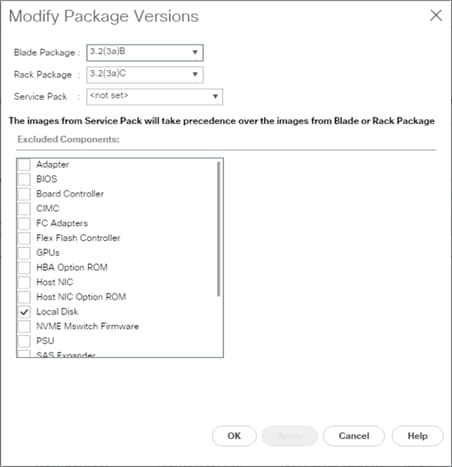
8. Click OK then click OK again to modify the host firmware package.
Set Jumbo Frames in Cisco UCS Fabric
To configure jumbo frames and enable the base quality of service in the Cisco UCS fabric, complete the following steps:
1. In Cisco UCS Manager, click the LAN icon on the left.
2. Select LAN > LAN Cloud > QoS System Class.
3. In the right pane, click the General tab.
4. On the Best Effort row, enter 9216 in the box under the MTU column.
5. Click Save Changes in the bottom of the window.
6. Click OK.
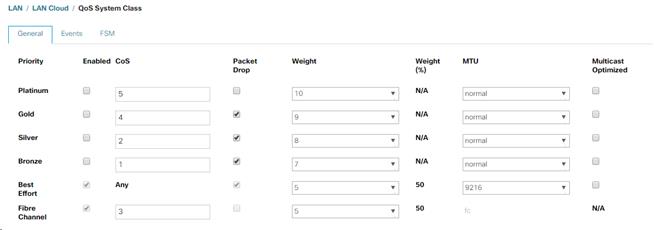
Create Local Disk Configuration Policy (Optional)
A local disk configuration for the Cisco UCS environment is necessary if the servers in the environment do not have a local disk.
![]() This policy should not be used on servers that contain local disks.
This policy should not be used on servers that contain local disks.
To create a local disk configuration policy, complete the following steps:
1. In Cisco UCS Manager, click the Servers icon on the left.
2. Select Policies > root.
3. Right-click Local Disk Config Policies.
4. Select Create Local Disk Configuration Policy.
5. Enter SAN-Boot as the local disk configuration policy name.
6. Change the mode to No Local Storage.
7. Click OK to create the local disk configuration policy.
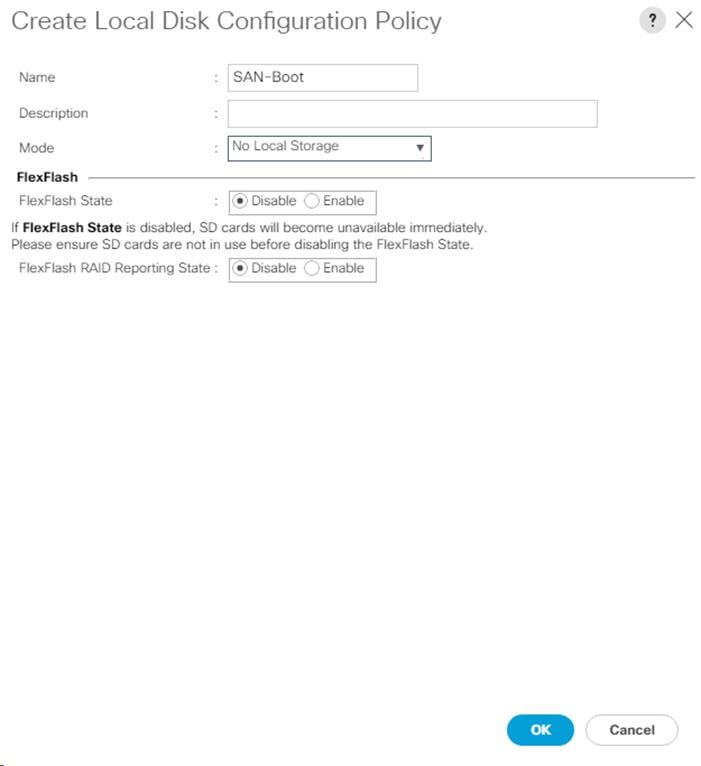
8. Click OK.
Create Network Control Policy for Cisco Discovery Protocol (CDP) and Link Layer Discovery Protocol (LLDP)
To create a network control policy that enables CDP and LLDP on virtual network ports, complete the following steps:
1. In Cisco UCS Manager, click the LAN icon on the left.
2. Select Policies > root.
3. Right-click Network Control Policies.
4. Select Create Network Control Policy.
5. Enter Enable-CDP-LLDP as the policy name.
6. For CDP, select the Enabled option.
7. For LLDP, scroll down and select Enabled for both Transmit and Receive.
8. Click OK to create the network control policy.
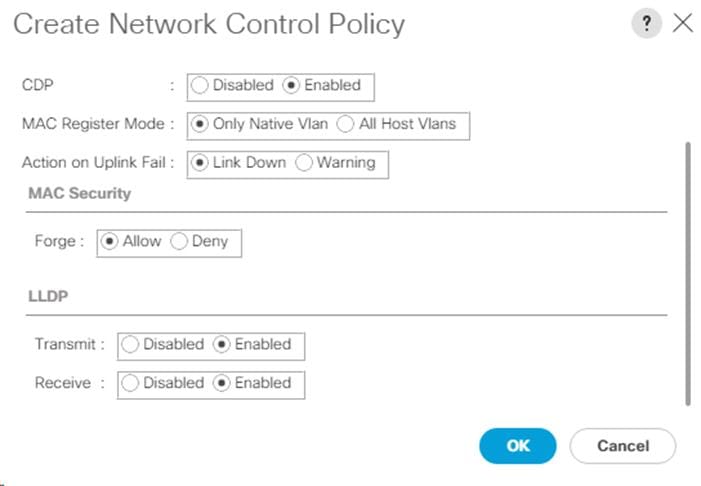
9. Click OK.
Create Power Control Policy
To create a power control policy for the Cisco UCS environment, complete the following steps:
1. In Cisco UCS Manager, click the Servers icon on the left.
2. Select Policies > root.
3. Right-click Power Control Policies.
4. Select Create Power Control Policy.
5. Enter No-Power-Cap as the power control policy name.
6. Change the power capping setting to No Cap.
7. Click OK to create the power control policy.
8. Click OK.
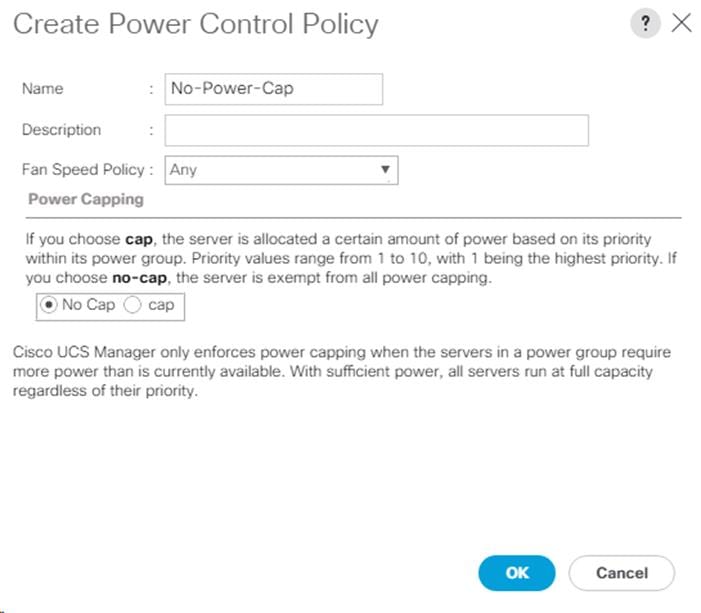
Create Server Pool Qualification Policy (Optional)
To create an optional server pool qualification policy for the Cisco UCS environment, complete the following steps:
![]() This example creates a policy to select Cisco UCS B200 M5 Servers.
This example creates a policy to select Cisco UCS B200 M5 Servers.
1. In Cisco UCS Manager, click the Servers icon on the left.
2. Select Policies > root.
3. Right-click Server Pool Policy Qualifications.
4. Select Create Server Pool Policy Qualification.
5. Name the policy UCSB-B200-M5.
6. Select Create Server PID Qualifications.
7. Using the drop-down list, select UCSB-B200-M5 as the PID.
8. Click OK to create the Server PID qualification.
9. Click OK to create the policy then OK for the confirmation.
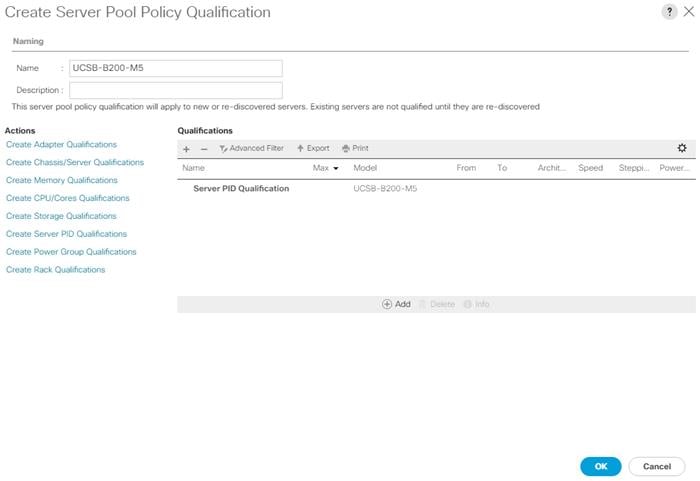
Create Server BIOS Policy
To create a server BIOS policy for the Cisco UCS environment, complete the following steps:
1. In Cisco UCS Manager, click the Servers icon on the left.
2. Select Policies > root.
3. Right-click BIOS Policies.
4. Select Create BIOS Policy.
5. Enter Virtual-Host as the BIOS policy name.
6. Click OK then OK again.
7. Expand BIOS Policies and select Virtual-Host.
8. On the right, change the Quiet Boot setting to Disabled.
9. Change CDN Control to Enabled.
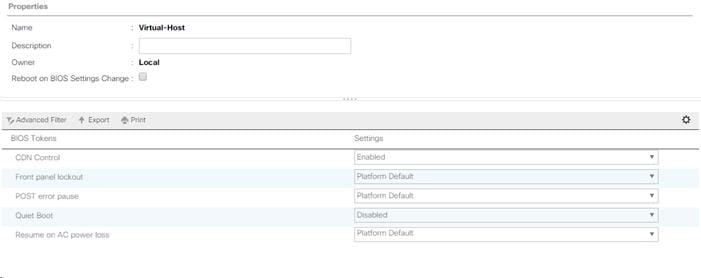
10. Click Save Changes and OK.
11. Click the Advanced tab and then the Processor tab.
12. Set the following within the Processor tab:
a. Processor C State -> Disabled
b. Processor C1E -> Disabled
c. Processor C3 Report -> Disabled
d. Processor C7 Report -> Disabled
e. Energy Performance -> Performance
f. Frequency Floor Override -> Enabled
g. DRAM Clock Throttling -> Performance
13. Click Save Changes and OK.
14. Click the RAS Memory tab and select:
a. LV DDR Mode -> Performance-Mode

15. Click Save Changes and OK.
Create High Traffic VMware Adapter Policy
To create the option VMware-High-Traffic Ethernet Adapter policy to provide higher vNIC performance, complete the following steps:
1. In Cisco UCS Manager, click the Servers icon on the left.
2. Select Policies > root.
3. Right-click Adapter Policies and select Create Ethernet Adapter Policy.
4. Name the policy VMware-HighTrf.
5. Expand Resources and set the values as shown below.
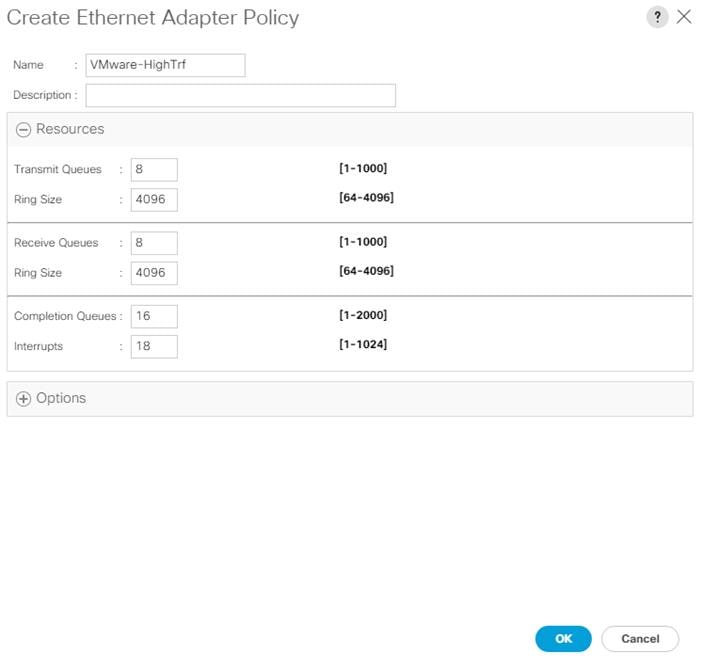
6. Expand Options and select Enabled for Receive Side Scaling (RSS).
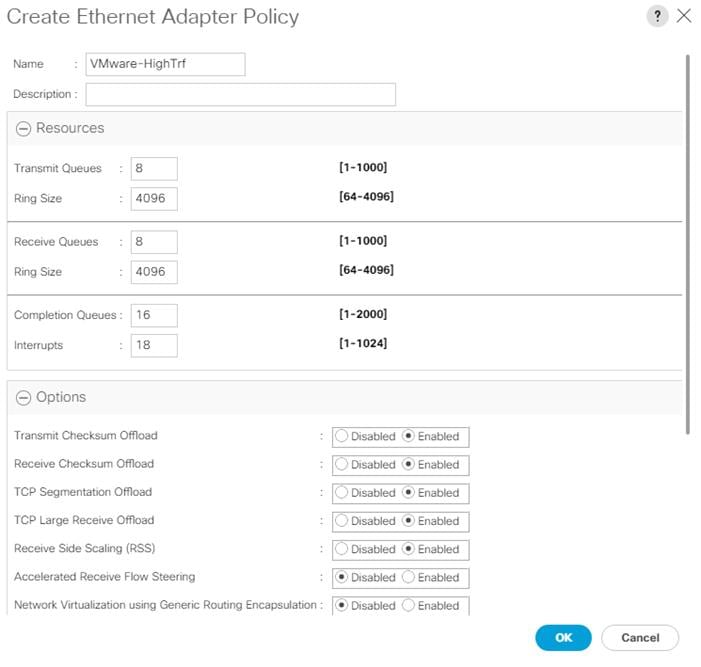
7. Click OK, then OK again to complete creating the Ethernet Adapter Policy.
Update the Default Maintenance Policy
To update the default Maintenance Policy, complete the following steps:
1. In Cisco UCS Manager, click the Servers icon on the left.
2. Select Policies > root.
3. Select Maintenance Policies > default.
4. Change the Reboot Policy to User Ack.
5. Select “On Next Boot” to delegate maintenance windows to server administrators.
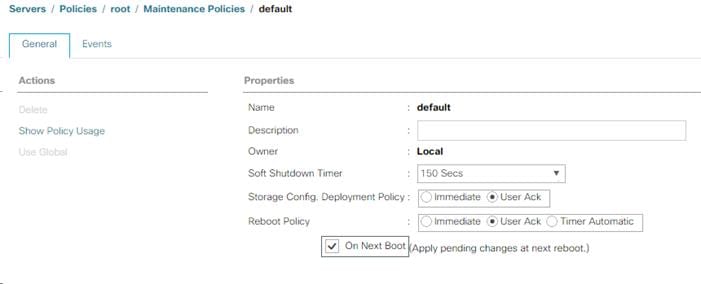
6. Click Save Changes.
7. Click OK to accept the change.
Create vNIC Templates
To create multiple virtual network interface card (vNIC) templates for the Cisco UCS environment, complete the following steps. A total of 6 vNIC Templates will be created.
Create Infrastructure vNICs Templates
1. In Cisco UCS Manager, click the LAN icon on the left.
2. Expand Policies > root > Sub-Organizations > FPV-FlexPod.
3. Right-click vNIC Templates under FPV-FlexPod.
4. Select Create vNIC Template.
5. Enter Infra-A as the vNIC template name.
6. Keep Fabric A selected.
7. Do not select the Enable Failover checkbox.
8. Select Primary Template for Redundancy Type.
9. Leave the Peer Redundancy Template set to <not set>.
10. Under Target, make sure that only the Adapter checkbox is selected.
11. Select Updating Template as the Template Type.
12. Under VLANs, select the checkboxes for FP-Core-Services, FPV-Foundation-NFS, FPV-IB-MGMT, FPV-vMotion, and Native-VLAN.
13. Set Native-VLAN as the native VLAN.
14. Select vNIC Name for the CDN Source.
15. For MTU, enter 9000.
16. In the MAC Pool list, select MAC-Pool-A.
17. In the Network Control Policy list, select Enable-CDP-LLDP.
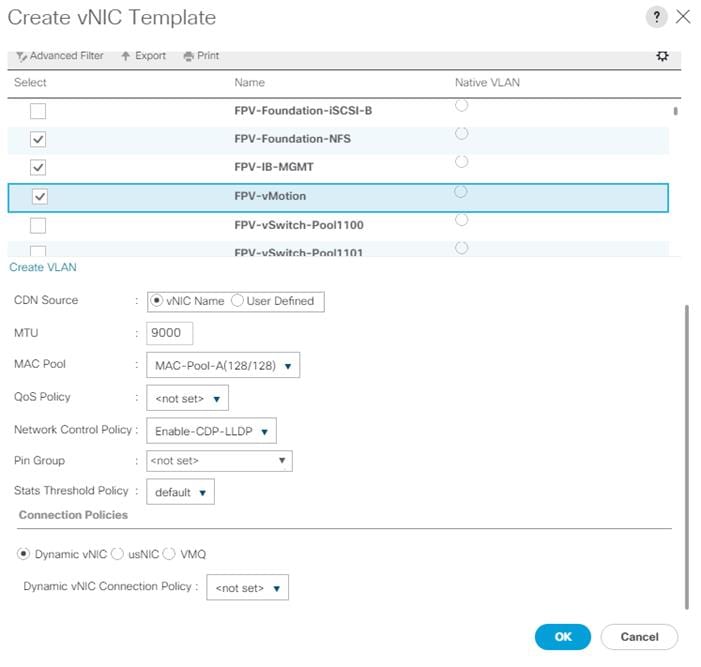
18. Click OK to create the vNIC template.
19. Click OK.
Create the secondary redundancy template Infra-B:
1. Select the LAN icon on the left.
2. Expand Policies > root > Sub-Organizations > FPV-FlexPod.
3. Right-click vNIC Templates under FPV-FlexPod.
4. Select Create vNIC Template.
5. Enter Infra-B as the vNIC template name.
6. Select Fabric B.
7. Do not elect the Enable Failover checkbox.
8. Set Redundancy Type to Secondary Template.
9. Select Infra-A for the Peer Redundancy Template.
10. In the MAC Pool list, select MAC-Pool-B. The MAC Pool is all that needs to be selected for the Secondary Template.
11. Click OK to create the vNIC template.
12. Click OK.
Create iSCSI Boot vNICs
To create iSCSI Boot vNICs, complete the following steps:
1. In Cisco UCS Manager, click the LAN icon on the left.
2. Expand Policies > root > Sub-Organizations > FPV-FlexPod.
3. Right-click vNIC Templates under FPV-FlexPod.
4. Select Create vNIC Template.
5. Enter iSCSI-A as the vNIC template name.
6. Keep Fabric A selected.
7. Do not select the Enable Failover checkbox.
8. Select No Redundancy for Redundancy Type.
9. Under Target, make sure that only the Adapter checkbox is selected.
10. Select Updating Template as the Template Type.
11. Under VLANs, select the checkbox for FPV-Foundation-iSCSI-A.
12. Set FPV-Foundation-iSCSI-A as the native VLAN.
13. Select vNIC Name for the CDN Source.
14. For MTU, enter 9000.
15. In the MAC Pool list, select MAC-Pool-A.
16. In the Network Control Policy list, select Enable-CDP-LLDP.
17. Click OK to create the vNIC template.
18. Click OK.
Create the Infra-iSCSI-B template:
1. Select the LAN icon on the left.
2. Expand Policies > root > Sub-Organizations > FPV-FlexPod.
3. Right-click vNIC Templates under FPV-FlexPod.
4. Select Create vNIC Template.
5. Enter iSCSI-B as the vNIC template name.
6. Select Fabric B.
7. Do not elect the Enable Failover checkbox.
8. Select No Redundancy for Redundancy Type.
9. Under Target, make sure that only the Adapter checkbox is selected.
10. Select Updating Template as the Template Type.
11. Under VLANs, select the checkbox for FPV-Foundation-iSCSI-B.
12. Set FPV-Foundation-iSCSI-B as the native VLAN.
13. Select vNIC Name for the CDN Source.
14. For MTU, enter 9000.
15. In the MAC Pool list, select MAC-Pool-B.
16. In the Network Control Policy list, select Enable-CDP-LLDP.
17. Click OK to create the vNIC template.
18. Click OK.
Create vNIC Templates for APIC-Integrated Virtual Switch
To create vNIC templates for APIC-controlled virtual switch, complete the following steps:
![]() Note that the ACI System VLAN is being added here for the set of Cisco VIC vNICs that will be used for the APIC-Integrated Virtual Switch. Although this VLAN is not necessary for the VMware vDS, it is being put in for future usage with the Cisco ACI Virtual Edge (AVE) virtual switch.
Note that the ACI System VLAN is being added here for the set of Cisco VIC vNICs that will be used for the APIC-Integrated Virtual Switch. Although this VLAN is not necessary for the VMware vDS, it is being put in for future usage with the Cisco ACI Virtual Edge (AVE) virtual switch.
1. In Cisco UCS Manager, click the LAN icon on the left.
2. Expand Policies > root > Sub-Organizations > FPV-FlexPod.
3. Right-click vNIC Templates under FPV-FlexPod.
4. Select Create vNIC Template.
5. Enter APIC-VS-A as the vNIC template name.
6. Keep Fabric A selected.
7. Do not select the Enable Failover checkbox.
8. Select Primary Template for Redundancy Type.
9. Leave the Peer Redundancy Template set to <not set>.
10. Under Target, make sure that only the Adapter checkbox is selected.
11. Select Updating Template as the Template Type.
12. Under VLANs, select the checkboxes for ACI-System-VLAN and all 100 Virtual-Switch-Pool VLANs.
13. Do not set a native VLAN.
14. Select vNIC Name for the CDN Source.
15. For MTU, enter 9000.
16. In the MAC Pool list, select MAC-Pool-A.
17. In the Network Control Policy list, select Enable-CDP-LLDP.
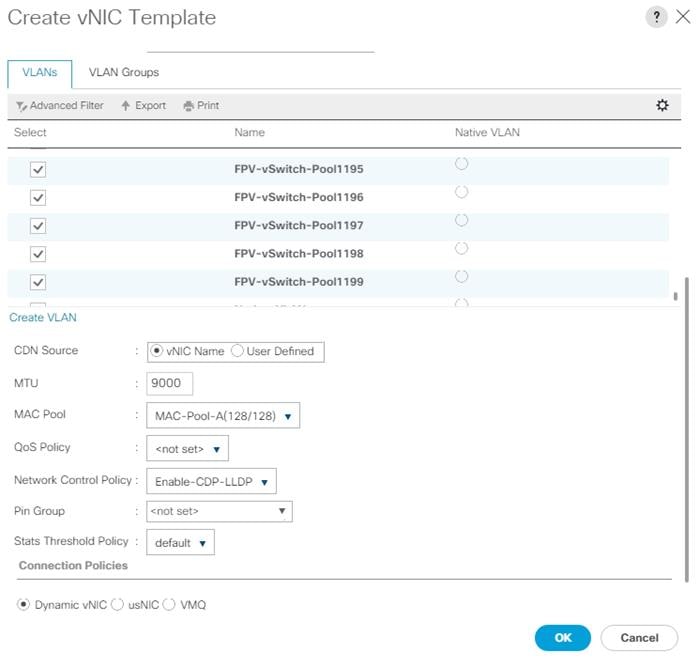
18. Click OK to create the vNIC template.
19. Click OK.
Create the secondary redundancy template APIC-VS-B:
1. Select the LAN icon on the left.
2. Expand Policies > root > Sub-Organizations > FPV-FlexPod.
3. Right-click vNIC Templates under FPV-FlexPod.
4. Select Create vNIC Template:
a. Enter APIC-VS-B as the vNIC template name.
b. Select Fabric B.
c. Do not elect the Enable Failover checkbox.
d. Set Redundancy Type to Secondary Template.
e. Select APIC-VS-A for the Peer Redundancy Template.
f. In the MAC Pool list, select MAC-Pool-B. The MAC Pool is all that needs to be selected for the Secondary Template.
g. Click OK to create the vNIC template.
5. Click OK.
Create LAN Connectivity Policy for iSCSI Boot
To configure the necessary Infrastructure LAN Connectivity Policy, complete the following steps:
1. In Cisco UCS Manager, click the LAN icon on the left.
2. Expand Policies > root > Sub-Organizations > FPV-FlexPod.
3. Right-click LAN Connectivity Policies under FPV-FlexPod.
4. Select Create LAN Connectivity Policy.
5. Enter iSCSI-Boot as the name of the policy.
6. Click the upper Add button to add a vNIC.
7. In the Create vNIC dialog box, enter 00-Infra-A as the name of the vNIC.
8. Select the Use vNIC Template checkbox.
9. In the vNIC Template list, select Infra-A.
10. In the Adapter Policy list, select VMware.
11. Click OK to add this vNIC to the policy.

12. Click the upper Add button to add another vNIC to the policy.
13. In the Create vNIC box, enter 01-Infra-B as the name of the vNIC.
14. Select the Use vNIC Template checkbox.
15. In the vNIC Template list, select Infra-B.
16. In the Adapter Policy list, select VMware.
17. Click OK to add the vNIC to the policy.
18. Click the upper Add button to add another vNIC to the policy.
19. In the Create vNIC box, enter 02-iSCSI-A as the name of the vNIC.
20. Select the Use vNIC Template checkbox.
21. In the vNIC Template list, select iSCSI-A.
22. In the Adapter Policy list, select VMware.
23. Click OK to add the vNIC to the policy.
24. Click the upper Add button to add another vNIC to the policy.
25. In the Create vNIC box, enter 03-iSCSI-B as the name of the vNIC.
26. Select the Use vNIC Template checkbox.
27. In the vNIC Template list, select iSCSI-B.
28. In the Adapter Policy list, select VMware.
29. Click OK to add the vNIC to the policy.
30. Click the upper Add button to add another vNIC to the policy.
31. In the Create vNIC box, enter 04-APIC-VS-A as the name of the vNIC.
32. Select the Use vNIC Template checkbox.
33. In the vNIC Template list, select APIC-VS-A.
34. In the Adapter Policy list, select VMware. Optionally, select the VMware-HighTrf Adapter Policy.
35. Click OK to add the vNIC to the policy.
36. Click the upper Add button to add another vNIC to the policy.
37. In the Create vNIC box, enter 05-APIC-VS-B as the name of the vNIC.
38. Select the Use vNIC Template checkbox.
39. In the vNIC Template list, select APIC-VS-B.
40. In the Adapter Policy list, select VMware. Optionally, select the VMware-HighTrf Adapter Policy.
41. Click OK to add the vNIC to the policy.
42. Expand the Add iSCSI vNICs section.
43. Click the lower Add button to add an iSCSI boot vNIC to the policy.
44. In the Create iSCSI vNIC box, enter iSCSI-Boot-A as the name of the vNIC.
45. Select 02-iSCSI-A for the Overlay vNIC.
46. Select the default iSCSI Adapter Policy.
47. FPV-Foundation-iSCSI-A (native) should be selected as the VLAN.
48. Do not select anything for MAC Address Assignment.

49. Click OK to add the vNIC to the policy.
50. Click the lower Add button to add an iSCSI boot vNIC to the policy.
51. In the Create iSCSI vNIC box, enter iSCSI-Boot-B as the name of the vNIC.
52. Select 03-iSCSI-B for the Overlay vNIC.
53. Select the default iSCSI Adapter Policy.
54. FPV-Foundation-iSCSI-B (native) should be selected as the VLAN.
55. Do not select anything for MAC Address Assignment.
56. Click OK to add the vNIC to the policy.
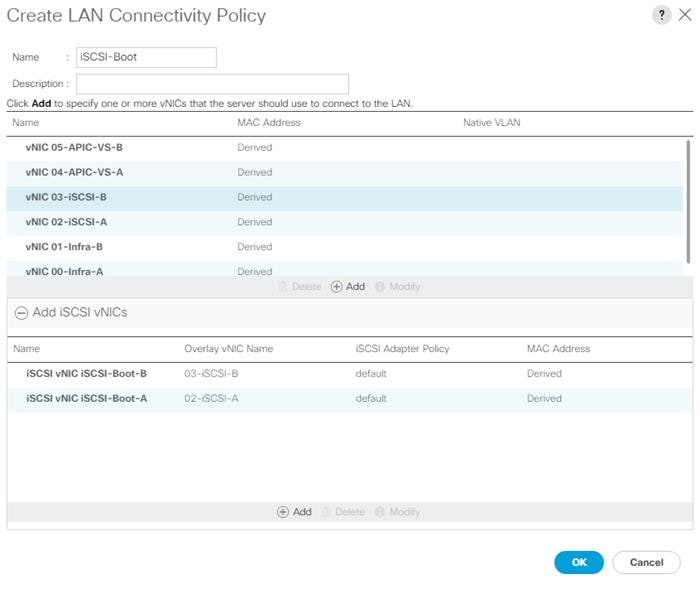
57. Click OK, then OK again to create the LAN Connectivity Policy.
Create iSCSI Boot Policies
This procedure applies to a Cisco UCS environment in which two iSCSI logical interfaces (LIFs) are on storage cluster node 1 (iscsi_lif01a and iscsi_lif01b) and two iSCSI LIFs are on storage cluster node 2 (iscsi_lif02a and iscsi_lif02b).
This boot policy configures the primary target to be iscsi_lif01a with four SAN paths.
To create a boot policy for the Cisco UCS environment, complete the following steps:
1. In Cisco UCS Manager, click the Servers icon on the left.
2. Expand Policies > root > Sub-Organizations > FPV-FlexPod.
3. Right-click Boot Policies under FPV-FlexPod.
4. Select Create Boot Policy.
5. Enter iSCSI-Boot as the name of the boot policy.
6. Optional: Enter a description for the boot policy.
7. Keep the Reboot on Boot Order Change option cleared.
8. Expand the Local Devices drop-down list and select Remote CD/DVD.
9. Expand the iSCSI vNICs drop-down list and select Add iSCSI Boot.
10. Enter iSCSI-Boot-A in the iSCSI vNIC field.
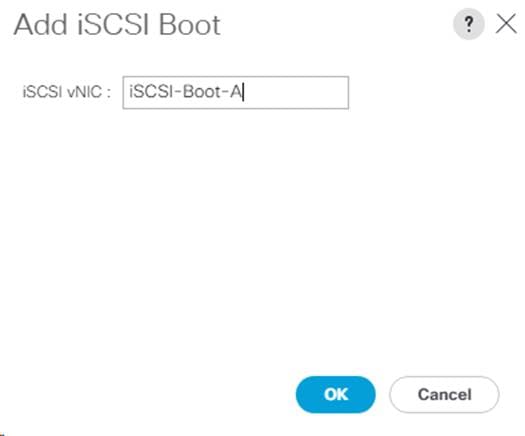
11. Click OK.
12. From the iSCSI vNICs drop-down list, select Add iSCSI Boot.
13. Enter iSCSI-Boot-B in the iSCSI vNIC field.
14. Click OK.
15. Click OK, then click OK again to create the boot policy.
Create iSCSI Boot Service Profile Template
In this procedure, one service profile template is created for Fabric A boot.
To create the service profile template, complete the following steps:
1. In Cisco UCS Manager, click the Servers icon on the left.
2. Expand Service Profile Templates > root > Sub-Organizations > FPV-FlexPod.
3. Select and right-click FPV-FlexPod.
4. Select Create Service Profile Template to open the Create Service Profile Template wizard.
5. Enter iSCSI-Boot-A as the name of the service profile template. This service profile template is configured to boot from storage node 1 on fabric A.
6. Select the “Updating Template” option.
7. Under UUID, select UUID-Pool as the UUID pool.

8. Click Next.
Configure Storage Provisioning
1. If you have servers with no physical disks, click the Local Disk Configuration Policy and select the SAN-Boot Local Storage Policy. Otherwise, select the default Local Storage Policy.
2. Click Next.
Configure Networking Options
1. Keep the default setting for Dynamic vNIC Connection Policy.
2. Select the “Use Connectivity Policy” option to configure the LAN connectivity.
3. Select iSCSI-Boot from the LAN Connectivity Policy drop-down list.
4. Select IQN-Pool from the Initiator Name Assignment drop-down list.
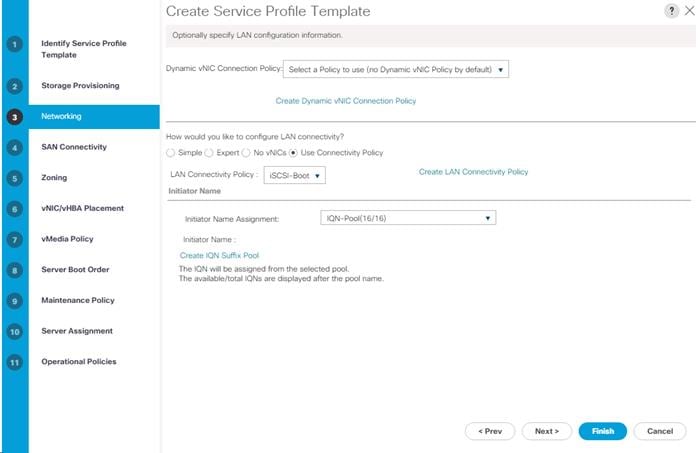
5. Click Next.
Configure SAN Connectivity Options
1. Select the No vHBAs option for the “How would you like to configure SAN connectivity?” field.
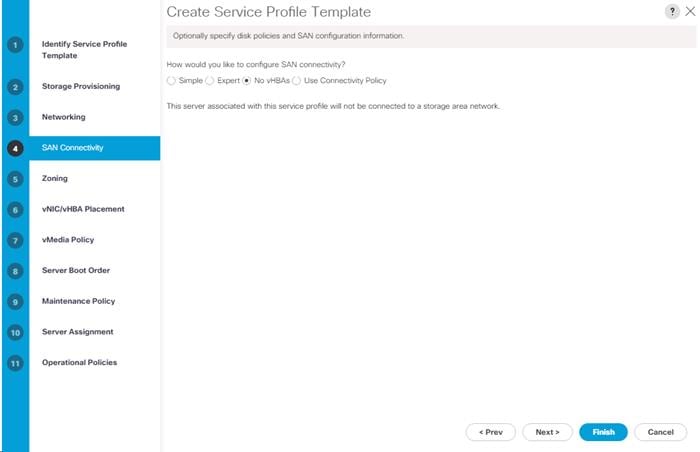
2. Click Next.
Configure Zoning Options
1. Configure no Zoning Options and click Next.
Configure vNIC/HBA Placement
1. In the “Select Placement” list, leave the placement policy as “Let System Perform Placement.”
2. Click Next.
Configure vMedia Policy
1. Do not select a vMedia Policy.
2. Click Next.
Configure Server Boot Order
1. Select iSCSI-Boot for Boot Policy.
2. Under Boot Order, expand Boot Order and select the iSCSI-Boot-A row.
3. Select the Set iSCSI Boot Parameters button.
4. Select iSCSI-IP-Pool-A for the Initiator IP Address Policy.
5. Scroll to the bottom of the window and click Add.
6. Enter the IQN (Target Name) from the FPV-Foundation-SVM iSCSI Target Name. To get this IQN, ssh into the storage cluster interface and type “iscsi show”.
7. For IPv4 address, enter the IP address of iscsi_lif02a from the FPV-Foundation-SVM. To get this IP, ssh into the storage cluster interface and type “network interface show –vserver FPV-Foundation-SVM”.
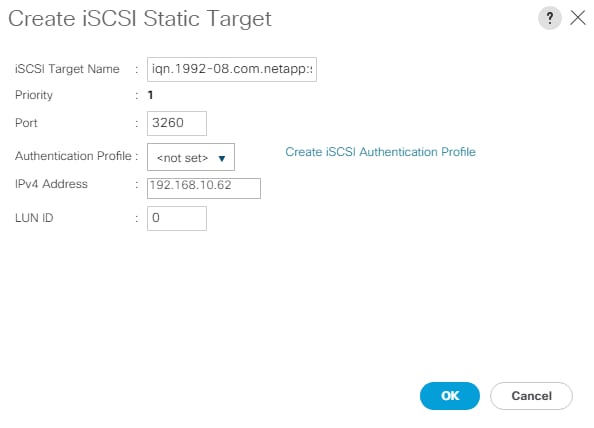
8. Click OK to complete configuring the iSCSI target.
9. Click Add to add a second target.
10. Enter the IQN (Target Name) from the FPV-Foundation-SVM iSCSI Target Name. To get this IQN, ssh into the storage cluster interface and type “iscsi show”.
11. For IPv4 address, enter the IP address of iscsi_lif01a from the FPV-Foundation-SVM. To get this IP, ssh into the storage cluster interface and type “network interface show –vserver FPV-Foundation-SVM”.
12. Click OK to complete configuring the iSCSI target.
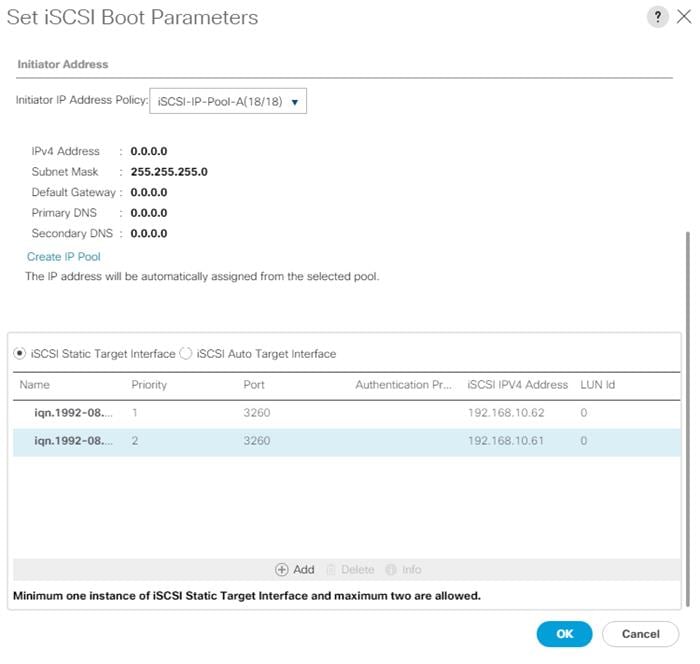
13. Click OK to complete setting the iSCSI Boot Parameters for Fabric A Boot.
14. Under Boot Order, select the iSCSI-Boot-B row.
15. Select the Set iSCSI Boot Parameters button.
16. Select iSCSI-IP-Pool-B for the Initiator IP Address Policy.
17. Scroll to the bottom of the window and click Add.
18. Enter the IQN (Target Name) from the FPV-Foundation-SVM iSCSI Target Name. To get this IQN, ssh into the storage cluster interface and type “iscsi show.”
19. For IPv4 address, enter the IP address of iscsi_lif02b from the FPV-Foundation-SVM. To get this IP, ssh into the storage cluster interface and type “network interface show –vserver FPV-Foundation-SVM.”
20. Click OK to complete configuring the iSCSI target.
21. Click Add to add a second target.
22. Enter the IQN (Target Name) from the FPV-Foundation-SVM iSCSI Target Name. To get this IQN, ssh into the storage cluster interface and type “iscsi show.”
23. For IPv4 address, enter the IP address of iscsi_lif01b from the FPV-Foundation-SVM. To get this IP, ssh into the storage cluster interface and type “network interface show –vserver FPV-Foundation-SVM.”
24. Click OK to complete configuring the iSCSI target.
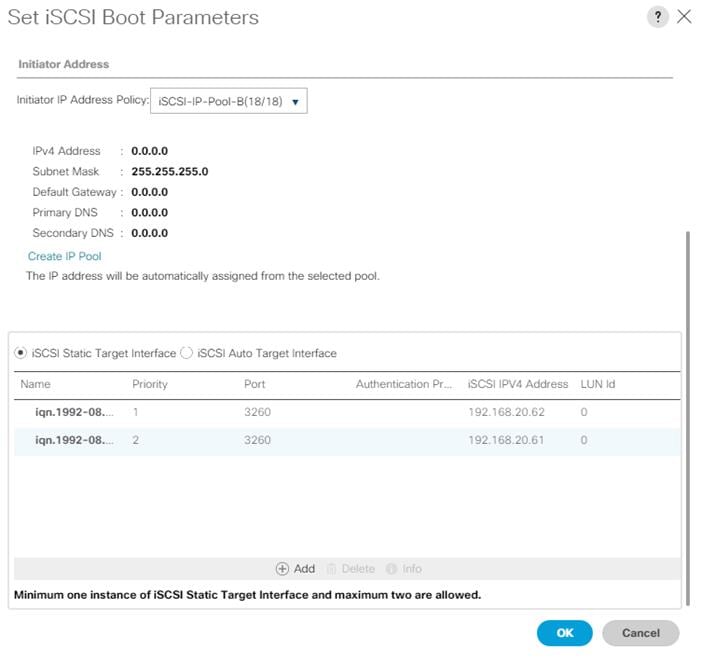
25. Click OK to complete setting the iSCSI Boot Parameters for Fabric A Boot.
26. Click Next.
Configure Maintenance Policy
To configure the Maintenance Policy, complete the following steps:
1. Change the Maintenance Policy to default.
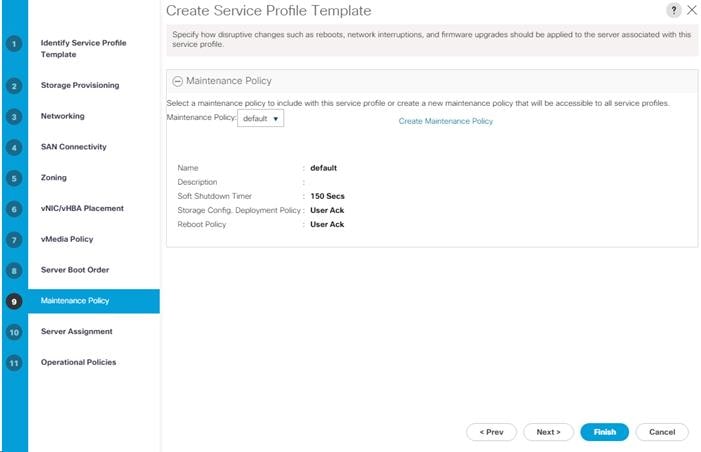
2. Click Next.
Configure Server Assignment
To configure server assignment, complete the following steps:
1. In the Pool Assignment list, select FPV-MGMT-Pool.
2. Select Down as the power state to be applied when the profile is associated with the server.
3. Optional: select “UCSB-B200-M5” for the Server Pool Qualification.
4. Expand Firmware Management at the bottom of the page and select the default policy.
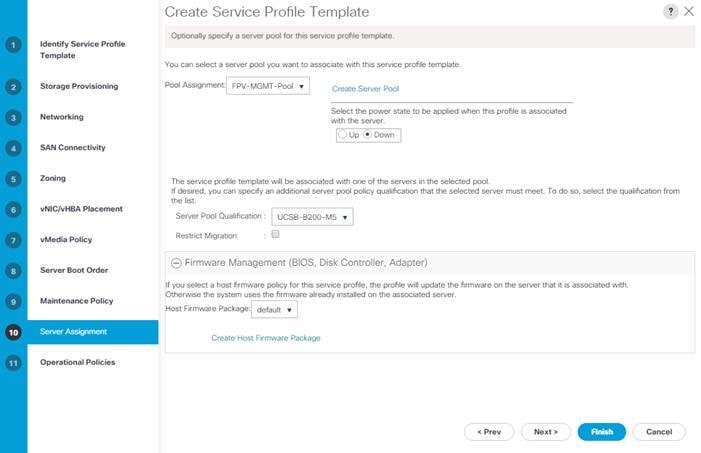
5. Click Next.
Configure Operational Policies
To configure the operational policies, complete the following steps:
1. In the BIOS Policy list, select Virtual-Host.
2. Expand Power Control Policy Configuration and select No-Power-Cap in the Power Control Policy list.
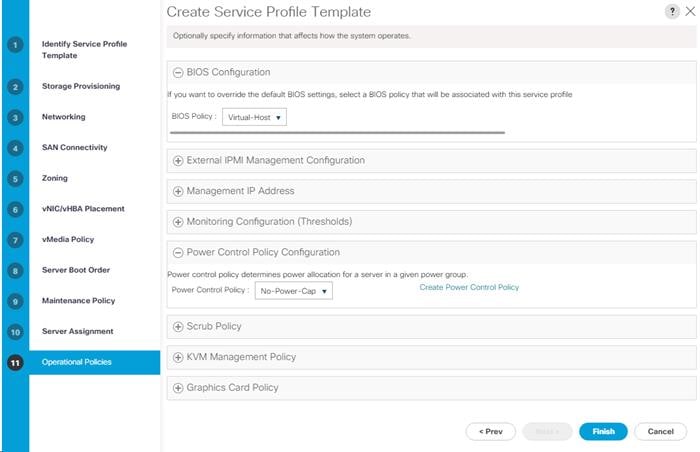
3. Click Finish to create the service profile template.
4. Click OK in the confirmation message.
Create Service Profiles
To create service profiles from the service profile template, complete the following steps:
1. Connect to UCS Manager and click the Servers icon on the left.
2. Select Service Profile Templates > root > Sub-Organizations > FPV-FlexPod > Service Template iSCSI-Boot-A.
3. Right-click iSCSI-Boot-A and select Create Service Profiles from Template.
4. Enter fpv-esxi-0 as the service profile prefix.
5. Enter 1 as “Name Suffix Starting Number.”
6. Enter 2 as the “Number of Instances.”
7. Click OK to create the service profiles.
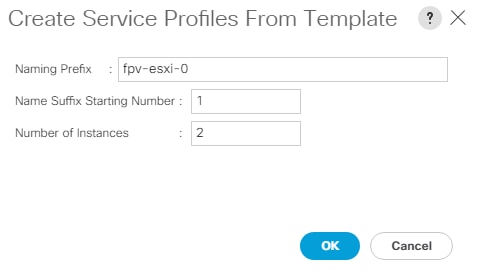
8. Click OK in the confirmation message.
Gather Necessary Information
After the Cisco UCS service profiles have been created, each infrastructure server in the environment will have a unique configuration. To proceed with the FlexPod deployment, specific information must be gathered from each Cisco UCS server and from the NetApp controllers. Insert the required information into Table 2 and Table 3.
Table 2 iSCSI LIFs for iSCSI IQN
| SVM | Target: IQN |
| Foundation-FPV-SVM |
|
To obtain the iSCSI IQN, run iscsi show command on the storage cluster management interface.
Table 3 vNIC iSCSI IQNs for fabric A and fabric B
| Cisco UCS Service Profile Name | iSCSI IQN | Variables |
| fpv-esxi-01 |
| <fpv-esxi-01-iqn> |
| fpv-esxi-02 |
| <fpv-esxi-02-iqn> |
To obtain the iSCSI vNIC IQN information in Cisco UCS Manager GUI, go to Servers > Service Profiles > root. Click each service profile and then click the “iSCSI vNICs” tab on the right. The “Initiator Name” is displayed at the top of the page under the “Service Profile Initiator Name.”
NetApp ONTAP Boot Storage Setup
Create igroups
To create igroups, run the following commands:
igroup create –vserver FPV-Foundation-SVM –igroup fpv-esxi-01 –protocol iscsi –ostype vmware –initiator <fpv-esxi-01-iqn>
igroup create –vserver FPV-Foundation-SVM –igroup fpv-esxi-02 –protocol iscsi –ostype vmware –initiator <fpv-esxi-02-iqn>
igroup create –vserver FPV-Foundation-SVM –igroup MGMT-Hosts-All –protocol iscsi –ostype vmware –initiator <fpv-esxi-01-iqn>,<fpv-esxi-02-iqn>
igroup show –vserver FPV-Foundation-SVM
1. To get the management host IQNs, log in to Cisco UCS Manager and click the Servers icon on the left.
2. Select the host Service Profile. The host IQN is listed under the iSCSI vNICs tab on the right.
Map Boot LUNs to igroups
To map LUNs to igroups, run the following commands:
lun map –vserver FPV-Foundation-SVM –volume esxi_boot –lun fpv-esxi-01 –igroup fpv-esxi-01 –lun-id 0
lun map –vserver FPV-Foundation-SVM –volume esxi_boot –lun fpv-esxi-02 –igroup fpv-esxi-02 –lun-id 0
lun show –vserver FPV-Foundation-SVM -m
VMware ESXi 6.5 Update 1
This section provides detailed instructions for installing VMware ESXi 6.5 Update 1 in a FlexPod environment. After the procedures are completed, two booted ESXi hosts will be provisioned.
Several methods exist for installing ESXi in a VMware environment. These procedures focus on how to use the built-in keyboard, video, mouse (KVM) console and mapped CD/DVD in Cisco UCS Manager to map remote installation media to individual servers and connect to their boot logical unit numbers (LUNs).
Download Cisco Custom Image for ESXi 6.5 Update 1
If the VMware ESXi custom image has not been downloaded, complete the following steps to complete the download:
1. Click the following link: VMware vSphere Hypervisor (ESXi) 6.5U1.
2. You will need a user id and password on vmware.com to download this software.
3. Download the .iso file.
Log in to Cisco UCS 6300 Fabric Interconnect
Cisco UCS Manager
The Cisco UCS IP KVM enables the administrator to begin the installation of the operating system (OS) through remote media. It is necessary to log in to the Cisco UCS environment to run the IP KVM.
To log in to the Cisco UCS environment, complete the following steps:
1. Open a web browser and enter the IP address for the Cisco UCS cluster address. This step launches the Cisco UCS Manager application.
2. Click the Launch UCS Manager link under HTML to launch the HTML 5 UCS Manager GUI.
3. If prompted to accept security certificates, accept as necessary.
4. When prompted, enter admin as the user name and enter the administrative password.
5. To log in to Cisco UCS Manager, click Login.
6. From the main menu, click Servers on the left.
7. Select the fpv-esxi-01 Service Profile.
8. On the right, under the General tab, click the >> to the right of KVM Console.
9. Follow the prompts to launch the Java-based KVM console.
10. Select the fpv-esxi-02 Service Profile.
11. On the right, under the General tab, click the >> to the right of KVM Console.
12. Follow the prompts to launch the Java-based KVM console.
Set Up VMware ESXi Installation
ESXi Hosts fpv-esxi-01 and fpv-esxi-02
![]() Skip this section if you are using vMedia policies. ISO file will already be connected to KVM.
Skip this section if you are using vMedia policies. ISO file will already be connected to KVM.
To prepare the server for the OS installation, complete the following steps on each ESXi host:
1. In the KVM window, click Virtual Media.
2. Click Activate Virtual Devices.
3. If prompted to accept an Unencrypted KVM session, accept as necessary.
4. Click Virtual Media and select Map CD/DVD.
5. Browse to the ESXi installer ISO image file and click Open.
6. Click Map Device.
7. Click the KVM tab to monitor the server boot.
Install ESXi
ESXi Hosts fpv-esxi-01 and fpv-esxi-02
To install VMware ESXi to the iSCSI-bootable LUN of the hosts, complete the following steps on each host:
1. Boot the server by selecting Boot Server and clicking OK, then click OK two more times.
2. On reboot, the machine detects the presence of the ESXi installation media. Select the ESXi installer from the boot menu that is displayed.
3. After the installer is finished loading, press Enter to continue with the installation.
4. Read and accept the end-user license agreement (EULA). Press F11 to accept and continue.
5. Select the LUN that was previously set up as the installation disk for ESXi and press Enter to continue with the installation.
6. Select the appropriate keyboard layout and press Enter.
7. Enter and confirm the root password and press Enter.
8. The installer issues a warning that the selected disk will be repartitioned. Press F11 to continue with the installation.
9. After the installation is complete, press Enter to reboot the server. The mapped iso will be automatically unmapped.
Set Up Management Networking for ESXi Hosts
Adding a management network for each VMware host is necessary for managing the host. To add a management network for the VMware hosts, complete the steps in the following subsections.
ESXi Host fpv-esxi-01 and fpv-esxi-02
To configure each ESXi host with access to the management network, complete the following steps:
1. After the server has finished rebooting, press F2 to customize the system.
2. Log in as root, enter the corresponding password, and press Enter to log in.
3. Select Troubleshooting Options and press Enter.
4. Select Enable ESXi Shell and press Enter.
5. Select Enable SSH and press Enter.
6. Press Esc to exit the Troubleshooting Options menu.
7. Select the Configure Management Network option and press Enter.
8. Select Network Adapters and press Enter.
9. Verify that the numbers in the Hardware Label field match the numbers in the Device Name field.
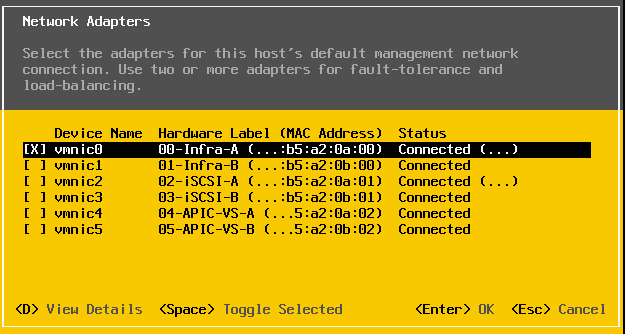
![]() In lab testing, examples have been seen where the vmnic and device ordering do not match. If this is the case, use the Consistent Device Naming (CDN) to note which vmnics are mapped to which vNICs and adjust the upcoming procedure accordingly.
In lab testing, examples have been seen where the vmnic and device ordering do not match. If this is the case, use the Consistent Device Naming (CDN) to note which vmnics are mapped to which vNICs and adjust the upcoming procedure accordingly.
10. Use the arrow keys and spacebar to highlight and select vmnic1.
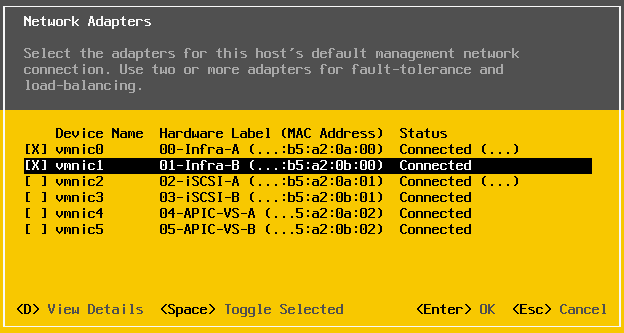
11. Press Enter.
12. Select the VLAN (Optional) option and press Enter.
13. Enter the UCS <ib-mgmt-vlan-id> <419> and press Enter.
14. Select IPv4 Configuration and press Enter.
15. Select the Set static IPv4 address and network configuration option by using the space bar.
16. Enter the IP address for managing the ESXi host.
17. Enter the subnet mask for the ESXi host.
18. Enter the default gateway for the ESXi host.
19. Press Enter to accept the changes to the IP configuration.
20. Select the DNS Configuration option and press Enter.
![]() Because the IP address is assigned manually, the DNS information must also be entered manually.
Because the IP address is assigned manually, the DNS information must also be entered manually.
21. Enter the IP address of the primary DNS server.
22. Optional: Enter the IP address of the secondary DNS server.
23. Enter the fully qualified domain name (FQDN) for the ESXi host.
24. Press Enter to accept the changes to the DNS configuration.
25. Press Esc to exit the Configure Management Network menu. Enter Y to Apply changes and restart management network.
26. Select Test Management Network to verify that the management network is set up correctly and press Enter.
27. Press Enter to run the test, press Enter again once the test has completed, review environment if there is a failure.
28. Re-select the Configure Management Network and press Enter.
29. Select the IPv6 Configuration option and press Enter.
30. Using the spacebar, select Disable IPv6 (restart required) and press Enter.
31. Press Esc to exit the Configure Management Network submenu.
32. Press Y to confirm the changes and reboot the ESXi host.
Log in to VMware ESXi Hosts by Using VMware Host Client
ESXi Host fpv-esxi-01
To log in to the fpv-esxi-01 ESXi host by using the VMware Host Client, complete the following steps:
1. Open a web browser on the management workstation and navigate to the fpv-esxi-01 management IP address. Respond to any security prompts.
2. Enter root for the user name.
3. Enter the root password.
4. Click Login to connect.
5. Repeat this process to log into fpv-esxi-02 in a separate browser tab or window.
Set Up VMkernel Ports and Virtual Switch
ESXi Host fpv-esxi-01 and fpv-esxi-02
To set up the VMkernel ports and the virtual switches on the ESXi hosts, complete the following steps:
1. From the Host Client, select Networking on the left.
2. In the center pane, select the Virtual switches tab.
3. Highlight vSwitch0.
4. Select Edit settings.
5. Change the MTU to 9000.
6. Expand NIC teaming and highlight vmnic1. Select Mark active.
7. Click Save.
8. Select Networking on the left.
9. In the center pane, select the Virtual switches tab.
10. Highlight iScsiBootvSwitch.
11. Select Edit settings.
12. Change the MTU to 9000
13. Click Save.
14. Select Add standard virtual switch.
15. Name the vSwitch iScsiBootvSwitch-B.
16. Set the MTU to 9000.
17. Select vmnic3 for the Uplink.
18. Click Add.
19. Select the VMkernel NICs tab.
20. Highlight vmk1 iScsiBootPG.
21. Select Edit settings.
22. Change the MTU to 9000.
23. Expand IPv4 settings and change the IP address to an address outside of the UCS iSCSI-IP-Pool-A.
![]() To avoid IP address conflicts if the Cisco UCS iSCSI IP Pool addresses should get reassigned, it is recommended to use different IP addresses in the same subnet for the iSCSI VMkernel ports.
To avoid IP address conflicts if the Cisco UCS iSCSI IP Pool addresses should get reassigned, it is recommended to use different IP addresses in the same subnet for the iSCSI VMkernel ports.
24. Click Save.
25. Select Add VMkernel NIC
26. Specify a New port group name of iScsiBootPG-B.
27. Select iScsciBootvSwitch-B for Virtual switch.
28. Set the MTU to 9000. Do not enter a VLAN ID since the iSCSI-B VLAN is also the native VLAN on this vNIC.
29. Select Static for the IPv4 settings and expand the option to provide the Address and Subnet Mask within the Configuration.
![]() To avoid IP address conflicts, if the Cisco UCS iSCSI IP Pool addresses should get reassigned, it is recommended to use different IP addresses in the same subnet for the iSCSI VMkernel ports.
To avoid IP address conflicts, if the Cisco UCS iSCSI IP Pool addresses should get reassigned, it is recommended to use different IP addresses in the same subnet for the iSCSI VMkernel ports.
30. Click Create.
31. Select Add VMkernel NIC.
32. Specify a New port group name of VMkernel-Infra-NFS.
33. Select vSwitch0 for Virtual switch.
34. Enter the UCS Foundation Tenant NFS VLAN id <3150>.
35. Set the MTU to 9000.
36. Select Static for the IPv4 settings and expand the option to provide the Address and Subnet Mask in the Foundation Tenant NFS subnet <192.168.50.0/24>.
37. Click Create.
38. Select Add VMkernel NIC
39. Specify a New port group name of VMkernel-vMotion.
40. Select vSwitch0 for Virtual switch.
41. Enter the UCS vMotion VLAN id <3000>.
42. Set the MTU to 9000.
43. Select Static for the IPv4 settings and expand the option to provide the Address and Subnet Mask in the vMotion subnet <192.168.100.0/24>.
44. Select the vMotion stack for the TCP/IP stack.
45. Click Create.
46. Optionally, if you have 40GE vNICs in this FlexPod, create two more vMotion VMkernel ports in the same subnet and VLAN. These will need to be in new port groups.
47. On the left, select Networking, then select the Port groups tab.
48. In the center pane, right-click VM Network and select Remove.
49. Click Remove to complete removing the port group.
50. In the center pane, select Add port group.
51. Name the port group IB-MGMT Network, enter <ib-mgmt-vlan-id> <419> in the VLAN ID field, and make sure Virtual switch vSwitch0 is selected.
52. Click Add to finalize the edits for the IB-MGMT Network.
53. In the center pane, select Add port group.
54. Name the port group Core-Services Network, enter <core-services-vlan-id> <318> in the VLAN ID field, and make sure Virtual switch vSwitch0 is selected.
55. Click Add to finalize the edits for the Core-Services Network.
56. Highlight the VMkernel-vMotion Port group and select Edit settings.
57. Expand NIC teaming and select the radio button next to Override failover order.
58. Select vmnic0 and then select Mark standby to pin vMotion traffic to UCS Fabric Interconnect B (vmnic1) with failover.
59. Click Save.
60. Repeat steps 56-59 to pin all vMotion traffic to UCS Fabric Interconnect B (vmnic1) with failover.
61. Select the Virtual Switches tab, then vSwitch0. The properties for vSwitch0 VMkernel NICs should be similar to the following example:
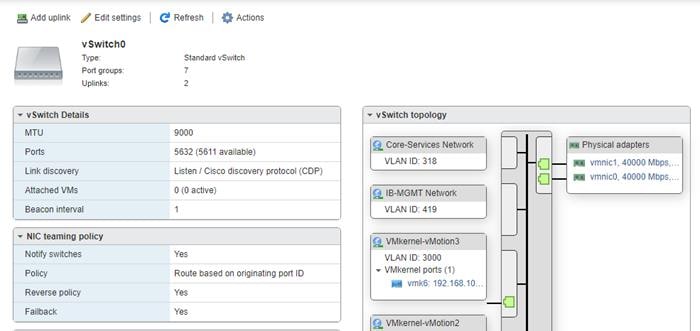
62. Select the VMkernel NICs tab to confirm configured virtual adapters. The adapters listed should be similar to the following example:

Setup iSCSI Multipathing
ESXi Hosts fpv-esxi-01 and fpv-esxi-02
To setup the iSCSI multipathing on the ESXi host fpv-esxi-01 and fpv-esxi-02, complete the following steps:
1. From each Host Client, select Storage on the left.
2. In the center pane, click Adapters.
3. Select the iSCSI software adapter and click Configure iSCSI.
4. Under Dynamic targets, click Add dynamic target.
5. Enter the IP Address of NetApp storage iscsi_lif01a and press Enter.
6. Repeat putting the ip address of iscsi_lif01b, iscsi_lif02a, iscsi_lif02b.
7. Click Save configuration.
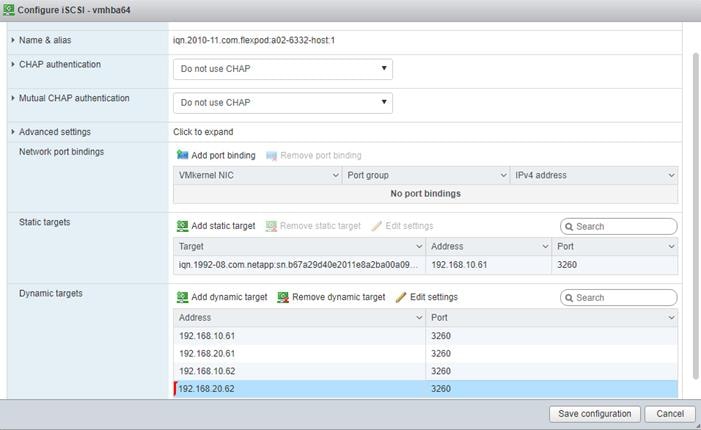
![]() To get all the iscsi_lif IP addresses, login to NetApp storage cluster management interface and type “network interface show.”
To get all the iscsi_lif IP addresses, login to NetApp storage cluster management interface and type “network interface show.”
![]() The host will automatically rescan the storage adapter and 4 targets will be added to Static targets. This can be verified by selecting Configure iSCSI again.
The host will automatically rescan the storage adapter and 4 targets will be added to Static targets. This can be verified by selecting Configure iSCSI again.
Mount Required Datastores
ESXi Hosts fpv-esxi-01 and fpv-esxi-02
To mount the required datastores, complete the following steps on each ESXi host:
1. From the Host Client, select Storage on the left.
2. In the center pane, select the Datastores tab.
3. In the center pane, select New Datastore to add a new datastore.
4. In the New datastore popup, select Mount NFS datastore and click Next.
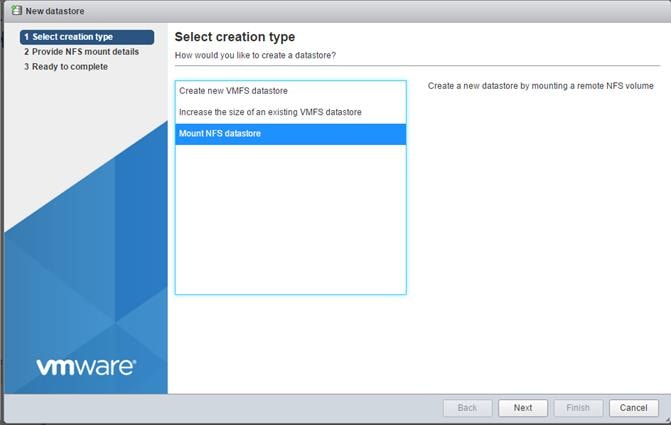
5. Input infra_datastore_1 for the datastore name. Input the IP address for the nfs_lif01 LIF for the NFS server. Input /infra_datastore_1 for the NFS share. Leave the NFS version set at NFS 3. Click Next.
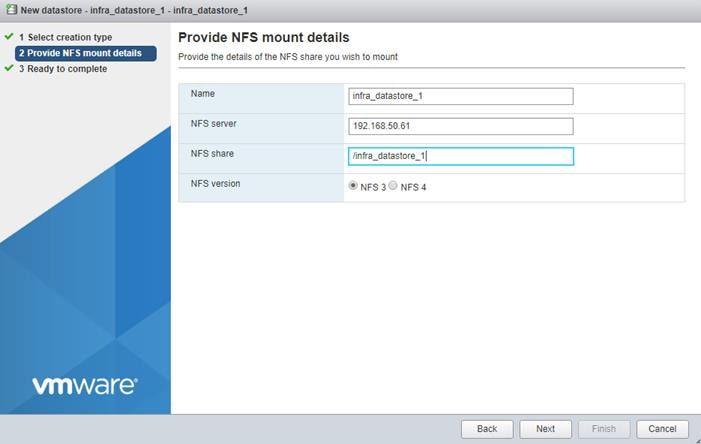
6. Click Finish. The datastore should now appear in the datastore list.
7. In the center pane, select New Datastore to add a new datastore.
8. In the New datastore popup, select Mount NFS datastore and click Next.
9. Input infra_datastore_2 for the datastore name. Input the IP address for the nfs_lif02 LIF for the NFS server. Input /infra_datastore_2 for the NFS share. Leave the NFS version set at NFS 3. Click Next.
10. Click Finish. The datastore should now appear in the datastore list.

11. Mount both datastores on both ESXi hosts.
Configure NTP on ESXi Hosts
ESXi Hosts fpv-esxi-01 and fpv-esxi-02
To configure Network Time Protocol (NTP) on the ESXi hosts, complete the following steps on each host:
1. From the Host Client, select Manage on the left.
2. In the center pane, select the Time & Date tab.
3. Click Edit settings.
4. Make sure Use Network Time Protocol (enable NTP client) is selected.
5. Use the drop-down list to select Start and stop with host.
6. Enter the two ACI leaf switch management and NTP addresses in the NTP servers box separated by a comma.
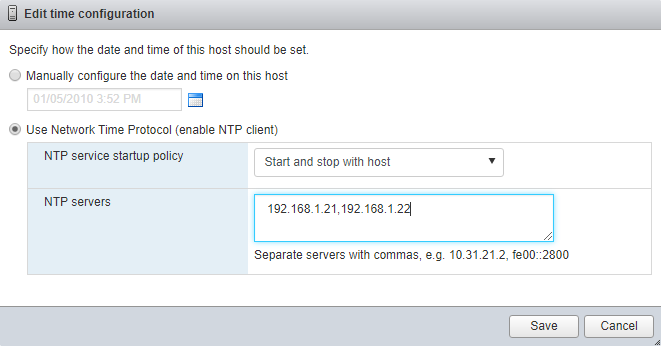
7. Click Save to save the configuration changes.
8. Select Actions > NTP service > Start.
9. Verify that NTP service is now running and the clock is now set to approximately the correct time.
![]() The NTP server time may vary slightly from the host time.
The NTP server time may vary slightly from the host time.
Install VMware ESXi Patches and Drivers
ESXi Hosts fpv-esxi-01 and fpv-esxi-02
To install necessary ESXi patches and updated device drivers, complete the following steps on each host:
1. Download VMware ESXi patch ESXi650-201712001 from https://my.vmware.com/group/vmware/patch#search.
2. Download the Cisco UCS VIC nenic driver version 1.0.13.0 from https://my.vmware.com/web/vmware/details?downloadGroup=DT-ESXI65-CISCO-NENIC-10130&productId=614. Extract the offline_bundle.zip file from the download.
3. Download the Cisco UCS VIC fnic driver version 1.6.0.36 from https://my.vmware.com/web/vmware/details?downloadGroup=DT-ESX60-CISCO-FNIC-16036&productId=491. Extract the offline_bundle.zip file from the download.
4. Download the NetApp NFS Plug-in for VMware VAAI 1.1.2 offline bundle from https://mysupport.netapp.com/NOW/download/software/nfs_plugin_vaai_esxi5.5/1.1.2/.
5. From the Host Client, select Storage on the left.
6. In the center pane, select infra_datastore_1 and then select Datastore browser.
7. In the Datastore browser, select Create directory and create a Drivers folder in the datastore.
8. Select the Drivers folder.
9. Use Upload to upload the four downloaded items above to the Drivers folder on infra_datastore_1. Since infra_datastore_1 is accessible to both ESXi hosts, this upload only needs to be done on the first host.
10. Use ssh to connect to each ESXi host as the root user.
11. Enter the following commands on each host.
cd /vmfs/volumes/infra_datastore_1/Drivers
ls
esxcli software vib update -d /vmfs/volumes/infra_datastore_1/Drivers/ESXi650-201712001.zip
esxcli software vib update -d /vmfs/volumes/infra_datastore_1/Drivers/VMW-ESX-6.5.0-nenic-1.0.13.0-offline_bundle-7098243.zip
esxcli software vib update -d /vmfs/volumes/infra_datastore_1/Drivers/fnic_driver_1.6.0.36-offline_bundle-6806699.zip
esxcli software vib install -d /vmfs/volumes/infra_datastore_1/Drivers/NetAppNasPlugin.v23.zip
reboot
VMware vCenter 6.5 Update 1
The procedures in the following subsections provide detailed instructions for installing the VMware vCenter 6.5 Update 1 Server Appliance in an environment. After the procedures are completed, a VMware vCenter Server will be configured.
Building the VMware vCenter Server Appliance
The VCSA deployment consists of 2 stages: install and configuration. To build the VMware vCenter virtual machine, complete the following steps:
1. Locate and copy the VMware-VCSA-all-6.5.0-7515524.iso file to the desktop of the management workstation. This ISO is for the VMware vSphere 6.5 vCenter Server Appliance.
2. Using ISO mounting software, mount the ISO image as a disk on the management workstation. (For example, with the Mount command in Windows Server 2012).
3. In the mounted disk directory, navigate to the vcsa-ui-installer > win32 directory and double-click installer.exe. The vCenter Server Appliance Installer wizard appears.
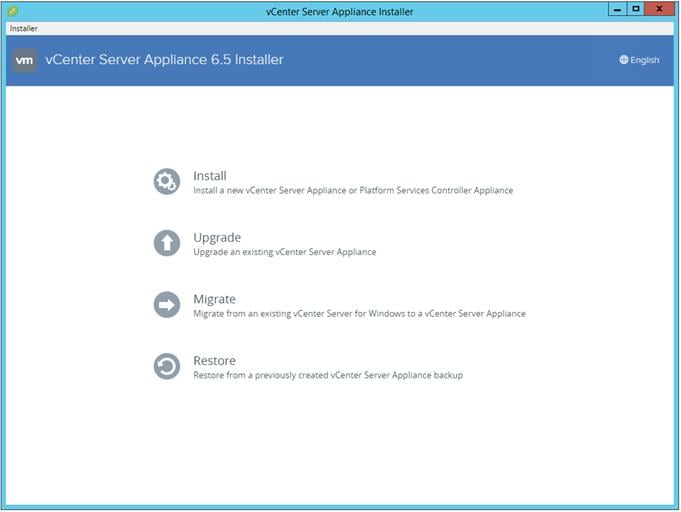
4. Click Install to start the vCenter Server Appliance deployment wizard.
5. Click Next in the Introduction section.
6. Read and accept the license agreement and click Next.

7. In the “Select deployment type” section, select vCenter Server with an Embedded Platform Services Controller and click Next.
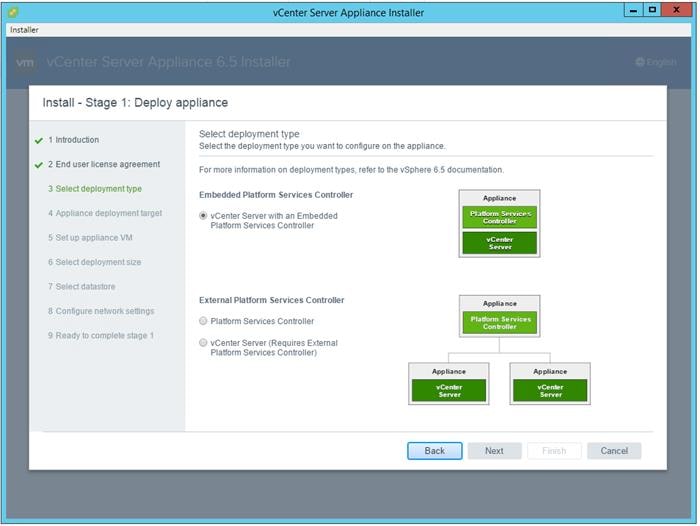
8. In the “Appliance deployment target”, enter the ESXi host name or IP address for fpv-esxi-01, User name and Password. Click Next.
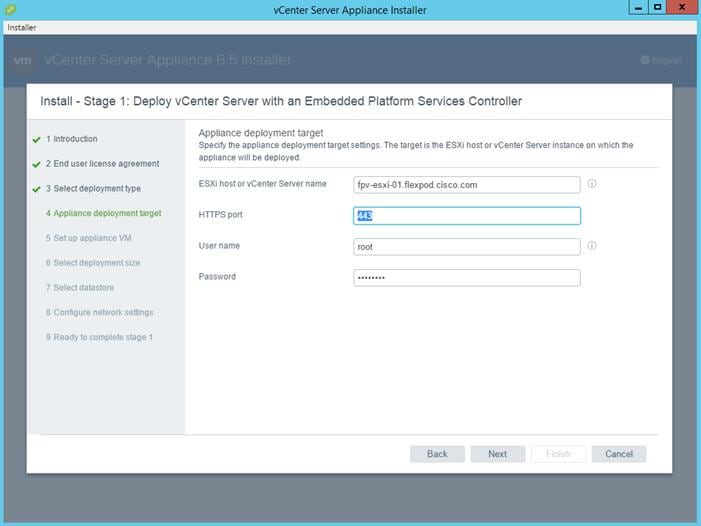
9. Click Yes to accept the certificate.
10. Enter the Appliance name and password details in the “Set up appliance VM” section. Click Next.
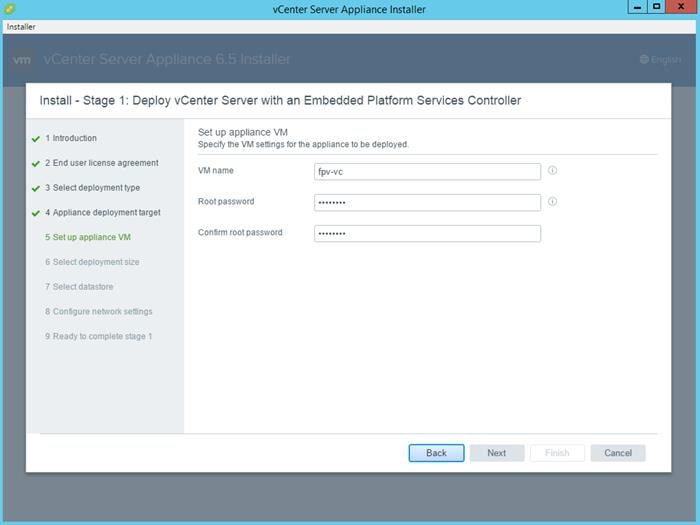
11. In the “Select deployment size” section, Select the deployment size and Storage size. For example, “Small.”
12. Click Next.
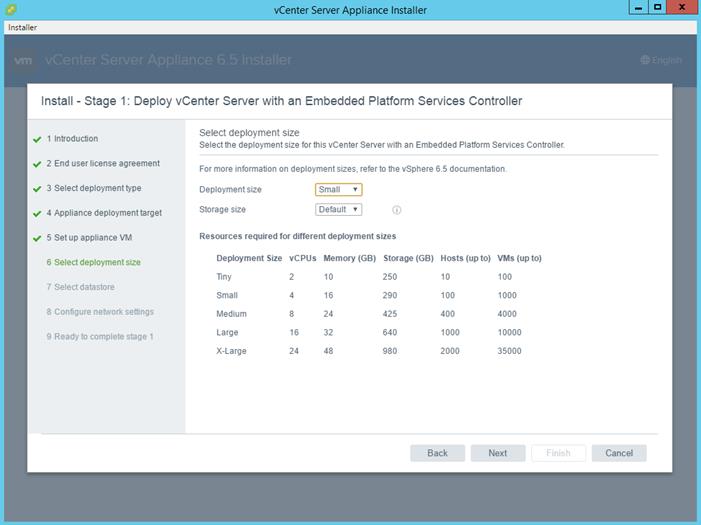
13. Select the infra_datastore_2. Click Next.
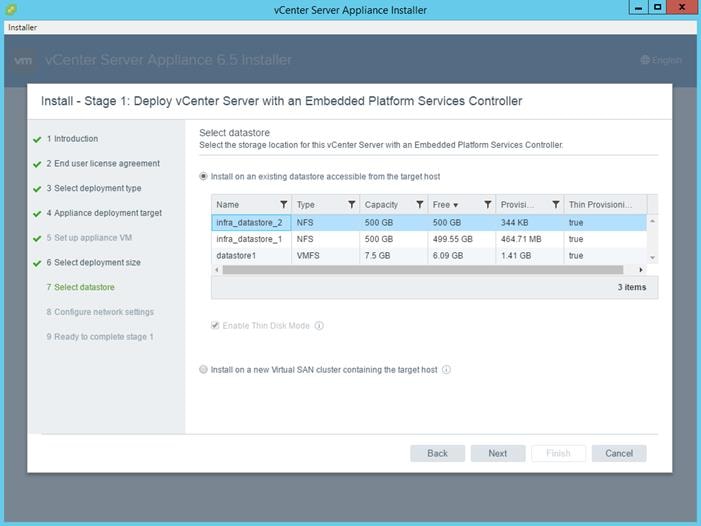
14. In the “Network Settings” section, configure the following settings:
a. Choose a Network: Core-Services Network
b. IP version: IPV4
c. IP assignment: static
d. System name: <vcenter-fqdn>
e. IP address: <vcenter-ip>
f. Subnet mask or prefix length: <vcenter-subnet-mask>
g. Default gateway: <vcenter-gateway>
h. DNS Servers: <dns-server>
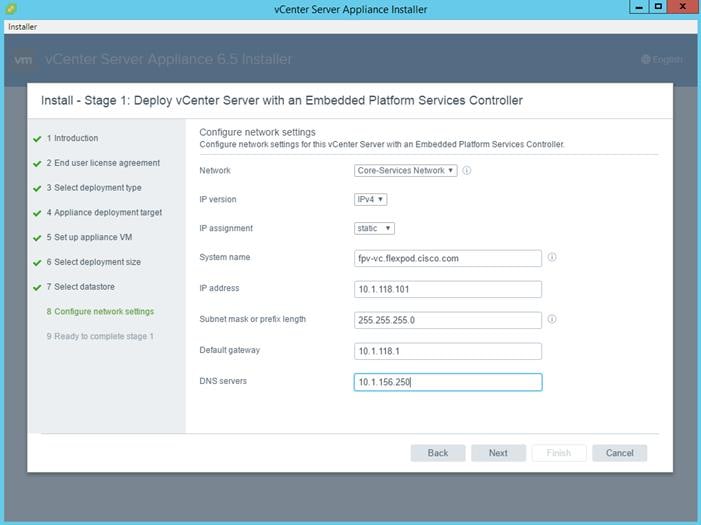
15. Click Next.
16. Review all values and click Finish to complete the installation.
17. The vCenter appliance installation will take a few minutes to complete.
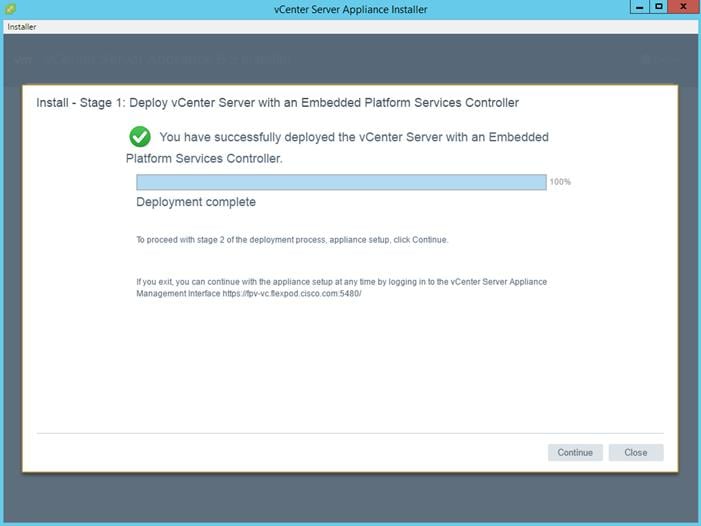
18. Click Continue to proceed with stage 2 configuration.
19. Click Next.
20. In the Appliance Configuration, configure the below settings:
a. Time Synchronization Mode: Synchronize time with NTP servers.
b. NTP Servers: <leaf-a-ntp-ip>, <leaf-b-ntp-ip>
c. SSH access: Enabled.
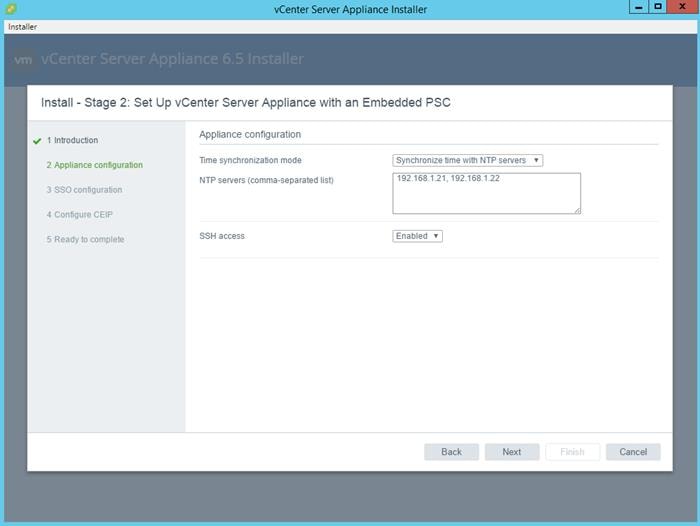
21. Click Next.
22. Complete the SSO configuration as shown below.
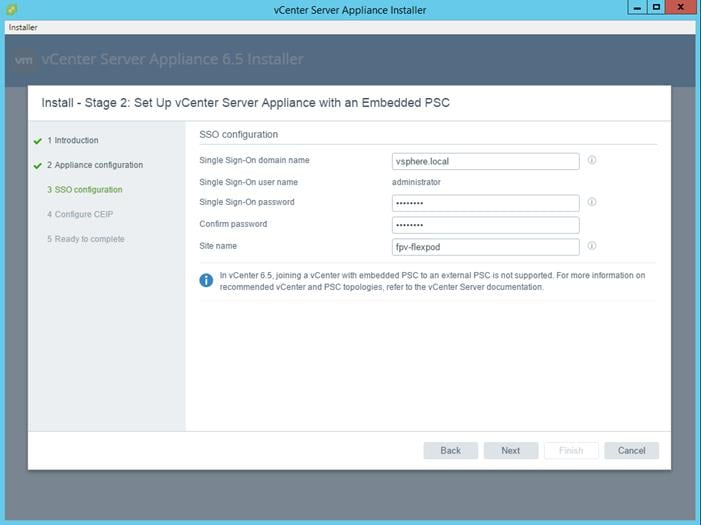
23. Click Next.
24. If needed, select Join the VMware’s Customer Experience Improvement Program (CEIP).
25. Click Next.
26. Review the configuration and click Finish.
27. Click OK.
28. Click Close.
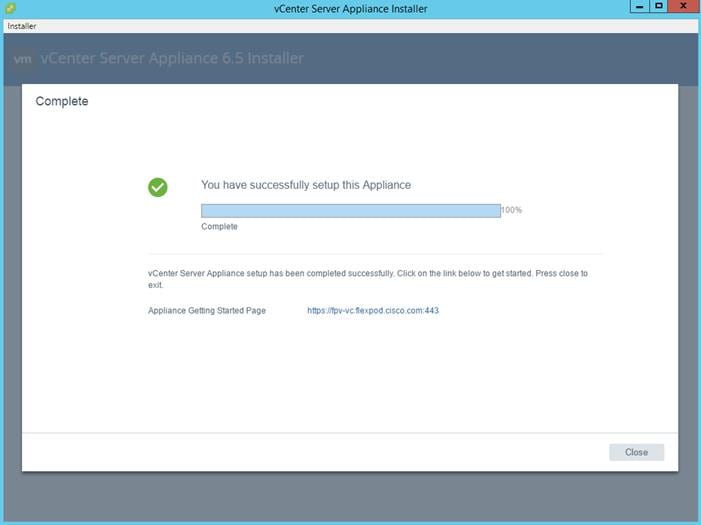
Setting Up VMware vCenter Server
To set up the VMware vCenter Server, complete the following steps:
1. Using a web browser, navigate to https://<vcenter-ip>/vsphere-client.
2. Log in using the Single Sign-On username (Administrator@vsphere.local) and password created during the vCenter installation.
3. Click “Create Datacenter” in the center pane.
4. Type a name for the FlexPod Datacenter <FPV-FlexPod-DC> in the Datacenter name field.
5. Click OK.
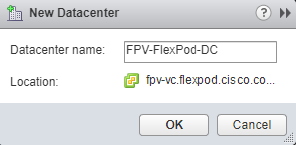
6. Right-click the data center just created and select New Cluster.
7. Name the cluster FPV-Foundation.
8. Check the box to turn on DRS. Leave the default values.
9. Check the box to turn on vSphere HA. Leave the default values.
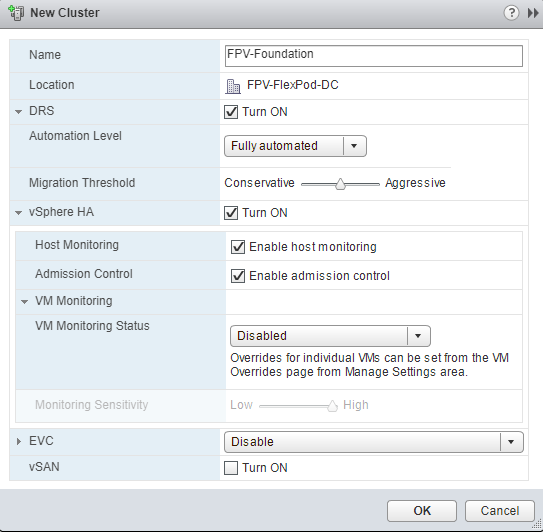
10. Click OK to create the new cluster.
11. On the left pane, expand the Datacenter.
12. Right click the FPV-Foundation cluster and select Add Host.
13. In the Host field, enter either the IP address or the FQDN name of one of the VMware ESXi hosts. Click Next.
14. Type root as the user name and the root password. Click Next to continue.
15. Click Yes to accept the certificate.
16. Review the host details and click Next to continue.
17. Assign a license or leave in evaluation mode and click Next to continue.
18. Click Next to continue.
19. Click Next to continue.
20. Review the configuration parameters. Click Finish to add the host.
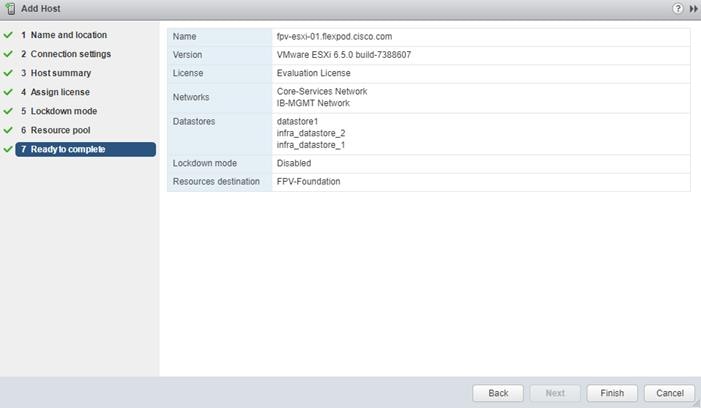
21. Repeat the steps 12 to 20 to add the remaining VMware ESXi hosts to the cluster.
![]() Two VMware ESXi hosts are added to the cluster.
Two VMware ESXi hosts are added to the cluster.
Add AD User Authentication to vCenter (Optional)
If an AD Infrastructure is set up in this FlexPod environment, you can setup in AD and authenticate from vCenter.
1. In the AD Infrastructure, using the Active Directory Users and Computers tool, setup a Domain Administrator user with a user name such as flexadmin (FlexPod Admin).
2. Connect to https://<vcenter-ip>, and select Log in to vSphere Web Client.
3. Log in as Administrator@vsphere.local (or the SSO user set up in vCenter installation) with the corresponding password.
4. Navigate to Home. In the center pane, select System Configuration under Administration.
5. On the left, select Nodes and under Nodes select the vCenter.
6. In the center pane, select the manage tab, and within the Settings select Active Directory and click Join.
7. Fill in the AD domain name, the Administrator user, and the domain Administrator password. Click OK.
8. On the left, right-click the vCenter and select Reboot.
9. Input a reboot reason and click OK. The reboot will take approximately 10 minutes for full vCenter initialization.
10. Log back into the vCenter Web Client.
11. In the center pane, select System Configuration under Administration.
12. On the left, select Nodes and under Nodes select the vCenter.
13. In the center pane under the Manage tab, select Active Directory. Make sure your Active Directory Domain is listed.
14. Navigate back to the vCenter Home.
15. In the center pane under Administration, select Roles.
16. On the left under Single Sign-On, select Configuration.
17. In the center pane, select the Identity Sources tab.
18. Click the green + sign to add an Identity Source.
19. Select the Active Directory (Integrated Windows Authentication) Identity source type and click Next.
20. Your AD domain name should be filled in. Leave Use machine account selected and click Next.
21. Click Finish to complete adding the AD domain as an Identity Source.
22. Your AD domain should now appear in the Identity Sources list.
23. On the left, under Single Sign-On, select Users and Groups.
24. In the center pane, select your AD domain for the Domain.
25. Make sure the FlexPod Admin user setup in step 1 appears in the list.
26. On the left under Administration, select Global Permissions.
27. Select the Manage tab, and click the green + sign to add a User or Group.
28. In the Global Permission Root - Add Permission window, click Add.
29. In the Select Users/Groups window, select your AD Domain.
30. Under Users and Groups, select either the FlexPod Admin user or the Domain Admins group.
![]() The FlexPod Admin user was created in the Domain Admins group. The selection here depends on whether the FlexPod Admin user will be the only user used in this FlexPod or you would like to add other users later. By selecting the Domain Admins group, any user placed in that group in the AD domain will be able to login to vCenter as an Administrator.
The FlexPod Admin user was created in the Domain Admins group. The selection here depends on whether the FlexPod Admin user will be the only user used in this FlexPod or you would like to add other users later. By selecting the Domain Admins group, any user placed in that group in the AD domain will be able to login to vCenter as an Administrator.
31. Click Add. Click Check names to verify correctness of the names. Click OK to acknowledge the correctness of the names.
32. Click OK to add the selected User or Group.
33. Verify the added User or Group is listed under Users and Groups and the Administrator role is assigned.
34. Log out and log back into the vCenter Web Client as the FlexPod Admin user. You will need to add the domain name to the user, for example flexadmin@domain.
ESXi Dump Collector setup for iSCSI-Booted Hosts
ESXi hosts booted with iSCSI using the VMware iSCSI software initiator need to be configured to do core dumps to the ESXi Dump Collector that is part of vCenter. The Dump Collector is not enabled by default on the vCenter Appliance. To setup the ESXi Dump Collector, complete the following steps:
1. Log into the vSphere web client as Administrator@vsphere.local.
2. In the vSphere web client, select Home.
3. In the center pane, click System Configuration.
4. In the left pane, select Services.
5. Under services, click VMware vSphere ESXi Dump Collector.
6. In the center pane, click the green start icon to start the service.
7. In the Actions menu, click Edit Startup Type.
8. Select Automatic.
9. Click OK.
10. Connect to each ESXi host via ssh as root
11. Run the following commands:
esxcli system coredump network set –v vmk0 –j <vcenter-ip>
esxcli system coredump network set –e true
esxcli system coredump network check
Add APIC-Integrated vSphere Distributed Switch (vDS)
The APIC-Integrated vDS is an integration between the Cisco ACI fabric and VMware allowing EPGs to be created in the ACI fabric and pushed into the vDS as port groups. The Virtual Machine Manager (VMM) domain in the APIC is configured with a pool of VLANs (100 in this validation) that are used as EPGs are assigned as port groups by associating the VMM domain with the EPG. These VLANs are already assigned to the UCS server vNICs and piped through Cisco UCS.
Create Virtual Machine Manager (VMM) Domain in APIC
APIC GUI
1. In the APIC GUI, select Virtual Networking > Inventory.
2. On the left, expand VMM Domains > VMware.
3. Right-click VMware and select Create vCenter Domain.
4. Name the Virtual Switch fpv-vc-vDS. Leave VMware vSphere Distributed Switch selected.
5. Select the UCS_AttEntityP Associated Attachable Entity Profile.
6. Under VLAN Pool, select Create VLAN Pool.
7. Name the VLAN Pool VP-fpv-vc-vDS. Leave Dynamic Allocation selected.
8. Click the “+” to add a block of VLANs to the pool.
9. Enter the VLAN range <1100-1199> and click OK.
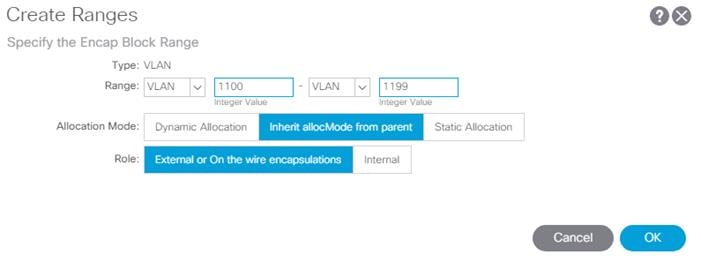
10. Click Submit to complete creating the VLAN Pool.
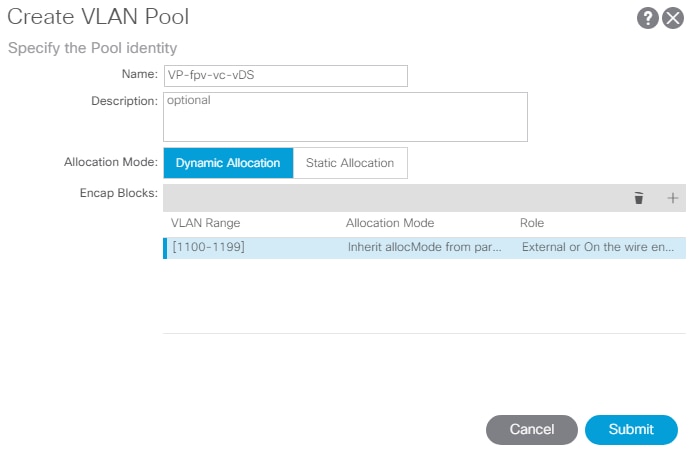
11. Click the “+” to the right of vCenter Credentials to add credentials for the vCenter.
12. For name, enter the vCenter hostname <fpv-vc>. For the username and password, the FlexPod Admin AD account created above can be used.
13. Click OK to complete creating the vCenter credentials.
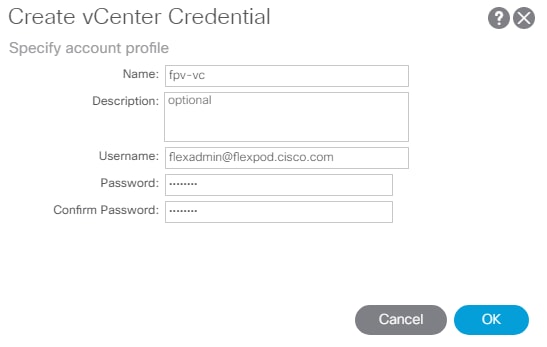
14. Click the “+” to the right of vCenter to add the vCenter linkage.
15. Enter the vCenter hostname for Name. Enter the vCenter FQDN or IP address.
16. Select DVS Version 6.5. Enable Stats Collection.
17. For Datacenter, enter the exact Datacenter name specified in vCenter.
18. Do not select a Management EPG.
19. For Associated Credential, select the vCenter credentials entered in step 13.
20. Click OK to complete the vCenter linkage.
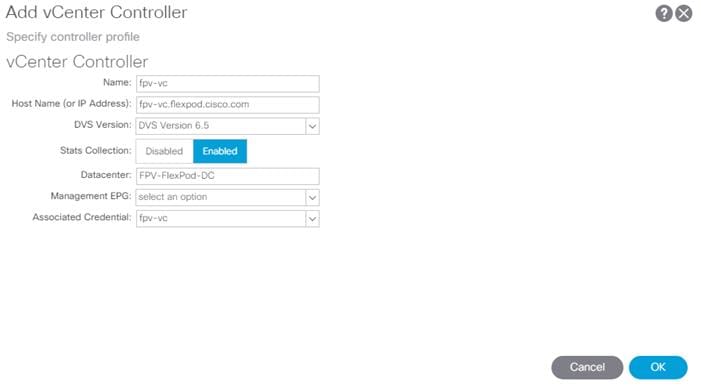
21. For Port Channel Mode, select MAC Pinning-Physical-NIC-load.
22. For vSwitch Policy, select LLDP.
23. Click Submit to complete Creating the vCenter Domain.
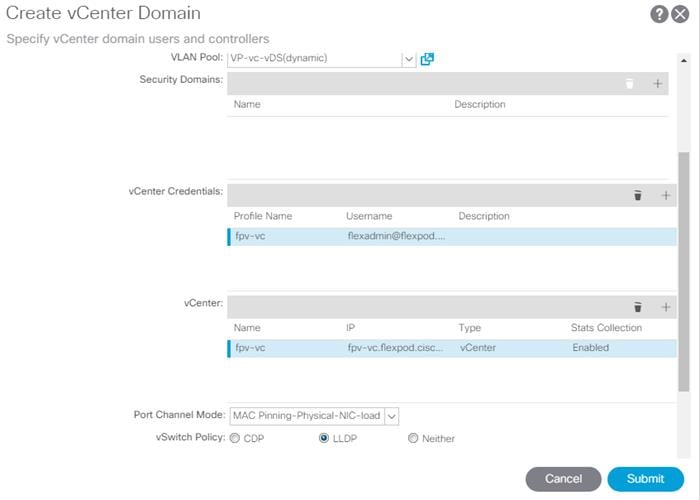
![]() The vDS should now appear in vCenter.
The vDS should now appear in vCenter.
24. In the APIC GUI, select Tenants > common.
25. Under Tenant common, expand Application Profiles > Core-Services > Application EPGs > Core-Services.
26. Under the Core-Services EPG, right-click Domains and select Add VMM Domain Association.
27. Use the drop-down list to select the fpv-vc-vDS VMM Domain Profile. Select Immediate Deploy Immediacy and change no other values. Click Submit to create the Core-Services port group in the vDS.
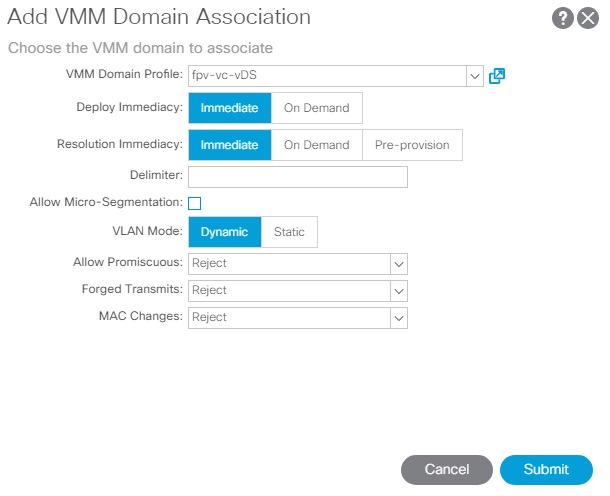
28. Repeat steps 24-27 to add the VMM Domain Association to the IB-MGMT EPG in Tenant FPV-Foundation.
Add Management ESXi Hosts to APIC-Integrated vDS
vSphere Web Client
1. Log into the vCenter vSphere Web Client as the FlexPod Admin user.
2. Under the Navigator on the left, select the Networking icon.
3. Expand the vCenter, Datacenter, and vDS folder. Right-click the vDS and select Add and Manage Hosts.
4. Select Add hosts and click Next.
5. Click the ![]() to add New hosts.
to add New hosts.
6. Select both hosts and click OK.
7. Click Next.
8. Select only Manage physical adapters and click Next.
9. On both hosts, assign vmnic4 as uplink1 and vmnic 5 as uplink2. Click Next.
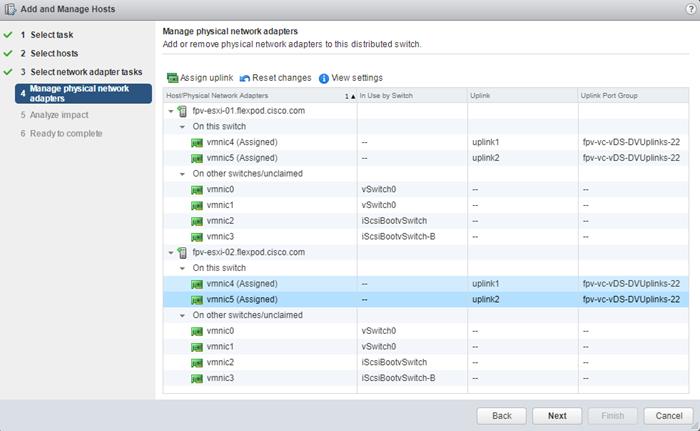
10. Click Next and Finish to complete adding the two Management hosts to the vDS. VMs can now be assigned to the Core-Services and IB-MGMT port groups in the vDS.
![]() It is not recommended to assign the vCenter VM to the Core-Services port group in the vDS or to migrate the management hosts’ Infrastructure NFS VMkernel ports to the vDS.
It is not recommended to assign the vCenter VM to the Core-Services port group in the vDS or to migrate the management hosts’ Infrastructure NFS VMkernel ports to the vDS.
Cisco ACI vCenter Plug-in
The Cisco ACI vCenter plug-in is a user interface that allows you to manage the ACI fabric from within the vSphere Web client. This allows the VMware vSphere Web Client to become a single pane of glass to configure both VMware vCenter and the ACI fabric. The Cisco ACI vCenter plug-in empowers virtualization administrators to define network connectivity independently of the networking team while sharing the same infrastructure. No configuration of in-depth networking is done through the Cisco ACI vCenter plug-in. Only the elements that are relevant to virtualization administrators are exposed.
Cisco ACI vCenter Plug-in Installation
To begin the plug-in installation on a Windows system, complete the following steps:
![]() To complete the installation of the ACI vCenter Plug-in, VMware PowerCLI 6.5 Release 1 must be installed on the Windows administration workstation. VMware PowerCLI 6.5 Release 1 can be downloaded from https://my.vmware.com/group/vmware/details?downloadGroup=PCLI650R1&productId=614.
To complete the installation of the ACI vCenter Plug-in, VMware PowerCLI 6.5 Release 1 must be installed on the Windows administration workstation. VMware PowerCLI 6.5 Release 1 can be downloaded from https://my.vmware.com/group/vmware/details?downloadGroup=PCLI650R1&productId=614.
1. Connect to: https://<apic-ip>/vcplugin.
2. Follow the Installation instructions on that web page to complete plug-in installation.
3. Logout and log back into the vSphere Web Client.
4. Select Home. The Cisco ACI Fabric plugin should be available under Inventories.
5. Select the Cisco ACI Fabric plugin.
6. In the center pane, select Connect vSphere to your ACI Fabric.
7. Click Yes to add a new ACI Fabric.
8. Enter one APIC IP address or FQDN and uncheck Use Certificate.
9. Enter the admin Username and Password. Click OK.
10. Click OK to confirm the addition of the other APICs.
Cisco UCS Manager Plug-in for VMware vSphere Web Client
The Cisco UCS Manager Plug-in for VMware vSphere Web Client allows administration of Cisco UCS domains through the VMware’s vCenter administrative interface. Capabilities of the plug-in include:
· View Cisco UCS physical hierarchy
· View inventory, installed firmware, faults, power and temperature statistics
· Map the ESXi host to the physical server
· Manage firmware for B and C series servers
· View VIF paths for servers
· Launch the Cisco UCS Manager GUI
· Launch the KVM consoles of UCS servers
· Switch the existing state of the locator LEDs
Installation is only valid for VMware vCenter 5.5 or higher, and will require revisions of .NET Framework 4.5 and VMware PowerCLI 5.1 or greater (installed above).
Cisco UCS Manager Plug-in Installation
To begin the plug-in installation on a Windows system that meets the previously stated requirements:
1. Download the plugin and registration tool from: https://software.cisco.com/download/release.html?mdfid=286282669&catid=282558030&softwareid=286282010&release=2.0.3&relind=AVAILABLE&rellifecycle=&reltype=latest.
2. Place the downloaded ucs-vcplugin-2.0.3.zip file onto the web server used for hosting the ONTAP software and VMware ESXi ISO.
3. Unzip the Cisco_UCS_Plugin_Registration_Tool_1_1_3.zip and open the executable file within it.
4. Leave Register Plugin selected for the Action, and fill in:
- IP/Hostname
- Username
- Password
- URL that plugin has been uploaded
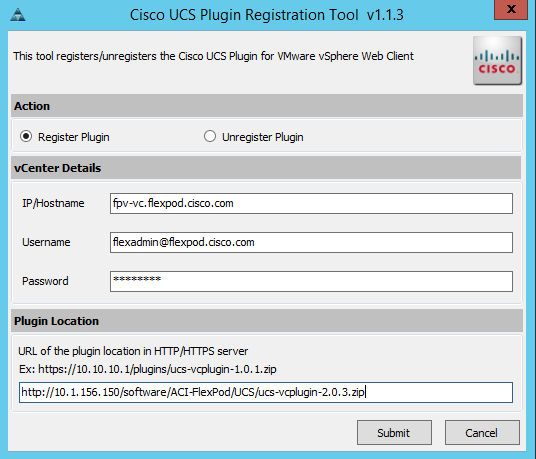
5. Click Submit. A pop-up will appear explaining that ‘allowHttp=true’ will need to be added to the webclient.properties file on the VCSA in the /etc/vmware/vsphere-client directory.
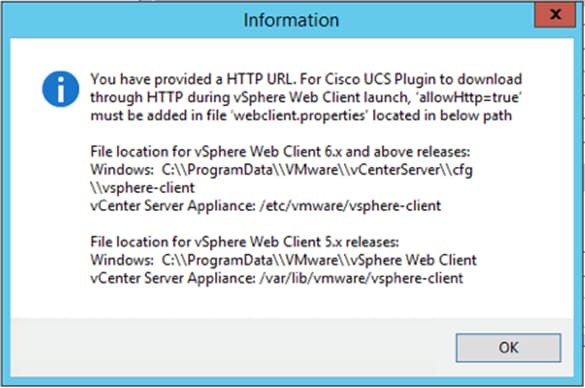
6. Take care of this issue after the plugin has been registered, click OK to close the Information dialogue box.
7. Click OK on the confirmation message. Then click Cancel to close the registration tool.
8. To resolve the change needed for the HTTP download of the vSphere Web Client launch, connect to the VCSA with ssh using the root account and type:
echo “allowHttp=true” >> /etc/vmware/vsphere-client/webclient.properties
![]() This will add “allowHttp=true” to the end of the webclient.properties file. Take care with this command to use two greater than symbols “>>” to append to the end of the configuration file, a single greater than symbol will replace the entire pre-existing file with what has been sent with the echo command.
This will add “allowHttp=true” to the end of the webclient.properties file. Take care with this command to use two greater than symbols “>>” to append to the end of the configuration file, a single greater than symbol will replace the entire pre-existing file with what has been sent with the echo command.
9. Reboot the VCSA.
Cisco UCS Domain Registration
Registration of the FlexPod UCS Domain can now be performed. The account used will correlate to the permissions allowed to the plugin, admin will be used in our example, but a read only account could be used with the plugin if that was appropriate for the environment.
To register the Cisco UCS Domain, complete the following steps::
1. Login to the vSphere Web Client with the FlexPod Admin user id.
2. Select Home from the Navigator or pull-down options, and click the Cisco UCS icon appearing in the Administration section.
3. Click the Register button and provide the following options in the Register UCS Domain dialogue box that appears:
- UCS Hostname/IP
- Username
- Password
- Port (if different than 443)
- Leave SSL selected and click the Visible to All users option
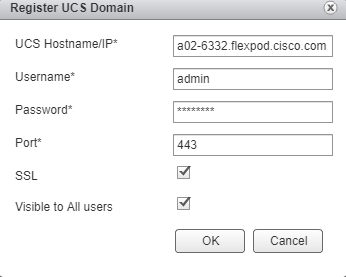
4. Click OK to register the UCS Domain.
Using the Cisco UCS vCenter Plugin
The plugin can now enable the functions described at the start of this section by double-clicking the registered Cisco UCS Domain:
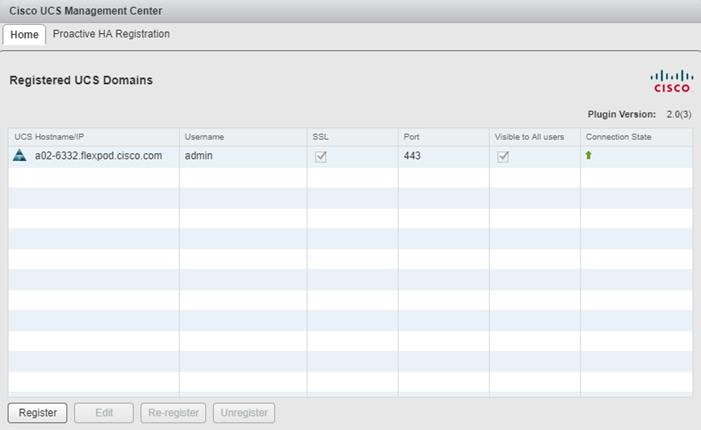
This will display a view of the components associated to the domain:
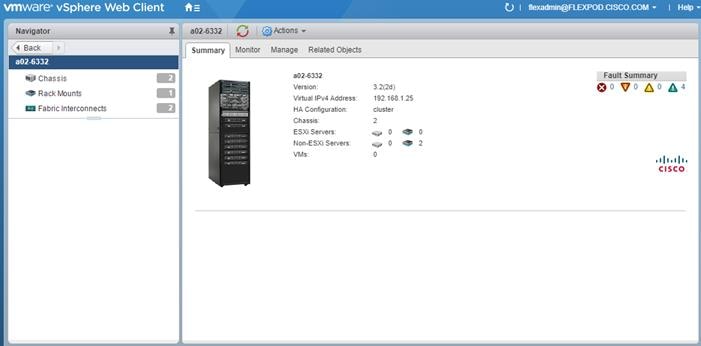
Selecting within the chassis or rack mounts will provide you with a list of ESXi or non-ESXi servers to perform operations:
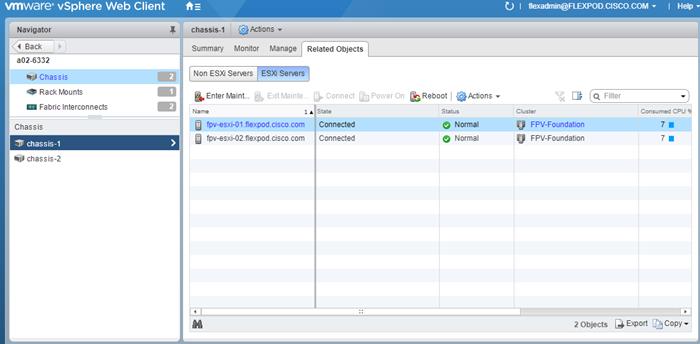
In addition to viewing and working within objects shown in the Cisco UCS Plugin’s view of the Cisco UCS Domain, direct access of Cisco UCS functions provided by the plugin can be selected within the drop-down list options of hosts registered to vCenter:
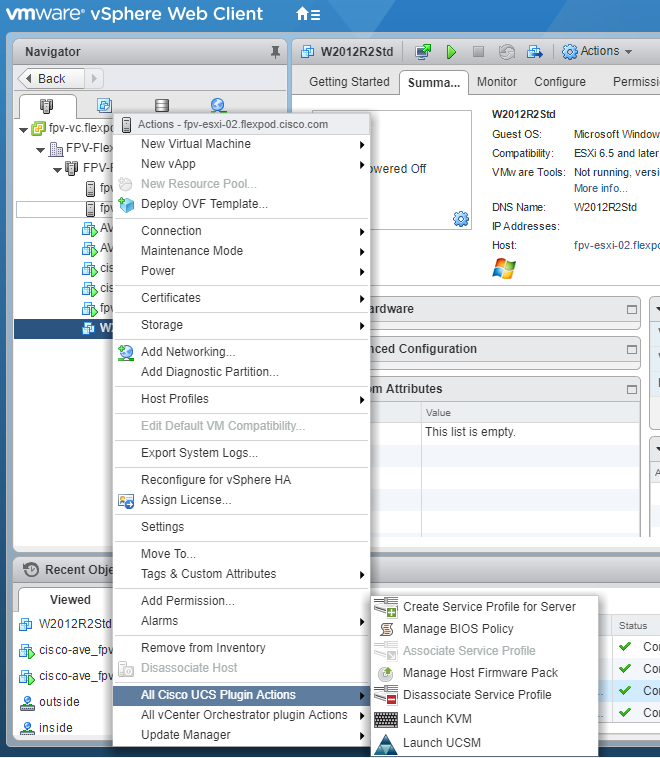
For the installation instructions and usage information, please refer to the Cisco UCS Manager Plug-in for VMware vSphere Web Client User Guide.
Build a Windows Server 2016 Virtual Machine for Cloning
A Windows Server 2016 virtual machine can be built in the VMware environment and cloned to create other virtual machines for management and tenant functions.
1. In the VMware vSphere Web Client, build a virtual machine named Win2016-DC-GUI, in one of the NFS datastores, compatible with ESXi6.5 and later, with Microsoft Windows Server 2016, and the following hardware:
- 2 CPUs
- 4096 MB Memory
- 120 GB, Thin Provisioned Hard Disk
- VMXNET 3 Network Adapter on the IB-MGMT Port Group on the vDS
2. Edit the settings of the VM and enable the Force BIOS setup VM option.
3. Boot the VM and open a console Window. Map a Windows Server 2016 installation iso to the CD drive. Set the BIOS boot order to Boot from CD-ROM Drive before Hard Drive. Save and Exit the BIOS.
4. Install Windows Server 2016 Datacenter with Desktop Experience on the VM, assign it an IP address and hostname, do not join the VM to the Windows Domain, and install all Windows Updates on the VM.
5. Shut down the VM.
Build Windows Active Directory Servers for ACI Fabric Core Services
Two Windows Server 2016 virtual machines will be cloned from the Win2016-DC-GUI VM and provisioned as Active Directory (AD) Domain Controllers in the existing AD Domain.
1. Create two clones of the Win2016-DC-GUI VM connected to the Core-Services EPG in ACI tenant common by right-clicking the Win2016-DC-GUI VM in vCenter and selecting Clone > Clone to Virtual Machine. Place one of these VMs in infra_datastore_1 on fpv-esxi-01 and the other in infra_datastore_2 on fpv-esxi-02.
2. Boot each clone and sysprep it. Then assign the VM an IP address and hostname. Do not join the VM to the AD domain.
3. Install Active Directory Domain Services on each VM and make it a Domain Controller and DNS server in the AD domain. Ensure the DNS server Forwarders are set correctly.
4. Add a persistent route to each VM to route to the tenant IP address space (172.16.0.0/16 in this validation) through the Core-Services EPG gateway address (10.1.118.254):
route ADD –p 172.16.0.0 MASK 255.255.0.0 10.1.118.254
route print
5. Reset the DNS in all existing VMs, servers, and hardware components to point to the two just-created DNS servers.
6. The two new AD servers can be placed in a separate site if the original AD server is in a different subnet and will not be reachable from tenant subnets.
Add Supernet Routes to Core-Services Devices
In this FlexPod with Cisco ACI lab validation, a Core-Services subnet was setup in Tenant common to allow Tenant VMs to access Core Services such as DNS, Active Directory Authentication, VMware vCenter, VMware ESXi, and NetApp Virtual Storage Console. Tenant VMs access the Core-Services devices over Layer 3 using their EPG subnet gateway. In this implementation, the Core-Services devices were setup connected by contract to the Bridged Layer 2 In Network that had a default gateway outside of the ACI Fabric. Since the Core-Services devices use this default gateway that is outside of the ACI Fabric, persistent, static routes must be placed in the Core-Services devices to reach the Tenant VMs.
To simplify this setup, all tenant VMs and devices connected to Core-Services had their IP subnets mapped from a range (172.16.0.0/16 in this deployment), allowing one supernet route to be put into each Core-Services device. This section describes the procedure for deploying these supernet routes to each type of Core-Services device.
Adding the Supernet Route in a Windows VM
To add a persistent Supernet Route in a Windows VM (AD servers and the NetApp VSC VM), open a command prompt with Administrator privileges in Windows and type the following command where <core-services-EPG-gateway> = 10.1.118.254:
route –p ADD 172.16.0.0 MASK 255.255.0.0 10.1.118.254
route print
Adding the Supernet Route in the vCenter Server Appliance
To add a persistent Supernet Route in the VMware vCenter Server Appliance (VCSA) complete the following steps:
1. Using an ssh client, connect to the VCSA CLI and login as root.
![]() The VMware console can be used to connect to the CLI instead of ssh.
The VMware console can be used to connect to the CLI instead of ssh.
2. Type the following commands:
shell
echo “[Route]” >> /etc/systemd/network/10-eth0.network
echo “Gateway=10.1.118.254” >> /etc/systemd/network/10-eth0.network
echo “Destination=172.16.0.0/16” >> /etc/systemd/network/10-eth0.network
cat etc/systemd/network/10-eth0.network
3. The file should look like the following:
[Match]
Name=eth0
[Network]
Gateway=10.1.118.1
Address=10.1.118.101/24
DHCP=no
[DHCP]
UseDNS=false
[Route]
Gateway=10.1.118.254
Destination=172.16.0.0/16
4. Type the following commands:
systemctl restart systemd-networkd
ip route show
Adding the Supernet Route in VMware ESXi
To add a persistent Supernet Route in VMware ESXi, if placing the ESXi management VMkernel port in the Core-Services network, complete the following steps:
1. Using an ssh client, connect to the VMware ESXi CLI and login as root.
![]() SSH will need to be enabled in the VMware ESXi Host Security Settings.
SSH will need to be enabled in the VMware ESXi Host Security Settings.
![]() This procedure can also be used to add VMkernel routes to VMware ESXi for routed storage protocols.
This procedure can also be used to add VMkernel routes to VMware ESXi for routed storage protocols.
2. Type the following commands:
esxcli network ip route ipv4 add –-gateway 10.1.118.254 --network 172.16.0.0/16
esxcfg-route -l
NetApp Virtual Storage Console 7.1 Deployment Procedure
This section describes the deployment procedures for the NetApp Virtual Storage Console (VSC).
Virtual Storage Console 7.1 Pre-installation Considerations
The following licenses are required for VSC on storage systems that run ONTAP 9.3:
· Protocol licenses (NFS and iSCSI)
· NetApp FlexClone® (for provisioning and cloning only)
· NetApp SnapRestore® (for backup and recovery)
· The NetApp SnapManager® Suite
Install Virtual Storage Console Appliance 7.1
To install the VSC 7.1 Appliance, complete the following steps:
1. Connect to the NetApp Support Site, and download the NetApp Virtual Storage Console 7.1 full installation package at https://mysupport.netapp.com/NOW/download/software/vsc_win/7.1/.
2. Log in to the vSphere Web Client as the FlexPod Admin user.
3. Go to Home > Hosts & Clusters.
4. Right-click the Datacenter and select Deploy OVF Template.
5. Click Browse and browse to and select the downloaded unified-virtual-applicance-for-vsc-vp-sra-7.1.ova file. Click Open.
![]() The downloaded file should be on a local desktop disk.
The downloaded file should be on a local desktop disk.
6. Click Next.
7. Name the appliance and make sure the Datacenter is selected. Click Next.
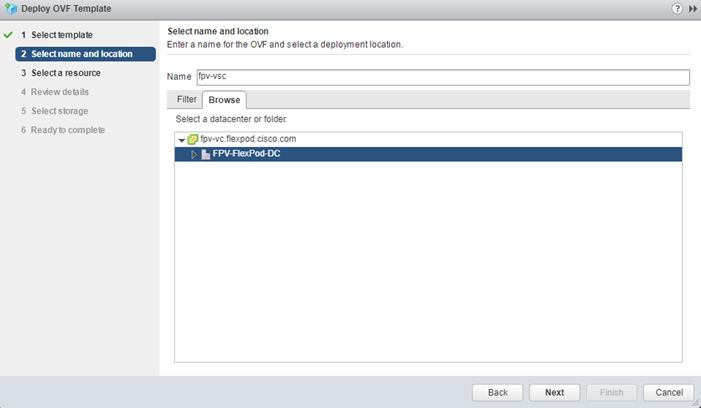
8. Select the FPV-Foundation ESXi cluster and click Next.
9. Review the details and click Next.

10. Click Accept to accept the license and click Next.
11. Select the Thin provision virtual disk format and one of the NFS datastores. Click Next.
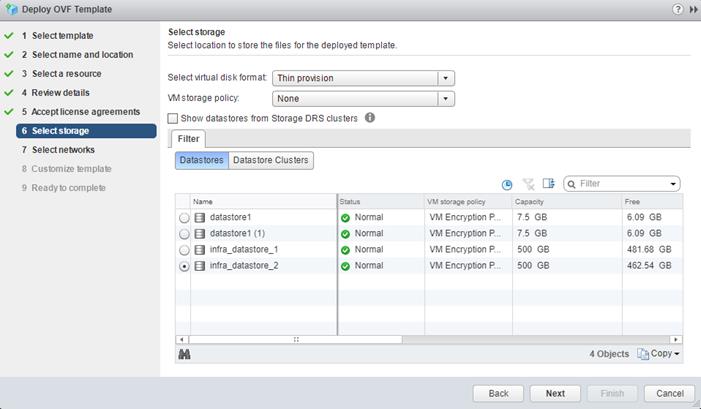
12. Select the Core-Services Port Group from Tenant common on the vDS. Click Next.
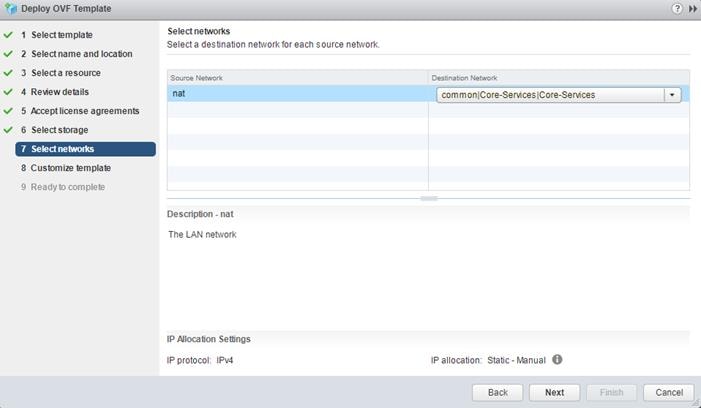
13. Expand and fill in all network information and vCenter registration information. Assign the VM an IP address in the infrastructure IB-MGMT subnet. Click Next.
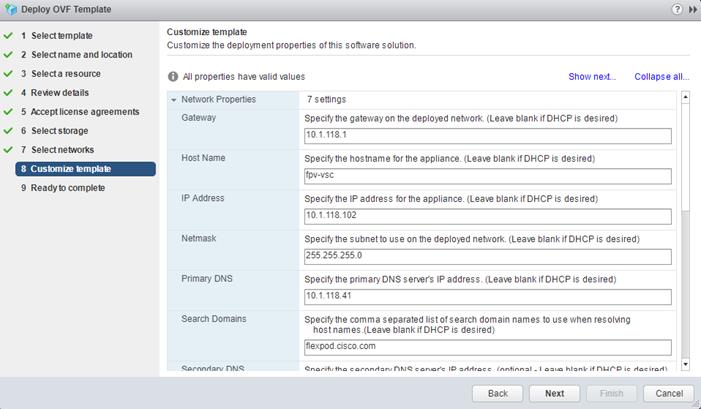
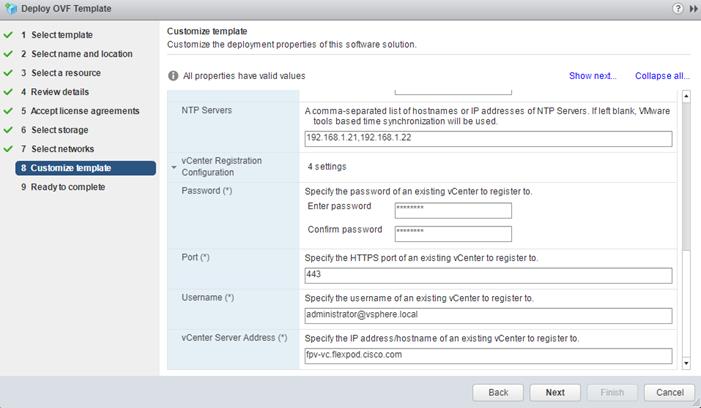
14. Review the installation information. Click Finish to install the appliance.
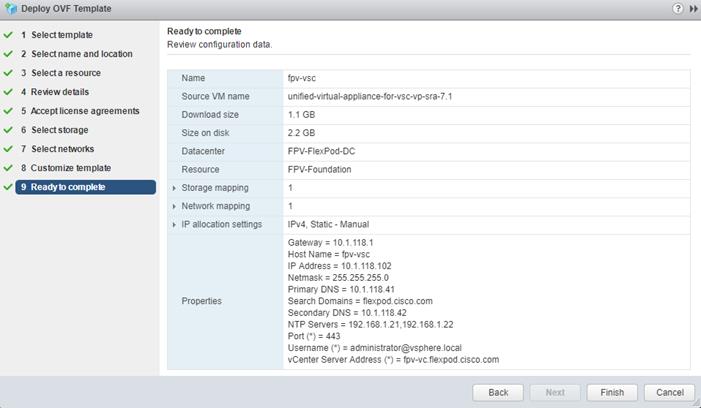
15. Once the OVF deployment completes, power on the VM.
16. Right-click the deployed VM and select Guest OS > Install VMware Tools.
17. Click Mount. VMware Tools will automatically install on the appliance and it will reboot.
18. Log out and log back into the vSphere Web Client.
Add the Supernet Route to the VSC Appliance and Secure the Appliance
Since the NetApp VSC Appliance was placed in the Core-Services network, it will need to have the Supernet route added to communicate with tenant VMs. Complete the following steps.
1. From the vSphere Web Client, right-click the VSC VM and select Open Console.
2. Log into the appliance using the “maint” user id and “admin123” password.
3. Enter “2” to go to System Configuration.
4. Enter “3” to Change ‘maint’ user password.
5. Enter the “admin123” password and then enter and confirm a secure password.
6. Enter “b” to return to the Main Menu.
7. Enter “3” to go to Network Configuration.
8. Enter “6” to Change static routes.
9. Enter “1” to Add route.
10. Enter the Supernet destination address <172.16.0.0/16>.
11. Enter the Supernet gateway address <10.1.118.254>.
12. Enter “y” to confirm the settings.
13. Press Enter.
14. Enter “7” to Commit changes.
15. Enter “y” to commit the changes.
16. Press Enter.
17. Enter “5” to Display static routes.
18. Press Enter.
19. Enter “x” to exit the console.
20. Close the console window.
Install NetApp NFS VAAI Plug-in
To install the NetApp NFS VAAI Plug-in, complete the following steps:
1. Download the NetApp NFS Plug-in 1.1.2 for VMware .vib file from the NFS Plugin Download to the local desktop.
2. Rename the downloaded file NetAppNasPlugin.vib.
3. In the vSphere Web Client, open Home > Virtual Storage Console.
4. On the left, select NFS VAAI Tools.
5. In the center pane, click Select File and browse to the downloaded NetAppNasPlugin.vib. Click Open.
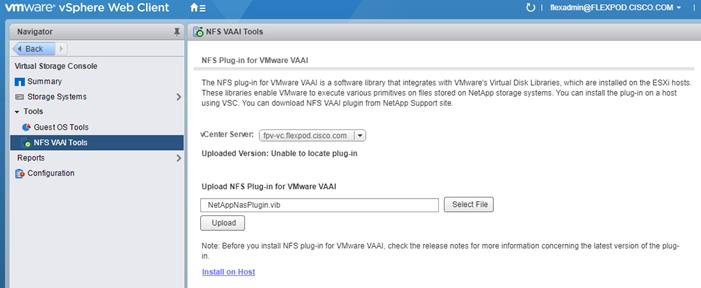
6. Click Upload to upload the plugin to the VSC appliance.
7. The Install on Host link can now be used to install the plugin on the ESXi hosts.
![]() Note that the NFS Plug-in for VMware VAAI has already been installed on the two management hosts in this document.
Note that the NFS Plug-in for VMware VAAI has already been installed on the two management hosts in this document.
Discover and Add Storage Resources
To discover storage resources for the Monitoring and Host Configuration capability and the Provisioning and Cloning capability, complete the following steps:
1. In Virtual Storage Console, on the left select Storage Systems. Under the Objects tab, click Actions > Modify.
2. In the IP Address/Hostname field, enter the storage cluster management IP or FQDN. Enter admin for the user name and the admin password for password. Confirm Use TLS to Connect to This Storage System is selected. Click OK.
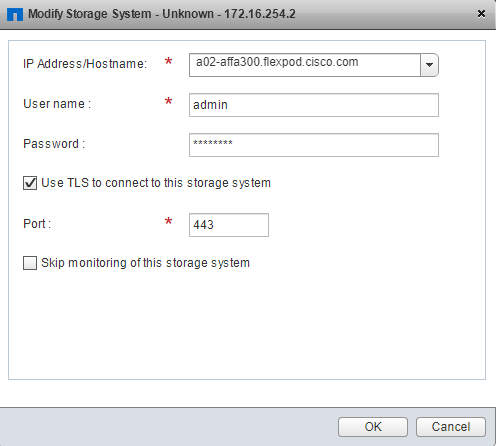
3. Click OK to accept the controller privileges.
4. Wait for the Storage Systems to update. You may need to click Refresh to complete this update.
Optimal Storage Settings for ESXi Hosts
VSC allows for the automated configuration of storage-related settings for all ESXi hosts that are connected to NetApp storage controllers. To use these settings, complete the following steps:
1. From the Home screen, click on vCenter > Hosts and Clusters. For each ESXi host, right-click and select NetApp VSC > Set Recommended Values for these hosts.
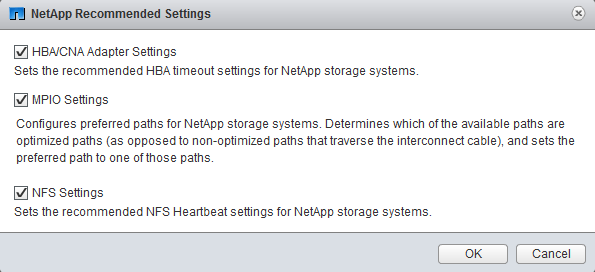
2. Check the settings that are to be applied to the selected vSphere hosts. Click OK to apply the settings.
![]() This functionality sets values for HBAs and converged network adapters (CNAs), sets appropriate paths and path-selection plug-ins, and verifies appropriate settings for software-based I/O (NFS and iSCSI).
This functionality sets values for HBAs and converged network adapters (CNAs), sets appropriate paths and path-selection plug-ins, and verifies appropriate settings for software-based I/O (NFS and iSCSI).
3. Click OK.
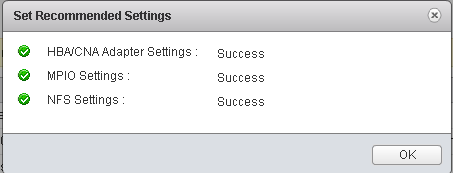
4. For each host for which settings were adjusted in the previous step, place the host in maintenance mode, reboot the host, and exit maintenance mode.
5. Once all hosts have had their Optimized Settings set, these settings can be verified in the Virtual Storage Console tool.
Virtual Storage Console 7.1 Provisioning Datastores
Using VSC, the administrator can provision an NFS, FC or iSCSI datastore and attach it to a single host or multiple hosts in the cluster. The following steps illustrate provisioning a datastore and attaching it to the cluster.
Provisioning an NFS Datastore
To provision the NFS datastore, complete the following steps:
1. From the Home screen of the vSphere Web Client, right-click the FPV-Foundation cluster and select “NetApp VSC > Provision Datastore.”
2. Enter the datastore name and select the type as NFS.
3. Click Next.
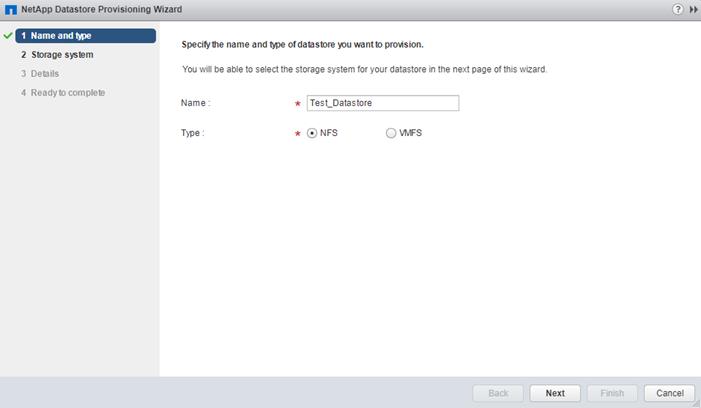
4. Select the cluster name for the Storage system and the desired SVM to create the datastore. In this example, FPV-Foundation-SVM is selected.
5. Click Next.
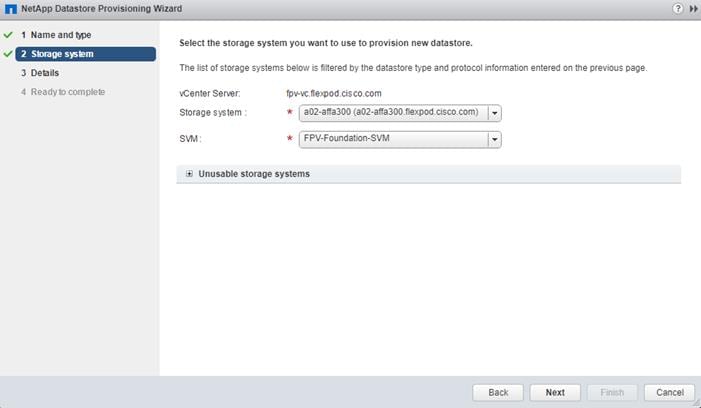
6. Select whether to Thin provision the datastore, enter the size of the datastore and select the aggregate name.
7. Click Next.
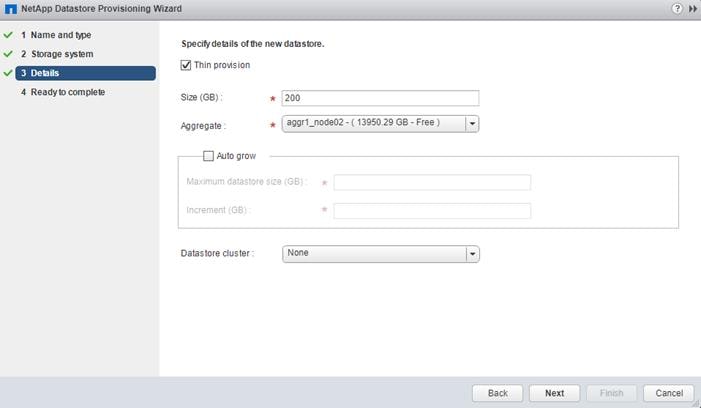
8. Review the details and click Finish.
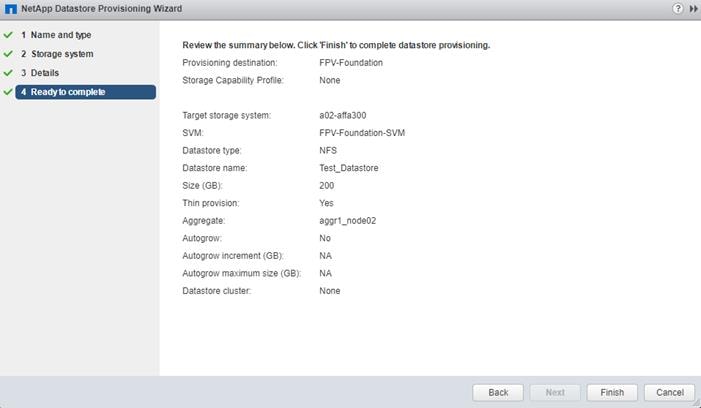
9. Click Ok.
![]() The datastore will be created and mounted on all the hosts in the cluster.
The datastore will be created and mounted on all the hosts in the cluster.
Provisioning iSCSI Datastore
To provision an iSCSI datastore, complete the following steps:
1. From the Home screen of the vSphere Web Client, right-click the FPV-Foundation cluster and select “NetApp VSC > Provision Datastore.”
2. Enter the datastore name and select the type as VMFS. For VMFS protocol, select iSCSI.
3. Click Next.
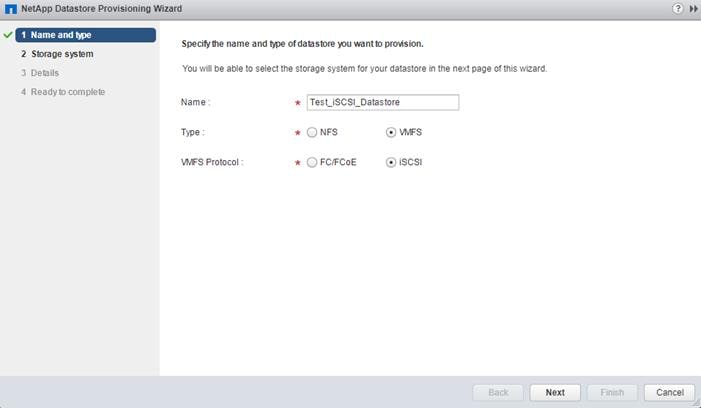
4. Select the cluster name for the Storage system and the desired SVM to create the datastore. In this example, FPV-Foundation-SVM is selected.
5. Click Next.
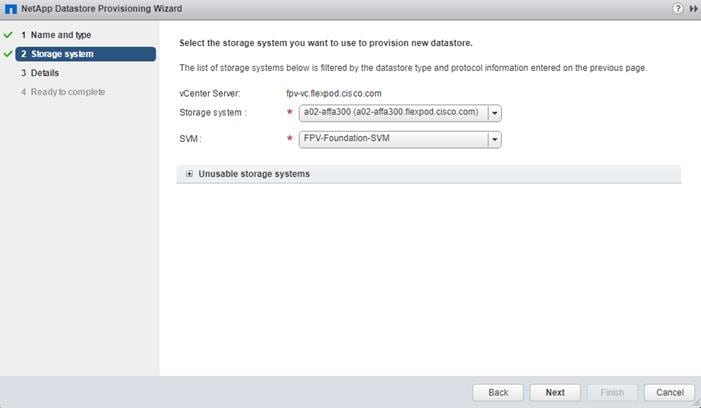
6. Select whether to Thin provision the datastore, and enter the size of the datastore. Select the “Create new volume” check box and select the aggregate name.
7. Click Next.
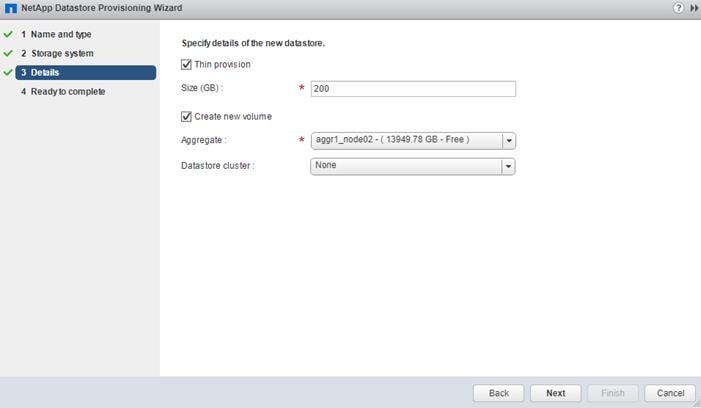
8. Review the details and click Finish.
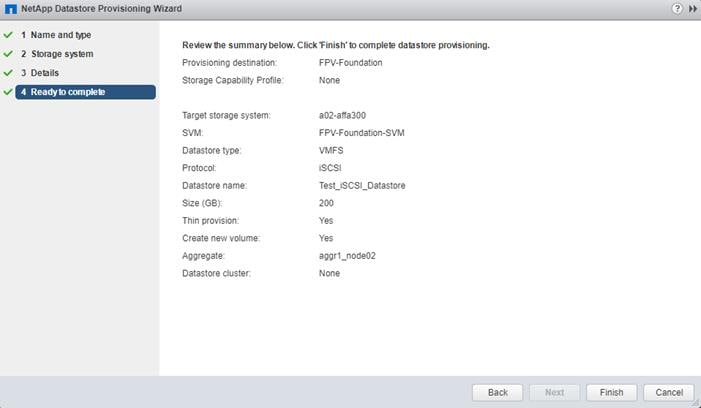
9. Click Ok.
![]() The datastore will be created and mounted on all the hosts in the cluster.
The datastore will be created and mounted on all the hosts in the cluster.
NetApp SnapCenter
NetApp SnapCenter is a Windows application, with the following prerequisites:
· The server it resides on must be in an Active Directory domain.
· The server it resides on must have .NET 4.5.2 or later installed.
· The server it resides on should have at least 32 GB DRAM. (8 GB is the absolute minimum; less than 32 GB will generate a warning during installation.)
· It requires a service user account in the Active Directory domain.
Installing SnapCenter
To install SnapCenter, complete the following steps:
1. Download the SnapCenter installer (SnapCenter4.0.exe) from:
https://mysupport.netapp.com/NOW/download/software/snapcenter/4.0/download.shtml
2. Double-click SnapCenter4.0.exe to start the installation.
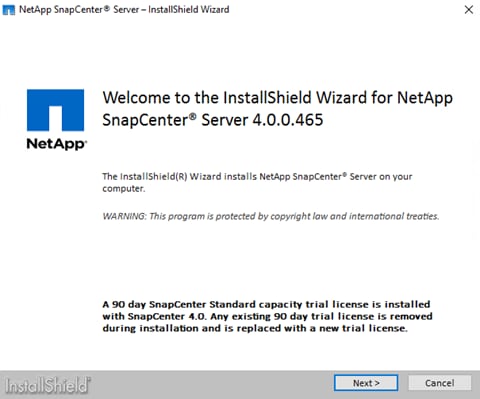
3. Click Next on the Welcome screen.
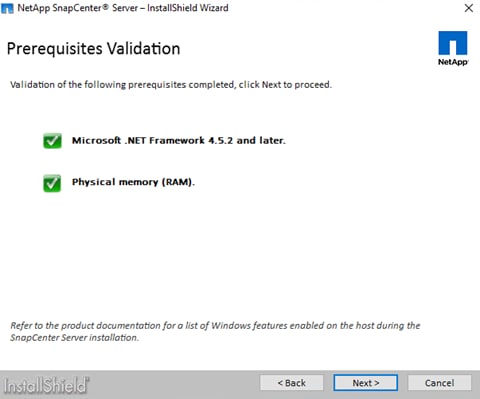
4. Click Next on the Prerequisites Validation screen.
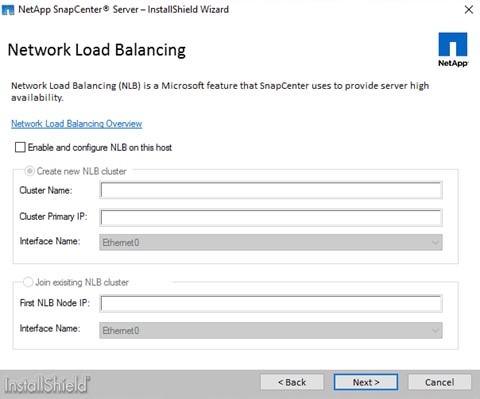
5. Click Next on the Network Load Balancing screen.
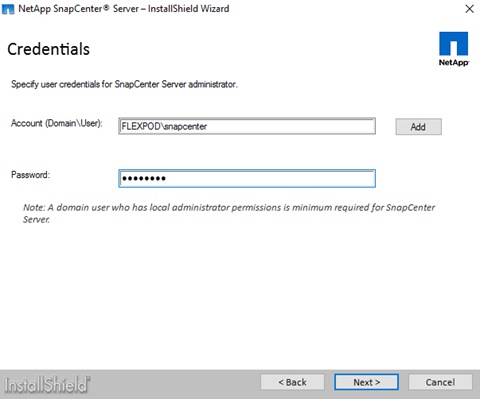
6. Enter the credentials for the service account on the Credentials screen, and click Next.
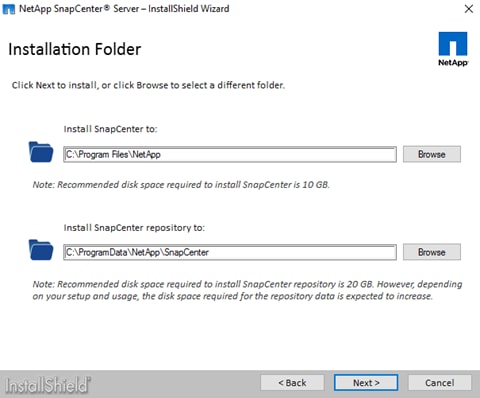
7. Click Next on the Installation folder screen.
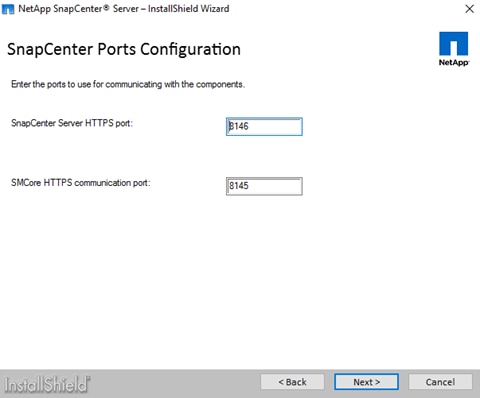
8. Click Next on the SnapCenter Ports Configuration screen.
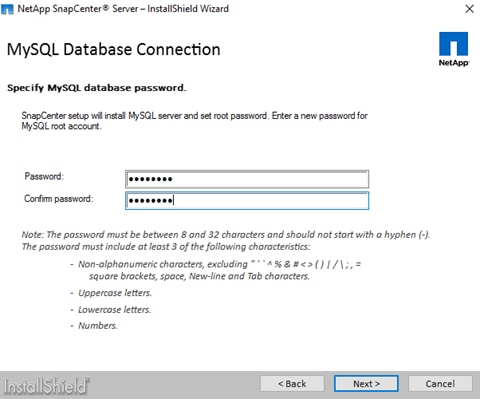
9. Enter and confirm a password for the MySQL root account. Click Next.

10. Click Next. The software will now start installing.
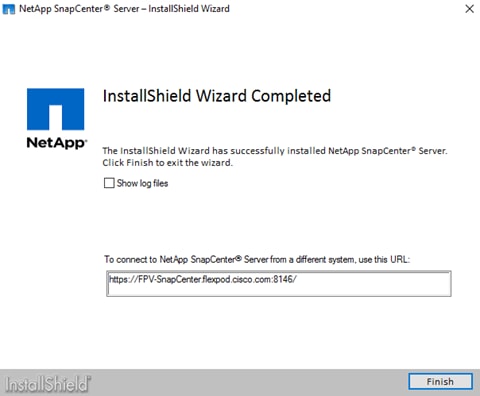
11. After the installation completes, connect to the SnapCenter server via a web browser, at the URL listed on the InstallShield Wizard Completed screen. Click Finish to close the installer.
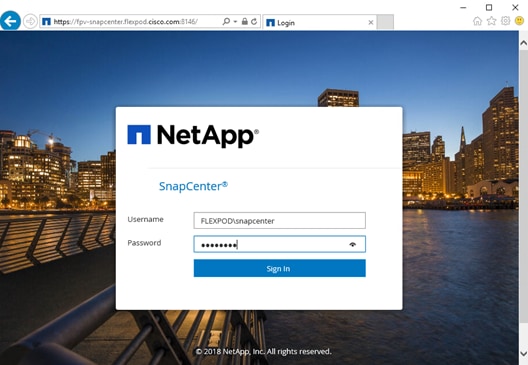
12. Log in to the SnapCenter server using the service account credentials.

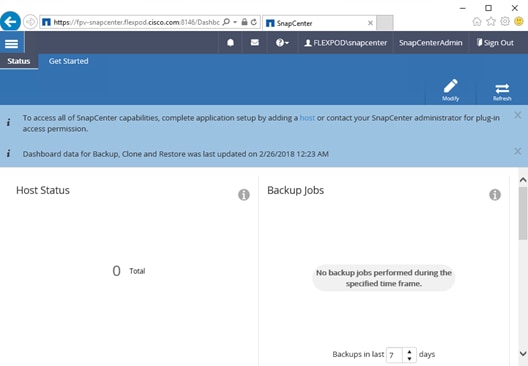
13. Click the “host” link (indicated by the arrow) to start adding your ESXi hosts.
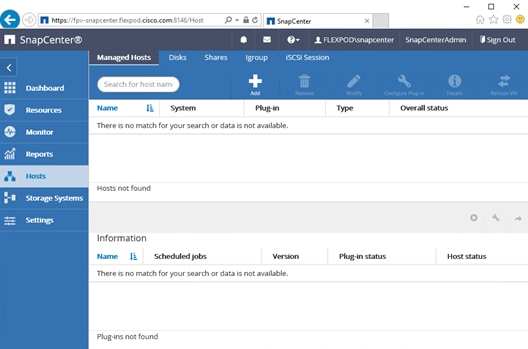
14. Click the Add button to add hosts.
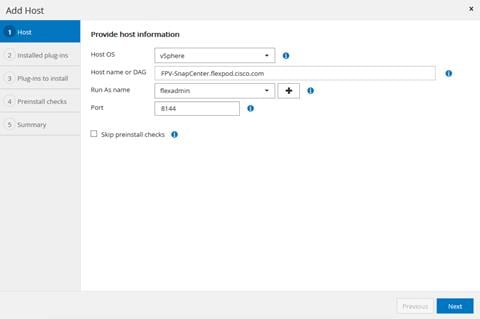
15. In the first Add Host page (Host), select vSphere for Host OS; accept the default value (the hostname of the SnapCenter server) for the Host name field, and a domain admin for the Run As name field. If this is the first host for this instance of SnapCenter, you will need to add the domain admin credentials via the + button to the right of the Run As name drop-down list.
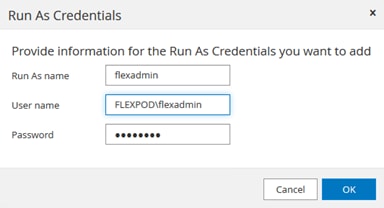
16. Back in the first Add Host page, click Next.
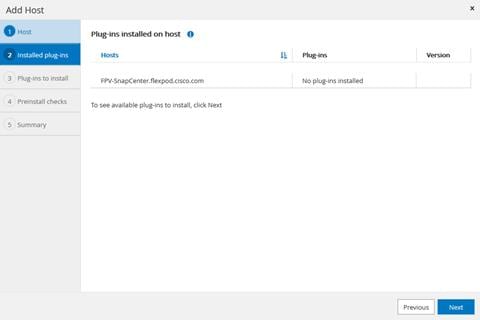
17. In the second Add Host page (Installed plug-ins), click Next.
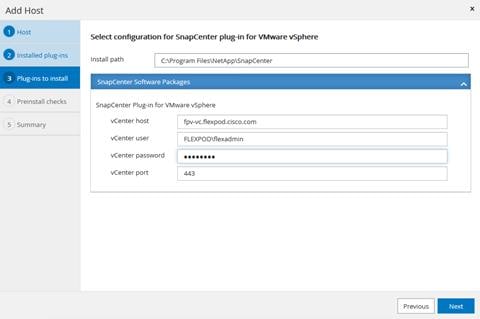
18. In the third Add Host page (Plug-ins to install), enter the vCenter credentials, and click Next. The plug-in installer will run the Preinstall checks.
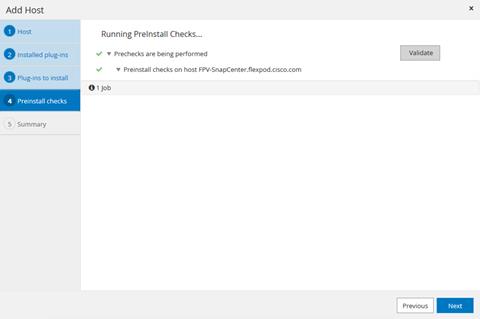
19. If any errors are displayed in the fourth Add Host page (Preinstall checks), correct the problem listed, and click Validate to run the Preinstall checks again. When the checks run without error, click Next.
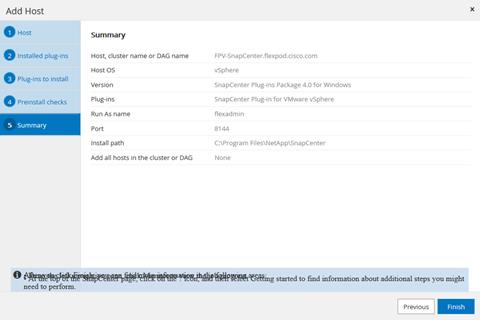
20. Click Finish.
21. Log in to vCenter via the vSphere Web Client. The SnapCenter Plug-in for VMware vSphere should now be in the Inventories section of the Home page. (If you were logged in to vCenter during the SnapCenter plug-in installation, log out of vCenter and then log back in to load the newly installed plug-in.) Click the SnapCenter plug-in icon.
22. In the left Navigator pane of the VMware vSphere web client in vCenter for the Plug-in for VMware vSphere, click Storage Systems.
23. On the Storage Systems page, click Add Storage System.
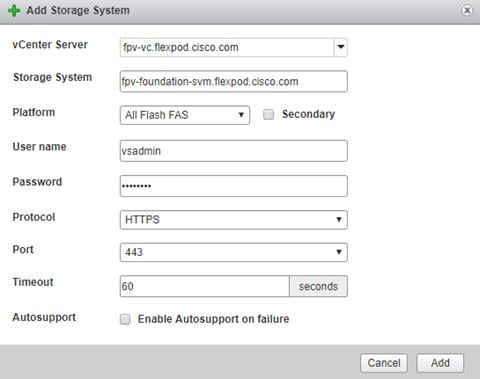
24. In the Add Storage System dialog box, enter the SVM information. Click Add.
25. Repeat the previous two steps as needed to add other SVMs.
26. SnapCenter backups have two components: Policies (which define things like frequency, retention, etc.) and Resource Groups (define which VMs and datastores are backed up). To create a policy, in the left Navigator pane of the VMware vSphere web client in vCenter for the Plug-in for VMware vSphere, click Policies.
27. In the Policies page, click New Policy in the toolbar.

28. In the New Backup Policy page, enter the desired parameters. Click Add.
29. A resource group can contain VMs, and SAN and NAS datastores; it cannot contain VSAN or VVOL datastores. To create a resource group, in the left Navigator pane of the VMware vSphere web client in vCenter for the Plug-in for VMware vSphere, click Resource Groups and then click (Create Resource Group).
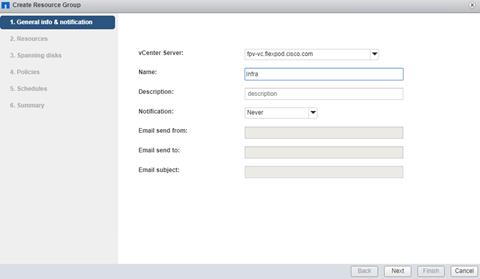
30. Enter the desired info and click Next.
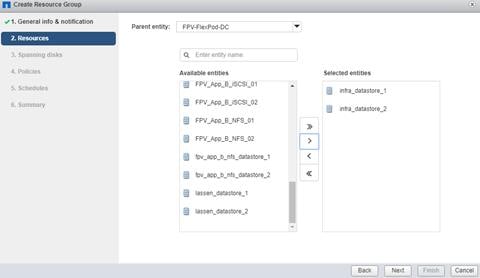
31. Select the desired resources to back up and click Next.
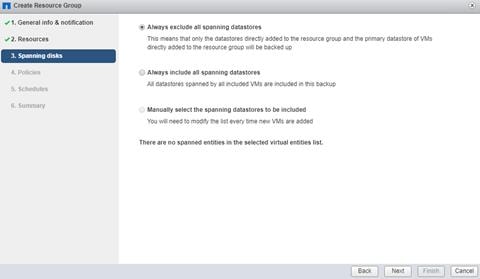
32. Select the desired treatment for spanning disks (VMDKs that span multiple datastores) and click Next.
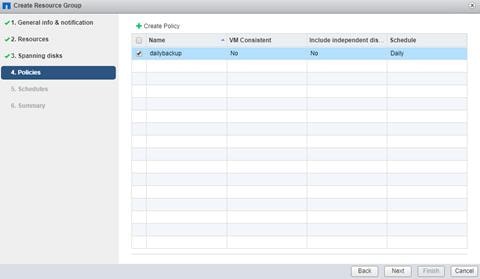
33. Select the backup policy and click Next.
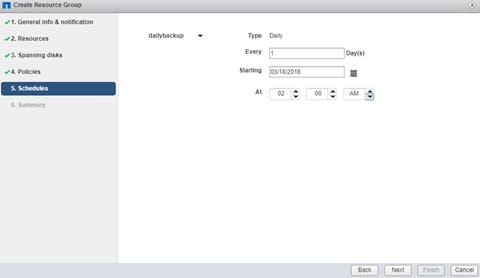
34. Edit schedule parameters as desired and click Next.
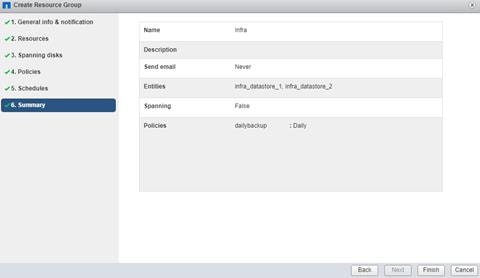
35. Review the parameters and click Finish.
OnCommand Unified Manager 7.2
To use the OVA deployment method to deploy OnCommand Unified Manager as a virtual machine in vSphere, complete the following steps:
1. Download and review the OnCommand Unified Manager 7.2 Installation and Setup Guide
2. Download the OnCommand Unified Manager version 7.2P1 OVA file for VMware vSphere from http://mysupport.netapp.com to the local management machine.
3. In vSphere Web Client, select the FPV-Foundation cluster in the Navigator, then select Deploy OVF Template from the Actions menu.
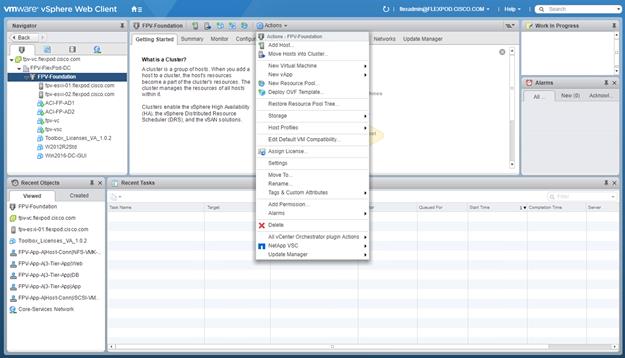
4. Select the Local file radio button, then Browse to navigate to the OVA file. Select the file, click Open and the click Next.
5. On the name and location page, enter the desired VM name, select the FPV-FlexPod-DC datacenter as the installation location, and click Next.
6. On the resource page, select the FPV-Foundation cluster as the resource to run the VM on.
7. On the Review details page, ignore the warning about advanced configuration options, and click Next to continue.

8. On the Accept license agreement page, note the post-deployment steps. Click Accept, then click Next.
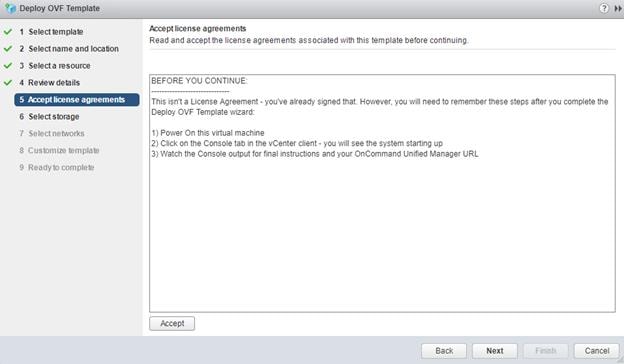
9. On the storage page, select infra_datastore_1, and click Next to continue.
10. On the Select networks page, select common | Core-Services |Core-Services as the Destination Network, and click Next.
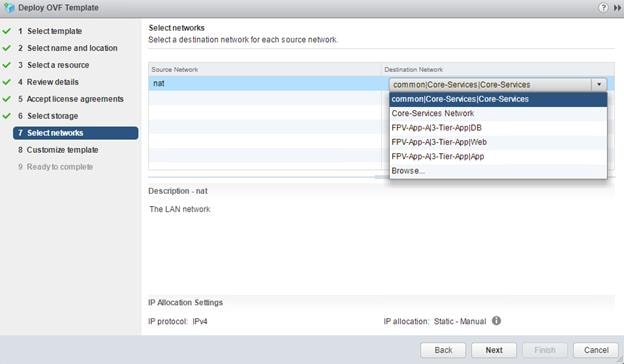
11. On the Customize template page, add deployment-specific parameters, and click Next.
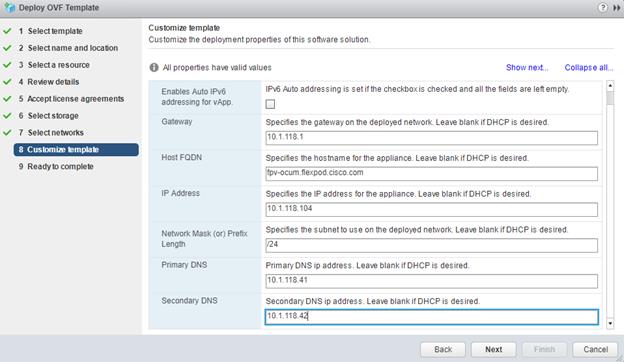
12. Review the deployment parameters, and click Finish to deploy the VM.
13. After the VM deployment completes, edit the VM’s settings in vSphere Web Client to mount the VMware tools ISO. Open the VM console in vSphere Web Client, and power on the VM; the installation of VMware tools will execute automatically.
14. Set the time parameters as prompted.
15. Create the maintenance user as prompted.
16. Using a web browser, connect to the URL listed on the console. For the first login, use the maintenance user credentials.
17. Enter e-mail and NTP settings and click Next.
18. Enable AutoSupport and click Next.
19. Click Save and Continue.
20. Click Add to add a new storage cluster.
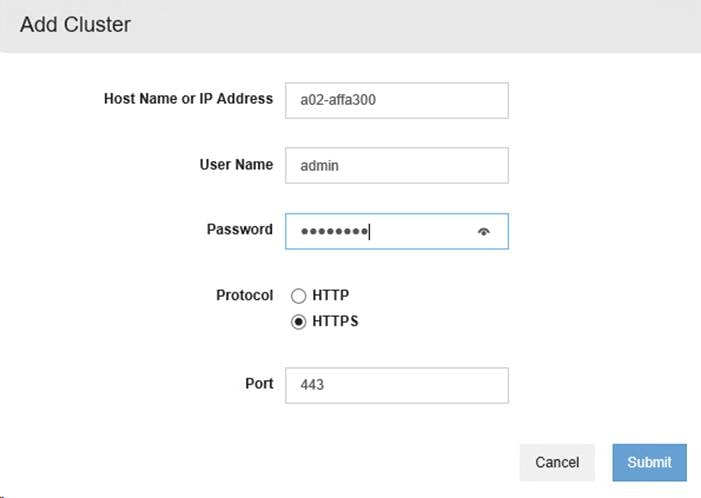
21. Storage information can then be viewed by logging into OnCommand Unified Manager at https://OncommandUnifiedManagerHostname as shown below:
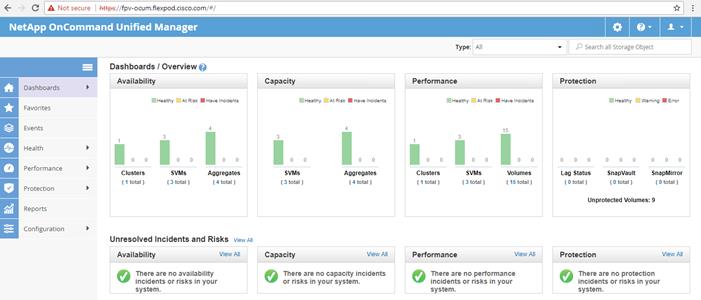
ACI Shared Layer 3 Out Setup
This section describes the procedure for deploying the ACI Shared Layer 3 Out. This external network is setup with a routing protocol and provides ACI tenants with a gateway to enter and leave the fabric.
This section provides a detailed procedure for setting up the Shared Layer 3 Out in Tenant common to existing Nexus 7000 core routers using sub-interfaces and VRF aware OSPF. Some highlights of this connectivity are:
· A new bridge domain and associated VRF is configured in Tenant common for external connectivity.
· The shared Layer 3 Out created in Tenant common “provides” an external connectivity contract that can be “consumed” from any tenant.
· Routes to tenant EPG subnets connected by contract are shared across VRFs with the Nexus 7000 core routers using OSPF.
· The Nexus 7000s’ default gateway is shared with the ACI fabric using OSPF.
· Each of the two Nexus 7000s is connected to each of the two Nexus 9000 leaf switches.
· Sub-interfaces are configured and used for external connectivity.
· The Nexus 7000s are configured to originate and send a default route to the Nexus 9000 leaf switches.
· This Shared Layer 3 Out was set up on a set of 10GE leaves that were part of the ACI fabric and not the 9332 leaves (which were also part of the fabric) used in this validation.
Figure 4 ACI Shared Layer 3 Out Connectivity Details
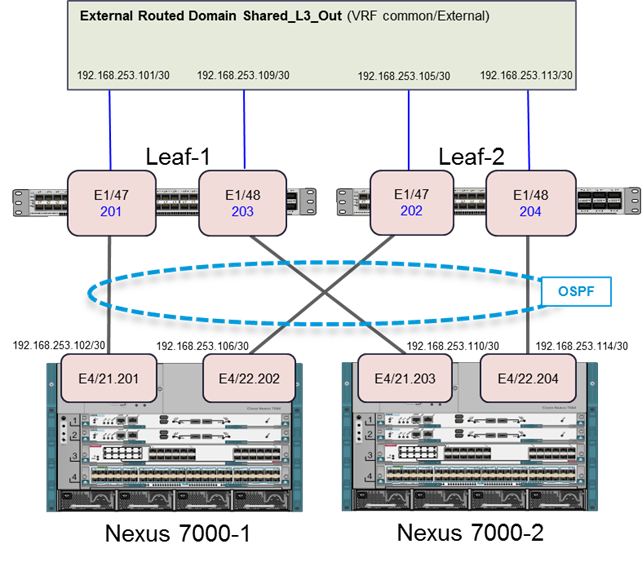
Configuring the Nexus 7000s for ACI Connectivity (Sample)
The following configuration is a sample from the virtual device contexts (VDCs) from two Nexus 7004s. Interfaces and a default route from the two Nexus 7000s also needs to be set up, but is not shown here because this is set up according to the customer's security policy.
Nexus 7004-1 VDC
feature ospf
vlan 100
name OSPF-Peering
interface Vlan100
no shutdown
mtu 9216
no ip redirects
ip address 192.168.253.253/30
no ipv6 redirects
ip ospf mtu-ignore
ip router ospf 10 area 0.0.0.0
interface Ethernet4/21
no shutdown
interface Ethernet4/21.201
encapsulation dot1q 201
ip address 192.168.253.102/30
ip ospf network point-to-point
ip ospf mtu-ignore
ip router ospf 10 area 0.0.0.10
no shutdown
interface Ethernet4/22
no shutdown
interface Ethernet4/22.202
encapsulation dot1q 202
ip address 192.168.253.106/30
ip ospf cost 5
ip ospf network point-to-point
ip ospf mtu-ignore
ip router ospf 10 area 0.0.0.10
no shutdown
interface loopback0
ip address 192.168.254.3/32
ip router ospf 10 area 0.0.0.0
router ospf 10
router-id 192.168.254.3
area 0.0.0.10 nssa no-summary default-information-originate no-redistribution
Nexus 7004-2 VDC
feature ospf
vlan 100
name OSPF-Peering
interface Vlan100
no shutdown
mtu 9216
no ip redirects
ip address 192.168.253.254/30
no ipv6 redirects
ip ospf mtu-ignore
ip router ospf 10 area 0.0.0.0
interface Ethernet4/21
no shutdown
interface Ethernet4/21.203
encapsulation dot1q 203
ip address 192.168.253.110/30
ip ospf cost 21
ip ospf network point-to-point
ip ospf mtu-ignore
ip router ospf 10 area 0.0.0.10
no shutdown
interface Ethernet4/22
no shutdown
interface Ethernet4/22.204
encapsulation dot1q 204
ip address 192.168.253.114/30
ip ospf cost 30
ip ospf network point-to-point
ip ospf mtu-ignore
ip router ospf 10 area 0.0.0.10
no shutdown
interface loopback0
ip address 192.168.254.4/32
ip router ospf 10 area 0.0.0.0
router ospf 10
router-id 192.168.254.4
area 0.0.0.10 nssa no-summary default-information-originate no-redistribution
Configuring ACI Shared Layer 3 Out
ACI GUI
1. At the top, select Fabric > Access Policies.
2. On the left, expand Physical and External Domains.
3. Right-click External Routed Domains and select Create Layer 3 Domain.
4. Name the Domain Shared-L3-Out.
5. Use the Associated Attachable Entity Profile drop-down list to select Create Attachable Entity Profile.
6. Name the Profile AEP-Shared-L3-Out and click Next.
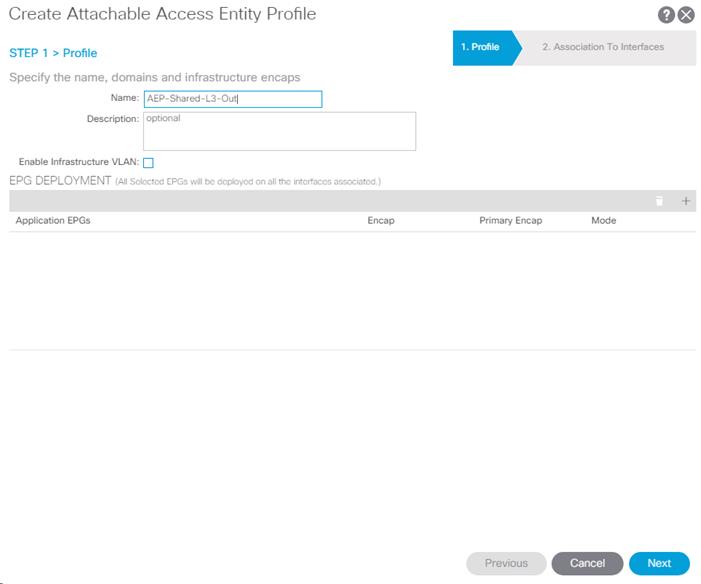
7. Click Finish to continue without specifying interfaces.
8. Back in the Create Layer 3 Domain window, use the VLAN Pool drop-down list to select Create VLAN Pool.
9. Name the VLAN Pool VP-Shared-L3-Out and select Static Allocation.
10. Click the + sign to add and Encap Block.
11. In the Create Ranges window, enter the From and To VLAN IDs for the Shared-L3-Out VLAN range (201-204). Select Static Allocation.
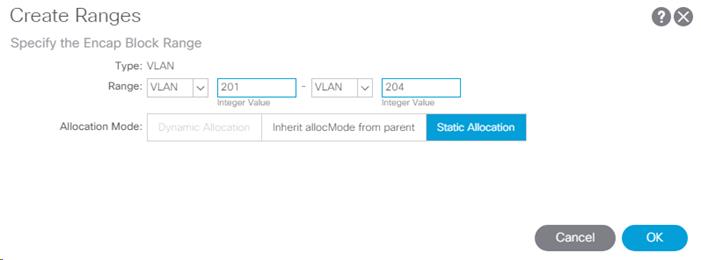
12. Click OK to complete adding the VLAN range.
13. Click Submit to complete creating the VLAN Pool.
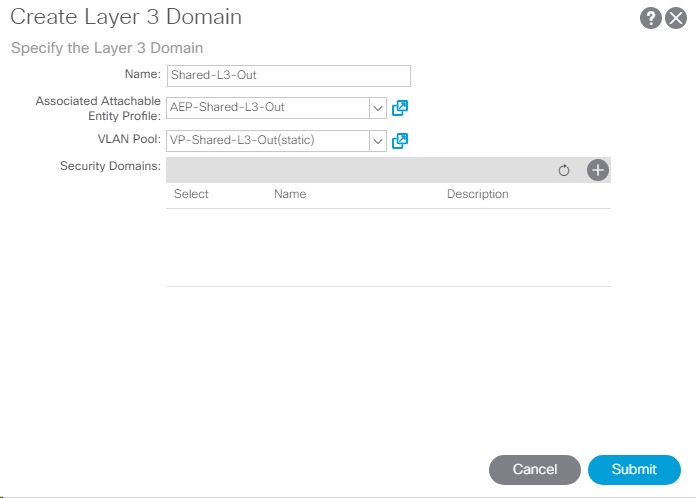
14. Click Submit to complete creating the Layer 3 Domain.
15. At the top, select Fabric > Access Policies.
16. On the left, select Quick Start. Under Steps, select Configure an interface, PC, or VPC.
17. If an Interface, PC, or vPC has already been configured on the leaf pair being used here, select that switch pair in the list on the left and skip to step 19. Otherwise, in the center pane, click the green plus sign to select switches.
18. Using the Switches pull-down, select the two leaf switches connected to the Nexus 7000s and click away from the list to get the two switches filled in next to Switches. The Switch Profile Name will be automatically filled in.

19. Click the green plus sign to configure switch interfaces.
20. Next to interfaces, enter the 2-port identifiers for the ports connected to the Nexus 7000s and used for Shared-L3-Out. It is important to use the same two ports on each leaf. Fill in the policies, Attached Device Type, and External Route Domain as shown below.

21. On the lower right, click Save. Click Save again and then click Submit.
22. At the top, select Tenants > common.
23. On the left, expand Tenant common and Networking.
24. Right-click VRFs and select create VRF.
Name the VRF common-FP-External. Select default for both the End Point Retention Policy and Monitoring Policy.
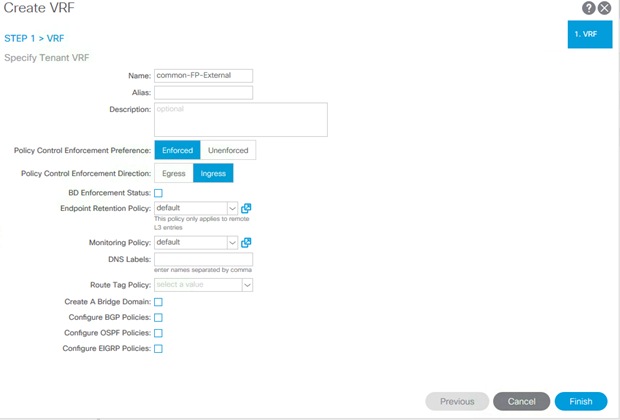
25. Click Finish to complete creating the VRF.
26. On the left, right-click External Routed Networks and select Create Routed Outside.
27. Name the Routed Outside Shared-L3-Out.
28. Select the checkbox next to OSPF.
29. Enter 0.0.0.10 (configured in the Nexus 7000s) as the OSPF Area ID.
30. Using the VRF drop-down list, select common/common-FP-External.
31. Using the External Routed Domain drop-down list, select Shared-L3-Out.
32. Click the + sign to the right of Nodes and Interfaces Protocol Profiles to add a Node Profile.
33. Name the Node Profile Nodes-101-102 for the Nexus 9000 Leaf Switches.
34. Click the + sign to the right of Nodes to add a Node.
35. In the select Node window, select Leaf switch 101.
36. Provide a Router ID IP address that will also be used as the Loopback Address (192.168.254.101).
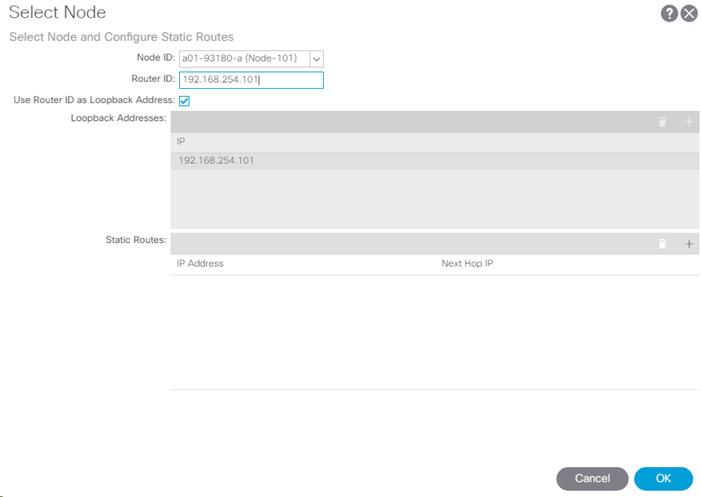
37. Click OK to complete selecting the Node.
38. Click the + sign to the right of Nodes to add a Node.
39. In the select Node window, select Leaf switch 102.
40. Provide a Router ID IP address that will also be used as the Loopback Address (192.168.254.102).
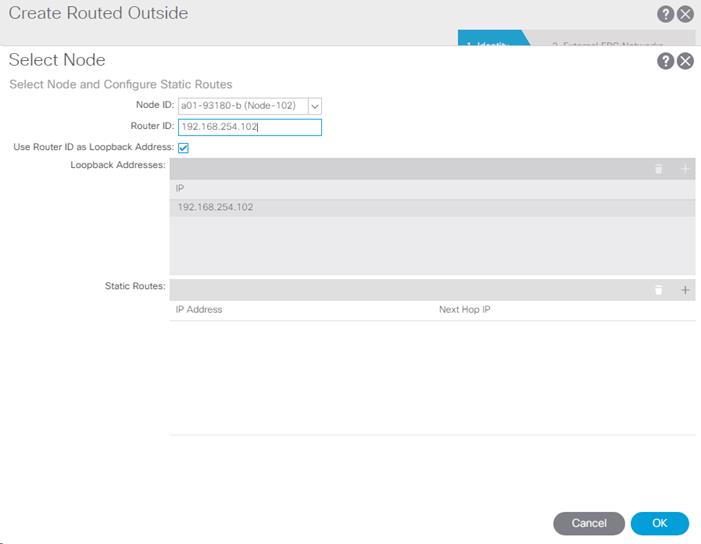
41. Click OK to complete selecting the Node.
42. Click the + sign to the right of OSPF Interface Profiles to create an OSPF Interface Profile.
43. Name the profile OIP-Nodes-101-102.
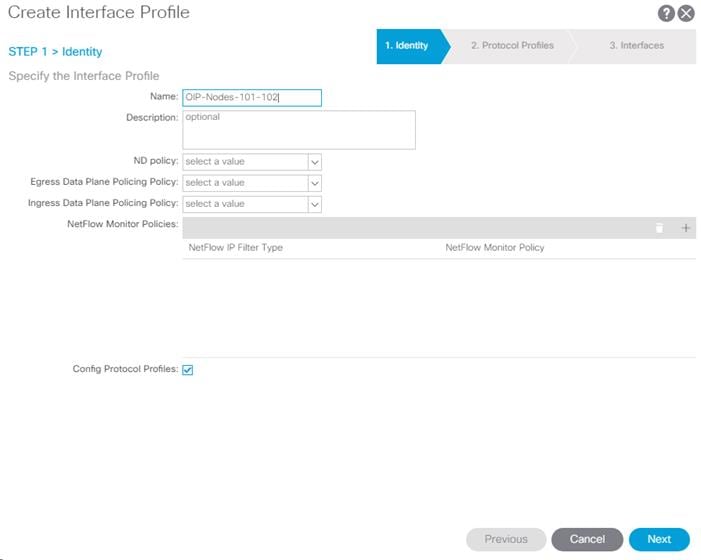
44. Click Next.
45. Using the OSPF Policy drop-down list, select Create OSPF Interface Policy.
46. Name the policy To-7K.
47. Select the Point-to-Point Network Type.
48. Select the Advertise subnet and MTU ignore Interface Controls.
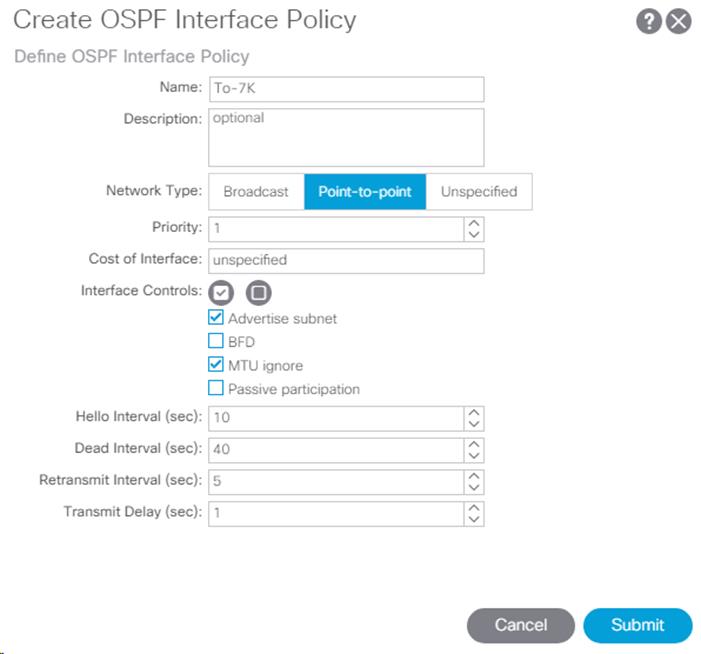
49. Click SUBMIT to complete creating the policy.
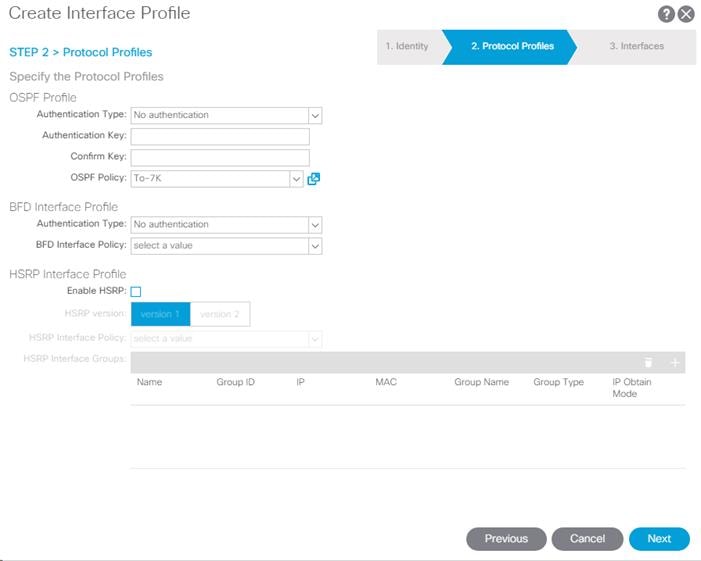
50. Click Next.
51. Select Routed Sub-Interface under Interfaces.
52. Click the + sign to the right of Routed Sub-Interfaces to add a routed sub-interface.
53. In the Select Routed Sub-Interface window, select the interface on Node 101 that is connected to Nexus 7000-1.
54. Enter VLAN 201 for Encap.
55. Enter the IPv4 Primary Address (192.168.253.101/30)
56. Leave the MTU set to inherit.
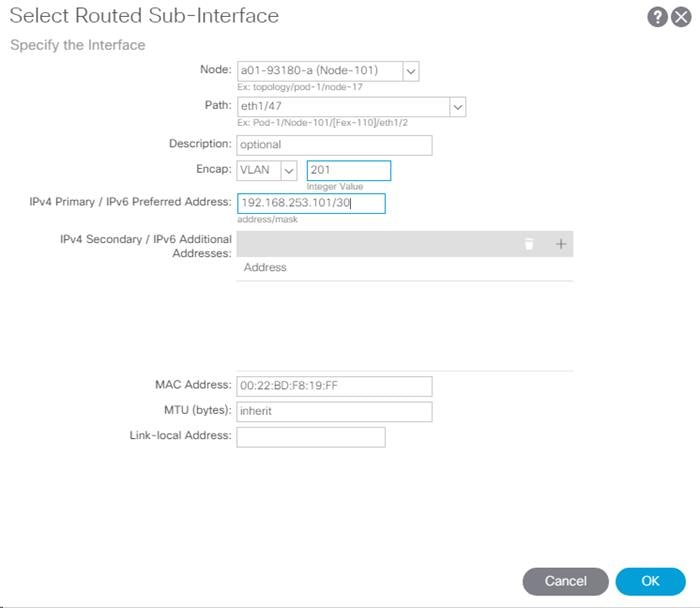
57. Click OK to complete creating the routed sub-interface.
58. Repeat steps 54-59 to add the second Leaf 1 interface (VLAN 203, IP 192.168.253.109/30), the first Leaf 2 interface (VLAN 202, IP 192.168.253.105/30), and the second Leaf 2 interface (VLAN 204, IP 192.168.253.113/30).
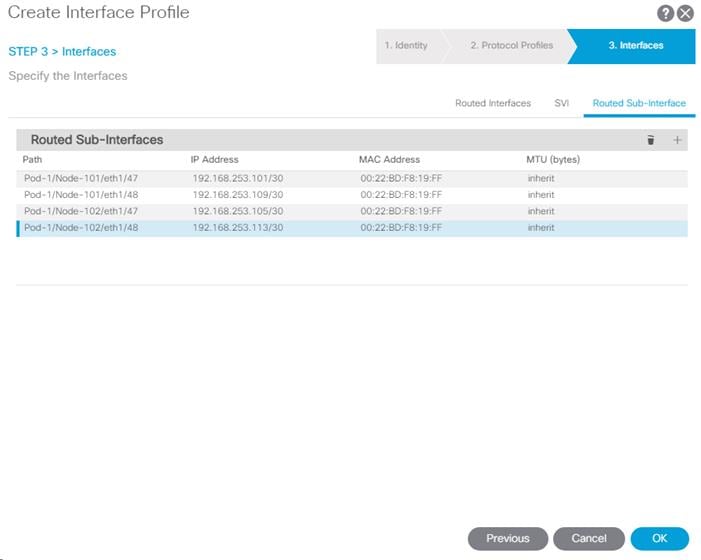
59. Click OK to complete creating the Node Interface Profile.
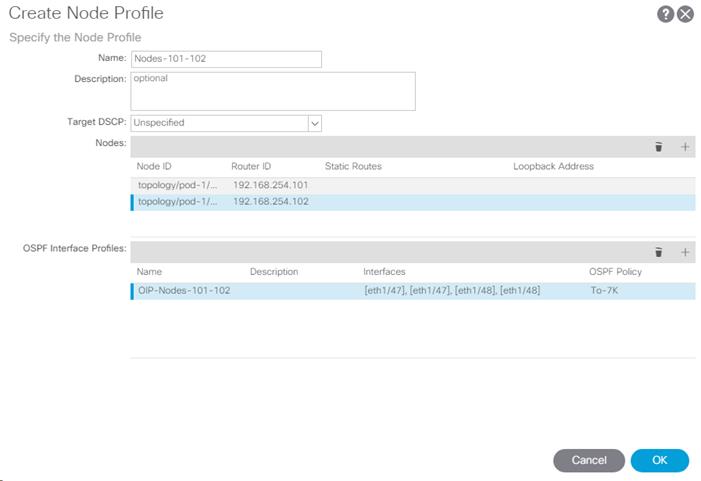
60. Click OK to complete creating the Node Profile.
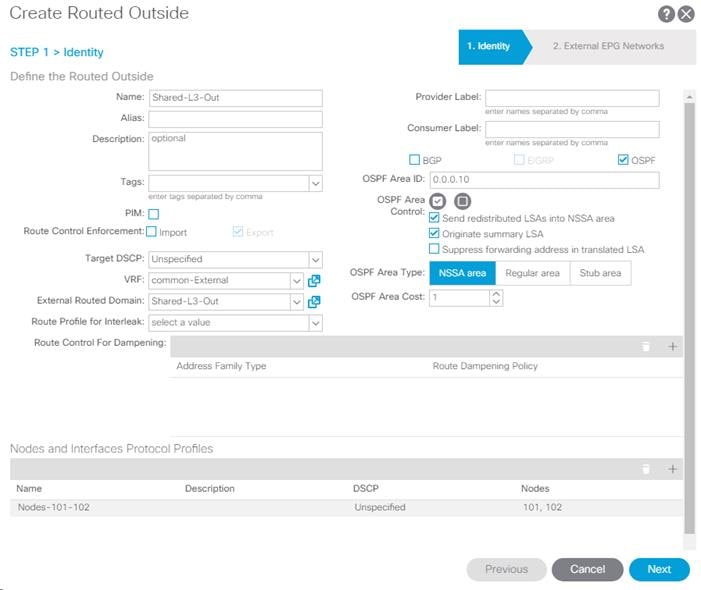
61. Click Next.
62. Click the + sign under External EPG Networks to create and External EPG Network.
63. Name the External Network Default-Route.
64. Click the + sign to add a Subnet.
65. Enter 0.0.0.0/0 as the IP Address. Select the checkboxes for External Subnets for the External EPG, Shared Route Control Subnet, and Shared Security Import Subnet.
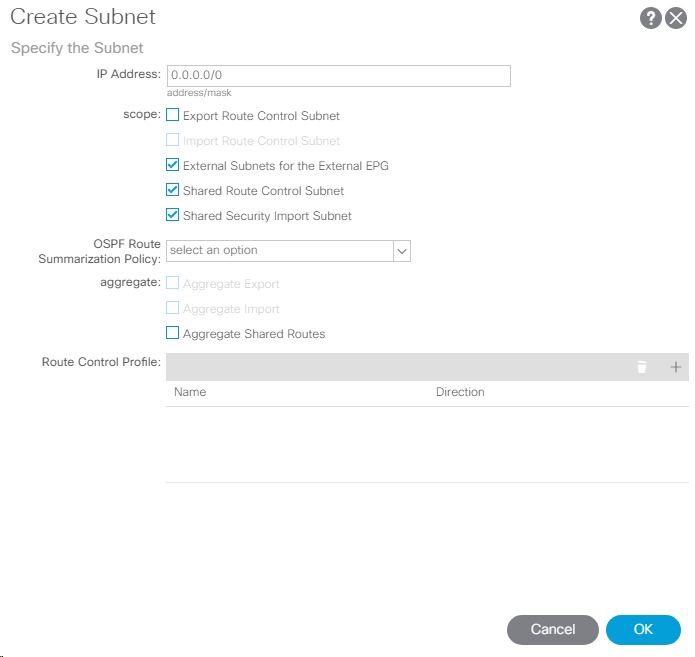
66. Click OK to complete creating the subnet.
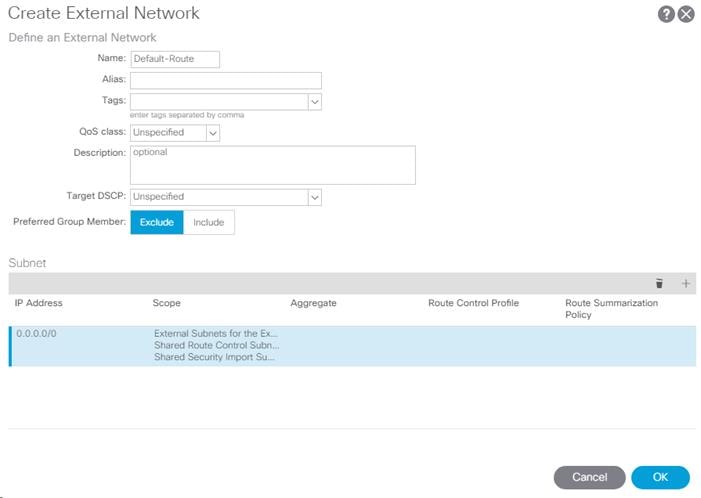
67. Click OK to complete creating the external network.
68. Click Finish to complete creating the Shared-L3-Out.
69. On the left, right-click Contracts and select Create Contract.
70. Name the contract Allow-Shared-L3-Out.
71. Select the Global Scope to allow the contract to be consumed from all tenants.
72. Click the + sign to the right of Subjects to add a contract subject.
73. Name the subject Allow-All.
74. Click the + sign to the right of Filters to add a filter.
75. Use the drop-down list to select the Allow-All filter from Tenant common.
76. Click Update.
77. Click OK to complete creating the contract subject.
78. Click Submit to complete creating the contract.
79. On the left, expand Tenant common, Networking, External Routed Networks, Shared-L3-Out, and Networks. Select Default-Route.
80. On the right, under Policy, select Contracts.
81. Click the + sign to the right of Provided Contracts to add a Provided Contract.
82. Select the common/Allow-Shared-L3-Out contract and click Update.
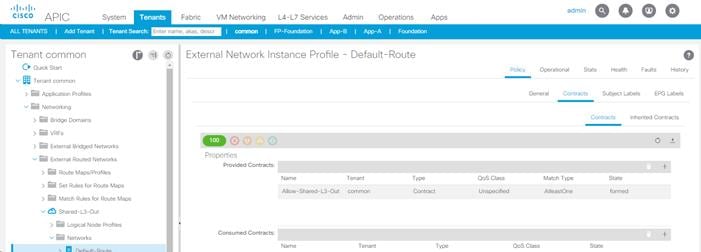
![]() Tenant EPGs can now consume the Allow-Shared-L3-Out contract and connect outside of the fabric. More restrictive contracts can be built and provided here for more restrictive access to the outside.
Tenant EPGs can now consume the Allow-Shared-L3-Out contract and connect outside of the fabric. More restrictive contracts can be built and provided here for more restrictive access to the outside.
Lab Validation Tenant Configuration
The following table lists the VLANs, Subnets, and Bridge Domains for the sample App-A Tenant set up as part of this lab validation:
Table 4 Lab Validation Tenant FPV-App-A Configuration
| EPG | Storage VLAN | UCS VLAN | Subnet / Gateway | Bridge Domain |
| iSCSI | 3014 | Virtual Switch | 192.168.14.0/24 – L2 | BD-iSCSI |
| NFS | 3054 | Virtual Switch | 192.168.54.0/24 – L2 | BD-NFS |
| SVM-MGMT | 220 | Virtual Switch | 172.18.254.22/29 | BD-Internal |
| Web | N/A | Virtual Switch | 172.16.0.254/24 | BD-Internal |
| App | N/A | Virtual Switch | 172.16.1.254/24 | BD-Internal |
| DB | N/A | Virtual Switch | 172.16.2.254/24 | BD-Internal |
Deploy ACI Application (FPV-App-A) Tenant
This section details the steps for creation of the FPV-App-A Sample Tenant in the ACI Fabric. This tenant will host application connectivity between the compute (ESXi Server on UCS) and the storage (NetApp) environments. This tenant will also host the three application tiers of the sample three-tier application. A corresponding FPV-App-A-SVM will be created on the NetApp storage to align with this tenant. To deploy the FPV-App-A Tenant, complete the following steps:
![]() Note that in this validation, only one iSCSI VLAN was used. It is assumed that the Tenant host servers will boot from LUNs in the Foundation SVM using the infrastructure iSCSI interfaces. The Tenant iSCSI interfaces will be placed on the VMware vDS.
Note that in this validation, only one iSCSI VLAN was used. It is assumed that the Tenant host servers will boot from LUNs in the Foundation SVM using the infrastructure iSCSI interfaces. The Tenant iSCSI interfaces will be placed on the VMware vDS.
APIC GUI
1. In the APIC GUI, select Fabric > Access Policies.
2. On the left, expand Pools and VLAN.
3. Select the storage VLAN Pool created earlier (NetApp-AFF_vlans).
4. In the center pane, click the + sign to add an encapsulation block.
5. Enter <storage-FPV-App-A-NFS-VLAN> for the From and To fields.
6. Select Static Allocation.
7. Leave Role set to External or On the wire encapsulations.
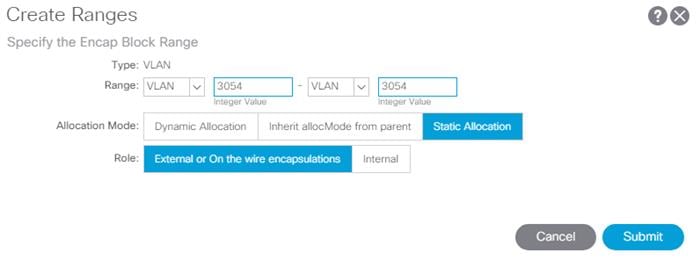
8. Click Submit to add the Encap Block Range.
9. In the center pane, click the + sign to add another encapsulation block.
10. Enter <storage-FPV-App-A-SVM-MGMT-VLAN> for the From and To fields.
11. Select Static Allocation.
12. Click Submit to add the Encap Block Range.
13. If iSCSI LUN access is being provided by the FPV-App-A tenant, complete steps 14-18. Otherwise, continue at step 19.
14. In the center pane, click the + sign to add an encapsulation block.
15. Enter <storage-FPV-App-A-iSCSI-VLAN> for the From and To fields.
16. Select Static Allocation.
17. Leave Role set to External or On the wire encapsulations.
18. Click SUBMIT to add the Encap Block Range.
19. At the top select Tenants > Add Tenant.
20. Name the Tenant FPV-App-A. Select the default Monitoring Policy.
21. For the VRF Name, also enter FPV-App-A. Leave the Take me to this tenant when I click finish checkbox checked.
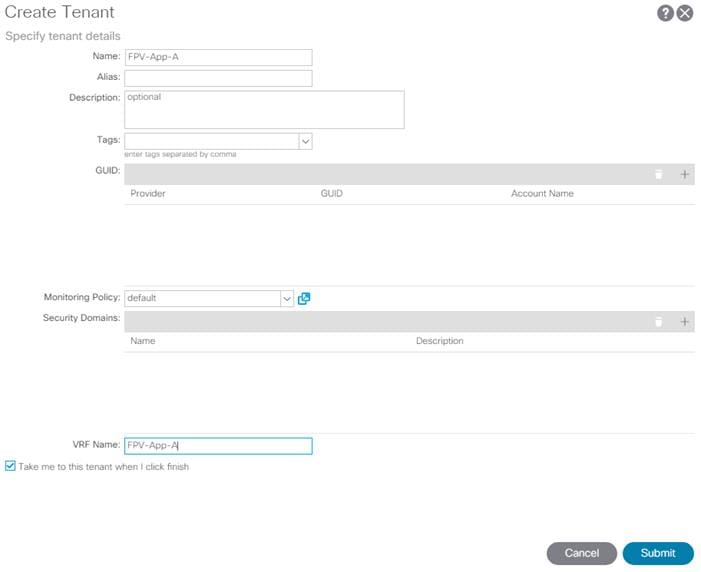
22. Click Submit to finish creating the Tenant.
23. On the left under Tenant FPV-App-A, right-click Application Profiles and select Create Application Profile.
24. Name the Application Profile Host-Conn select the default Monitoring Policy, and click Submit to complete adding the Application Profile.
25. If you are using providing iSCSI LUN access from this tenant, complete steps 26-65. Otherwise, continue to step 66.
26. On the left, expand Application Profiles and Host-Conn.
27. Right-click Application EPGs and select Create Application EPG.
28. Name the EPG iSCSI-LIF. Leave Intra EPG Isolation Unenforced.
29. Use the Bridge Domain drop-down list to select Create Bridge Domain.
30. Name the Bridge Domain BD-iSCSI.
31. Select the FPV-App-A VRF.
32. Use the Forwarding drop-down list to select Custom.
33. Select Flood for the L2 Unknown Unicast and default for the End Point Retention Policy and IGMP Snoop Policy.
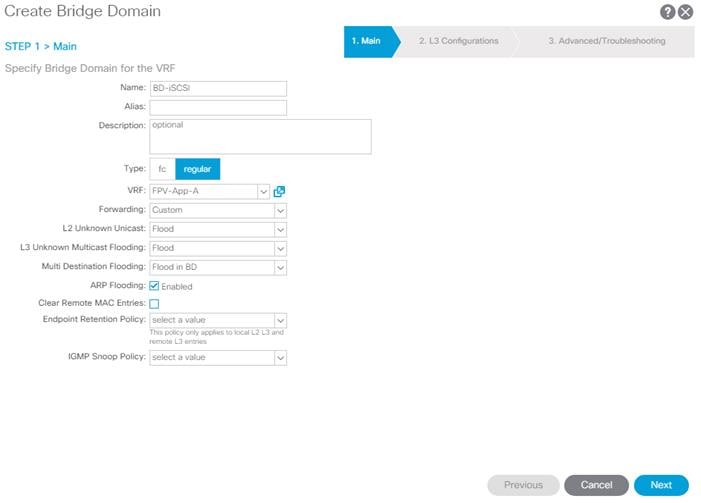
34. At the bottom right, click Next.
35. Under L3 Configurations, make sure Limit IP Learning to Subnet is selected and select EP Move Detection Mode – GARP based detection. Select Next.
36. Select the default Monitoring Policy and click Finish.

37. Select the default Monitoring Policy and click Finish to complete creating the EPG.
38. On the left, expand Application EPGs and EPG iSCSI-LIF. Right-click Domains and select Add Physical Domain Association.
39. Using the drop-down list, select the NetApp-AFF Physical Domain Profile.
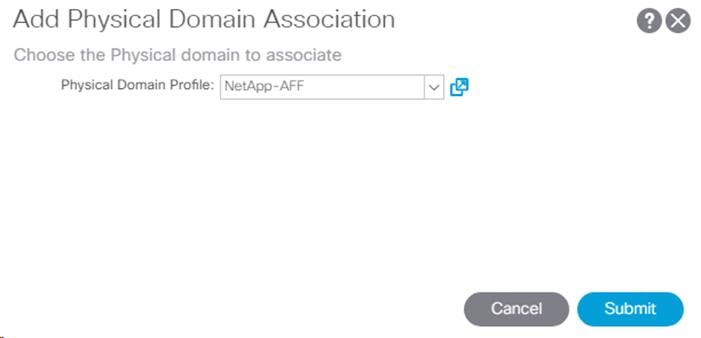
40. Click Submit to complete the Physical Domain Association.
41. Right-click Static-Ports and select Deploy Static EPG on PC, VPC, or Interface.
42. In the Deploy Static EPG on PC, VPC, Or Interface Window, select the Virtual Port Channel Path Type.
43. Using the Path drop-down list, select the VPC for NetApp Storage Controller 01.
44. Enter <storage-FPV-App-A-iSCSI-VLAN> for Port Encap.
45. Select the Immediate Deployment Immediacy and the Trunk Mode.
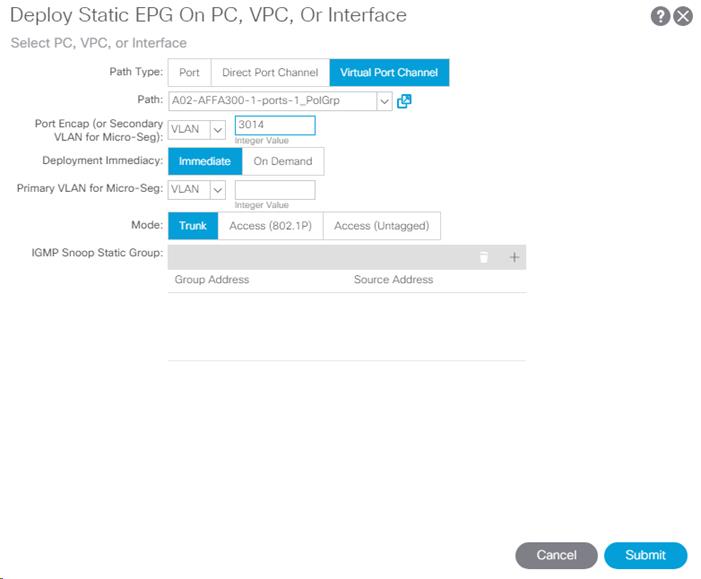
46. Click Submit to complete adding the Static Port Mapping.
47. Repeat steps 41-46 to add the Static Path Mapping for NetApp Storage Controller 02.

48. Under EPG iSCSI-LIF, right-click Contracts and select Add Provided Contract.
49. Use the drop-down list to select Create Contract.
50. Name the contract Allow-iSCSI. Set the Scope of the contract to Tenant. Click the “+” to add a Subject.
51. Name the Subject Allow-iSCSI. Click the “+” in the Filter Chain to add a filter.
52. Using the drop-down list, select the iSCSI filter from Tenant common. Click Update.
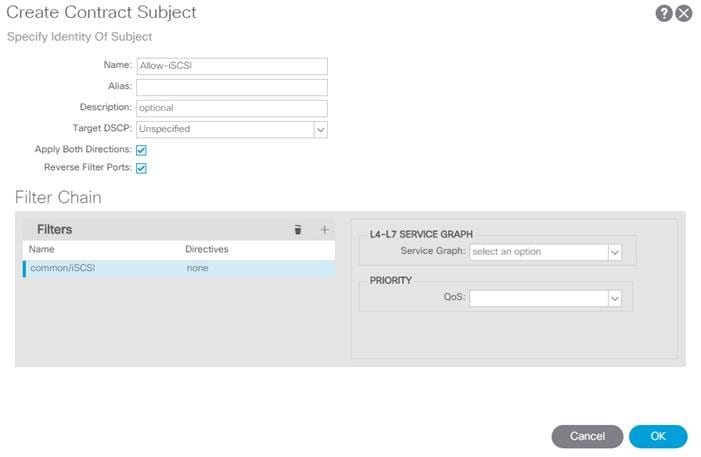
![]() Optionally, add ICMP to the filter chain to allow ping in this contract for troubleshooting purposes.
Optionally, add ICMP to the filter chain to allow ping in this contract for troubleshooting purposes.
53. Click OK to complete creating the Contract Subject.
54. Click Submit to complete creating the Contract.
55. Click Submit to complete adding the Provided Contract.
56. Right-click Application EPGs and select Create Application EPG.
57. Name the EPG iSCSI-VMK-VM. Leave Intra EPG Isolation Unenforced.
58. Use the Bridge Domain drop-down list to select the tenant BD-iSCSI Bridge Domain.
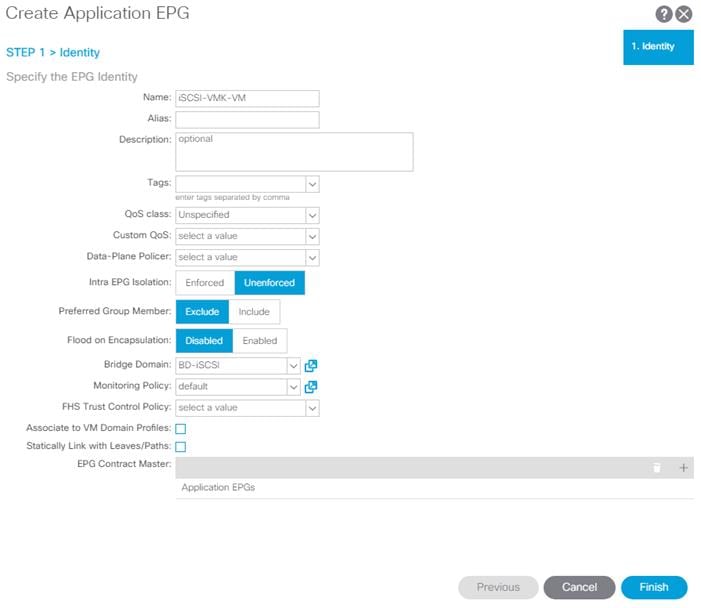
59. Select the default Monitoring Policy and click Finish to complete creating the EPG.
60. On the left, expand Application EPGs and EPG iSCSI-VMK-VM. Right-click Domains and select Add VMM Domain Association.
61. From the drop-down list, select fpv-vc-vDS. Set Deploy Immediacy to Immediate.

62. Click Submit to complete the VMM Domain Association.
63. Under EPG iSCSI-VMK-VM, right-click Contracts and select Add Consumed Contract.
64. Use the drop-down list to select Allow-iSCSI within the tenant.
65. Click Submit to complete adding the Consumed Contract.
![]() In this deployment for iSCSI, you are putting the LIFs in one EPG and the Host/VM Interfaces in a second EPG and connecting them with a filtered contract. You also could have added both the NetApp LIF endpoints and the Host/VM Interface endpoints in a single EPG. This method would have allowed unrestricted communication within the EPG.
In this deployment for iSCSI, you are putting the LIFs in one EPG and the Host/VM Interfaces in a second EPG and connecting them with a filtered contract. You also could have added both the NetApp LIF endpoints and the Host/VM Interface endpoints in a single EPG. This method would have allowed unrestricted communication within the EPG.
66. On the left, under Tenant FPV-App-A, right-click the Host-Conn Application Profile and select Create Application EPG.
67. Name the EPG NFS-LIF and leave Intra EPG Isolation set at Unenforced.
68. Use the Bridge Domain drop-down list to select Create Bridge Domain.
69. Name the Bridge Domain BD-NFS and select the FPV-App-A VRF.
![]() It is important to create a new Bridge Domain for each traffic VLAN coming from the NetApp Storage Controllers. All of the VLAN interfaces on a given NetApp Interface Group share the same MAC address, and separating to different bridge domains in the ACI Fabric allows all the traffic to be forwarded properly.
It is important to create a new Bridge Domain for each traffic VLAN coming from the NetApp Storage Controllers. All of the VLAN interfaces on a given NetApp Interface Group share the same MAC address, and separating to different bridge domains in the ACI Fabric allows all the traffic to be forwarded properly.
70. For Forwarding, select Custom and select Flood for L2 Unknown Unicast. Select default for the End Point Retention Policy and the IGMP Snoop Policy.
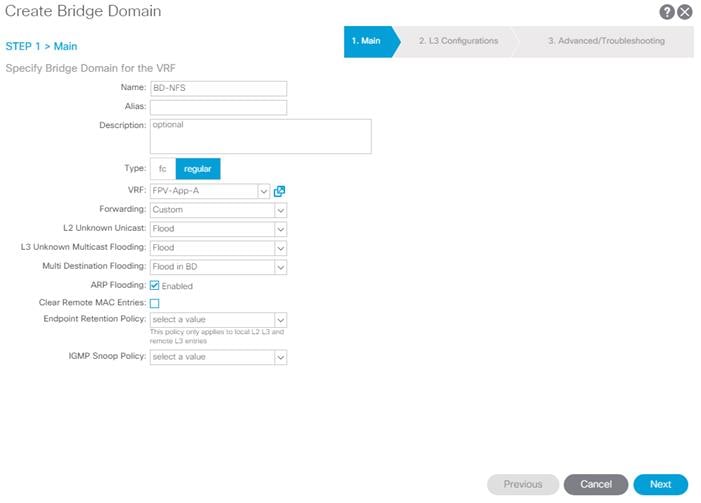
71. At the bottom right, click Next.
72. Under L3 Configurations, make sure Limit IP Learning to Subnet is selected and select EP Move Detection Mode – GARP based detection. Select Next.
73. Select the default Monitoring Policy and click Finish.
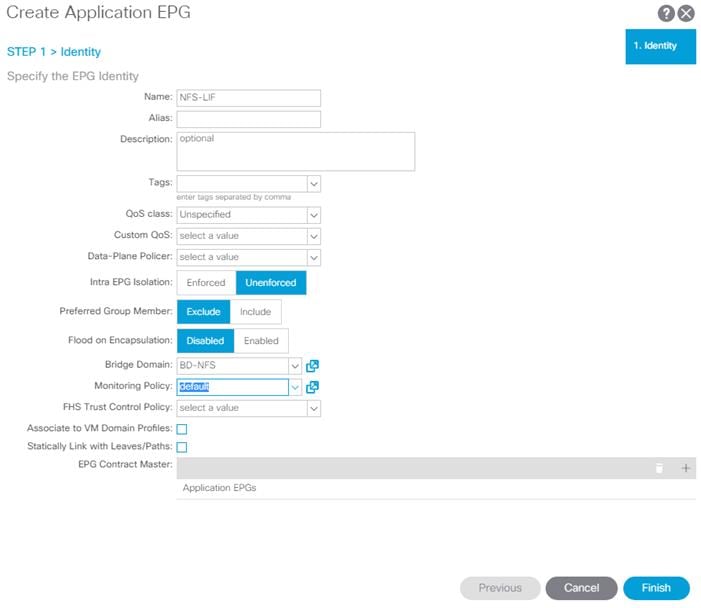
74. Select the default Monitoring Policy and click Finish to complete creating the EPG.
75. On the left expand Host-Conn, Application EPGs, and EPG NFS-LIF.
76. Right-click Domains and select Add Physical Domain Association.
77. Select the NetApp-AFF Physical Domain Profile.
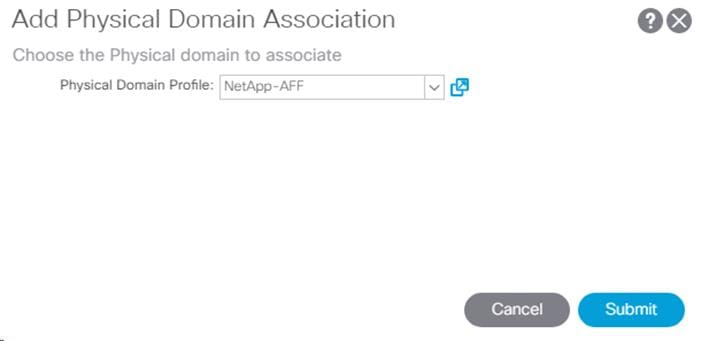
78. Click Submit to compete adding the Physical Domain Association.
79. Right-click Static Ports and select Deploy Static EPG on PC, VPC, or Interface.
80. Select the Virtual Port Channel Path Type.
81. Using the Path drop-down list, select the VPC for NetApp Storage Controller 01.
82. For Port Encap, enter <storage-FPV-App-A-NFS-VLAN>.
83. Select Immediate for Deployment Immediacy and Trunk for Mode.
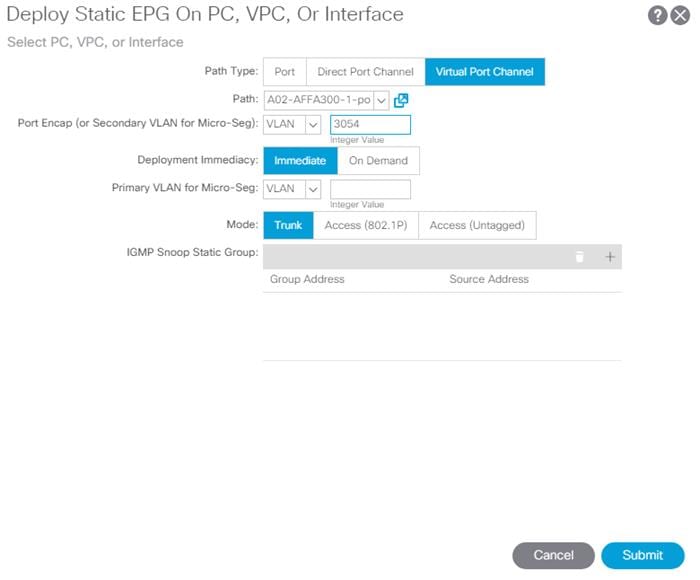
84. Click Submit to finish adding the EPG Static Binding.
85. Repeat steps 79-84 for the Static Port for NetApp Storage Controller 02.
86. On the left under EPG NFS-LIF, right-click Contracts and select Add Provided Contract.
87. In the Add Provided Contract window, use the Contract drop-down list to select Create Contract.
88. Name the contract Allow-NFS. Set the Scope to Tenant.
89. Click the “+” sign to add a Contract Subject.
90. Name the subject Allow-NFS.
91. Click the “+” sign to add a Filter to the Filter Chain.
92. Click the drop-down list and select NTAP-NFS-v3 from Tenant common.
93. Click Update.
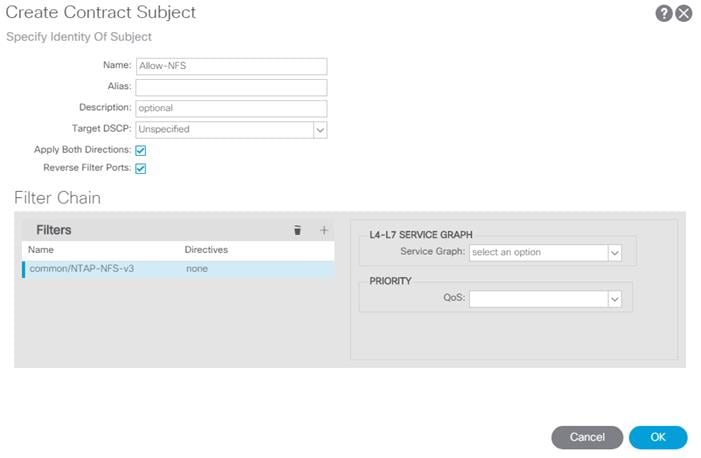
![]() Optionally, add ICMP to the filter chain to allow ping in this contract for troubleshooting purposes.
Optionally, add ICMP to the filter chain to allow ping in this contract for troubleshooting purposes.
94. Click OK to complete the Contract Subject.
95. Click Submit to complete creating the Contract.
96. Click Submit to complete Adding the Provided Contract.
97. Right-click Application EPGs under the Host-Conn Application Profile and select Create Application EPG.
98. Name the EPG NFS-VMK-VM and leave Intra EPG Isolation set at Unenforced.
99. Use the Bridge Domain drop-down list to select BD-NFS in the same tenant. Select the default Monitoring Policy.
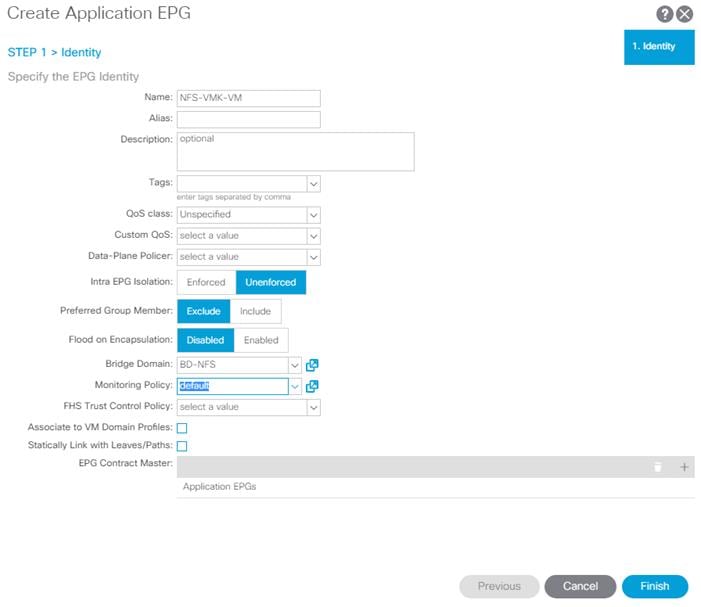
100. Click Finish to complete creating the EPG.
101. On the left expand Host-Conn, Application EPGs, and EPG NFS-VMK-VM.
102. Under EPG NFS-VMK-VM, right-click Domains and select Add VMM Domain Association.
103. Select the fpv-vc-vDS VMM Domain Profile.
104. Select Immediate for both the Deploy Immediacy and the Resolution Immediacy.
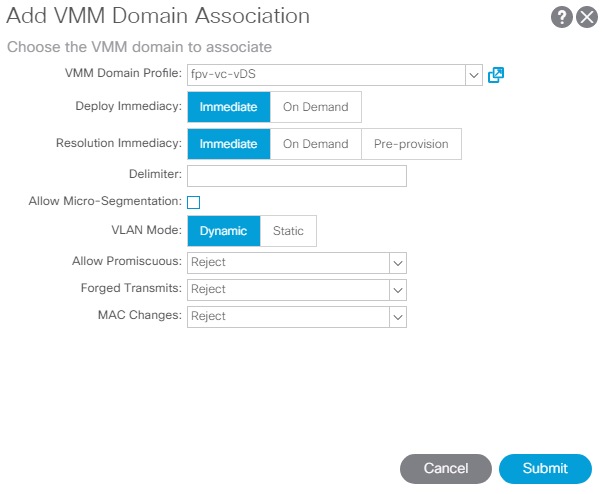
105. Click Submit to complete adding the VMM Domain Association.
106. On the left under EPG NFS-VMK-VM, right-click Contracts and select Add Consumed Contract.
107. In the Add Consumed Contract window, from the Contract drop-down list, select Allow-NFS in the FPV-App-A Tenant.
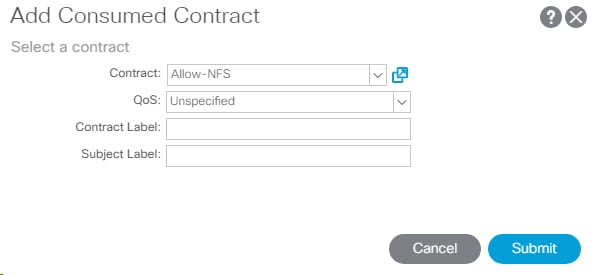
108. Click Submit to complete adding the Consumed Contract.
109. On the left, under Tenant FPV-App-A, right-click Application Profiles and select Create Application Profile.
110. Name the Profile MGMT, select the default Monitoring Policy, and click SUBMIT.
111. Right-click the MGMT Application Profile and select Create Application EPG.
112. Name the EPG SVM-MGMT and leave Intra EPG Isolation set at Unenforced.
113. Use the Bridge Domain drop-down list to select create Bridge Domain.
114. Name the Bridge Domain BD-Internal and select the FPV-App-A VRF.
115. Leave Forwarding set at Optimize, select the default End Point Retention Policy and IGMP Snoop Policy.
116. Click Next.
117. Make sure Unicast Routing is enabled and click Next.
118. Select the default Monitoring Policy and click Finish to complete creating the Bridge Domain.

119. Select the default Monitoring Policy and click Finish to complete creating the EPG.
120. On the left expand MGMT, Application EPGs, and EPG SVM-MGMT.
121. Right-click Domains and select Add Physical Domain Association.
122. Select the NetApp-AFF Physical Domain Profile.
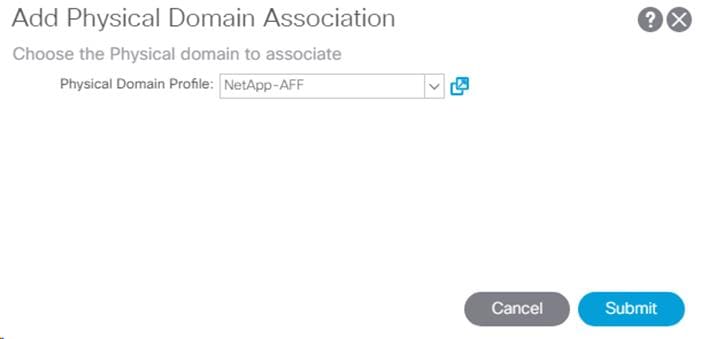
123. Click Submit to compete adding the Physical Domain Association.
124. Right-click Static Ports and select Deploy Static EPG on PC, VPC, or Interface.
125. Select the Virtual Port Channel Path Type.
126. Using the Path drop-down list, select the VPC for NetApp Storage Controller 01.
127. For Port Encap, enter <storage-FPV-App-A-SVM-MGMT-VLAN>.
128. Select Immediate for Deployment Immediacy and Trunk for Mode.
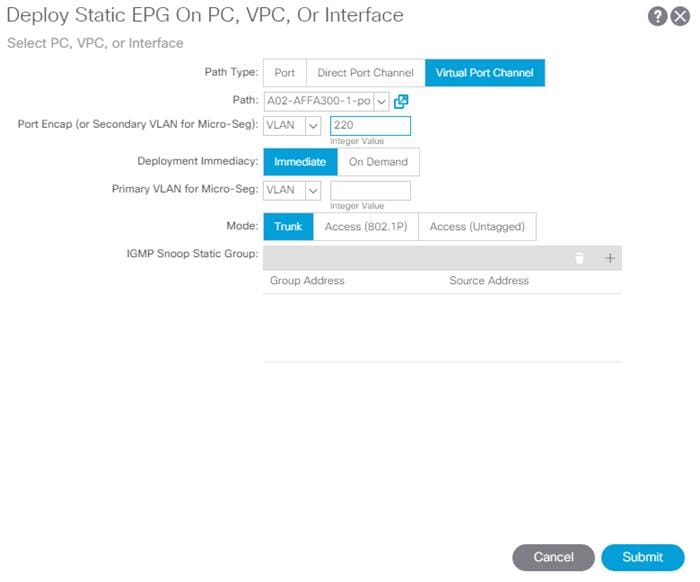
129. Click Submit to finish adding the EPG Static Binding.
130. Repeat steps 124-129 for the Static Port Mapping to NetApp Storage Controller 02.
131. On the left under EPG SVM-MGMT, right-click Contracts and select Add Provided Contract.
132. In the Add Provided Contract window, use the Contract drop-down list to select Create Contract.
133. Name the contract Allow-SVM-MGMT. Set the Scope set to Tenant.
134. Click the “+” sign to add a Contract Subject.
135. Name the subject Allow-All. Click the “+” sign to add a filter.
136. Use the drop-down list to select the Allow-All filter from Tenant common. Click Update.
137. Click OK to complete adding the Contract Subject.
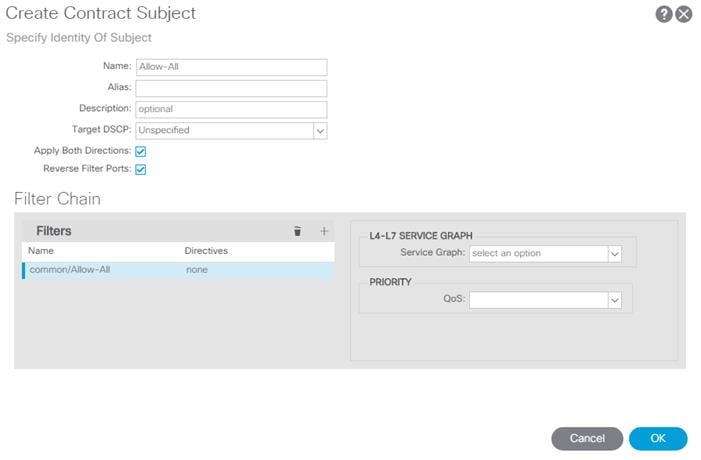
138. Click Submit to complete creating the Contract.
139. Click Submit to complete adding the Provided Contract.
140. On the left under EPG SVM-MGMT, right-click Subnets and select Create EPG Subnet.
141. For the Default Gateway IP, enter the SVM gateway IP address and mask for the FPV-App-A tenant.
142. Select only the Shared between VRFs scope.
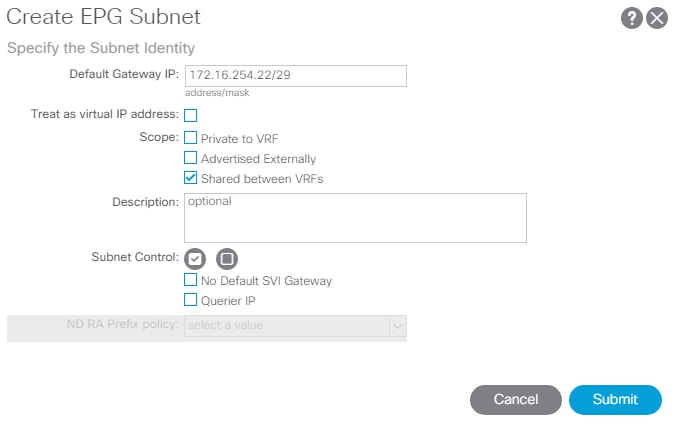
143. Click Submit to complete adding the EPG subnet.
144. On the left under EPG SVM-MGMT, right-click Contracts and select Add Consumed Contract.
145. In the Add Consumed Contract window, use the Contract drop-down list to select common-Allow -Core-Services in Tenant common.
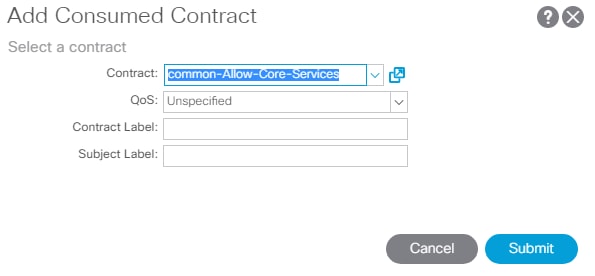
146. Click Submit to complete adding the Consumed Contract.
147. On the left, right-click Application Profiles and select Create Application Profile.
148. Name the Application Profile 3-Tier-App and select the default Monitoring Policy.
149. Click Submit to complete creating the Application Profile.
150. Expand 3-Tier-App, right-click Application EPGs under 3-Tier-App and select Create Application EPG.
151. Name the EPG Web and leave Intra EPG Isolation set at Unenforced.
152. Use the Bridge Domain drop-down list to select BD-Internal in the current tenant. Select the default Monitoring Policy.
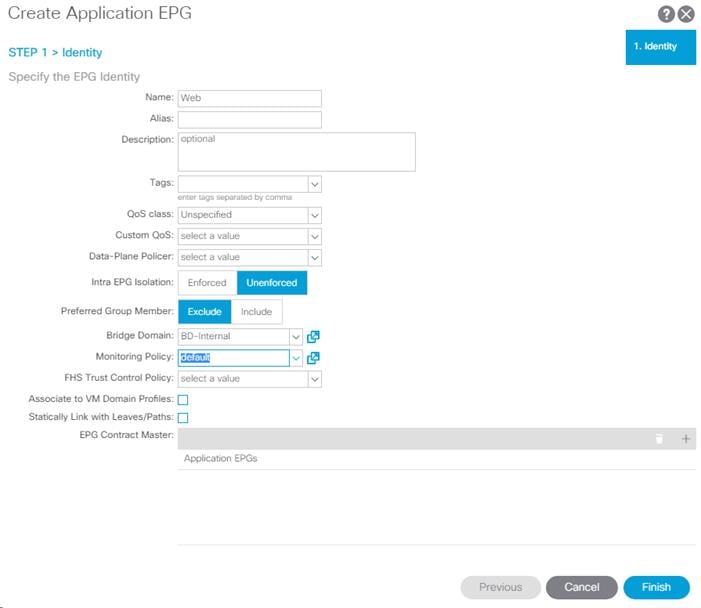
153. Click Finish to complete creating the EPG.
154. On the left expand 3-Tier-App, Application EPGs, and EPG Web.
155. Under EPG Web, right-click Domains and select Add VMM Domain Association.
156. Select the fpv-vc-vDS VMM Domain Profile.
157. Select Immediate for both the Deploy Immediacy and the Resolution Immediacy. Leave VLAN Mode set at Dynamic.
158. Click Submit to compete adding the VMM Domain Association.
159. On the left under EPG Web, right-click Contracts and select Add Provided Contract.
160. In the Add Provided Contract window, use the Contract drop-down list to select Create Contract.
161. Name the Contract Allow-Web-App. Select the Application Profile Scope.
162. Click the “+” sign to add a Contract Subject.
163. Name the subject Allow-All.
164. Click the “+” sign to add a Contract filter.
165. Use the drop-down list to select the Allow-All filter from Tenant common. Click Update.
166. Click OK to complete creating the Contract Subject.
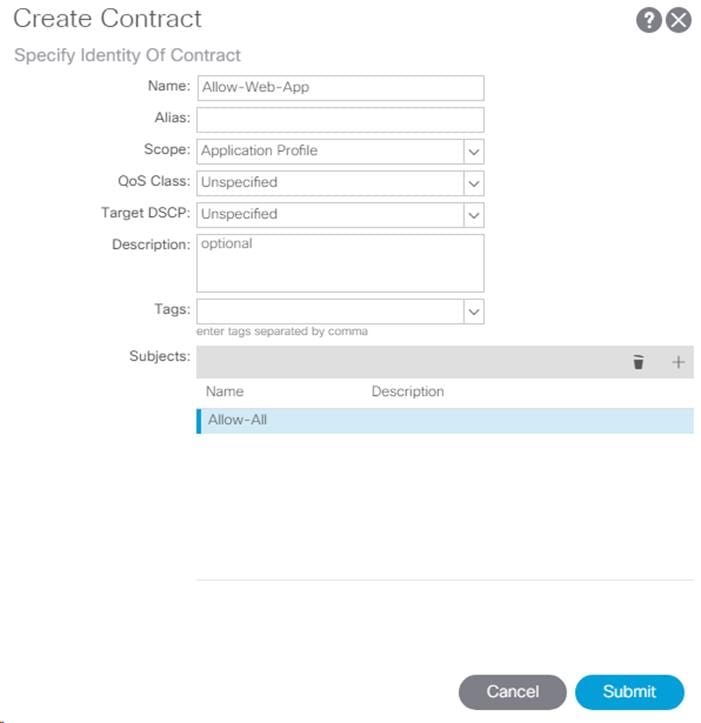
167. Click Submit to complete creating the Contract.
168. Click Submit to complete adding the Provided Contract.
169. Right-click Contracts and select Add Consumed Contract.
170. In the Add Consumed Contract window, use the Contract drop-down list to select the common/Allow-FP-Shared-L3-Out contract.
171. Click Submit to complete adding the Consumed Contract.
172. Optionally, repeat steps 169-171 to add the common/common-Allow-Core-Services Consumed Contract.
173. On the left under EPG Web, right-click Subnets and select Create EPG Subnet.
174. For the Default Gateway IP, enter a gateway IP address and mask from a subnet in the Supernet (172.16.0.0/16) that was set up for assigning Tenant IP addresses.
175. For scope, select Advertised Externally and Shared between VRFs.
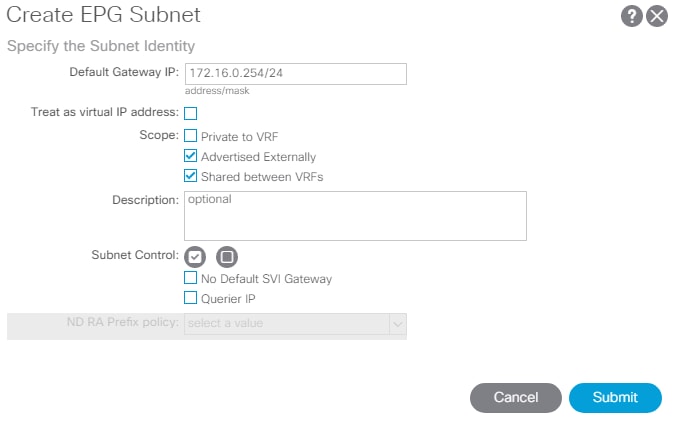
176. Click Submit to complete creating the EPG Subnet.
177. Right-click Application EPGs under 3-Tier-App and select Create Application EPG.
178. Name the EPG App and leave Intra EPG Isolation set at Unenforced.
179. Use the Bridge Domain drop-down list to select BD-Internal within the current Tenant. Select the default Monitoring Policy.
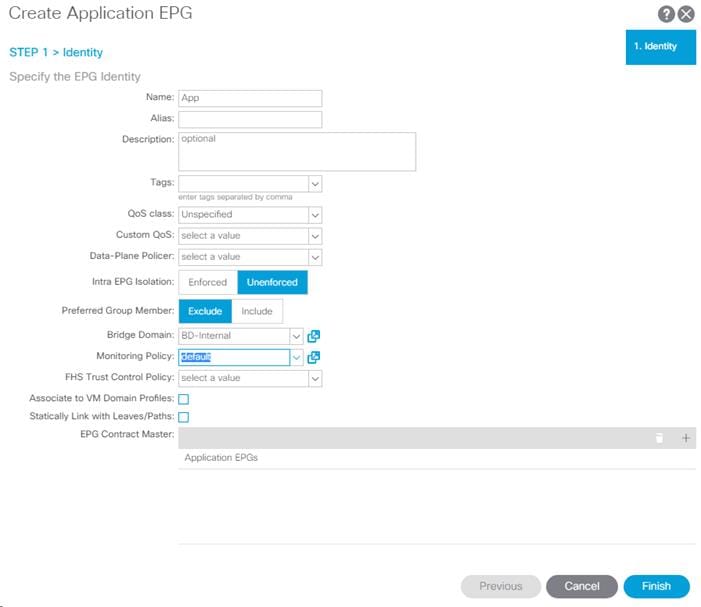
180. Click Finish to complete creating the EPG.
181. On the left expand 3-Tier-App, Application EPGs, and EPG App.
182. Under EPG App, right-click Domains and select Add VMM Domain Association.
183. Select the fpv-vc-vDS VMM Domain Profile.
184. Select Immediate for both the Deploy Immediacy and the Resolution Immediacy. Select the Dynamic VLAN Mode.
185. Click Submit to compete adding the VMM Domain Association.
186. On the left under EPG App, right-click Contracts and select Add Provided Contract.
187. In the Add Provided Contract window, use the Contract drop-down list to select Create Contract.
188. Name the Contract Allow-App-DB. Select the Application Profile Scope.
189. Click the “+” sign to add a Contract Subject.
190. Name the subject Allow-All.
191. Click the “+” sign to add a Contract filter.
192. Use the drop-down list to select the Allow-All filter from Tenant common. Click Update.
193. Click OK to complete creating the Contract Subject.
194. Click Submit to complete creating the Contract.
195. Click Submit to complete adding the Provided Contract.
196. Right-click Contracts and select Add Consumed Contract.
197. In the Add Consumed Contract window, use the Contract drop-down list to select the Allow-Web-App contract in the current tenant.
198. Click Submit to complete adding the Consumed Contract.
199. Optionally, repeat steps 196-198 to add the common/common-Allow -Core-Services Consumed Contract.
200. On the left under EPG App, right-click Subnets and select Create EPG Subnet.
201. For the Default Gateway IP, enter a gateway IP address and mask from a subnet in the Supernet (172.16.0.0/16) that was set up for assigning Tenant IP addresses.
202. If this EPG was connected to Core-Services by contract, select only the Shared between VRFs scope. Otherwise, if the tenant SVM management interface will only be accessed from EPGs within the tenant, leave only the Private to VRF Scope selected.
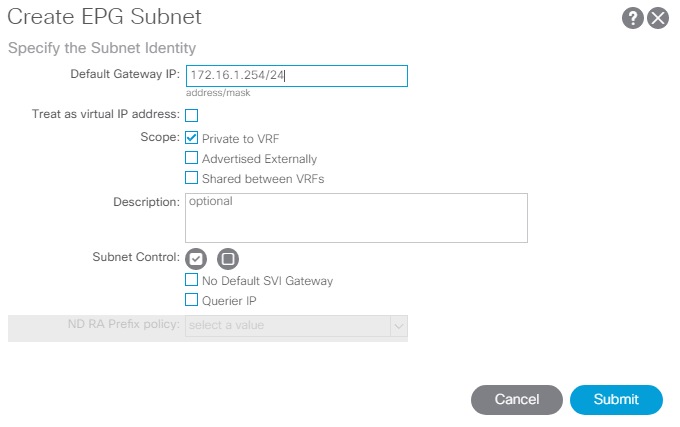
203. Click Submit to complete creating the EPG Subnet.
204. Right-click Application EPGs under 3-Tier-App and select Create Application EPG.
205. Name the EPG DB and leave Intra EPG Isolation set at Unenforced.
206. Use the Bridge Domain drop-down list to select BD-Internal in the current tenant. Select the default Monitoring Policy.
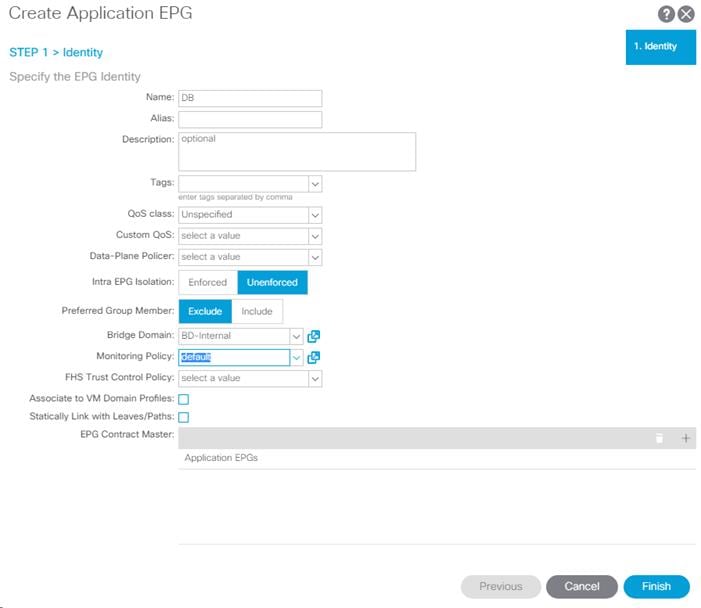
207. Click Finish to complete creating the EPG.
208. On the left expand 3-Tier-App, Application EPGs, and EPG DB.
209. Under EPG DB, right-click Domains and select Add VMM Domain Association.
210. Select the fpv-vc-vDS VMM Domain Profile.
211. Select Immediate for both the Deploy Immediacy and the Resolution Immediacy. Select the Dynamic VLAN Mode.
212. Click Submit to compete adding the VMM Domain Association.
213. On the left under EPG DB, right-click Contracts and select Add Consumed Contract.
214. In the Add Consumed Contract window, use the Contract drop-down list to select the Allow-App-DB contract in the current tenant.
215. Click Submit to complete adding the Consumed Contract.
216. Repeat steps 213-215 to add the common/common-Allow-Core-Services (optional) and Allow-SVM-MGMT in the current tenant Consumed Contracts.
217. On the left under EPG DB, right-click Subnets and select Create EPG Subnet.
218. For the Default Gateway IP, enter a gateway IP address and mask from a subnet in the Supernet (172.16.0.0/16) that was set up for assigning Tenant IP addresses.
219. If the common-Allow-Core-Services contract was consumed, select only the Shared between VRFs scope. Otherwise, select only the Private to VRF scope.
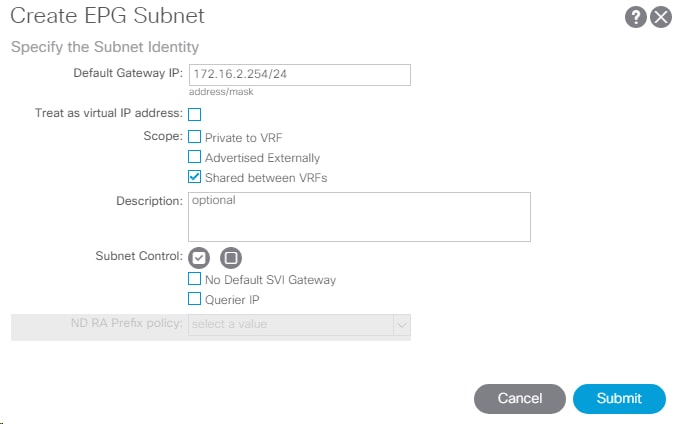
220. Click Submit to complete creating the EPG Subnet.
Configure Tenant Storage
This section describes the procedure for deploying a NetApp storage SVM for a tenant named FPV-App-A. In this section, VLAN interface ports, a separate IPspace, the tenant SVM, storage protocols within the SVM, tenant logical interfaces (LIFs), and tenant data volumes are deployed. All procedures in this section are completed using a SSH connection to the storage cluster CLI.
Storage Cluster CLI
Create Tenant IPspace
To create the tenant IPspace, run the following commands:
ipspace create –ipspace FPV-App-A
ipspace show
Create Tenant Broadcast Domains in ONTAP
To create data broadcast domains in the tenant IPspace, run the following commands. If you are not setting up access to iSCSI application data LUNs in this tenant, do not create the iSCSI broadcast domains.
broadcast-domain create –ipspace FPV-App-A -broadcast-domain FPV-App-A-NFS -mtu 9000
broadcast-domain create –ipspace FPV-App-A –broadcast-domain FPV-App-A-SVM-MGMT –mtu 1500
broadcast-domain create –ipspace FPV-App-A -broadcast-domain FPV-App-A-iSCSI -mtu 9000
broadcast-domain show -ipspace FPV-App-A
Create VLAN Interfaces
To create tenant-storage VLAN interfaces, complete the following steps:
1. Create NFS VLAN ports and add them to the data broadcast domain.
network port vlan create –node <node01> -vlan-name a0a-<storage-FPV-App-A-nfs-vlan-id>
network port vlan create –node <node02> -vlan-name a0a-<storage-FPV-App-A-nfs-vlan-id>
broadcast-domain add-ports –ipspace FPV-App-A -broadcast-domain FPV-App-A-NFS -ports <node01>:a0a-<storage-FPV-App-A-nfs-vlan-id>, <node02>:a0a-<storage-FPV-App-A-nfs-vlan-id>
2. Create SVM management VLAN ports and add them to the data broadcast domain.
network port vlan create –node <node01> -vlan-name a0a-<storage-FPV-App-A-svm-mgmt-vlan-id>
network port vlan create –node <node02> -vlan-name a0a-<storage-FPV-App-A-svm-mgmt-vlan-id>
broadcast-domain add-ports –ipspace FPV-App-A -broadcast-domain FPV-App-A-SVM-MGMT -ports <node01>:a0a-<storage-FPV-App-A-svm-mgmt-vlan-id>, <node02>:a0a-<storage-FPV-App-A-svm-mgmt-vlan-id>
3. Create tenant iSCSI VLAN ports and add them to the data broadcast domain. If you are not setting up access to iSCSI application data LUNs in this tenant, do not create the iSCSI VLAN ports.
network port vlan create –node <node01> -vlan-name a0a-<storage-FPV-App-A-iscsi-vlan-id>
network port vlan create –node <node02> -vlan-name a0a-<storage-FPV-App-A-iscsi-vlan-id>
broadcast-domain add-ports –ipspace FPV-App-A -broadcast-domain FPV-App-A-iSCSI -ports <node01>:a0a-<storage-FPV-App-A-iscsi-vlan-id>,<node02>:a0a-<storage-FPV-App-A-iscsi-vlan-id>
broadcast-domain show –ipspace FPV-App-A
Create Storage Virtual Machine
To create an infrastructure SVM, complete the following steps:
1. Run the vserver create command.
vserver create –vserver FPV-App-A-SVM –rootvolume rootvol –aggregate aggr1_node02 –rootvolume-security-style unix –ipspace FPV-App-A
2. Remove the unused data protocols (CIFS, NDMP, and optionally FCP) from the SVM.
vserver remove-protocols -vserver FPV-App-A-SVM -protocols cifs,ndmp,fcp
3. Add the two data aggregates to the FPV-App-A-SVM aggregate list.
vserver modify –vserver FPV-App-A-SVM –aggr-list aggr1_node01,aggr1_node02
Setup SVM Management Access
1. Create the SVM Management interface.
network interface create -vserver FPV-App-A-SVM -lif SVM-MGMT -role data -data-protocol none -home-node <st-node-02> -home-port a0a-<FPV-App-A-SVM-svm-mgmt-vlan-id> -address <svm-mgmt-ip> -netmask <svm-mgmt-mask> -status-admin up -failover-policy broadcast-domain-wide -firewall-policy mgmt -auto-revert true
2. Place an entry in your AD DNS server for the FPV-App-A-SVM management interface.
3. Create SVM default route.
network route create -vserver FPV-App-A-SVM -destination 0.0.0.0/0 -gateway 172.16.254.22
network route show
Vserver Destination Gateway Metric
------------------- --------------- --------------- ------
FPV-App-A-SVM
0.0.0.0/0 172.16.254.22 20
FPV-Foundation-SVM
0.0.0.0/0 172.16.254.6 20
a02-affa300
0.0.0.0/0 192.168.1.254 20
3 entries were displayed.
4. Create snapdrive SVM user and unlock vsadmin SVM user.
security login create -user snapdrive -application http -authentication-method password -role vsadmin -vserver FPV-App-A-SVM
Please enter a password for user 'snapdrive':
Please enter it again:
security login create -user snapdrive -application ontapi -authentication-method password -role vsadmin -vserver FPV-App-A-SVM
security login password -username vsadmin -vserver FPV-App-A-SVM
Enter a new password:
Enter it again:
security login unlock -username vsadmin -vserver FPV-App-A-SVM
Create the NFS Service
You can enable and configure NFSv3 servers on storage virtual machines (SVMs) with NetApp FlexVol® volumes to let NFS clients access files on your cluster. It is a best practice to configure the DNS service on an SVM. To configure DNS and NFS, complete the following steps:
1. Configure the DNS for your SVM.
dns create -vserver FPV-App-A-SVM -domains <domain_name> -name-servers <dns_server1_ip>,<dns_server2_ip>
![]() The SVM Management EPG was connected to the Core Services EPG by contract, allowing access to the DNS servers. For more than one DNS server, separate the IPs by comma.
The SVM Management EPG was connected to the Core Services EPG by contract, allowing access to the DNS servers. For more than one DNS server, separate the IPs by comma.
2. Create the NFS service.
vserver nfs create -vserver FPV-App-A-SVM –udp disabled
3. Add support for the NetApp NFS VAAI plugin.
vserver nfs modify –vserver FPV-App-A-SVM –vstorage enabled
4. Modify SVM root volume to use default NFS export policy.
volume modify -vserver FPV-App-A-SVM -volume rootvol -policy default
Modify NFS Export Policy
To modify the default NFS export policy that limits access to devices in the NFS subnet, run the following command:
export-policy rule create -vserver FPV-App-A-SVM -policyname default -clientmatch <tenant-nfs-subnet-cidr> -protocol nfs -rorule sys -rwrule sys -superuser sys -allow-suid false
Create Load-Sharing Mirrors of SVM Root Volume
To create a load-sharing mirror of an SVM root volume, complete the following steps:
1. Create a volume to be the load-sharing mirror of the infrastructure SVM root volume on each node.
volume create –vserver FPV-App-A-SVM –volume rootvol_m01 –aggregate aggr1_node01 –size 1GB –type DP
volume create –vserver FPV-App-A-SVM –volume rootvol_m02 –aggregate aggr1_node02 –size 1GB –type DP
2. Create the mirroring relationships.
snapmirror create –source-path FPV-App-A-SVM:rootvol –destination-path FPV-App-A-SVM:rootvol_m01 –type LS -schedule 15min
snapmirror create –source-path FPV-App-A-SVM:rootvol –destination-path FPV-App-A-SVM:rootvol_m02 –type LS -schedule 15min
3. Initialize the mirroring relationship.
snapmirror initialize-ls-set –source-path FPV-App-A-SVM:rootvol
snapmirror show
Create Block Protocol Service(s)
If the deployment is using iSCSI and iSCSI is being deployed in the tenant SVM, create the iSCSI service on each SVM using the following command. This command also starts the iSCSI service and sets the IQN for the SVM.
iscsi create -vserver FPV-App-A-SVM
iscsi show
If the deployment is using FCP, create the FCP service on each SVM using the following command. This command also starts the FCP service and sets the worldwide name (WWN) for the SVM.
fcp create -vserver FPV-App-A-SVM
fcp show
![]() The licenses for FCP and iSCSI must be installed before the services can be started. If the license(s) weren’t installed during cluster setup, install them before this step.
The licenses for FCP and iSCSI must be installed before the services can be started. If the license(s) weren’t installed during cluster setup, install them before this step.
Configure HTTPS Access
To configure secure access to the storage controller, complete the following steps:
1. Increase the privilege level to access the certificate commands.
set -privilege diag
Do you want to continue? {y|n}: y
2. Generally, a self-signed certificate is already in place. Verify the certificate and obtain parameters (for example, <serial-number>) by running the following command:
security certificate show
3. For each SVM shown, the certificate common name should match the DNS FQDN of the SVM. Delete the two default certificates and replace them with either self-signed certificates or certificates from a certificate authority (CA). To delete the default certificates, run the following commands:
security certificate delete -vserver FPV-App-A-SVM -common-name FPV-App-A-SVM -ca FPV-App-A-SVM -type server -serial <serial-number>
![]() Deleting expired certificates before creating new certificates is a best practice. Run the security certificate delete command to delete the expired certificates. In the previous command, use TAB completion to select and delete each default certificate.
Deleting expired certificates before creating new certificates is a best practice. Run the security certificate delete command to delete the expired certificates. In the previous command, use TAB completion to select and delete each default certificate.
4. To generate and install self-signed certificates, run the following commands as one-time commands. Generate a server certificate for the Infra-MS-SVM and the cluster SVM. Use TAB completion to aid in the completion of these commands.
security certificate create -common-name <cert-common-name> -type server -size 2048 -country <cert-country> -state <cert-state> -locality <cert-locality> -organization <cert-org> -unit <cert-unit> -email-addr <cert-email> -expire-days <cert-days> -protocol SSL -hash-function SHA256 -vserver MS-TNT-A-SVM
5. To obtain the values for the parameters required in step 5 (<cert-ca> and <cert-serial>), run the security certificate show command.
6. Enable each certificate that was just created by using the –server-enabled true and –client-enabled false parameters. Use TAB completion to aid in the completion of these commands.
security ssl modify -vserver <vserver-name> -server-enabled true -client-enabled false -ca <cert-ca> -serial <cert-serial> -common-name <cert-common-name>
7. Change back to the normal admin privilege level and set up the system to allow SVM logs to be available by web.
set –privilege admin
vserver services web modify –name spi|ontapi|compat –vserver * -enabled true
Create NetApp FlexVol Volumes
volume create -vserver FPV-App-A-SVM -volume fpv_app_a_nfs_datastore_1 -aggregate aggr1_node01 -size 500GB -state online -policy default -security-style unix -junction-path /fpv_app_a_nfs_datastore_1 -space-guarantee none -percent-snapshot-space 0
volume create -vserver FPV-App-A-SVM -volume fpv_app_a_nfs_datastore_2 -aggregate aggr1_node02 -size 500GB -state online -policy default -security-style unix -junction-path /fpv_app_a_nfs_datastore_2 -space-guarantee none -percent-snapshot-space 0
snapmirror update-ls-set -source-path FPV-App-A-SVM:rootvol
Schedule Deduplication
On NetApp All Flash FAS systems, deduplication is enabled by default. To schedule deduplication, complete the following steps:
1. After the volumes are created, assign to them a once-a-day deduplication schedule:
efficiency modify –vserver FPV-App-A-SVM –volume fpv_app_a_nfs_datastore_1 –schedule sun-sat@0
efficiency modify –vserver FPV-App-A-SVM –volume fpv_app_a_nfs_datastore_1 –schedule sun-sat@0
Create SAN LIFs
If using iSCSI, run the following commands to create four iSCSI LIFs (two on each node):
network interface create -vserver FPV-App-A-SVM -lif iscsi_lif01 -role data -data-protocol iscsi -home-node <st-node01> -home-port a0a-<iSCSI-VLAN> –address <iscsi-lif01-ip> -netmask <iscsi-lif01-mask> –status-admin up
network interface create -vserver FPV-App-A-SVM -lif iscsi_lif02 -role data -data-protocol iscsi -home-node <st-node02> -home-port a0a-<iSCSI-VLAN> –address <iscsi-lif02-ip> -netmask <iscsi-lif02-mask> –status-admin up
If using FCP, run the following commands to create four FC LIFs (two on each node):
network interface create -vserver FPV-App-A-SVM -lif fcp_lif01a -role data -data-protocol fcp -home-node <st-node01> -home-port 0e –status-admin up
network interface create -vserver FPV-App-A-SVM -lif fcp_lif01b -role data -data-protocol fcp -home-node <st-node01> -home-port 0f –status-admin up
network interface create -vserver FPV-App-A-SVM -lif fcp_lif02a -role data -data-protocol fcp -home-node <st-node02> -home-port 0e –status-admin up
network interface create -vserver FPV-App-A-SVM -lif fcp_lif02b -role data -data-protocol fcp -home-node <st-node02> -home-port 0f –status-admin up
Create NFS LIFs
To create NFS LIFs, run the following commands:
network interface create -vserver FPV-App-A-SVM -lif nfs_lif01 -role data -data-protocol nfs -home-node <st-node01> -home-port a0a-<tenant-nfs-vlan-id> –address <node01-nfs-lif01-ip> -netmask <node01-nfs-lif01-mask> -status-admin up –failover-policy broadcast-domain-wide –firewall-policy data –auto-revert true
network interface create -vserver FPV-App-A-SVM -lif nfs_lif02 -role data -data-protocol nfs -home-node <st-node02> -home-port a0a-<tenant-nfs-vlan-id> –address <node02-nfs-lif02-ip> -netmask <node02-nfs-lif02-mask> -status-admin up –failover-policy broadcast-domain-wide –firewall-policy data –auto-revert true
network interface show
Add Quality of Service (QoS) Policy to Monitor Application Workload
To add a storage QoS policy to monitor both the IOPs and bandwidth delivered from the APP-A-SVM, complete the following steps:
1. Create the QoS policy-group to measure the SVM output without an upper limit.
qos policy-group create -policy-group FPV-App-A -vserver FPV-App-A-SVM -max-throughput INF
vserver modify –vserver FPV-App-A-SVM –qos-policy-group FPV-App-A
2. Monitor the QoS policy group output.
qos statistics performance show
Configure Cisco UCS for the Tenant
This section describes procedures for deploying Cisco UCS Servers for a tenant named FPV-App-A. It is assumed in this FlexPod Deployment that a tenant is most likely an application or group of applications. Because of this assumption, it is assumed that a new set of ESXi servers will be setup for the tenant in a separate ESXi cluster. An ESXi cluster can also be set up to host more than one tenant. It is also assumed in this implementation that the new ESXi servers will be booted from the storage Infrastructure SVM, although server boot could be moved into the tenant SVM.
In this design, the same Cisco UCS service profile template that was used for the management ESXi hosts can be used to generate new service profiles for the tenant hosts. In order to accommodate, different server requirements and to allow the usage of different server pools for tenant hosts, the management host server profile template will be cloned and modified to use a different server pool. All procedures in this section are completed using the Cisco UCS Manager HTML 5 User Interface.
Add New Tenant-Specific Server Pool
Since a clone of the management Service Profile Template will be used for a tenant, a new tenant-specific server pool can be created and mapped in the new cloned Service Profile Template. Create this pool.
Create Tenant Service Profile Template
It is recommended to clone the existing management Service Profile Template for the servers running the applications in the new tenant. These templates can be created by cloning the existing Service Profile Template and modifying it by adding the new tenant-specific server pool.
Create New Service Profiles for Tenant Servers
Using the cloned and modified Tenant Service Profile Template, create Service Profiles associated to servers for the new tenant.
Gather Necessary Information
After the Cisco UCS service profiles have been created, each infrastructure blade in the environment will have a unique configuration. To proceed with the FlexPod deployment, specific information must be gathered from each Cisco UCS blade and from the NetApp controllers. Insert the required information into the following tables.
Table 5 iSCSI LIFs for iSCSI IQN
| SVM | iSCSI Target IQN |
| FPV-Foundation-SVM |
|
| FPV-App-A-SVM |
|
To gather the iSCSI IQN, run the iscsi show command on the storage cluster management interface.
Table 6 vNIC iSCSI IQNs for fabric A and fabric B
| Cisco UCS Service Profile Name | iSCSI IQN |
| fpv-esxi-03 |
|
| fpv-esxi-04 |
|
To gather the vNIC IQN information, launch the Cisco UCS Manager GUI. In the navigation pane, click the Servers tab. Expand Servers > Service Profiles > root. Click each service profile and then click the “iSCSI vNICs” tab on the right. Note “Initiator Name” displayed at the top of the page under “Service Profile Initiator Name.”
Configure Storage SAN Boot for the Tenant
This section details the steps for setting up SAN boot for the tenant ESXi Host servers.
ESXi Boot LUN in FPV-Foundation-SVM Tenant Hosts
1. From the cluster management node SSH connection, enter the following:
lun create -vserver FPV-Foundation-SVM -volume esxi_boot -lun fpv-esxi-03 -size 15GB -ostype vmware -space-reserve disabled
lun create -vserver FPV-Foundation-SVM -volume esxi_boot -lun fpv-esxi-04 -size 15GB -ostype vmware -space-reserve disabled
lun show
Clustered Data ONTAP iSCSI Boot Storage Setup
Create igroups
1. From the cluster management node SSH connection, enter the following:
igroup create –vserver FPV-Foundation-SVM –igroup fpv-esxi-03 –protocol iscsi –ostype vmware –initiator <fpv-esxi-03-iqn>
igroup create –vserver FPV-Foundation-SVM –igroup fpv-esxi-04 –protocol iscsi –ostype vmware –initiator <fpv-esxi-04-iqn>
igroup create –vserver FPV-App-A-SVM –igroup fpv-esxi-03 –protocol iscsi –ostype vmware –initiator <fpv-esxi-03-iqn>
igroup create –vserver FPV-App-A-SVM –igroup fpv-esxi-04 –protocol iscsi –ostype vmware –initiator <fpv-esxi-04-iqn>
igroup create –vserver FPV-App-A-SVM –igroup FPV-App-A-Host-All –protocol iscsi –ostype vmware –initiator <fpv-esxi-03-iqn>,<fpv-esxi-04-iqn>
![]() Use the values listed in Table 8 and Table 9 for the IQN information.
Use the values listed in Table 8 and Table 9 for the IQN information.
![]() To view the igroups just created, type igroup show.
To view the igroups just created, type igroup show.
Map Boot LUNs to igroups
1. From the storage cluster management SSH connection, enter the following:
lun map –vserver FPV-Foundation-SVM –volume esxi_boot –lun fpv-esxi-03–igroup fpv-esxi-03 –lun-id 0
lun map –vserver FPV-Foundation-SVM –volume esxi_boot –lun fpv-esxi-04–igroup fpv-esxi-04 –lun-id 0
lun show –m
Install and Configure VMware ESXi on Tenant Hosts
To install and configure VMware ESXi on tenant hosts, complete the following steps:
1. Using the UCS KVM’s ISO mapping capability, follow the section of this document titled VMware vSphere 6.5 Update 1 Setup to install and configure the FPV-App-A tenant ESXi hosts. Configure the tenant ESXi hosts in the same IB-MGMT subnet as the management hosts. It is not necessary to add the FPV-Foundation tenant NFS VMkernel ports unless it is desired for the tenant hosts to have access to the infrastructure or management datastores. Access to the infrastructure datastores may be desired since the patches and drivers were placed in infra_datastore_1.
2. Add the ESXi hosts to vCenter in a new FPV-App-A cluster, configure iSCSI coredump if necessary, and add the hosts to the VMware vDS.
3. The main difference in the installation will be that tenant VMkernel Interfaces for iSCSI and NFS will need to be installed in port groups on the fpv-vc-vDS. Note that only one iSCSI VLAN is being used for tenant iSCSI, instead of the two VLANs used for iSCSI boot.
4. To add VMkernel interfaces for FPV-App-A NFS and iSCSI, in VMware vSphere Web Client, on the left select Hosts and Clusters and select the first tenant ESXi hosts. In the center pane, select the Configure tab. Select Network > VMkernel adapters.
5. Select ![]() to add a VMkernel adapter. Leave VMkernel Network Adapter selected and click Next.
to add a VMkernel adapter. Leave VMkernel Network Adapter selected and click Next.
6. Click Browse, and select the tenant NFS port group on the VMware vDS. Click OK. Click Next.
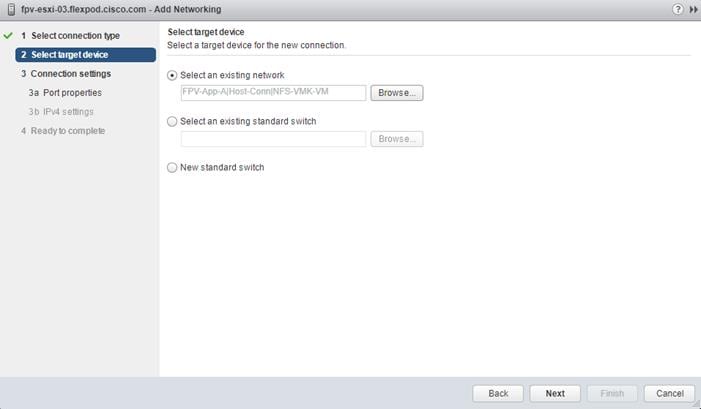
7. Click Next.
8. Select to use static IPv4 settings and enter an IP address and netmask in the tenant NFS subnet. Click Next.
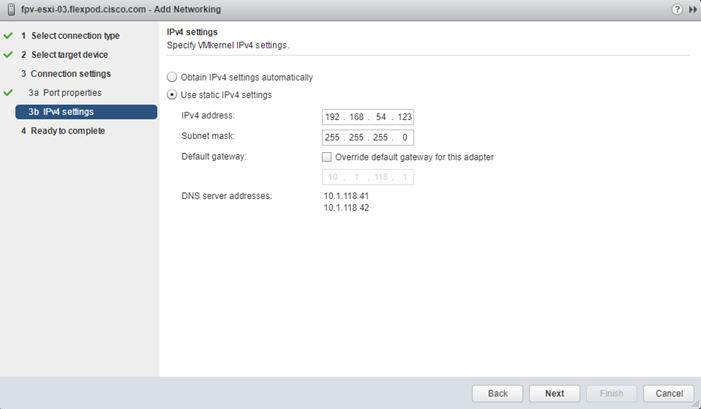
9. Review the settings and click Finish to complete creating the VMkernel port.
10. In the center pane, highlight the newly-created VMkernel port and select ![]() to edit the VMkernel port settings.
to edit the VMkernel port settings.
11. Select NIC settings on the left and change the MTU to 9000. Click OK.
12. Repeat this procedure to add tenant NFS and iSCSI VMkernel ports to all tenant ESXi hosts.
13. To add the two tenant iSCSI targets, from the host Configure tab in vSphere Web Client, select Storage > Storage Adapters. Select the iSCSI Software Adapter and select the Targets tab.
14. Under Targets, make sure Dynamic Discovery is selected and click Add.
15. Enter the IP address of iscsi_lif01 in the FPV-App-A-SVM and click OK. Repeat to add the IP address of iscsi_lif02.
16. Click ![]() to rescan all SAN storage devices. Click OK.
to rescan all SAN storage devices. Click OK.
17. The new targets can now be verified under Targets > Static Discovery.
18. Repeat this procedure to add the iSCSI targets to all tenant ESXi hosts.
19. To mount the two tenant NFS datastores, from the host Configure tab in vSphere Web Client, select Storage > Datastores. Click ![]() to add a datastore.
to add a datastore.
20. Select NFS and click Next.
21. Leave NFS 3 selected and click Next.
22. Enter the Datastore name, the configured Junction Path of the volume for the Folder, and the IP address of the NFS LIF in the tenant SVM on the storage node where the volume is located. Click Next.
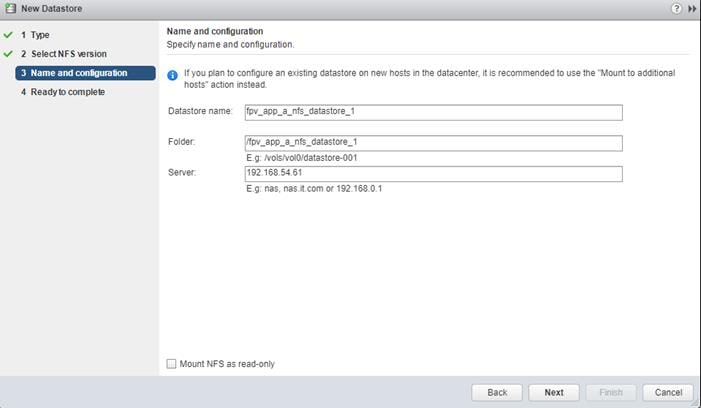
23. Review the settings and click Finish to complete mounting the datastore. Repeat this procedure to mount the second tenant NFS datastore.
24. Now that the two tenant NFS datastores have been mounted on one host, NetApp VSC can be used to mount these datastores on the remaining tenant hosts. Right-click the first host and select NetApp VSC > Update Host and Storage Data. Click OK two times. Wait for the NetApp Storage Discovery to complete.
25. Right-click one of the remaining hosts and select NetApp VSC > Mount Datastores. Select only the two tenant NFS datastores and click OK. Repeat this procedure for all remaining tenant hosts.
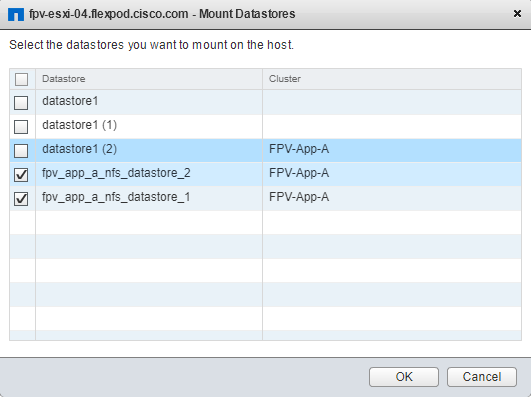
26. Using NetApp VSC, configure Optimal Storage Settings on the VMware ESXi hosts, put them in Maintenance Mode, and reboot them.
27. You are now ready to install software into the tenant and begin running a workload. Because FCoE zoning or iSCSI targets to the FPV-App-A-SVM LIFs are in place, SAN storage can be provisioned with NetApp VSC. New NFS storage can also be provisioned with VSC.
28. Use NetApp SnapCenter to create backup schedules for tenant datastores.
Build a Second Tenant (Optional)
In this lab validation a second tenant was built to demonstrate that multiple tenants could access and use the Shared-L3-Out and that tenants can be completely logically separated, but can also have overlapping IP address spaces. Any subnet connected to Core-Services or the Shared-L3 Out must have IP addresses unique within the ACI fabric. Notice below that the storage protocol subnets and the App tier subnet have overlapping IPs with FPV-App-A. The remaining subnets are unique since they connect to either Core-Services or the Shared-L3-Out. The second tenant built in this lab validation had the following characteristics and was built with the same contract structure as the FPV-App-A tenant:
Table 7 Lab Validation Tenant App-B Configuration
| EPG | Storage VLAN | UCS VLAN | Subnet / Gateway | Bridge Domain |
| iSCSI | 3015 | vDS | 192.168.114.0/24 - L2 | BD-iSCSI |
| NFS | 3055 | vDS | 192.168.54.0/24 - L2 | BD-NFS |
| SVM-MGMT | 222 | N/A | 172.16.254.30/29 | BD-Internal |
| Web | N/A | vDS | 172.16.3.254/24 | BD-Internal |
| App | N/A | vDS | 172.16.1.254/24 | BD-Internal |
| DB | N/A | vDS | 172.16.5.254/24 | BD-Internal |
This procedure details a setup method to demonstrate the ACI L4-L7 VLAN Stitching feature with L4-L7 services devices. In this lab validation, two Cisco ASAv virtual firewall devices were connected to the ACI Fabric using the APIC-integrated VMware vDS. Inside and Outside vDS port groups were created using EPGs in Tenant common. When the L4-7 Service Graph with the ASAv instance is deployed within a tenant, the new port groups are created in the tenant and the ASAv network interfaces are moved to the new port groups. The ASAv firewalls were deployed between the tenant Web EPG in the 3-Tier App and the Fabric Shared L3 Out interface. VLAN Stitching does not make use of device packages. Instead the firewall was configured using the firewall CLI and ASDM interfaces. The detailed VLANs and IP subnet addresses are listed in Table 8.
Table 8 Tenant L4-L7 VLAN Stitching Details
| Tenant | Outside VLAN | Outside Firewall IP (ASAv) | Outside Subnet Gateway (ACI) | Inside VLAN | Inside Firewall IP (ASAv) | Web EPG Gateway (ACI) |
| App-A | vDS | 172.16.252.1/30 | 172.16.252.2/30 | vDS | 172.16.0.1/24 | 172.16.0.254/24 |
| App-B | vDS | 172.16.252.5/30 | 172.16.252.6/30 | vDS | 172.16.3.1.24 | 172.16.3.254/24 |
Provide Management connectivity to Cisco ASAv
This section details the configuration necessary to provide management connectivity to Cisco ASAv. The management interfaces on the Cisco ASAv VM are added to the SVM MGMT EPG and managed from either a Core Services EPG or DB Tier EPG.
The SVM MGMT EPG was created in an earlier section titled: Create EPG for Infrastructure SVM-MGMT Access. In this setup, management was done from the Core-Services EPG to which SVM-MGMT already has access to through the established contract.
To provide management connectivity to ASAv from Core-Services EPG, complete the following steps:
APIC GUI
1. From the Cisco APIC GUI, at the top, select Tenants > FPV-Foundation.
2. On the left, expand Tenant FPV-Foundation and select Application Profiles.
3. Expand Application Profiles and select Application Profile IB-MGMT.
4. Select and expand Application EPGs.
5. Select SVM-MGMT EPG. Right-click and select Add VMM Domain Association from the list.
6. Use the drop-down list to select the fpv-vc-vDS VMM Domain Profile. Select Immediate Deploy Immediacy and change no other values. Click Submit to create the SVM-MGMT port group in the vDS.

Deploy Inside and Outside EPGs in Tenant common
This section details setup of the Inside and Outside placeholder EPGs for the ASAv's used in this lab validation.
APIC GUI
1. From the Cisco APIC GUI, at the top, select Tenants > common.
2. On the left, expand Tenant common and Application Profiles.
3. Right-click Application Profiles and select Create Application Profile.
4. Name the Application Profile ASAv-Deployment. Under EPGs, click the ![]() to add an EPG.
to add an EPG.
5. Name the first EPG Inside. Use the drop-down list under BD to select Create Bridge Domain.
6. Name the Bridge Domain common-ASAv. Use the drop-down list to select the default VRF in Tenant common.
7. Leave Forwarding set to Optimize and click Next.
8. No L3 Configurations changes are necessary. Click Next.
9. No Advanced/Troubleshooting changes are necessary. Click Finish.
10. Back in the Create Application Profile window, use the Domain drop-down list to select the fpv-vc-vDS VMM domain. Click Update.
11. Under EPGs, click the ![]() to add an EPG.
to add an EPG.
12. Name the second EPG Outside. Use the drop-down list under BD to select the common-ASAv Bridge Domain.
13. Use the Domain drop-down list to select the fpv-vc-vDS VMM domain. Click Update.
14. Click Submit to complete creating the Application Profile.
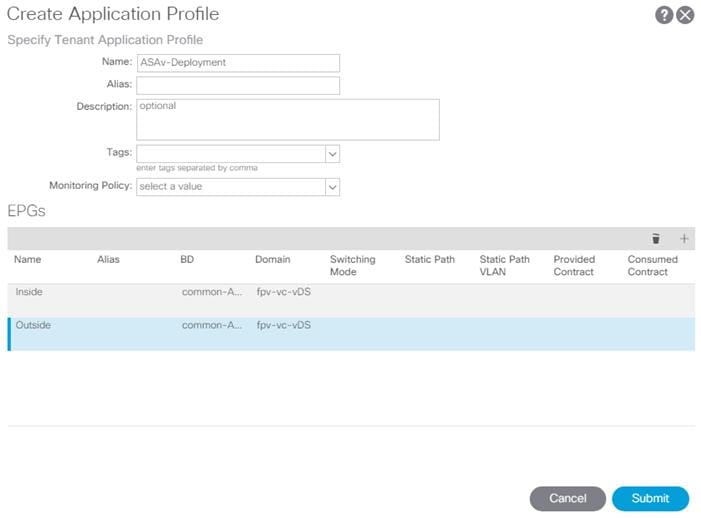
Create Tenant Firewall Outside Bridge Domain and Subnet
This section details setup of the bridge domain and associated subnet to be used for the ASAv firewall context outside interface. Since the firewall’s outside interface is being connected to the Shared L3 Out that resides in Tenant common, the Outside Bridge Domain is also created in Tenant common.
![]() The ASAv’s Inside and Outside Interfaces must connect to different Bridge Domains when in use. Above, the two interfaces were placed in the same Bridge Domain, but when the L4-7 Service Graph is deployed, those interfaces will be moved to separate Bridge Domains.
The ASAv’s Inside and Outside Interfaces must connect to different Bridge Domains when in use. Above, the two interfaces were placed in the same Bridge Domain, but when the L4-7 Service Graph is deployed, those interfaces will be moved to separate Bridge Domains.
APIC GUI
1. From the Cisco APIC GUI, at the top, select Tenants > common.
2. On the left, expand Tenant common and Networking.
3. Right-click Bridge Domains and select Create Bridge Domain.
4. Name the Bridge Domain BD-FPV-App-A-FW-Web-Out.
5. Using the VRF drop-down list, select common-FP-External.
6. Leave Forwarding set to optimize and click Next.
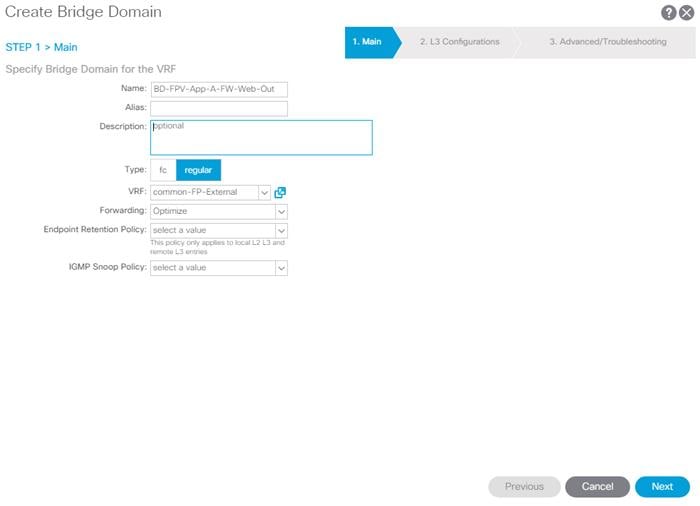
7. Click the ![]() to the right of Subnets to add a bridge domain subnet.
to the right of Subnets to add a bridge domain subnet.
8. Put in a gateway IP and mask for the subnet to be used for the outside interface of the tenant firewall context. It is recommended that this subnet is in the Supernet used for tenants elsewhere in this document.
9. For Scope, select only Advertised Externally. Click OK to complete creating the subnet.
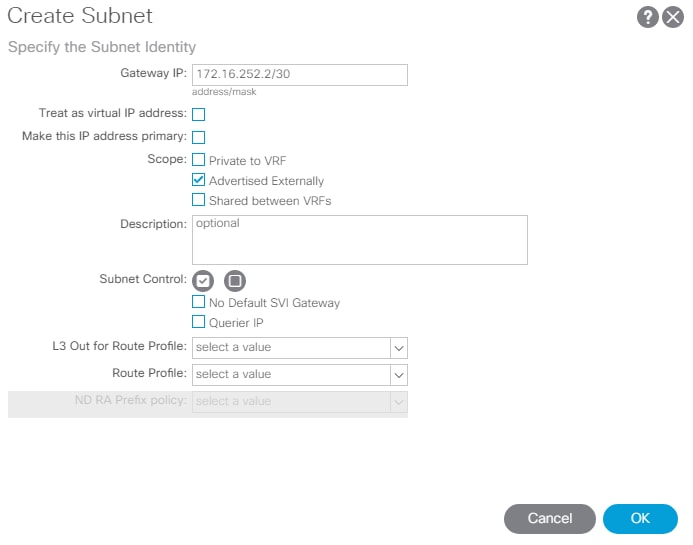
10. Click OK to complete creating the subnet.
11. Click the ![]() to the right of Associated L3 Outs to add the Shared L3 Out.
to the right of Associated L3 Outs to add the Shared L3 Out.
12. Using the drop-down list, select FP-Shared-L3-Out and click Update.
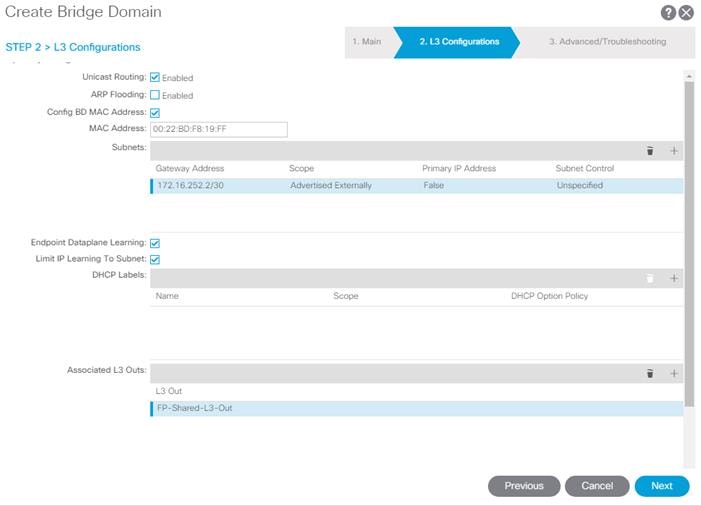
13. Click Next.
14. Click Finish to complete creating the bridge domain.
Deploy ASAv VM from OVF
To setup of ASAv VM in the ACI Tenant, complete the following steps:
VMware vCenter Web Client
1. Download and expand the latest version of the Cisco ASAv .zip file from Cisco.com.
2. Using Windows Explorer, navigate to the folder with the files extracted from the .zip file.
3. Create a Not Needed folder and move the asav-esxi.mf and asav-esxi.ovf files to this folder. Five files should be left in this folder.

4. In the VMware vSphere Web Client, under Hosts and Clusters right-click the FPV-App-A cluster and select Deploy OVF Template.
5. In the Deploy OVF Template Window, click Browse and navigate to the folder with the extracted ASAv OVF files. Select the five files and select Open.
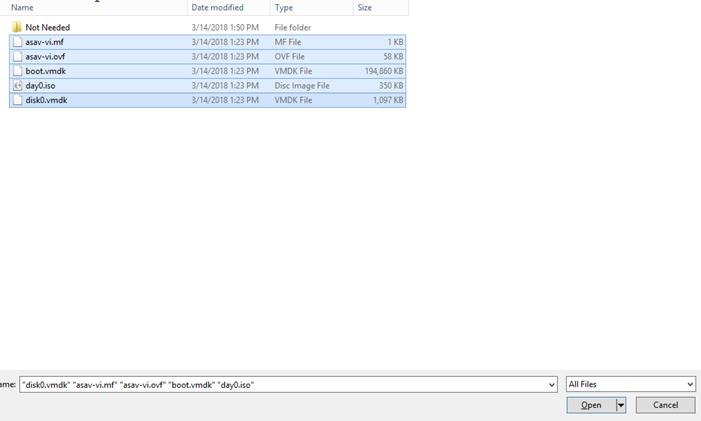
6. Back in the Deploy OVF Template window, click Next.
7. Name the ASAv VM and select the folder to store the VM in. Click Next.
8. Select the ESXI cluster to deploy the VM on and click Next.
9. Review the warning and click Next.
10. Accept both License Agreements and click Next.
11. Select the ASAv configuration that you are licensed for and click Next.
12. Select the Thin provision virtual disk format and a datastore in the FPV-App-A tenant. Click Next.
13. Under Select networks, place GigabitEthernet0-0 in the common | ASAv-Deployment |Outside port group, Management0-0 in the FPV-App-A|MGMT|SVM-MGMT port group, and GigabitEthernet0-1 in the common | ASAv-Deployment | Inside port group. Place the remaining interfaces in the quarantine port group. Click Next.
![]() In this sample deployment, the ASAv’s management address is being placed in the Tenant’s SVM-MGMT EPG which could have contracts allowing it to reach the Tenant’s DB EPG and the Core-Services EPG. Placing the ASA’s Management interface here allows it to be managed from either the DB EPG or from a Core-Services VM.
In this sample deployment, the ASAv’s management address is being placed in the Tenant’s SVM-MGMT EPG which could have contracts allowing it to reach the Tenant’s DB EPG and the Core-Services EPG. Placing the ASA’s Management interface here allows it to be managed from either the DB EPG or from a Core-Services VM.
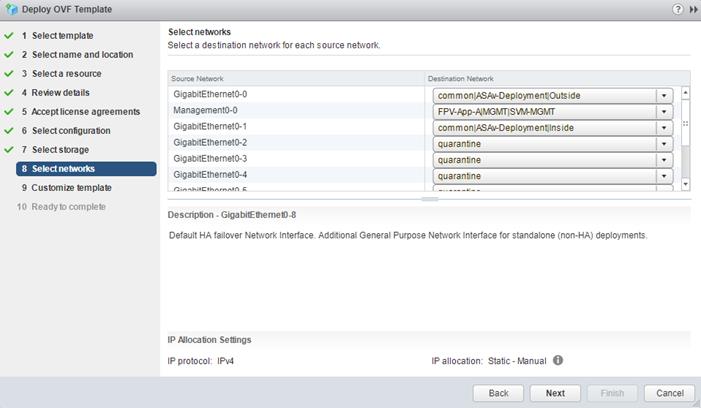
14. Under Customize template, fill in all relevant values including Firewall Mode –routed and click Next.
15. Review all of the deployment information and click Finish to deploy the Appliance.
16. Power on the ASAv, do any required configuration, and assign a license. A sample ASAv NAT configuration is shown in the appendix of this document.
![]() It may be necessary to temporarily connect the EPG the ASAv Management Interface is in to the Shared L3 Out in order to contact the Cisco software license servers. Create Tenant L4-L7 Device and Service Graph
It may be necessary to temporarily connect the EPG the ASAv Management Interface is in to the Shared L3 Out in order to contact the Cisco software license servers. Create Tenant L4-L7 Device and Service Graph
This section details setup of the L4-L7 Device and Service Graph in the ACI Tenant.
APIC GUI
1. From the Cisco APIC GUI, at the top, select Tenants > FPV-App-A.
2. On the left, expand Tenant FPV-App-A, Application Profiles, Three-Tier-App, Application EPGs, and EPG Web.
3. Under EPG Web, select Contracts.
4. In the center pane, right-click the Allow-FP-Shared-L3-Out contract and select Delete to remove this contract association.
5. On the left, expand Subnets and select the EPG subnet.
6. In the center pane, uncheck Advertised Externally. If the Web EPG is connected to Core-Services, leave Shared between VRFs selected. Otherwise, select Private to VRF.
7. Click Submit to complete modifying the subnet. Click Submit Changes if a warning pops up.
8. On the left, expand Tenant FPV-App-A > Services > L4-L7.
9. Right-click Devices and select Create L4-L7 Devices.
10. In the Create L4-L7 Devices window, uncheck the Managed checkbox.
11. Name the Device FPV-App-A-ASAv. Select the Firewall Service Type.
12. Select the VIRTUAL Device Type.
13. For the VMM Domain, select fpv-vc-vDS. Select the Single Node View.
14. Leave Context Aware set to Single.
15. Under Device 1, use the drop-down list to select the fpv-vc/FPV-App-A-ASAv VM. Click ![]() to add the first Device Interface.
to add the first Device Interface.
16. Name the Device Interface Outside. Use the vNIC drop-down list to select Network adapter 2.
17. Click Update.
18. Click ![]() to add the second Device Interface.
to add the second Device Interface.
19. Name the Device Interface Inside. Use the vNIC drop-down list to select Network adapter 3.
20. Click Update.
21. Under Cluster, click ![]() to add a Concrete Interface.
to add a Concrete Interface.
22. Name the interface Outside. Use the drop-down list to select Device1/Outside.
23. Click Update.
24. Under Cluster, click ![]() to add the second Concrete Interface.
to add the second Concrete Interface.
25. Name the interface Inside. Use the drop-down list to select Device1/Inside.
26. Click Update.
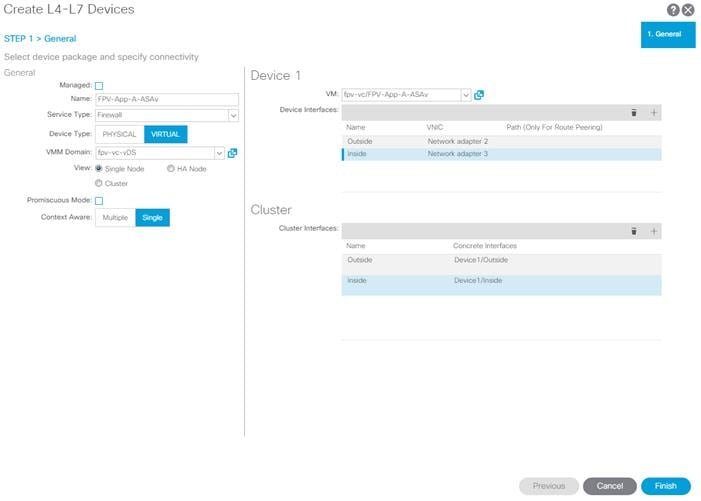
27. Click Finish to complete creating the L4-L7 Device.
28. Right-click Service Graph Templates and select Create L4-L7 Service Graph Template.
29. In the Create L4-L7 Service Graph Template window, name the Graph FPV-App-A-ASAv.
30. Make sure Graph Type is set to Create A New Graph.
31. On the left drag the FPV-App-A-ASAv (Firewall) icon to between the two EPGs on the right.
32. Select the Routed Firewall.

33. Click Submit to complete creating the Service Graph Template.
34. On the left, expand Service Graph Templates and select the FPV-App-A-ASAv Template.
35. Right-click the FPV-App-A-ASAv Template and select Apply L4-L7 Service Graph Template.
36. In the Apply L4-L7 Service Graph Template to EPGs window, use the Consumer EPG drop-down list to select common/FP-Shared-L3-Out/FP-Default-Route.
37. Use the Provider EPG drop-down list to select FPV-App-A/3-Tier-App/epg-Web.
![]() These EPG selections place the firewall between the Shared-L3-Out and FPV-App-A Web EPGs.
These EPG selections place the firewall between the Shared-L3-Out and FPV-App-A Web EPGs.
38. Under Contract Information, leave Create A New Contract selected and name the contract Allow-FPV-App-A-FW-L3-Web
![]() It is important that this contract have a unique name within the ACI Fabric.
It is important that this contract have a unique name within the ACI Fabric.

39. Click Next.
40. Under the Consumer Connector, use the BD drop-down list to select common/BD-FPV-App-A-FW-Web-Out.
41. Under Consumer Connector use the Cluster Interface drop-down list to select Outside.
42. Under Provider Connector use the Cluster Interface drop-down list to select Inside.
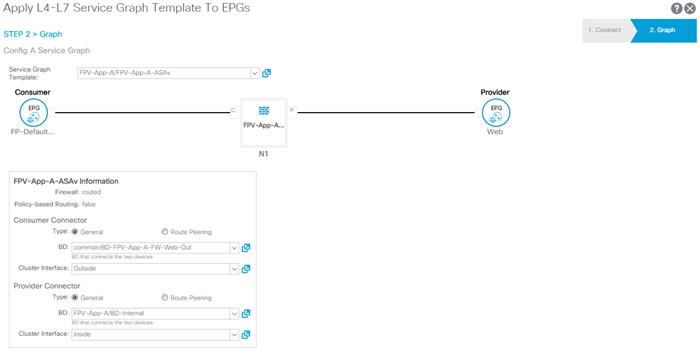
43. Click Finish to compete applying the Service Graph Template.
44. On the left, expand Deployed Graph Instances and expand the deployed instance.
45. Select Function Node – N1.
46. Verify that the Function Connectors display values for Encap and Class ID.
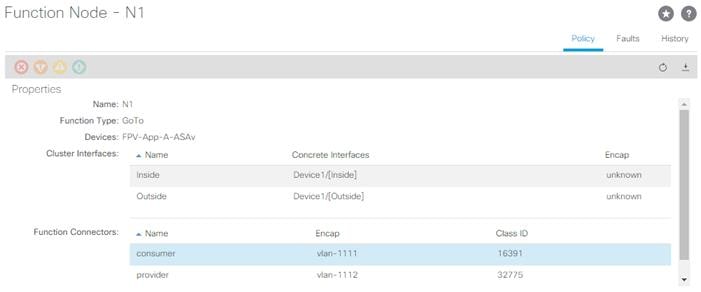
47. Configure the ASAv firewall device context as a routed firewall with NAT from the Inside to the Outside interface. A sample configuration is in the Appendix. The outside interface should be configured in the subnet entered in the BD-FPV-App-A-FW-Web-Out bridge domain. The ASAv’s Outside default gateway should be the bridge domain’s gateway address. The Inside interface should be configured in the subnet entered in the FPV-App-A Web EPG. You can also add NAT rules to the firewall to reach VMs in the Web EPG with services such as http or rdp.
48. For VMs with interfaces in the Web EPG, set the default gateway to the ASAv’s Inside interface IP. You will also need to add persistent static routes to the EPG gateway to reach Core-Services and the App EPG.
49. Starting with Create Tenant Firewall Outside Bridge Domain and Subnet, add the ASAv firewall for the second ACI tenant.
This section details the configuration steps for the Cisco UCS 6332-16UP Fabric Interconnects (FI) in a design that will support direct connectivity to the NetApp AFF using 16 Gb/s Fibre Channel.
Figure 5 shows the VMware vSphere 6.5U1 built on FlexPod components and the network connections for a configuration with the Cisco UCS 6332-16UP Fabric Interconnects with storage FC connections directly connected to the fabric interconnect. This design has 40Gb Ethernet connections between the Cisco UCS 5108 Blade Chassis and C-Series rackmounts and the Cisco UCS Fabric Interconnect, and between the Cisco UCS Fabric Interconnects and Cisco Nexus 9000 switches. This design also has two 16Gb FC connections between each Cisco UCS Fabric Interconnect and NetApp AFF A300. FC zoning is done in the Cisco UCS Fabric Interconnect. This infrastructure is deployed to provide FC-booted hosts with file-level and block-level access to shared storage with use cases that do not require the Cisco MDS SAN connectivity or scale.
Figure 5 FlexPod with Cisco UCS 6332-16UP Fabric Interconnects and Cisco UCS Direct Connect SAN

![]() This Appendix only details the delta configuration required for the Storage, Cisco UCS, and VMware setup. As mentioned in previous sections of this document, any iSCSI steps can be skipped if iSCSI is not being implemented.
This Appendix only details the delta configuration required for the Storage, Cisco UCS, and VMware setup. As mentioned in previous sections of this document, any iSCSI steps can be skipped if iSCSI is not being implemented.
Storage Configuration
Set Onboard Unified Target Adapter 2 Port Personality
In order to use FC storage targets, FC ports must be configured on the storage. To set the personality of the onboard unified target adapter 2 (UTA2), complete the following steps for both controllers in an HA pair:
1. Verify the Current Mode and Current Type properties of the ports by running the ucadmin show command.
ucadmin show
Current Current Pending Pending Admin
Node Adapter Mode Type Mode Type Status
------------ ------- ------- --------- ------- --------- -----------
<st-node01>
0e fc target - - online
<st-node01>
0f fc target - - online
<st-node01>
0g fc target - - online
<st-node01>
0h fc target - - online
<st-node02>
0e fc target - - online
<st-node02>
0f fc target - - online
<st-node02>
0g fc target - - online
<st-node02>
0h fc target - - online
8 entries were displayed.
2. Verify that the Current Mode and Current Type properties for all ports are set properly. Set the ports used for FC connectivity to mode fc. The port type for all protocols should be set to target. Change the port personality by running the following command:
ucadmin modify -node <home-node-of-the-port> -adapter <port-name> -mode fc -type target.
![]() The ports must be offline to run this command. To take an adapter offline, run the fcp adapter modify –node <home-node-of-the-port> -adapter <port-name> -state down command. Ports must be converted in pairs (for example, 0e and 0f).
The ports must be offline to run this command. To take an adapter offline, run the fcp adapter modify –node <home-node-of-the-port> -adapter <port-name> -state down command. Ports must be converted in pairs (for example, 0e and 0f).
![]() After conversion, a reboot is required. After reboot, bring the ports online by running fcp adapter modify -node <home-node-of-the-port> -adapter <port-name> -state up.
After conversion, a reboot is required. After reboot, bring the ports online by running fcp adapter modify -node <home-node-of-the-port> -adapter <port-name> -state up.
Add FCP Storage Protocol to Infrastructure SVM
Run the following command to add the FCP storage protocol to the Infrastructure SVM. It is assumed that an FCP license has been installed on each cluster node:
vserver add-protocols -vserver FPV-Foundation-SVM -protocols fcp
vserver show –fields allowed-protocols
Create FCP Storage Protocol in Infrastructure SVM
Run the following command to create the FCP storage protocol in the Infrastructure SVM. It is assumed that an FCP license has been installed on each cluster node:
fcp create -vserver FPV-Foundation-SVM
fcp show
Create FC LIFs
Run the following commands to create four FC LIFs (two on each node) in the Infrastructure SVM by using the previously configured FC ports:
network interface create -vserver FPV-Foundation-SVM -lif fcp_lif01a -role data -data-protocol fcp -home-node <st-node01> -home-port 0e –status-admin up
network interface create -vserver FPV-Foundation-SVM -lif fcp_lif01b -role data -data-protocol fcp -home-node <st-node01> -home-port 0f –status-admin up
network interface create -vserver FPV-Foundation-SVM -lif fcp_lif02a -role data -data-protocol fcp -home-node <st-node02> -home-port 0e –status-admin up
network interface create -vserver FPV-Foundation-SVM -lif fcp_lif02b -role data -data-protocol fcp -home-node <st-node02> -home-port 0f –status-admin up
network interface show –vserver FPV-Foundation-SVM –lif fcp*
Server Configuration
This section details the delta steps in the Cisco UCS setup to provide FC-based boot and storage.
Configure FC Unified Ports (UP) on Cisco UCS Fabric Interconnects
In order to use Fiber Channel Storage Ports for storage directly connected to the Cisco UCS fabric interconnects, 10G Ethernet ports need to be converted to 16G FC ports.
To convert the first six ports of the UCS 6322-16 UP to FC, complete the following steps:
1. In Cisco UCS Manager, click Equipment on the left.
2. Select Equipment > Fabric Interconnects > Fabric Interconnect A (primary).
3. In the center pane, select Configure Unified Ports. Click Yes to proceed.
4. The 6332-16UP requires ports to be converted in groups of 6 ports from the left. To convert the first six ports, move the slider to the right until ports 1-6 are highlighted.
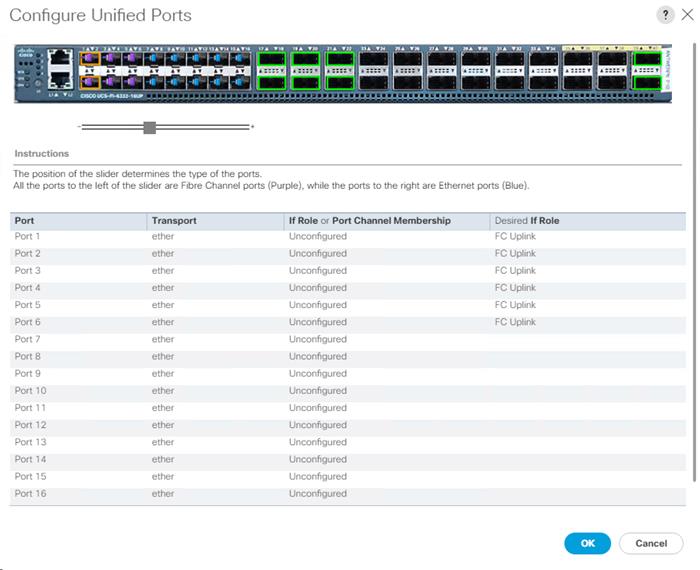
5. Click OK, then click Yes, then click OK to convert the ports. The Fabric Interconnect will reboot. If this was the primary fabric interconnect, you will need to reconnect to Cisco UCS Manager. Wait until the reboot is complete and the FI is back in the UCS domain cluster. This can be checked by logging into the FI’s CLI and typing show cluster state. Wait until the “HA Ready” state appears.
6. Repeat this process to convert the first six ports of FI B.
Place Cisco UCS Fabric Interconnects in Fiber Channel Switching Mode
In order to use Fiber Channel Storage Ports for storage directly connected to the Cisco UCS fabric interconnects, the fabric interconnects must be changed from fiber channel end host mode to fiber channel switching mode.
To place the fabric interconnects in fiber channel switching mode, complete the following steps:
1. In Cisco UCS Manager, click Equipment on the left.
2. Select Equipment > Fabric Interconnects > Fabric Interconnect A (primary).
3. In the center pane, select set FC Switching Mode. Click Yes and OK for the confirmation message.
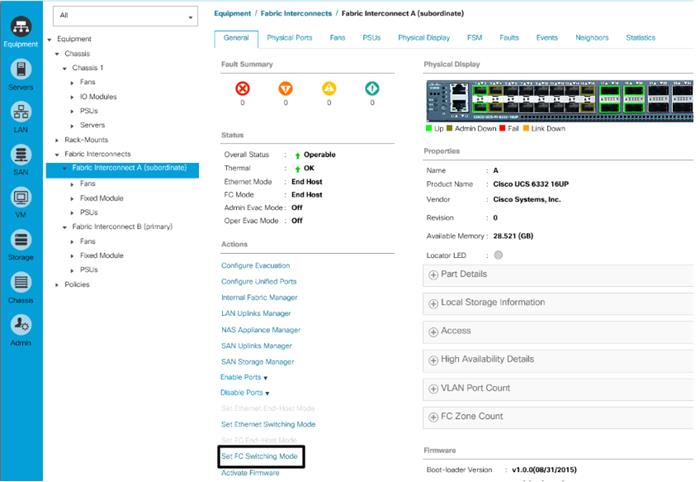
4. Wait for both Fabric Interconnects to reboot by monitoring the console ports and log back into Cisco UCS Manager.
![]() It may be necessary to go to the Pending Activities window and select Reboot Fabric Interconnect to reboot the Primary Fabric Interconnect.
It may be necessary to go to the Pending Activities window and select Reboot Fabric Interconnect to reboot the Primary Fabric Interconnect.
Create Storage VSANs
To configure the necessary virtual storage area networks (VSANs) for the Cisco UCS environment, complete the following steps:
1. In Cisco UCS Manager, click the SAN icon on the left.
![]() In this step, two VSANs are created, one for Fabric A and one for Fabric B.
In this step, two VSANs are created, one for Fabric A and one for Fabric B.
2. Select and expand SAN > Storage Cloud.
3. Right-click VSANs.
4. Select Create Storage VSAN.
5. Enter VSAN-A as the name of the VSAN to be used for Fabric A.
6. Set FC Zoning to Enabled.
7. Select Fabric A.
8. Enter a unique VSAN ID and a corresponding FCoE VLAN ID for Fabric A. It is recommended to use the same ID for both parameters and to use something other than 1.
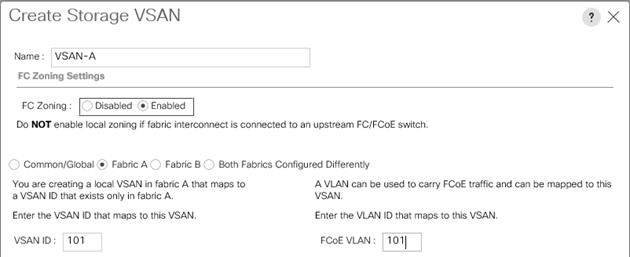
9. Click OK and then click OK again.
10. Under Storage Cloud, right-click VSANs.
11. Select Create Storage VSAN.
12. Enter VSAN-B as the name of the VSAN to be used for Fabric B.
13. Set FC Zoning to Enabled.
14. Select Fabric B.
15. Enter a unique VSAN ID and a corresponding FCoE VLAN ID for Fabric B. It is recommended use the same ID for both parameters and to use something other than 1.
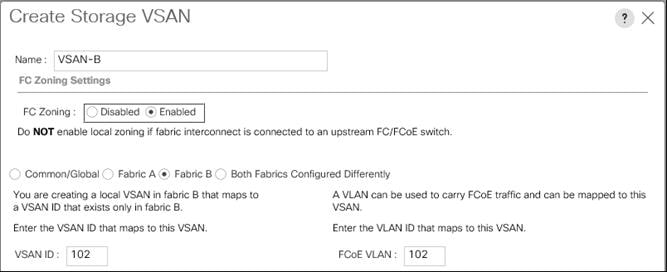
16. Click OK, and then click OK again
Configure FC Storage Ports
To configure the necessary FCoE Storage port for the Cisco UCS environment, complete the following steps:
1. In Cisco UCS Manager, click Equipment on the left.
2. Select and expand Equipment > Fabric Interconnects > Fabric Interconnect A > Fixed Module > FC Ports
3. Select the ports (1 and 2 for this document) that are connected to the NetApp array, right-click them, and select “Configure as FC Storage Port”
4. Click Yes to confirm and then click OK.
5. Verify that the ports connected to the NetApp array are now configured as FC Storage ports.
6. Select and expand Equipment > Fabric Interconnects > Fabric Interconnect B > Fixed Module > FC Ports
7. Select the ports (1 and 2 for this document) that are connected to the NetApp array, right-click them, and select “Configure as FC Storage Port.”
8. Click Yes to confirm and then click OK.
9. Verify that the ports connected to the NetApp array are now configured as FC Storage ports.
Assign VSANs to FC Storage Ports
To assign storage VSANs to FC Storage Ports, complete the following steps:
1. In Cisco UCS Manager, click SAN on the left.
2. Select and expand SAN > Storage Cloud.
3. Expand Fabric A and Storage FC Interfaces.
4. Select the first FC Interface (1/1).
5. For User Label, enter the storage controller name and port. Click Save Changes, then click OK.
6. Use the drop-down list to select VSAN VSAN-A. Click Save Changes, then click OK.

7. Select the second FC Interface (1/2).
8. For User Label, enter the storage controller name and port. Click Save Changes, then click OK.
9. Use the drop-down list to select VSAN VSAN-A. Click Save Changes, then click OK.
10. Expand Fabric B and Storage FC Interfaces.
11. Select the first FC Interface (1/1)
12. For User Label, enter the storage controller name and port. Click Save Changes, then click OK.
13. Use the drop-down list to select VSAN VSAN-B. Click Save Changes, then click OK.
14. Select the second FC Interface (1/2).
15. For User Label, enter the storage controller name and port. Click Save Changes, then click OK.
16. Use the drop-down list to select VSAN VSAN-B. Click Save Changes, then click OK.
Create a WWNN Pool for FC Boot
To configure the necessary WWNN pool for the Cisco UCS environment, complete the following steps on Cisco UCS Manager.
1. Select SAN on the left.
2. Select and expand Pools > root.
3. Right-click WWNN Pools under the root organization.
4. Select Create WWNN Pool to create the WWNN pool.
5. Enter WWNN-Pool for the name of the WWNN pool.
6. Optional: Enter a description for the WWNN pool.
7. Select Sequential for Assignment Order.

8. Click Next.
9. Click Add.
10. Modify the From field as necessary for the UCS Environment and click OK.
![]() Modifications of the WWNN block, as well as the WWPN and MAC Addresses, can convey identifying information for the UCS domain. Within the From field in our example, the 6th octet was changed from 00 to A2 to represent as identifying information for this being in the UCS 6332 in the 2nd cabinet of the A row. Also, when having multiple UCS domains sitting in adjacency, it is important that these blocks, the WWNN, WWPN, and MAC hold differing values between each set.
Modifications of the WWNN block, as well as the WWPN and MAC Addresses, can convey identifying information for the UCS domain. Within the From field in our example, the 6th octet was changed from 00 to A2 to represent as identifying information for this being in the UCS 6332 in the 2nd cabinet of the A row. Also, when having multiple UCS domains sitting in adjacency, it is important that these blocks, the WWNN, WWPN, and MAC hold differing values between each set.
11. Specify a size of the WWNN block sufficient to support the available server resources.
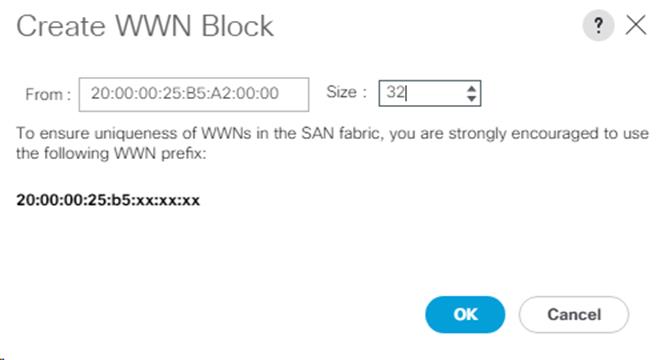
12. Click OK.
13. Click Finish and OK to complete creating the WWNN pool.
Create WWPN Pools
To configure the necessary WWPN pools for the Cisco UCS environment, complete the following steps:
1. In Cisco UCS Manager, click SAN on the left.
2. Select Pools > root.
3. In this procedure, two WWPN pools are created, one for each switching fabric.
4. Right-click WWPN Pools under the root organization.
5. Select Create WWPN Pool to create the WWPN pool.
6. Enter WWPN-Pool-A as the name of the WWPN pool.
7. Optional: Enter a description for the WWPN pool.
8. Select Sequential for Assignment Order.
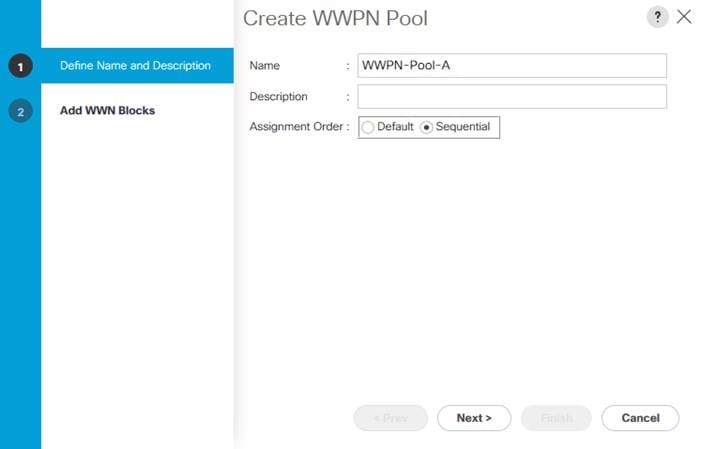
9. Click Next.
10. Click Add.
11. Specify a starting WWPN
![]() For the FlexPod solution, the recommendation is to place 0A in the next-to-last octet of the starting WWPN to identify all of the WWPNs as fabric A addresses. Merging this with the pattern you used for the WWNN you will see a WWPN block starting with 20:00:00:25:B5:A2:0A:00
For the FlexPod solution, the recommendation is to place 0A in the next-to-last octet of the starting WWPN to identify all of the WWPNs as fabric A addresses. Merging this with the pattern you used for the WWNN you will see a WWPN block starting with 20:00:00:25:B5:A2:0A:00
12. Specify a size for the WWPN pool that is sufficient to support the available blade or server resources.
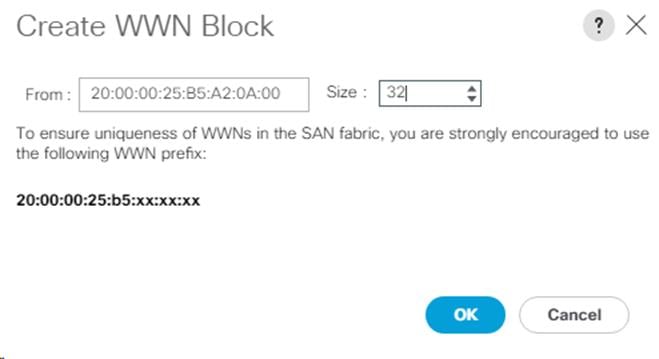
13. Click OK.
14. Click Finish.
15. In the confirmation message, click OK.
16. Right-click WWPN Pools under the root organization.
17. Select Create WWPN Pool to create the WWPN pool.
18. Enter WWPN-Pool-B as the name of the WWPN pool.
19. Optional: Enter a description for the WWPN pool.
20. Select Sequential for Assignment Order.
21. Click Next.
22. Click Add.
23. Specify a starting WWPN.
![]() For the FlexPod solution, the recommendation is to place 0B in the next-to-last octet of the starting WWPN to identify all of the WWPNs as fabric A addresses. Merging this with the pattern we used for the WWNN we see a WWPN block starting with 20:00:00:25:B5:A2:0B:00.
For the FlexPod solution, the recommendation is to place 0B in the next-to-last octet of the starting WWPN to identify all of the WWPNs as fabric A addresses. Merging this with the pattern we used for the WWNN we see a WWPN block starting with 20:00:00:25:B5:A2:0B:00.
24. Specify a size for the WWPN address pool that is sufficient to support the available blade or server resources.
25. Click OK.
26. Click Finish.
27. In the confirmation message, click OK.
Create vHBA Templates
To create the necessary virtual host bus adapter (vHBA) templates for the Cisco UCS environment, complete the following steps:
1. In Cisco UCS Manager, click SAN on the left.
2. Select Policies > root.
3. Right-click vHBA Templates.
4. Select Create vHBA Template.
5. Enter vHBA-Template-A as the vHBA template name.
6. Keep Fabric A selected.
7. Leave Redundancy Type set to No Redundancy.
8. Select VSAN-A.
9. Leave Initial Template as the Template Type.
10. Select WWPN-Pool-A as the WWPN Pool.
11. Click OK to create the vHBA template.
12. Click OK
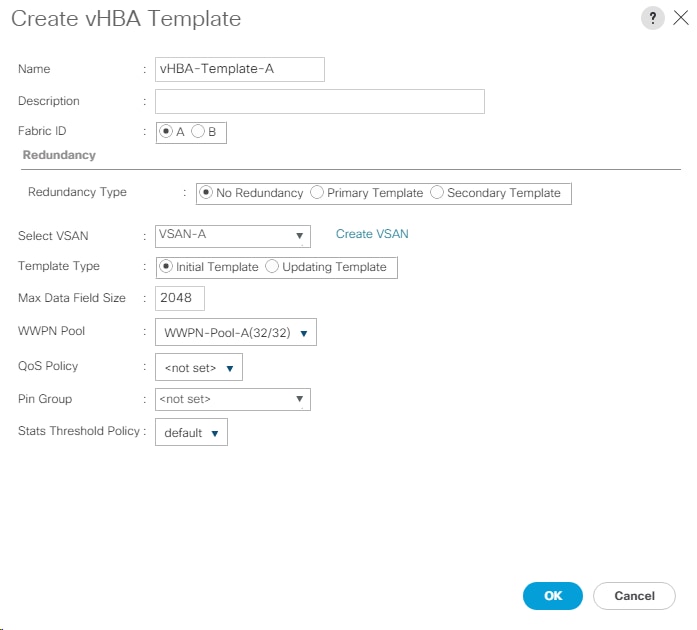
13. Right-click vHBA Templates.
14. Select Create vHBA Template.
15. Enter vHBA-Template-B as the vHBA template name.
16. Select Fabric B as the Fabric ID.
17. Leave Redundancy Type set to No Redundancy.
18. Select VSAN-B.
19. Leave Initial Template as the Template Type.
20. Select WWPN-Pool-B as the WWPN Pool.
21. Click OK to create the vHBA template.
22. Click OK.
Create SAN Connectivity Policy
To configure the necessary Infrastructure SAN Connectivity Policy, complete the following steps:
1. In Cisco UCS Manager, click SAN on the left.
2. Select SAN > Policies > root > Sub-Organizations > FPV-FlexPod.
3. Select and right-click on SAN Connectivity Policies.
4. Select Create SAN Connectivity Policy.
5. Enter FPV-App-B-FC-Bt as the name of the policy.
6. Select the previously created WWNN-Pool for the WWNN Assignment.
7. Click Add at the bottom to add a vHBA.
8. In the Create vHBA dialog box, enter Fabric-A as the name of the vHBA.
9. Select the Use vHBA Template checkbox.
10. In the vHBA Template list, select vHBA-Template-A.
11. In the Adapter Policy list, select VMware.
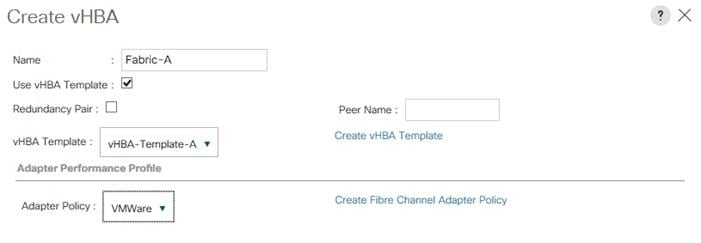
12. Click OK.
13. Click the Add button at the bottom to add a second vHBA.
14. In the Create vHBA dialog box, enter Fabric-B as the name of the vHBA.
15. Select the Use vHBA Template checkbox.
16. In the vHBA Template list, select vHBA-Template-B.
17. In the Adapter Policy list, select VMware.
18. Click OK.
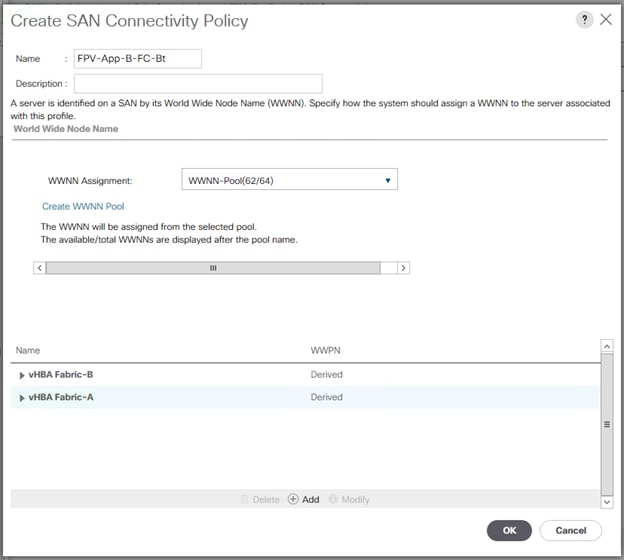
19. Click OK to create the SAN Connectivity Policy.
20. Click OK to confirm creation.
Create Server Pool
To configure the necessary server pool for the Cisco UCS environment, complete the following steps:
![]() Consider creating unique server pools to achieve the granularity that is required in your environment.
Consider creating unique server pools to achieve the granularity that is required in your environment.
1. In Cisco UCS Manager, click Servers on the left.
2. Select Pools > root > Sub-Organizations > FPV-FlexPod.
3. Select and right-click on Server Pools.
4. Select Create Server Pool.
5. Enter FPV-App-B-Server-Pool as the name of the server pool.
6. Optional: Enter a description for the server pool.
7. Click Next.
8. Select two (or more) servers to be used in the cluster and click >> to add them to the FPV-App-B-Server-Pool server pool.
9. Click Finish.
10. Click OK.
Create LAN Connectivity Policy for FC Boot
To configure the necessary Infrastructure LAN Connectivity Policy, complete the following steps:
1. In Cisco UCS Manager, click LAN on the left.
2. Select and expand LAN > Policies > root > Sub-Organizations > FPV-FlexPod.
3. Select and right-click LAN Connectivity Policies.
4. Select Create LAN Connectivity Policy.
5. Enter FC-Boot as the name of the policy.
6. Click the upper Add button to add a vNIC.
7. In the Create vNIC dialog box, enter 00-Infra-A as the name of the vNIC.
8. Select the Use vNIC Template checkbox.
9. In the vNIC Template list, select Infra-A.
10. In the Adapter Policy list, select VMware.
11. Click OK to add this vNIC to the policy.

12. Click the upper Add button to add another vNIC to the policy.
13. In the Create vNIC box, enter 01-Infra-B as the name of the vNIC.
14. Select the Use vNIC Template checkbox.
15. In the vNIC Template list, select Infra-B.
16. In the Adapter Policy list, select VMware.
17. Click OK to add the vNIC to the policy.
18. Click the upper Add button to add a vNIC.
19. In the Create vNIC dialog box, enter 02-APIC-VS-A as the name of the vNIC.
20. Select the Use vNIC Template checkbox.
21. In the vNIC Template list, select APIC-VS-A.
22. In the Adapter Policy list, select either VMware or VMware-HighTrf.
23. Click OK to add this vNIC to the policy.
24. Click the upper Add button to add another vNIC to the policy.
25. In the Create vNIC box, enter 03-APIC-VS-B as the name of the vNIC.
26. Select the Use vNIC Template checkbox.
27. In the vNIC Template list, select APIC-VS-B.
28. In the Adapter Policy list, select either VMware or VMware-HighTrf.
29. Click OK to add the vNIC to the policy.
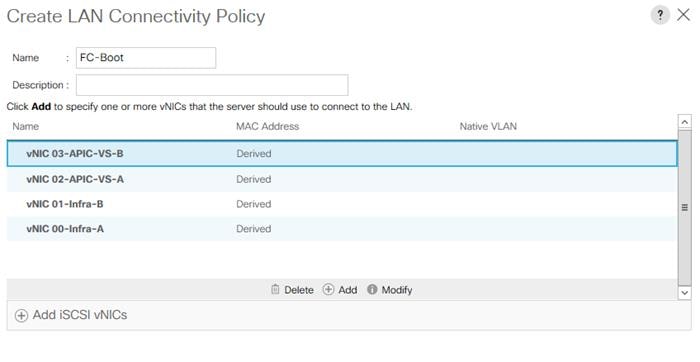
30. Click OK, then click OK again to create the LAN Connectivity Policy.
Create Boot Policy (FC Boot)
This procedure applies to a Cisco UCS environment in which two FC logical interfaces (LIFs) are on cluster node 1 (fcp_lif01a and fcp_lif01b) and two FC LIFs are on cluster node 2 (fcp_lif02a and fcp_lif02b).
To create a boot policy for the Cisco UCS environment, complete the following steps:
1. In Cisco UCS Manager, click Servers on the left.
2. Select and expand Servers > Policies > root > Sub-Organizations > FPV-FlexPod > Boot Policies.
3. Right-click Boot Policies.
4. Select Create Boot Policy.
5. Enter FC-Boot as the name of the boot policy.
6. Optional: Enter a description for the boot policy.
![]() Do not select the Reboot on Boot Order Change checkbox.
Do not select the Reboot on Boot Order Change checkbox.
7. Keep the Reboot on Boot Order Change option cleared.
8. Expand the Local Devices drop-down list and select Add Remote CD/DVD.
9. Expand the vHBAs drop-down list and select Add SAN Boot.
10. Select the Primary for type field.
11. Enter Fabric-A in vHBA field.
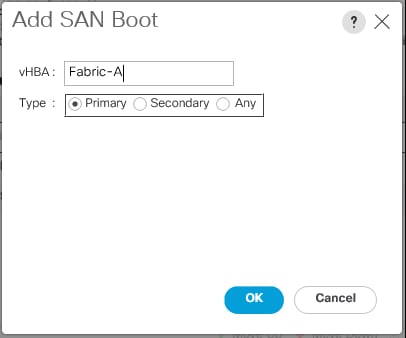
12. Click OK.
13. From the vHBA drop-down list, select Add SAN Boot Target.
14. Keep 0 as the value for Boot Target LUN.
15. Enter the WWPN for fcp_lif01a.
![]() To obtain this information, log in to the storage cluster and run the network interface show command.
To obtain this information, log in to the storage cluster and run the network interface show command.
16. Select Primary for the SAN boot target type.
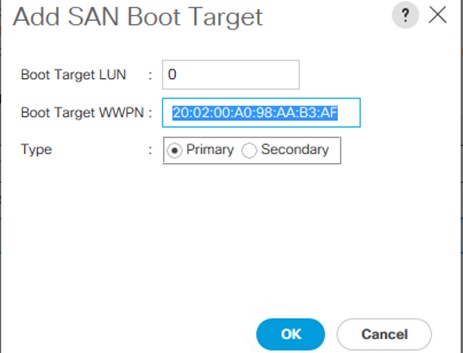
17. Click OK to add the SAN boot target.
18. From the vHBA drop-down list, select Add SAN Boot Target.
19. Enter 0 as the value for Boot Target LUN.
20. Enter the WWPN for fcp_lif02a.
21. Click OK to add the SAN boot target.
22. From the vHBA drop-down list, select Add SAN Boot.
23. In the Add SAN Boot dialog box, enter Fabric-B in the vHBA box.
24. The SAN boot type should automatically be set to Secondary.
25. Click OK to add the SAN boot.
26. From the vHBA drop-down list, select Add SAN Boot Target.
27. Keep 0 as the value for Boot Target LUN.
28. Enter the WWPN for fcp_lif01b.
29. Select Primary for the SAN boot target type.
30. Click OK to add the SAN boot target.
31. From the vHBA drop-down list, select Add SAN Boot Target.
32. Keep 0 as the value for Boot Target LUN.
33. Enter the WWPN for fcp_lif02b.
34. Click OK to add the SAN boot target.
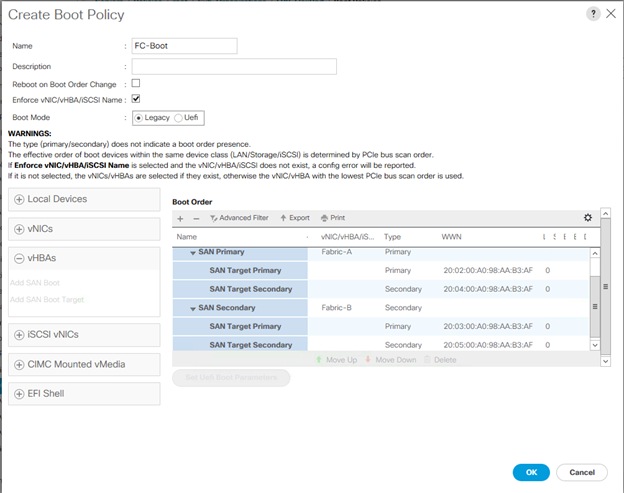
35. Click OK, then click OK again to create the boot policy.
Create Service Profile Template
In this procedure, a service profile template for VMware ESXi hosts are created for Fabric A boot.
To create the service profile template, complete the following steps:
1. In Cisco UCS Manager, click Servers on the left.
2. Select Service Profile Templates > root > Sub-Organizations > FPV-FlexPod.
3. Select and right-click FPV-FlexPod.
4. Select Create Service Profile Template to open the Create Service Profile Template wizard.
5. Enter FPV-App-B-FC-Boot as the name of the service profile template. This service profile template is configured to boot from storage node 1 on fabric A.
6. Select the “Updating Template” option.
7. Under UUID Assignment, select UUID-Pool as the UUID pool.
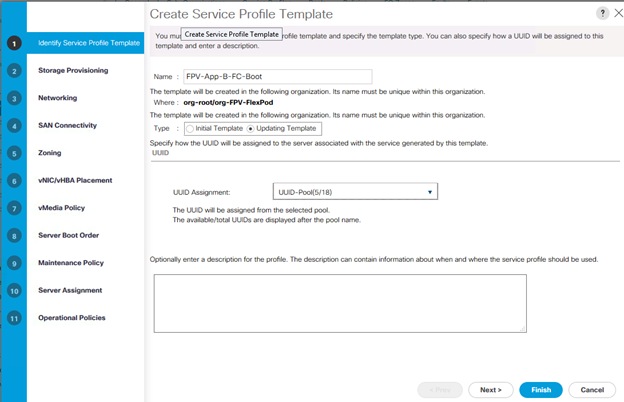
8. Click Next.
Configure Storage Provisioning
1. If you have servers with no physical disks, click on the Local Disk Configuration Policy and select the SAN-Boot Local Storage Policy. Otherwise, select the default Local Storage Policy.
2. Click Next.
Configure Networking Options
1. Keep the setting at default for Dynamic vNIC Connection Policy.
2. Select the “Use Connectivity Policy” option to configure the LAN connectivity.
3. Select FC-Boot from the LAN Connectivity Policy drop-down list.
4. Leave Initiator Name Assignment at <not set>.
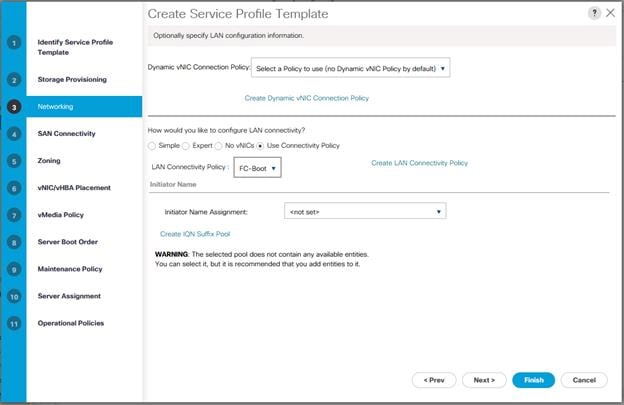
5. Click Next.
Configure Storage Options
To configure storage options, complete the following steps:
1. Select the Use Connectivity Policy option for the “How would you like to configure SAN connectivity?” field.
2. Select the FPV-App-B-FC-Bt option from the SAN Connectivity Policy drop-down list.
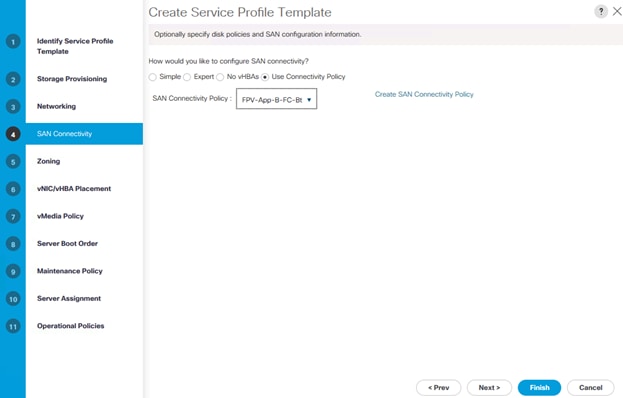
3. Click Next.
Configure Zoning Options
1. Set no Zoning options and click Next.
Configure vNIC/HBA Placement
1. In the “Select Placement” list, leave the placement policy as “Let System Perform Placement.”
2. Click Next.
Configure vMedia Policy
1. Do not select a vMedia Policy.
2. Click Next.
Configure Server Boot Order
1. Select FC-Boot for Boot Policy.
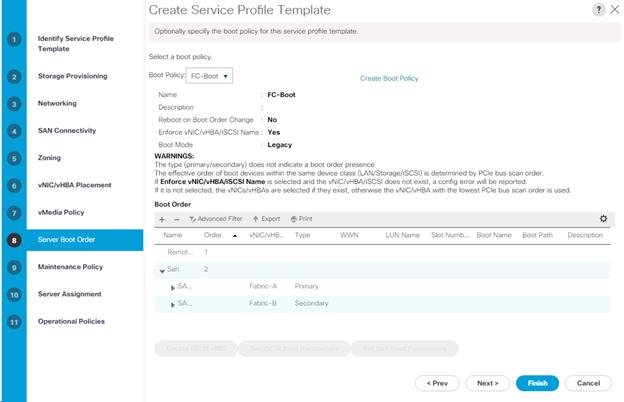
2. Click Next.
Configure Maintenance Policy
1. Change the Maintenance Policy to default.
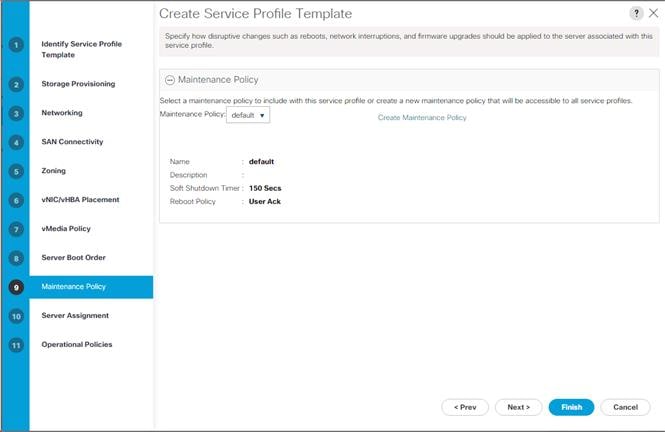
2. Click Next.
Configure Server Assignment
To configure server assignment, complete the following steps:
1. In the Pool Assignment list, select FPV-App-B-Server-Pool.
2. Select Down as the power state to be applied when the profile is associated with the server.
3. Optional: select “UCSB-200-M5” for the Server Pool Qualification.
4. Expand Firmware Management at the bottom of the page and select the default policy.
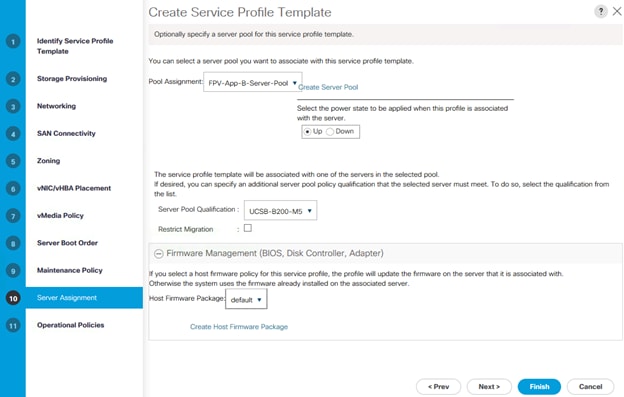
5. Click Next.
Configure Operational Policies
To configure the operational policies, complete the following steps:
1. In the BIOS Policy list, select Virtual-Host.
2. Expand Power Control Policy Configuration and select No-Power-Cap in the Power Control Policy list.
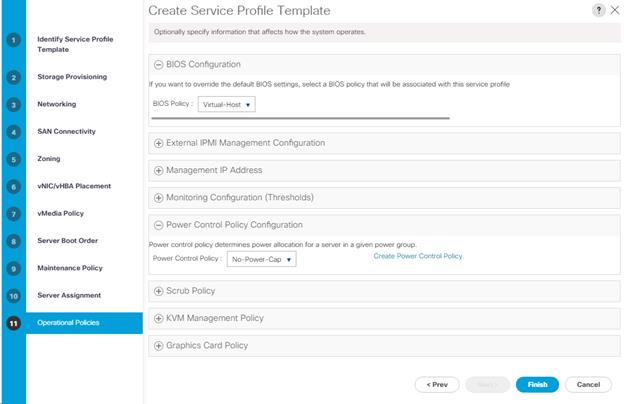
3. Click Finish to create the service profile template.
4. Click OK in the confirmation message.
Create Service Profiles
To create service profiles from the service profile template, complete the following steps:
1. Connect to UCS Manager and click Servers on the left.
2. Select Service Profile Templates > root > Sub-Organizations > FPV-FlexPod > Service Template FPV-App-B-FC-Boot.
3. Right-click FPV-App-B-FC-Boot and select Create Service Profiles from Template.
4. Enter fpv-esxi-0 as the service profile prefix.
5. Enter 1 as “Name Suffix Starting Number.”
6. Enter 2 as the “Number of Instances.”
7. Click OK to create the service profiles.
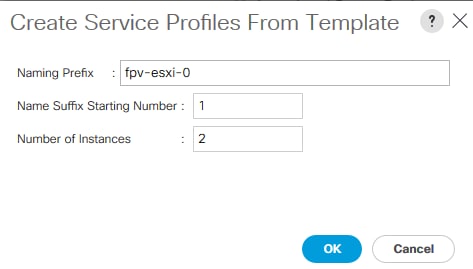
8. Click OK in the confirmation message.
Add More Servers to FlexPod Unit
Additional server pools, service profile templates, and service profiles can be created in the respective organizations to add more servers to the FlexPod unit. All other pools and policies are at the root level and can be shared among the organizations.
Gather Necessary Information
After the Cisco UCS service profiles have been created, each infrastructure server in the environment will have a unique configuration. To proceed with the FlexPod deployment, specific information must be gathered from each Cisco UCS server and from the NetApp controllers. Insert the required information into Table 9 and Table 10.
Table 9 WWPNs from NetApp Storage
| SVM | Adapter | Path | Target: WWPN |
| FPV-Foundation-SVM | fcp_lif01a | Fabric A | <fcp_lif01a-wwpn> |
| fcp_lif01b | Fabric B | <fcp_lif01b-wwpn> | |
| fcp_lif02a | Fabric A | <fcp_lif02a-wwpn> | |
| fcp_lif02b | Fabric B | <fcp_lif02b-wwpn> |
![]() To obtain the FC WWPNs, run the network interface show command on the storage cluster management interface.
To obtain the FC WWPNs, run the network interface show command on the storage cluster management interface.
Table 10 WWPNs for UCS Service Profiles
| Cisco UCS Service Profile Name | Path | Initiator WWPN |
| fpv-esxi-01 | Fabric A | fpv-esxi-01-wwpna |
| Fabric B | fpv-esxi-01-wwpnb | |
| fpv-esxi-02 | Fabric A | fpv-esxi-02-wwpna |
| Fabric B | fpv-esxi-02-wwpnb |
![]() To obtain the FC vHBA WWPN information in Cisco UCS Manager GUI, go to Servers > Service Profiles > root. Click each service profile and then click the “Storage” tab, then “vHBAs” tab on the right. The WWPNs are displayed in the table at the bottom of the page.
To obtain the FC vHBA WWPN information in Cisco UCS Manager GUI, go to Servers > Service Profiles > root. Click each service profile and then click the “Storage” tab, then “vHBAs” tab on the right. The WWPNs are displayed in the table at the bottom of the page.
Adding Direct Connected Tenant FC Storage
To add FC storage from an additional storage SVM, two storage connection policies, one for each fabric must be added in Cisco UCS Manager and attached to vHBA Initiator Groups in the SAN Connectivity Policy. These steps were not shown in the initial deployment above because it is not necessary to zone boot targets. Boot targets are automatically zoned in the fabric interconnect when zoning is enabled on the fabric VSAN. To add direct connected tenant FC storage from a tenant SVM, complete the following steps:
![]() It is recommended to clone the Foundation service profile template to separate templates for each additional tenant. That way FC storage from the specific tenant SVM can be mapped to the specific tenant host servers.
It is recommended to clone the Foundation service profile template to separate templates for each additional tenant. That way FC storage from the specific tenant SVM can be mapped to the specific tenant host servers.
Create Storage Connection Policies
In this procedure, one storage connection policy is created for each fabric.
To create the storage connection policies, complete the following steps:
1. In Cisco UCS Manager, click SAN on the left.
2. Right-click SAN > Policies > root > Sub-Organizations > FPV-FlexPod > Storage Connection Policies and select Create Storage Connection Policy.
3. Name the policy to indicate a tenant on Fabric A (FPV-App-B-FC-A).
4. Select the Single Initiator Multiple Targets Zoning Type.
5. Click Add to add a target.
6. Enter the WWPN of the first fabric A FC LIF (fcp_lif01a) in the tenant SVM connected to fabric interconnect A. Select Path A and VSAN VSAN-A. Click OK.
7. Click Add to add a target.
8. Enter the WWPN of the second fabric A FC LIF (fcp_lif02a) in the tenant SVM connected to fabric interconnect A. Select Path A and VSAN VSAN-A. Click OK.
9. Click OK then click OK again to complete adding the Storage Connection Policy.
10. Right-click SAN > Policies > root > Sub-Organizations > FPV-FlexPod > Storage Connection Policies and select Create Storage Connection Policy.
11. Name the policy to indicate a tenant on Fabric B(FPV-App-B-FC-B).
12. Select the Single Initiator Multiple Targets Zoning Type.
13. Click Add to add a target.
14. Enter the WWPN of the first fabric B FC LIF (fcp_lif01b) in the tenant SVM connected to fabric interconnect B. Select Path B and VSAN VSAN-B. Click OK.
15. Click Add to add a target.
16. Enter the WWPN of the second fabric B FC LIF (fcp_lif02b) in the tenant SVM connected to fabric interconnect B. Select Path B and VSAN VSAN-B. Click OK.
17. Click OK then OK again to complete adding the Storage Connection Policy.
Map Storage Connection Policies vHBA Initiator Groups in SAN Connectivity Policy
In this section, storage connection policies are mapped to vHBA initiator groups for each fabric.
To create the storage connection policy mappings, complete the following steps:
1. In Cisco UCS Manager, click SAN on the left.
2. Select SAN > Policies > root > Sub-Organizations > FPV-FlexPod > SAN Connectivity Policies.
3. Create a duplicate of the FPV-App-B-FC-Bt SAN Connectivity Policy for the tenant. This policy will need to be mapped into the Tenant Service Profile Template.
4. Select the Tenant San Connectivity Policy.
5. In the center pane, select the vHBA Initiator Groups tab.
6. Click Add to add a vHBA Initiator Group.
7. Name the group Fabric-A and select the Fabric A Initiator.
8. Use the drop-down list to select the Tenant Fabric A Storage Connection Policy.
9. Click OK then click OK again to complete adding the Initiator Group.
10. Click Add to add a vHBA Initiator Group.
11. Name the group Fabric-B and select the Fabric B Initiator.
12. Use the drop-down list to select the Fabric B Storage Connection Policy.
13. Click OK and OK to complete adding the Initiator Group.
Create igroups
From the storage cluster CLI, to create igroups, run the following commands:
igroup create –vserver FPV-Foundation-SVM –igroup fpv-esxi-01 –protocol fcp –ostype vmware –initiator <fpv-esxi-01-wwpna>,<fpv-esxi-01-wwpnb>
igroup create –vserver FPV-Foundation-SVM –igroup fpv-esxi-02 –protocol fcp –ostype vmware –initiator <fpv-esxi-02-wwpna>,<fpv-esxi-02-wwpnb>
igroup create –vserver FPV-Foundation-SVM –igroup MGMT-Hosts-All –protocol fcp –ostype vmware –initiator <fpv-esxi-01-wwpna>,<fpv-esxi-01-wwpnb>,<fpv-esxi-02-wwpna>,<fpv-esxi-02-wwpnb>
Map Boot LUNs to igroups
To map LUNs to igroups, run the following commands:
lun map –vserver FPV-Foundation-SVM –volume esxi_boot –lun fpv-esxi-01 –igroup fpv-esxi-01 –lun-id 0
lun map –vserver FPV-Foundation-SVM –volume esxi_boot –lun fpv-esxi-02 –igroup fpv-esxi-02 –lun-id 0
![]() For additional storage related tasks, please see the storage configuration portion of this document.
For additional storage related tasks, please see the storage configuration portion of this document.
![]() FC storage in the tenant SVM can be created and mapped with NetApp Virtual Storage Console (VSC).
FC storage in the tenant SVM can be created and mapped with NetApp Virtual Storage Console (VSC).
Cisco UCS Backup
Automated backup of the UCS domain is important for recovery of the Cisco UCS Domain from issues ranging catastrophic failure to human error. There is a native backup solution within UCS that allows local or remote backup using FTP/TFTP/SCP/SFTP as options.
Created backups can be a binary file containing the Full State, which can be used for a restore to the original or a replacement pair of Cisco UCS fabric interconnects. Alternately, this XML configuration file consists of All configurations, just System configurations, or just Logical configurations of the UCS Domain. For scheduled backups, the available options are Full State or All Configuration, backup of just the System or Logical configurations can be manually initiated.
To create a backup using the Cisco UCS Manager GUI, complete the following steps:
1. Select Admin within the Navigation pane and select All.
2. Click the Policy Backup and Export tab within All.
3. For a Full State Backup, All Configuration Backup, or both, specify the following:
a. Hostname : <IP or FQDN of host that will receive the backup>
b. Protocol: [FTP/TFTP/SCP/SFTP]
c. User: <account on host to authenticate>
d. Password: <password for account on host>
e. Remote File: <full path and filename prefix for backup file>
f. Admin State: <select Enable to activate the schedule on save, Disable to disable schedule on save>
g. Schedule: [Daily/Weekly/Bi Weekly]
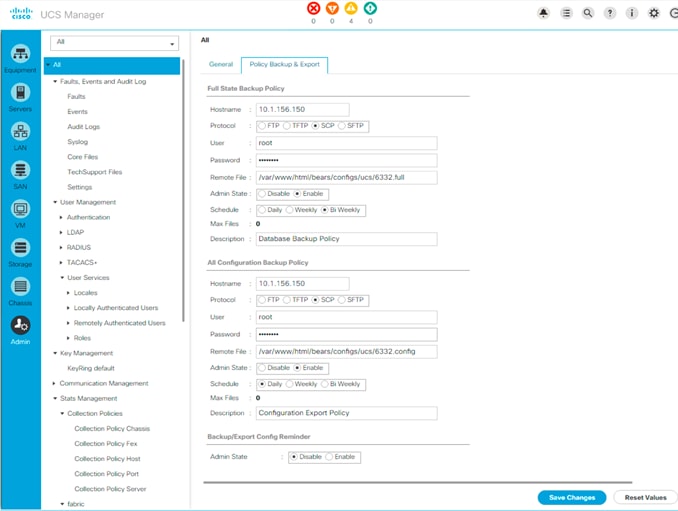
4. Click Save Changes to create the Policy.
The Cisco ASAv configuration used in App-A tenant is provided below as a starting point for customers to that want to leverage Cisco ASAv for enabling decentralized, tenant level firewall services.
fpv-app-a-asav# show run
: Saved
:
: Serial Number: <removed>
: Hardware: ASAv, 2048 MB RAM, CPU Xeon E5 series 2000 MHz
:
ASA Version 9.9(1)
!
hostname fpv-app-a-asav
domain-name flexpod.cisco.com
enable password $sha512$5000$lrcV/TDjJuYrdH0cQE6DFA==$rhHwYAoiVHG1bN0rfZxtBQ== pbkdf2
xlate per-session deny tcp any4 any4
xlate per-session deny tcp any4 any6
xlate per-session deny tcp any6 any4
xlate per-session deny tcp any6 any6
xlate per-session deny udp any4 any4 eq domain
xlate per-session deny udp any4 any6 eq domain
xlate per-session deny udp any6 any4 eq domain
xlate per-session deny udp any6 any6 eq domain
!
license smart
feature tier standard
throughput level 1G
names
!
interface GigabitEthernet0/0
description Outside Interface
nameif Outside
security-level 0
ip address 172.16.252.1 255.255.255.252
!
interface GigabitEthernet0/1
description Inside Interface
nameif Inside
security-level 100
ip address 172.16.0.1 255.255.255.0
!
interface GigabitEthernet0/2
shutdown
no nameif
no security-level
no ip address
!
interface GigabitEthernet0/3
shutdown
no nameif
no security-level
no ip address
!
interface GigabitEthernet0/4
shutdown
no nameif
no security-level
no ip address
!
interface GigabitEthernet0/5
shutdown
no nameif
no security-level
no ip address
!
interface GigabitEthernet0/6
shutdown
no nameif
no security-level
no ip address
!
interface GigabitEthernet0/7
shutdown
no nameif
no security-level
no ip address
!
interface GigabitEthernet0/8
shutdown
no nameif
no security-level
no ip address
!
interface Management0/0
management-only
nameif management
security-level 0
ip address 172.16.254.19 255.255.255.248
!
ftp mode passive
clock timezone EST -5
clock summer-time EDT recurring
dns domain-lookup management
dns server-group DefaultDNS
name-server 10.1.118.42 management
name-server 10.1.118.41 management
domain-name flexpod.cisco.com
object network Inside-subnet
subnet 172.16.0.0 255.255.255.0
object network FPV-App-A-Web
host 172.16.0.10
access-list Outside_acl extended permit ip any any
pager lines 20
logging asdm informational
mtu management 1500
mtu Outside 1500
mtu Inside 1500
no failover
icmp unreachable rate-limit 1 burst-size 1
no asdm history enable
arp timeout 14400
no arp permit-nonconnected
arp rate-limit 8192
!
object network Inside-subnet
nat (Inside,Outside) dynamic interface
object network FPV-App-A-Web
nat (Inside,Outside) static interface service tcp 3389 3389
access-group Outside_acl in interface Outside
route management 0.0.0.0 0.0.0.0 172.16.254.22 1
route Outside 0.0.0.0 0.0.0.0 172.16.252.2 1
timeout xlate 3:00:00
timeout pat-xlate 0:00:30
timeout conn 1:00:00 half-closed 0:10:00 udp 0:02:00 sctp 0:02:00 icmp 0:00:02
timeout sunrpc 0:10:00 h323 0:05:00 h225 1:00:00 mgcp 0:05:00 mgcp-pat 0:05:00
timeout sip 0:30:00 sip_media 0:02:00 sip-invite 0:03:00 sip-disconnect 0:02:00
timeout sip-provisional-media 0:02:00 uauth 0:05:00 absolute
timeout tcp-proxy-reassembly 0:01:00
timeout floating-conn 0:00:00
timeout conn-holddown 0:00:15
timeout igp stale-route 0:01:10
user-identity default-domain LOCAL
aaa authentication ssh console LOCAL
aaa authentication login-history
http server enable
http 0.0.0.0 0.0.0.0 management
no snmp-server location
no snmp-server contact
crypto ipsec security-association pmtu-aging infinite
crypto ca trustpoint _SmartCallHome_ServerCA
no validation-usage
crl configure
crypto ca trustpool policy
auto-import
crypto ca certificate chain _SmartCallHome_ServerCA
certificate ca 513fb9743870b73440418d30930699ff
30820538 30820420 a0030201 02021051 3fb97438 70b73440 418d3093 0699ff30
0d06092a 864886f7 0d01010b 05003081 ca310b30 09060355 04061302 55533117
30150603 55040a13 0e566572 69536967 6e2c2049 6e632e31 1f301d06 0355040b
13165665 72695369 676e2054 72757374 204e6574 776f726b 313a3038 06035504
0b133128 63292032 30303620 56657269 5369676e 2c20496e 632e202d 20466f72
20617574 686f7269 7a656420 75736520 6f6e6c79 31453043 06035504 03133c56
65726953 69676e20 436c6173 73203320 5075626c 69632050 72696d61 72792043
65727469 66696361 74696f6e 20417574 686f7269 7479202d 20473530 1e170d31
33313033 31303030 3030305a 170d3233 31303330 32333539 35395a30 7e310b30
09060355 04061302 5553311d 301b0603 55040a13 1453796d 616e7465 6320436f
72706f72 6174696f 6e311f30 1d060355 040b1316 53796d61 6e746563 20547275
7374204e 6574776f 726b312f 302d0603 55040313 2653796d 616e7465 6320436c
61737320 33205365 63757265 20536572 76657220 4341202d 20473430 82012230
0d06092a 864886f7 0d010101 05000382 010f0030 82010a02 82010100 b2d805ca
1c742db5 175639c5 4a520996 e84bd80c f1689f9a 422862c3 a530537e 5511825b
037a0d2f e17904c9 b4967719 81019459 f9bcf77a 9927822d b783dd5a 277fb203
7a9c5325 e9481f46 4fc89d29 f8be7956 f6f7fdd9 3a68da8b 4b823341 12c3c83c
ccd6967a 84211a22 04032717 8b1c6861 930f0e51 80331db4 b5ceeb7e d062acee
b37b0174 ef6935eb cad53da9 ee9798ca 8daa440e 25994a15 96a4ce6d 02541f2a
6a26e206 3a6348ac b44cd175 9350ff13 2fd6dae1 c618f59f c9255df3 003ade26
4db42909 cd0f3d23 6f164a81 16fbf283 10c3b8d6 d855323d f1bd0fbd 8c52954a
16977a52 2163752f 16f9c466 bef5b509 d8ff2700 cd447c6f 4b3fb0f7 02030100
01a38201 63308201 5f301206 03551d13 0101ff04 08300601 01ff0201 00303006
03551d1f 04293027 3025a023 a021861f 68747470 3a2f2f73 312e7379 6d63622e
636f6d2f 70636133 2d67352e 63726c30 0e060355 1d0f0101 ff040403 02010630
2f06082b 06010505 07010104 23302130 1f06082b 06010505 07300186 13687474
703a2f2f 73322e73 796d6362 2e636f6d 306b0603 551d2004 64306230 60060a60
86480186 f8450107 36305230 2606082b 06010505 07020116 1a687474 703a2f2f
7777772e 73796d61 7574682e 636f6d2f 63707330 2806082b 06010505 07020230
1c1a1a68 7474703a 2f2f7777 772e7379 6d617574 682e636f 6d2f7270 61302906
03551d11 04223020 a41e301c 311a3018 06035504 03131153 796d616e 74656350
4b492d31 2d353334 301d0603 551d0e04 1604145f 60cf6190 55df8443 148a602a
b2f57af4 4318ef30 1f060355 1d230418 30168014 7fd365a7 c2ddecbb f03009f3
4339fa02 af333133 300d0609 2a864886 f70d0101 0b050003 82010100 5e945649
dd8e2d65 f5c13651 b603e3da 9e7319f2 1f59ab58 7e6c2605 2cfa81d7 5c231722
2c3793f7 86ec85e6 b0a3fd1f e232a845 6fe1d9fb b9afd270 a0324265 bf84fe16
2a8f3fc5 a6d6a393 7d43e974 21913528 f463e92e edf7f55c 7f4b9ab5 20e90abd
e045100c 14949a5d a5e34b91 e8249b46 4065f422 72cd99f8 8811f5f3 7fe63382
e6a8c57e fed008e2 25580871 68e6cda2 e614de4e 52242dfd e5791353 e75e2f2d
4d1b6d40 15522bf7 87897812 816ed94d aa2d78d4 c22c3d08 5f87919e 1f0eb0de
30526486 89aa9d66 9c0e760c 80f274d8 2af8b83a ced7d60f 11be6bab 14f5bd41
a0226389 f1ba0f6f 2963662d 3fac8c72 c5fbc7e4 d40ff23b 4f8c29c7
quit
telnet timeout 5
ssh stricthostkeycheck
ssh 0.0.0.0 0.0.0.0 management
ssh timeout 5
ssh key-exchange group dh-group1-sha1
console timeout 0
threat-detection basic-threat
threat-detection statistics access-list
no threat-detection statistics tcp-intercept
ntp server 10.1.118.1 source management
dynamic-access-policy-record DfltAccessPolicy
username admin password $sha512$5000$x7Sww489lLTWs1uHDwoHQw==$e9Z/gZkxOMgF1l/zeSBr0A== pbkdf2 privilege 15
!
class-map inspection_default
match default-inspection-traffic
!
!
policy-map type inspect dns preset_dns_map
parameters
message-length maximum client auto
message-length maximum 512
no tcp-inspection
policy-map global_policy
class inspection_default
inspect ip-options
inspect netbios
inspect rtsp
inspect sunrpc
inspect tftp
inspect xdmcp
inspect dns preset_dns_map
inspect ftp
inspect h323 h225
inspect h323 ras
inspect rsh
inspect esmtp
inspect sqlnet
inspect sip
inspect skinny
policy-map type inspect dns migrated_dns_map_2
parameters
message-length maximum client auto
message-length maximum 512
no tcp-inspection
policy-map type inspect dns migrated_dns_map_1
parameters
message-length maximum client auto
message-length maximum 512
no tcp-inspection
!
service-policy global_policy global
prompt hostname context
no call-home reporting anonymous
call-home
profile License
destination address http https://tools.cisco.com/its/service/oddce/services/DDCEService
destination transport-method http
profile CiscoTAC-1
no active
destination address http https://tools.cisco.com/its/service/oddce/services/DDCEService
destination address email callhome@cisco.com
destination transport-method http
subscribe-to-alert-group diagnostic
subscribe-to-alert-group environment
subscribe-to-alert-group inventory periodic monthly
subscribe-to-alert-group configuration periodic monthly
subscribe-to-alert-group telemetry periodic daily
Cryptochecksum:19ab2f84378a32842eba4ada89c54709
: end
fpv-app-a-asav#
John George, Technical Marketing Engineer, Data Center Solutions Engineering, Cisco Systems, Inc.
John has over seven years of experience in designing, developing, validating, and supporting the FlexPod Converged Infrastructure. Before his roles with FlexPod, he supported and administered a large worldwide training network and VPN infrastructure. John holds a Master's degree in Computer Engineering from Clemson University.
Dave Derry, Technical Marketing Engineer, Infrastructure and Cloud Engineering, NetApp
Dave Derry is a Technical Marketing Engineer in the Converged Infrastructure Engineering team at NetApp. He has been with NetApp since 2012, serving in a variety of engineering roles. Prior to that, he was an engineer at Cisco Systems for over ten years, in a variety of development and solution test roles.
Acknowledgements
For their support and contribution to the design, validation, and creation of this Cisco Validated Design, the authors would like to thank:
· Haseeb Niazi, Cisco Systems, Inc.
· Sanjeev Naldurgkar, Cisco Systems, Inc.
· Rajendra Yogendra, Cisco Systems, Inc.
· Archana Sharma, Cisco Systems, Inc.
· Melissa Palmer, NetApp
· Lindsey Street, NetApp

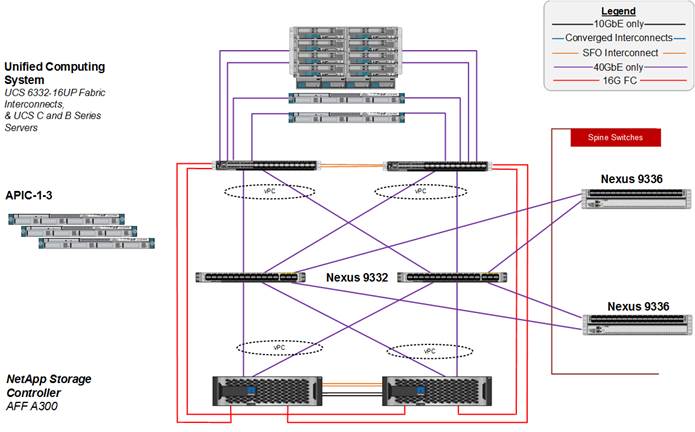
 Feedback
Feedback